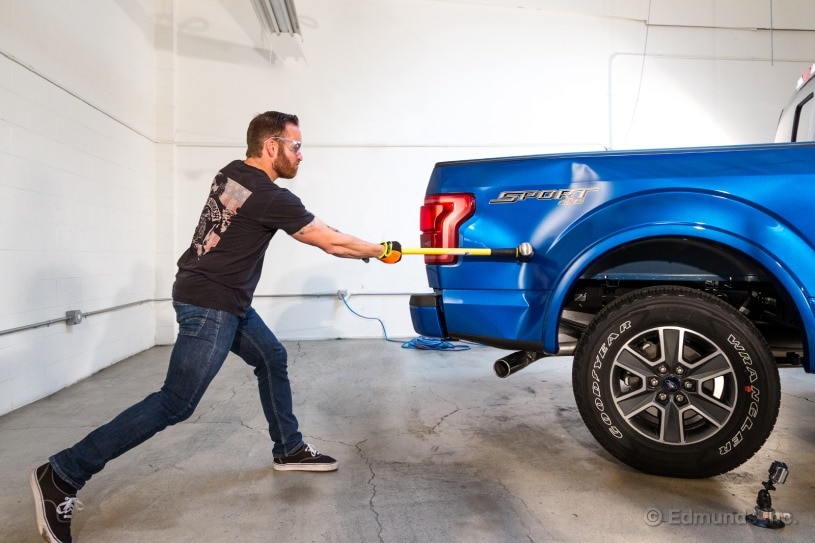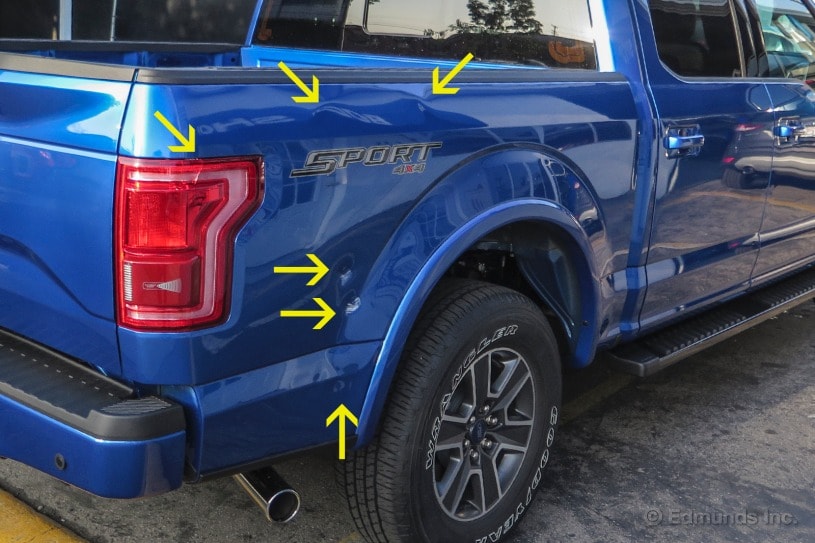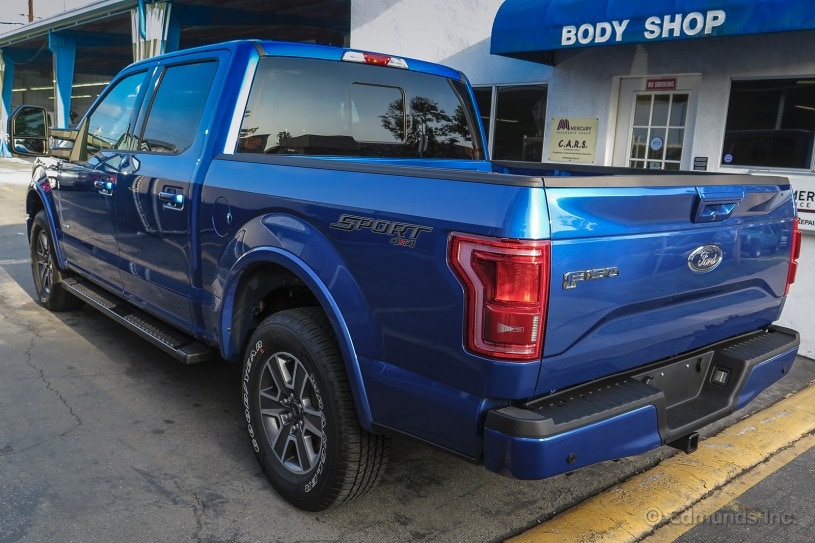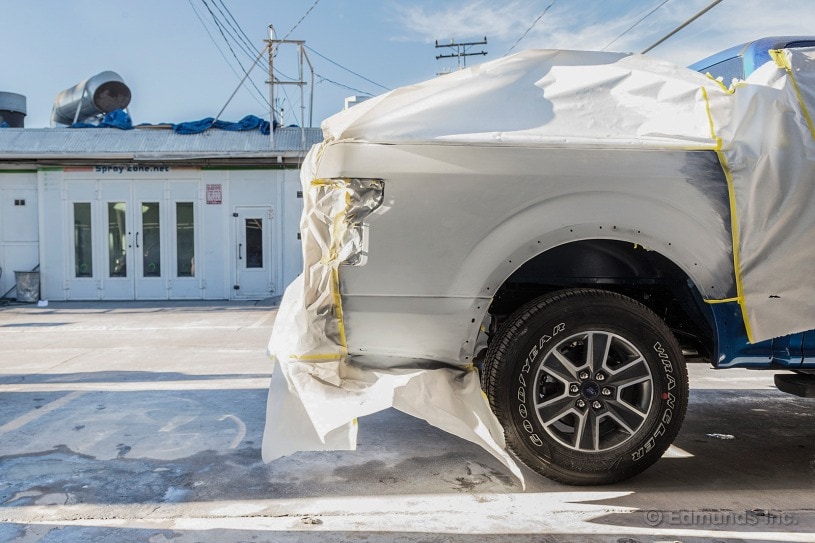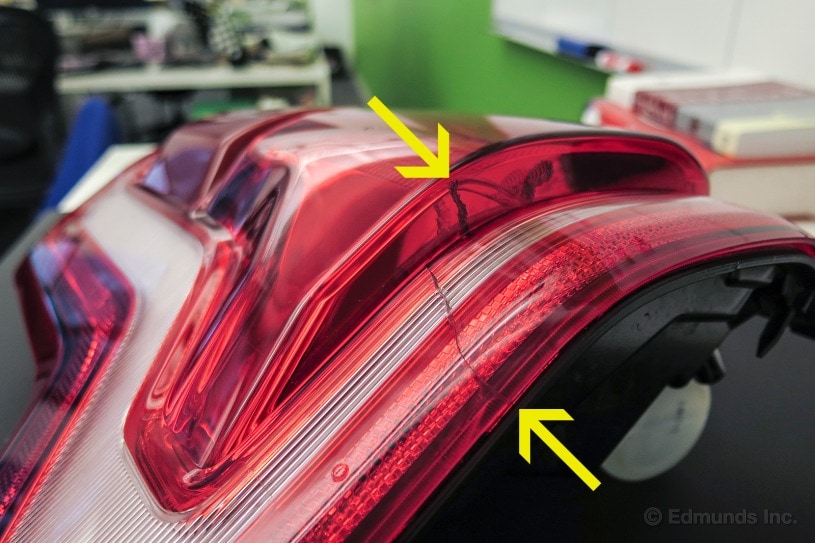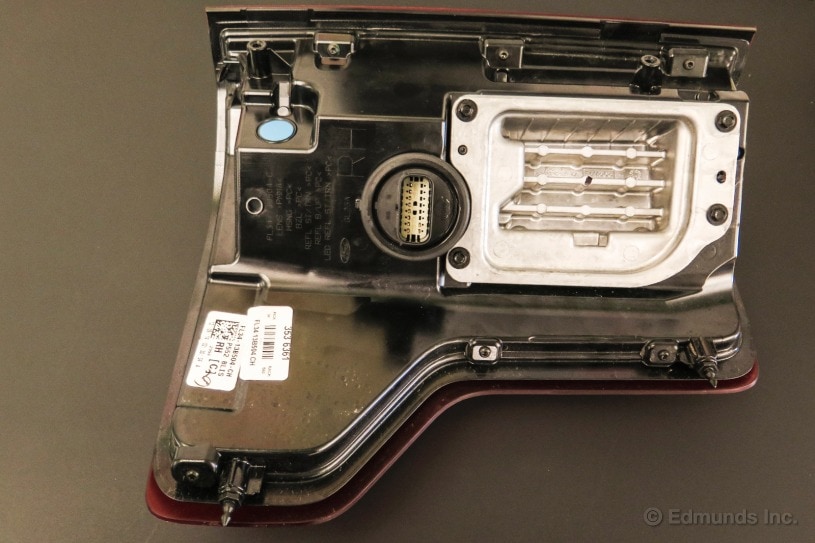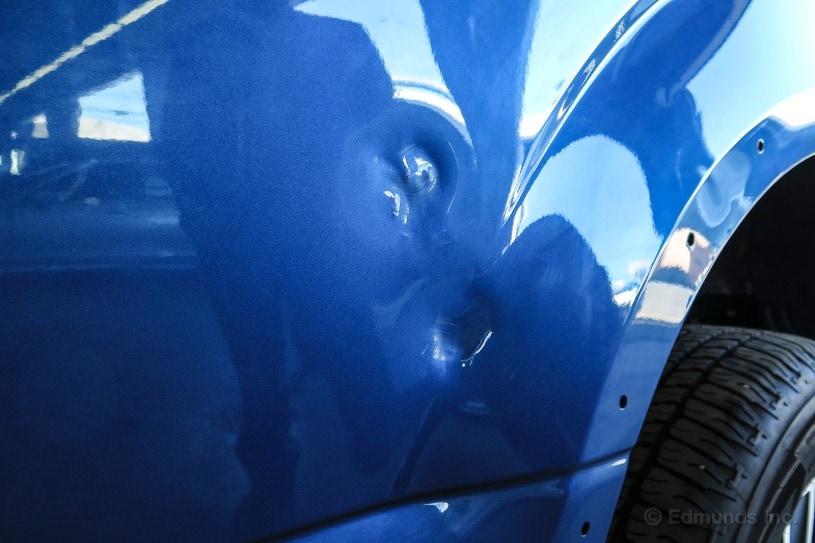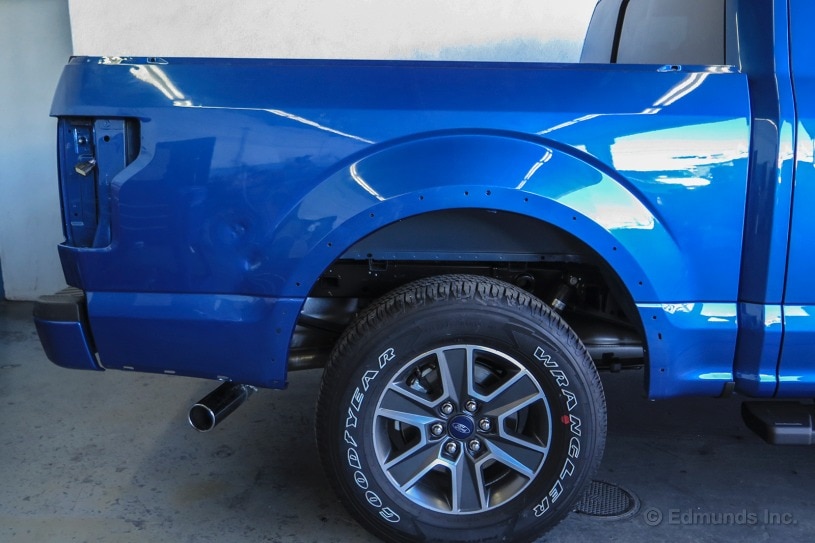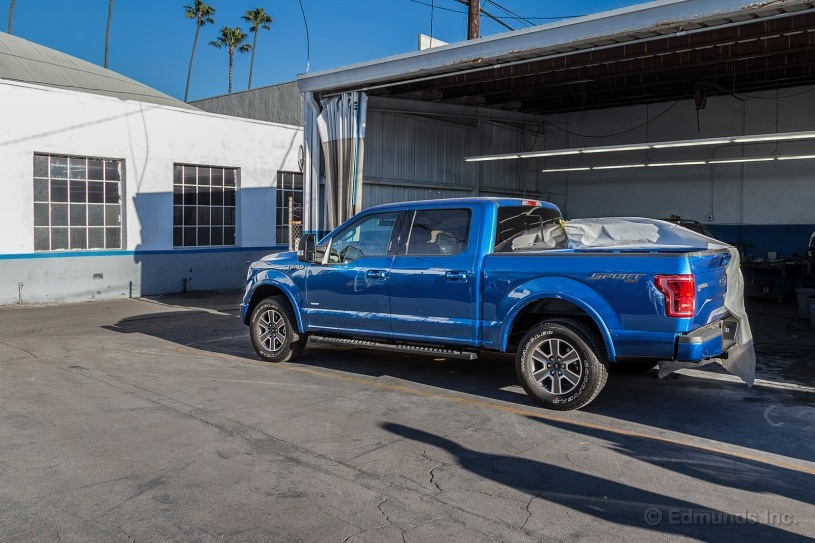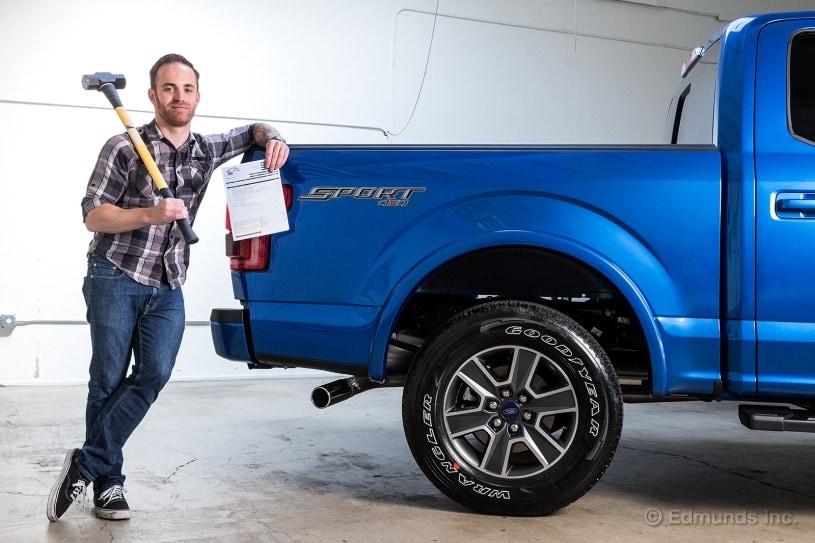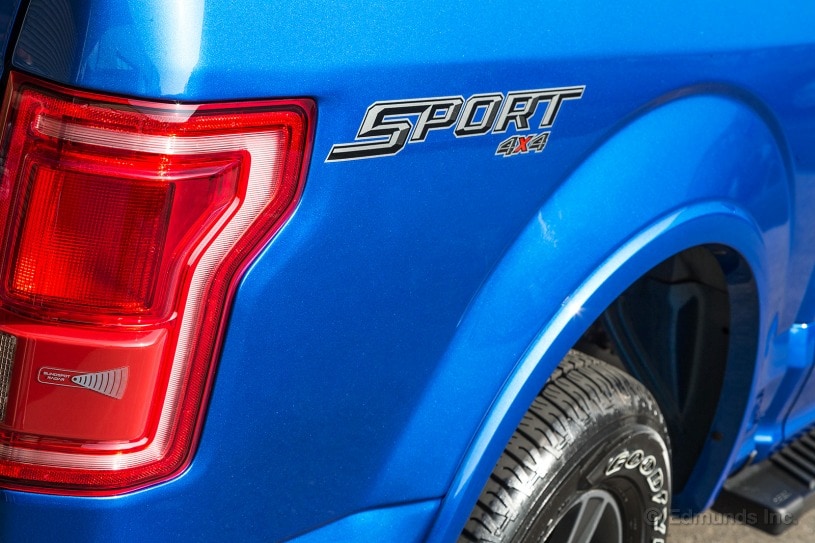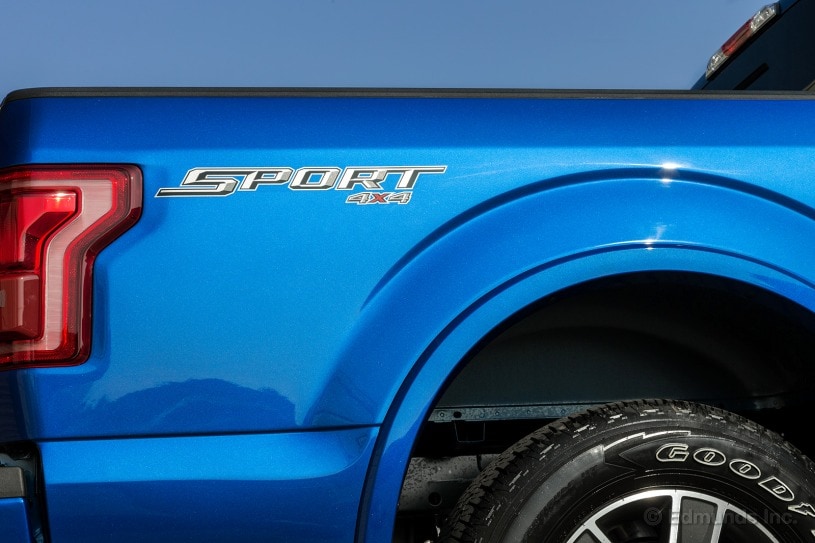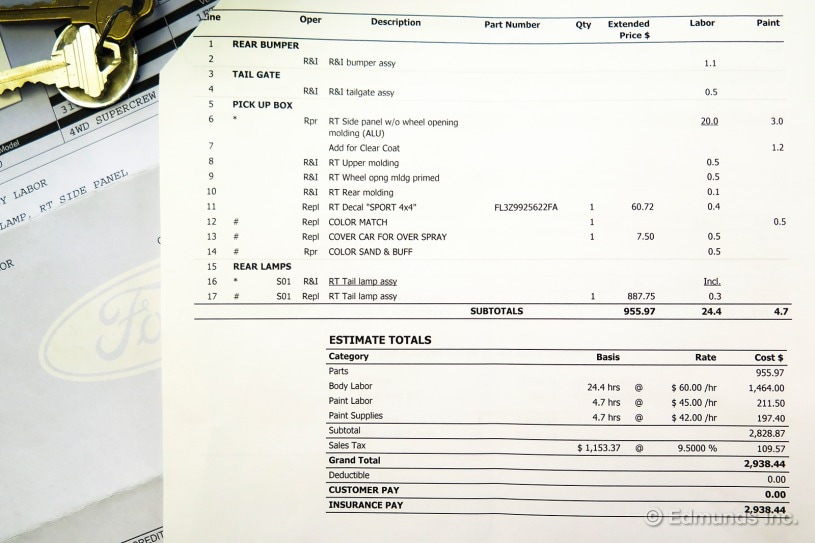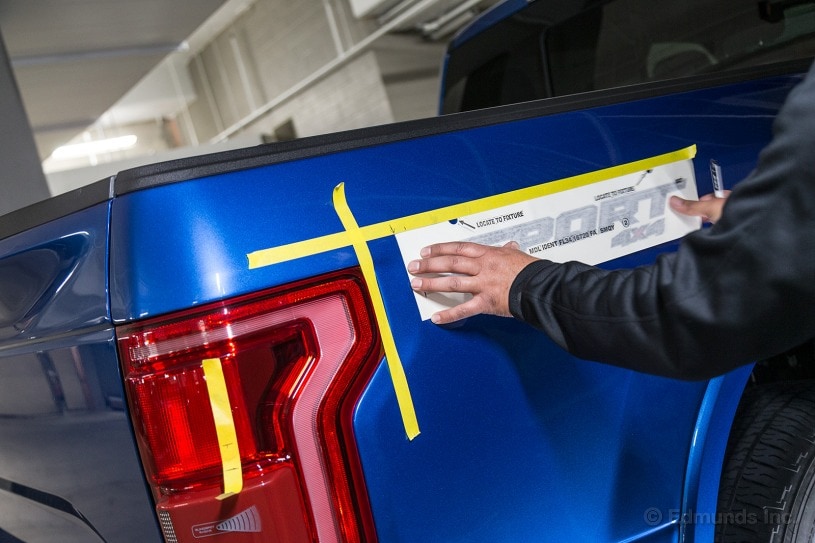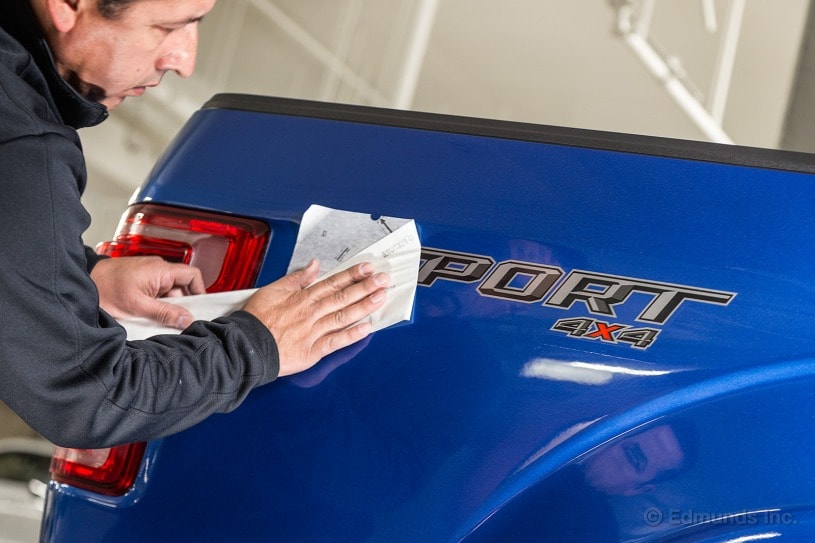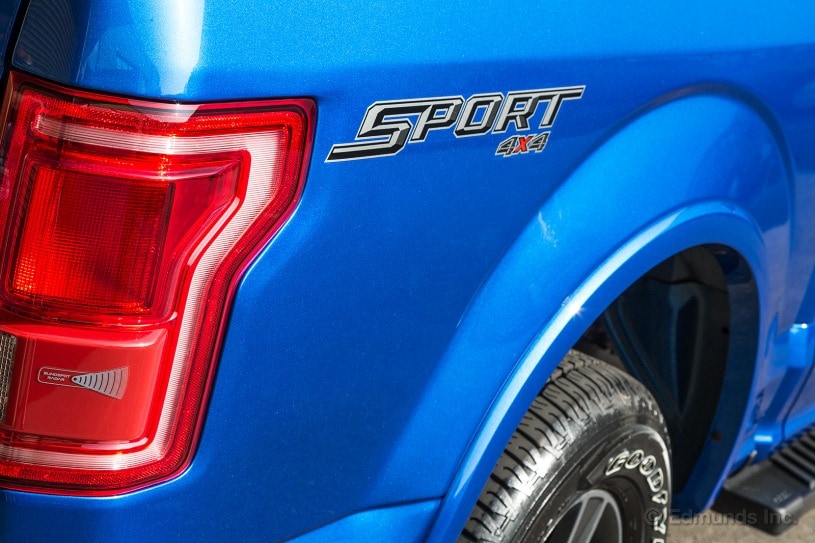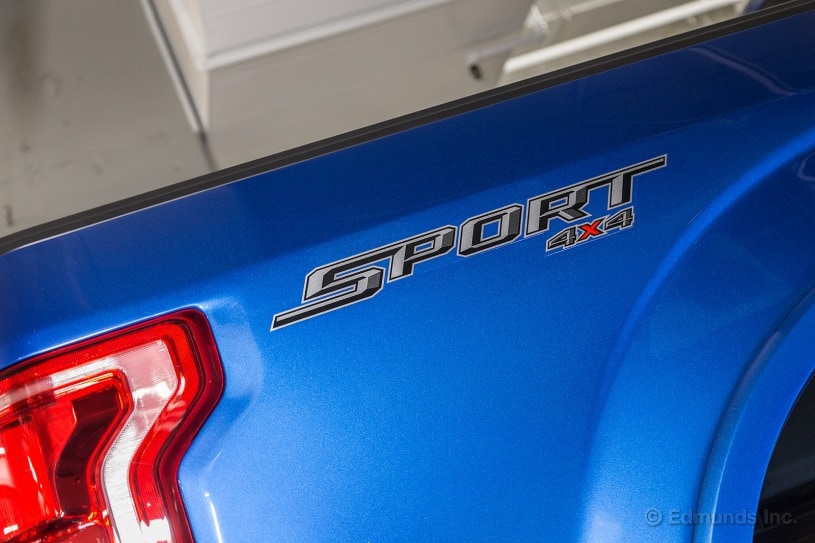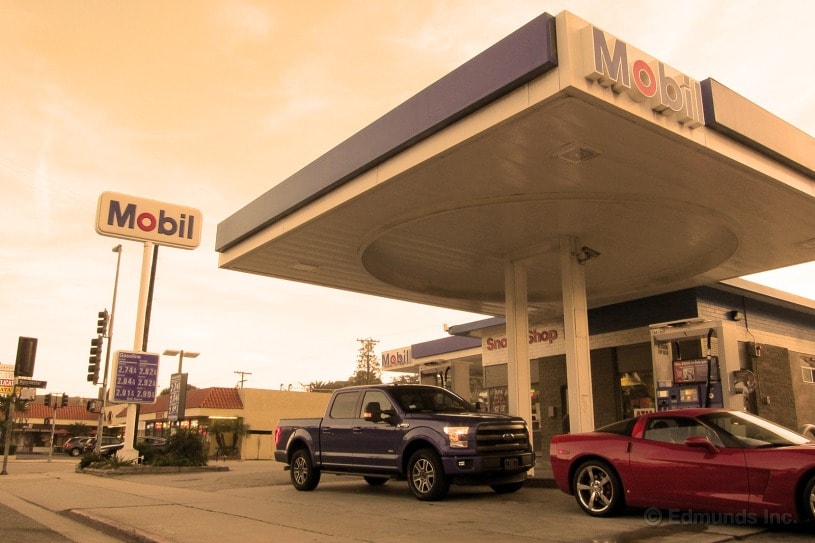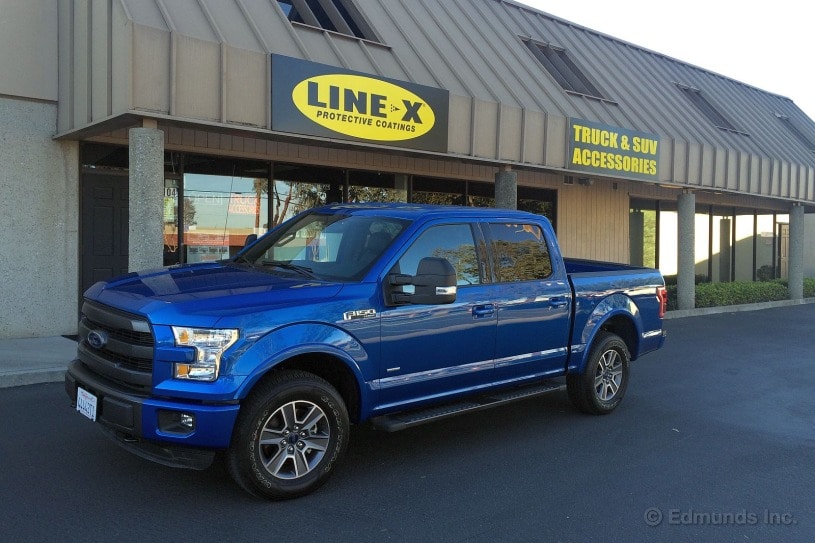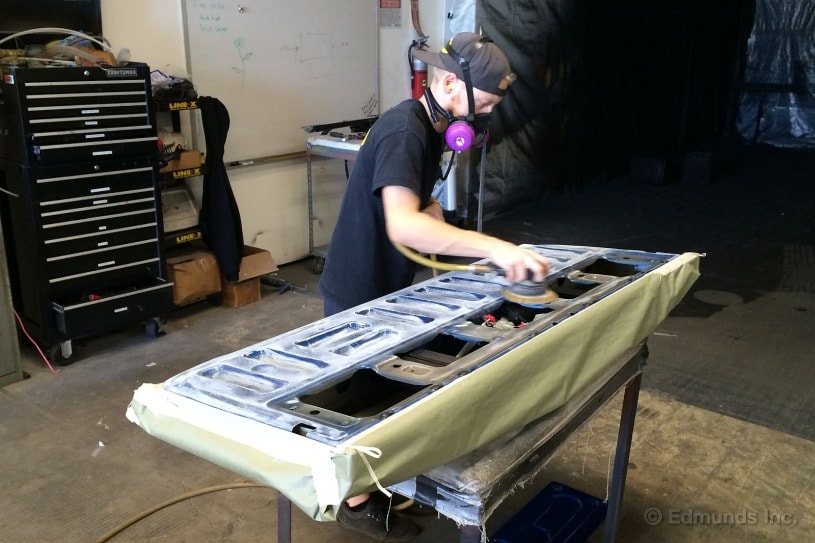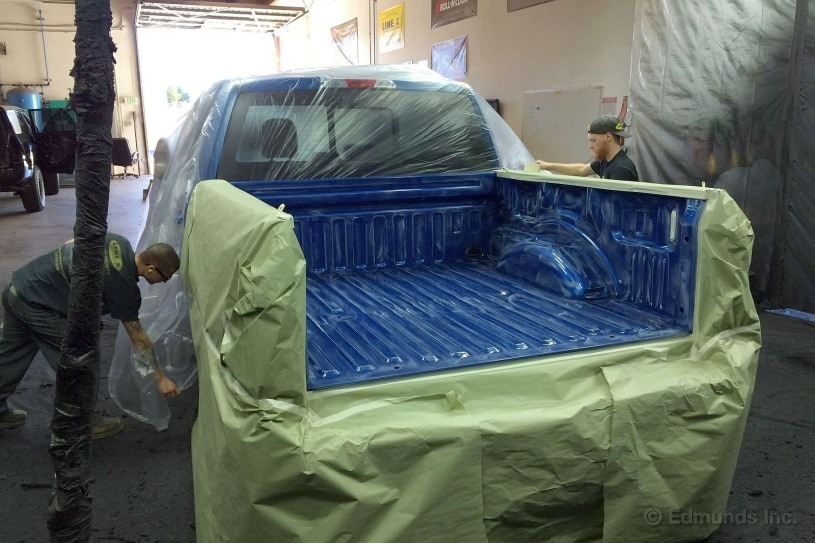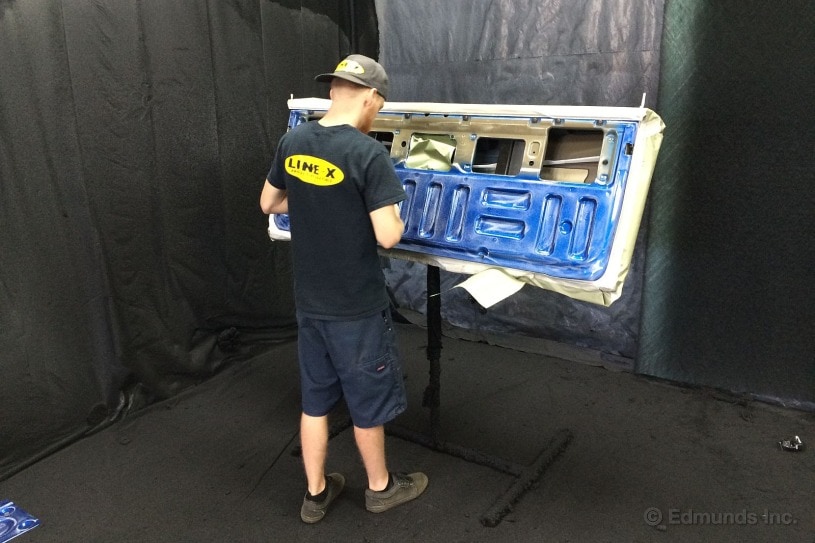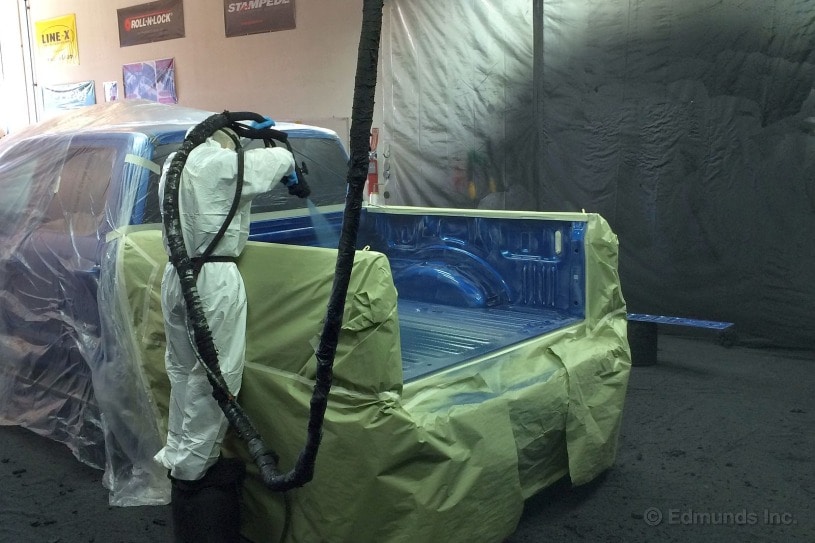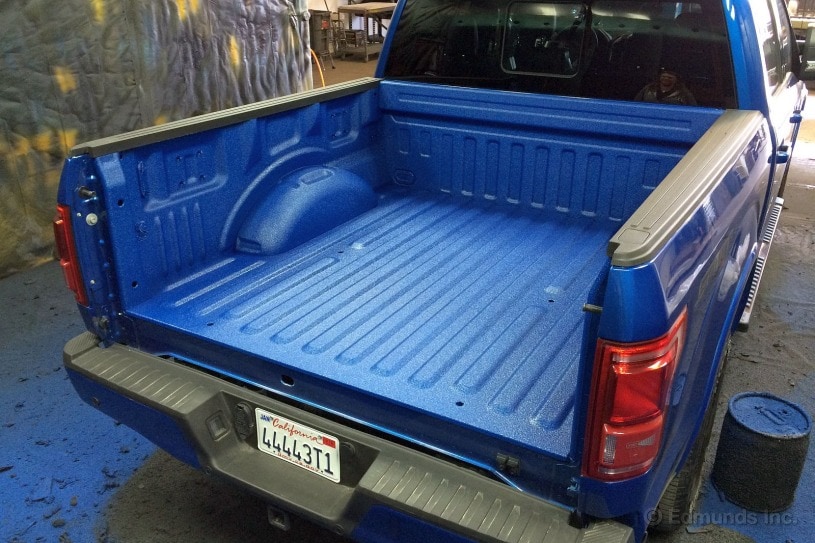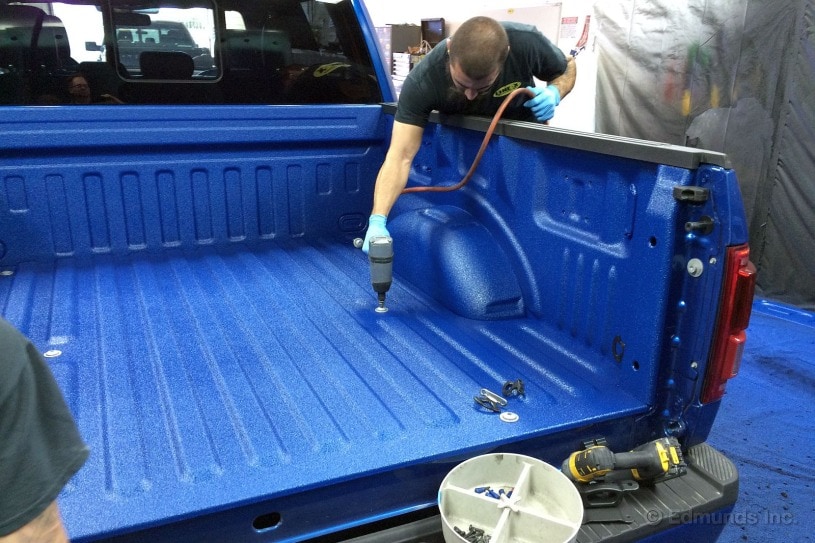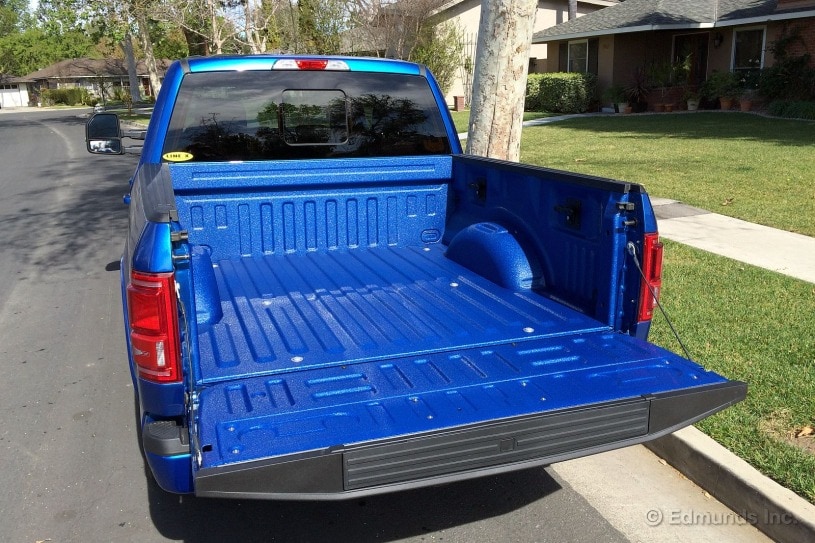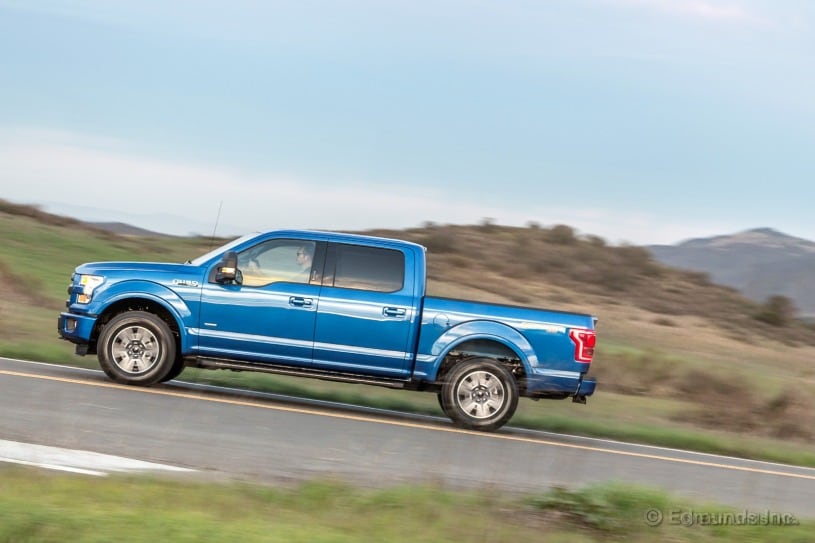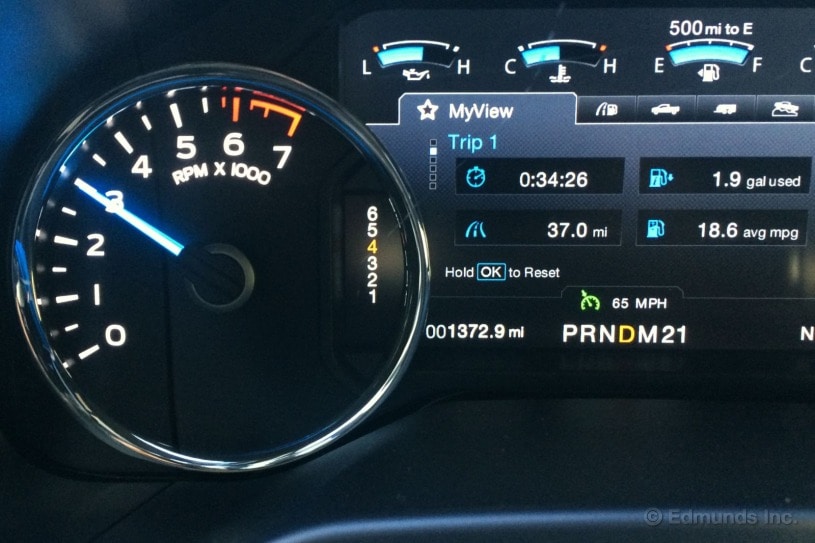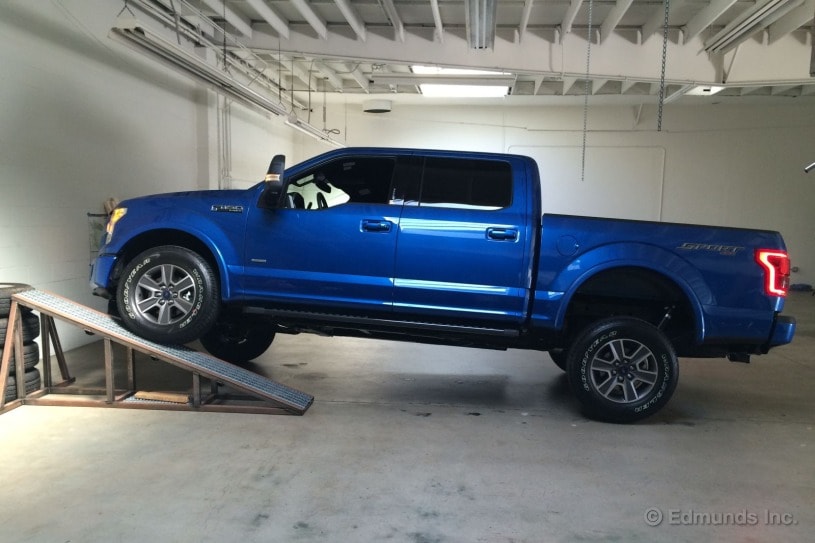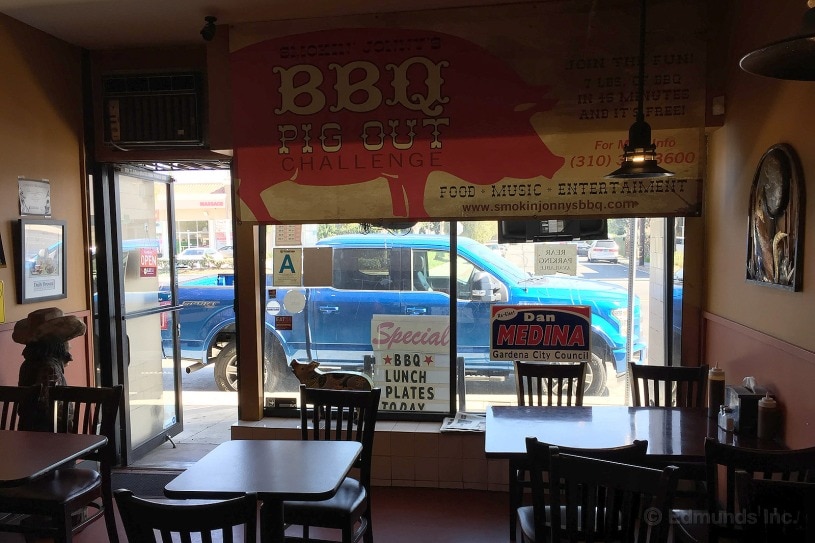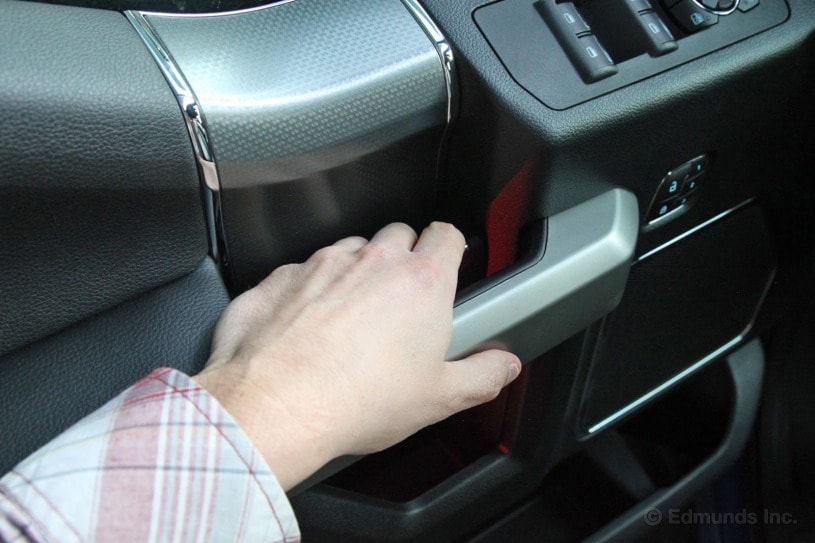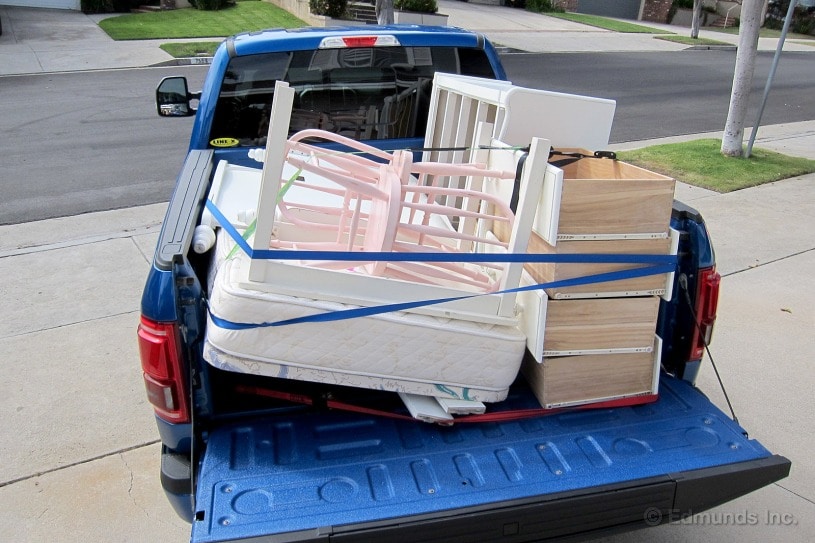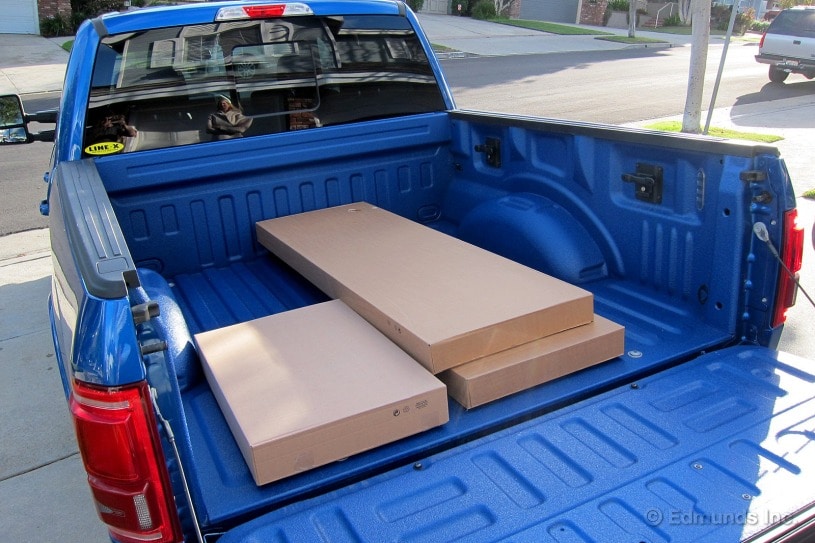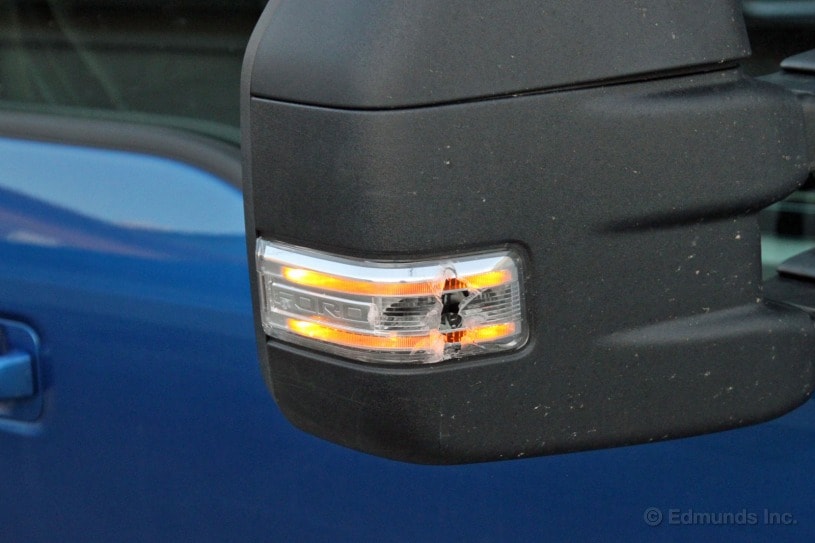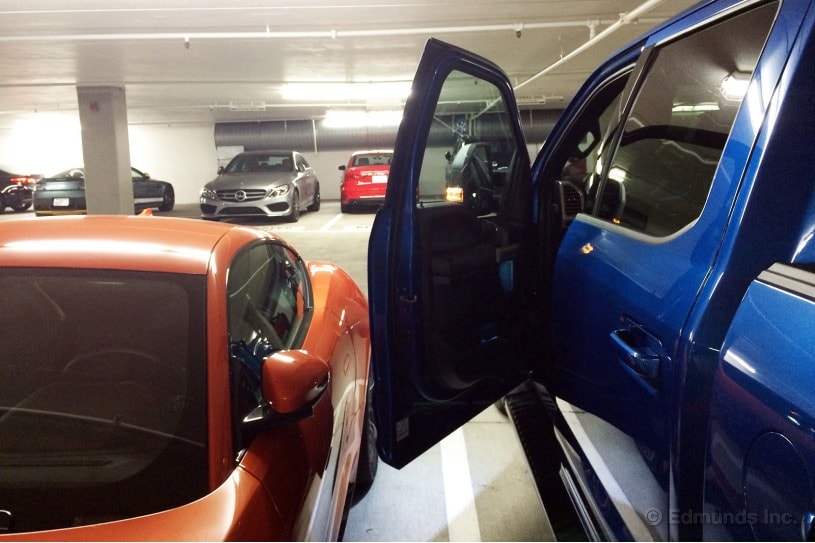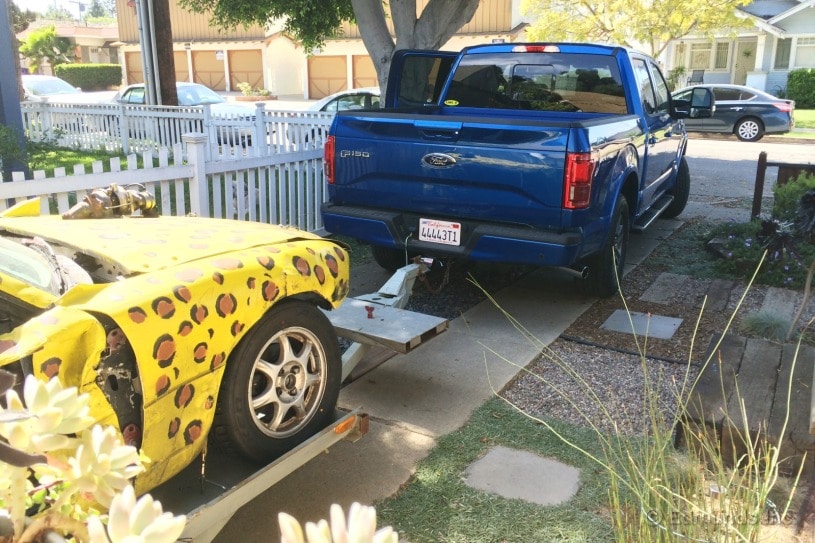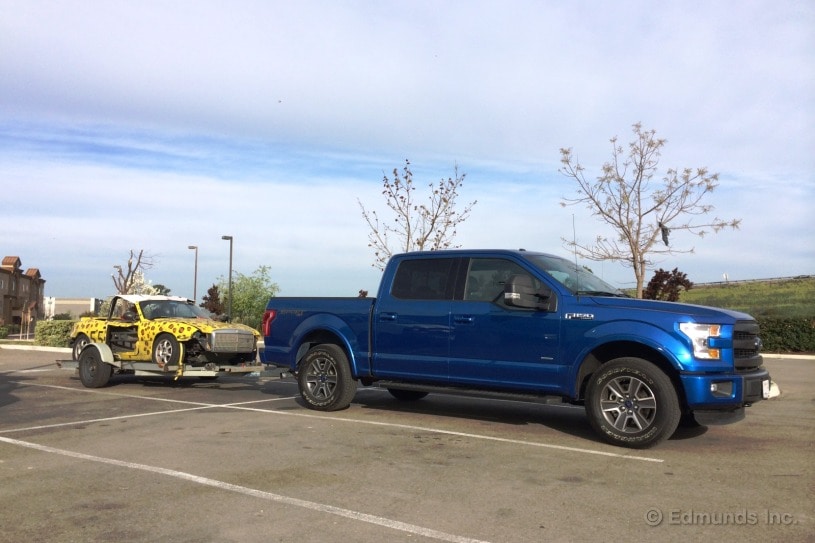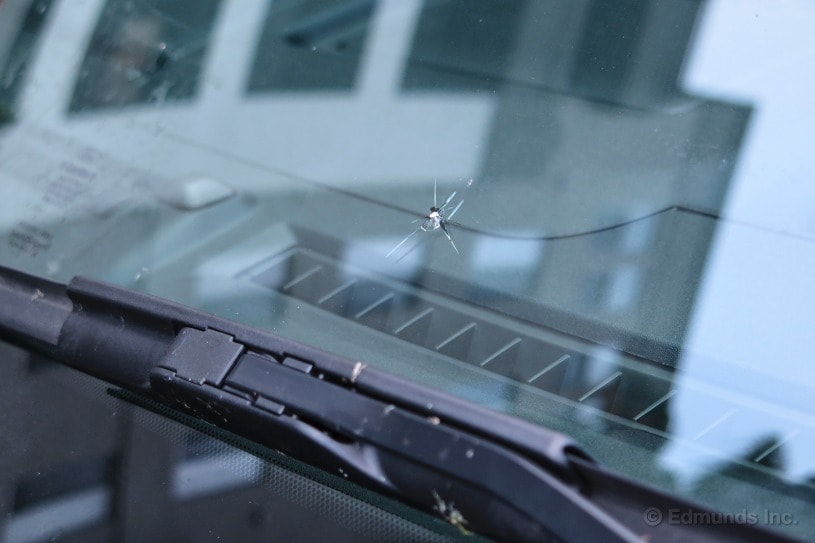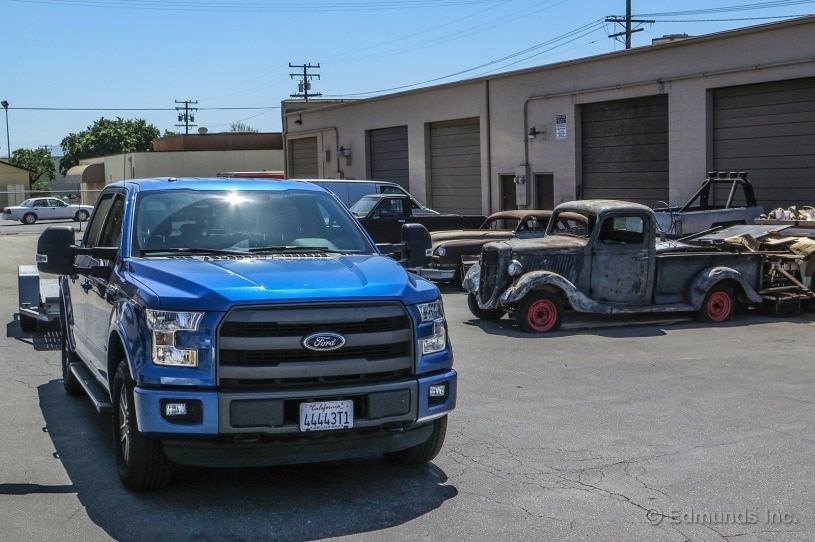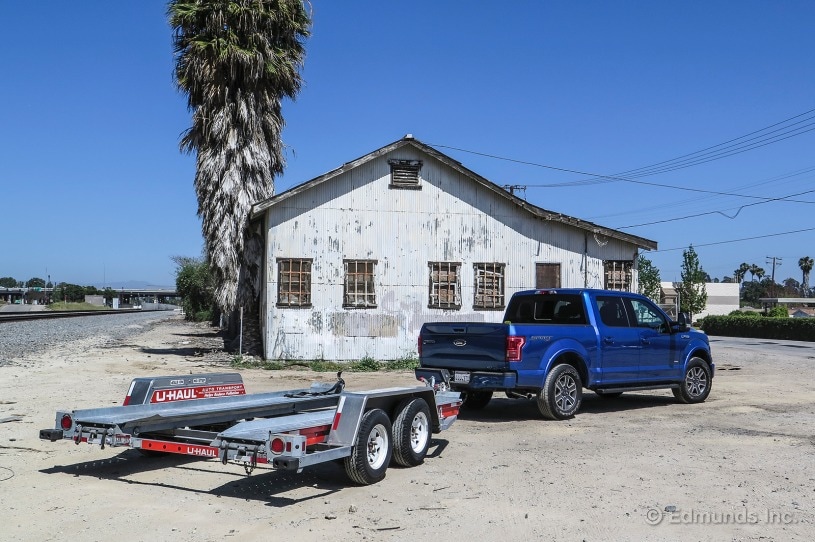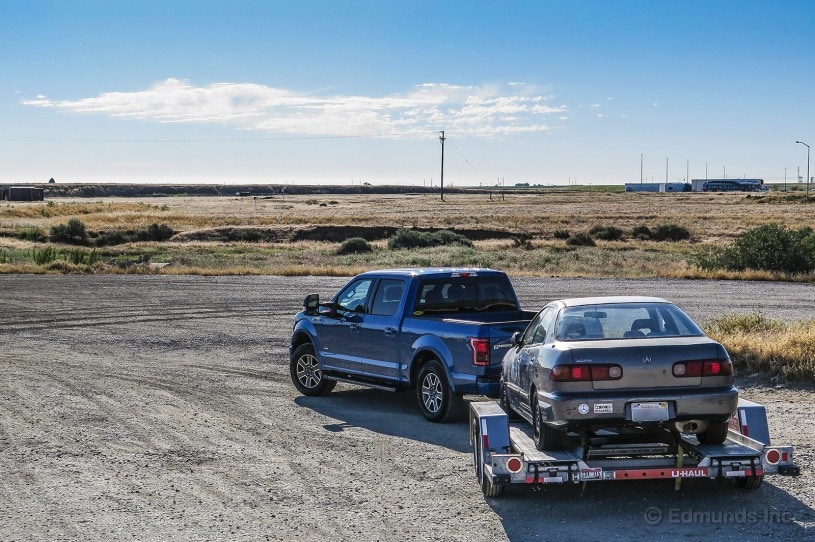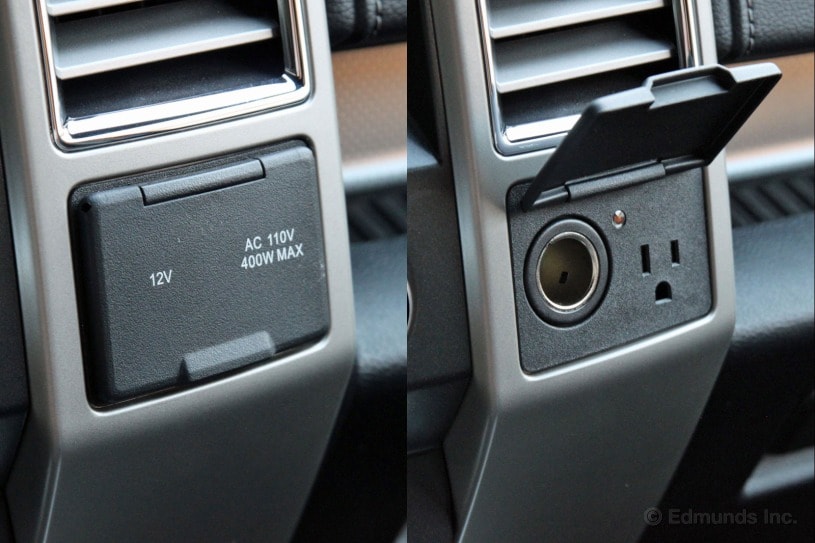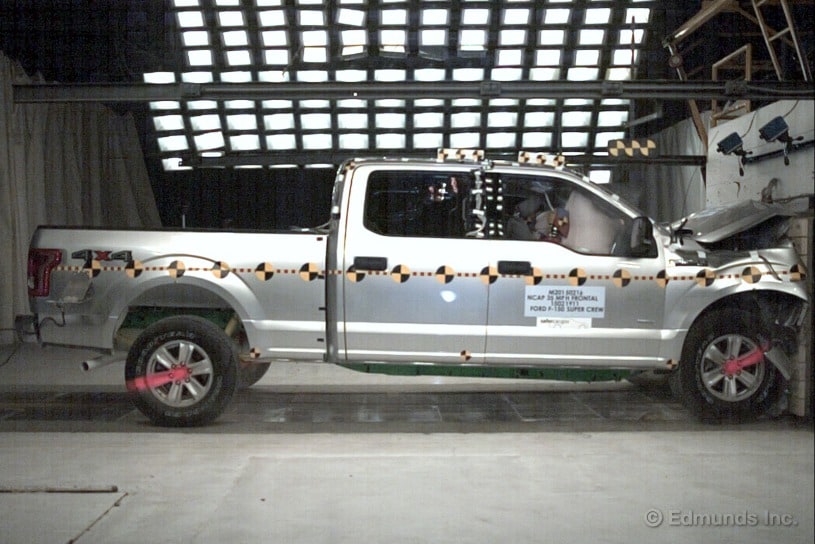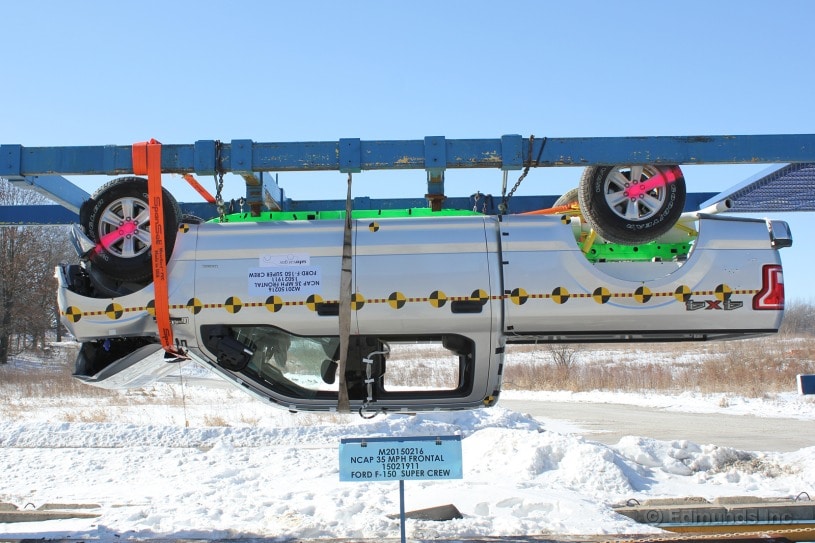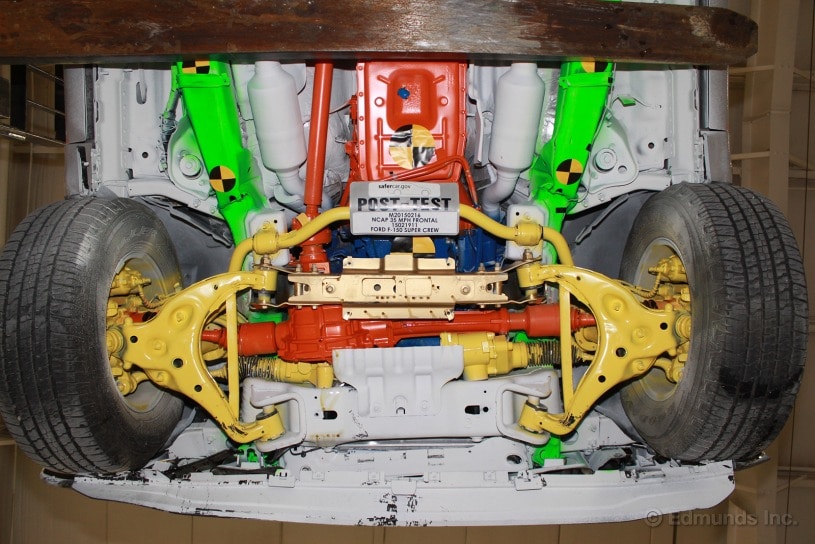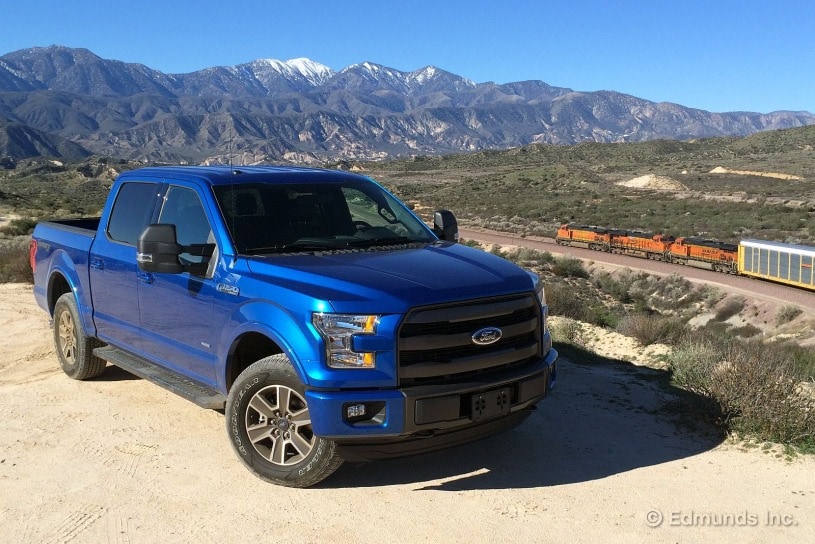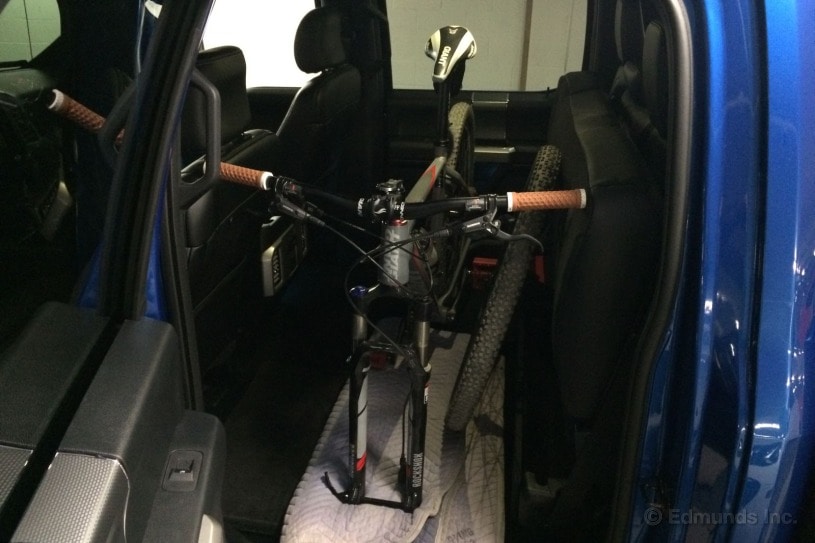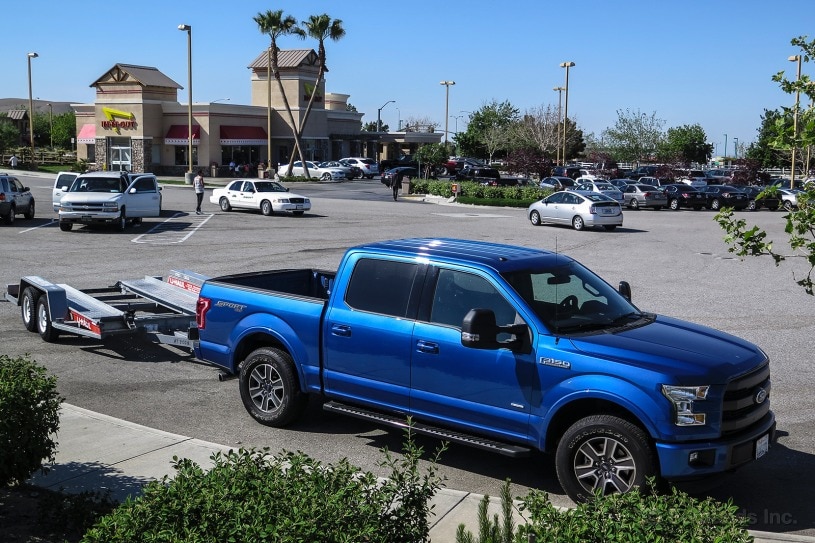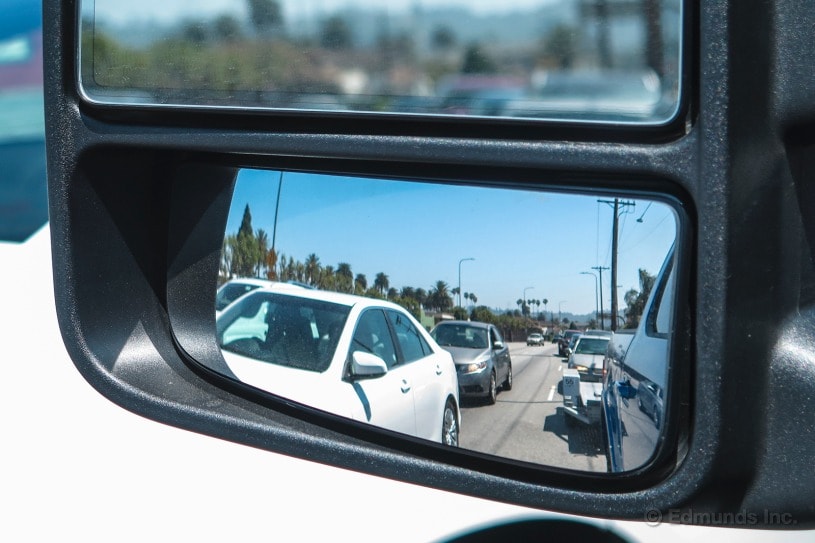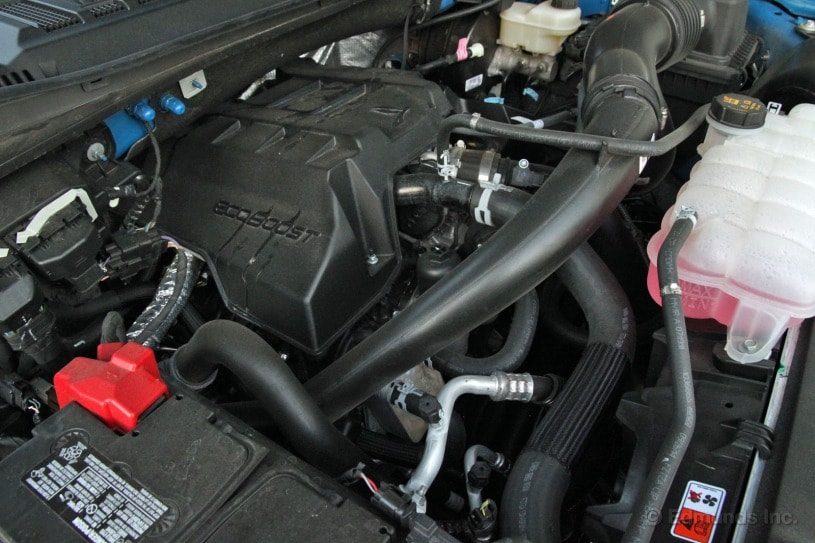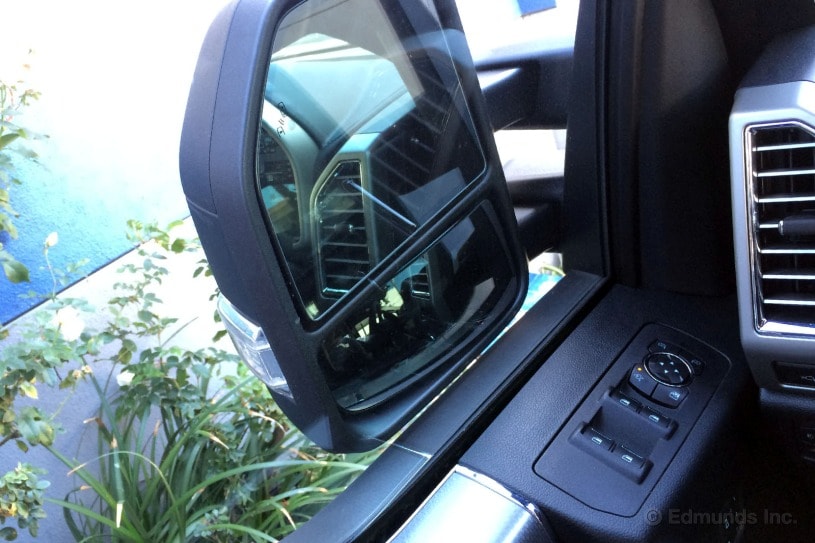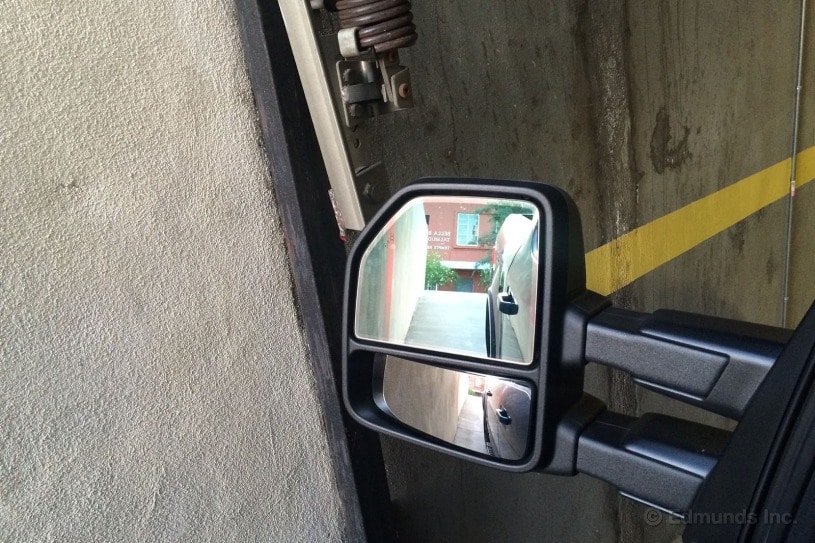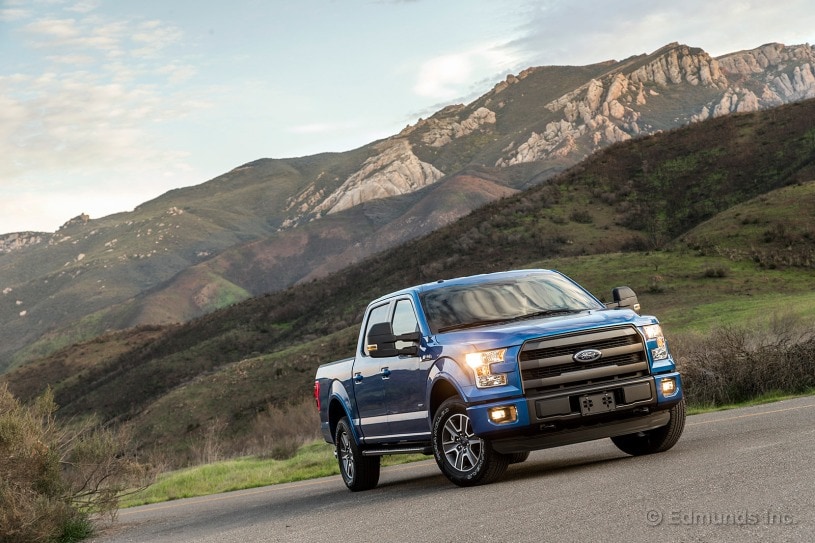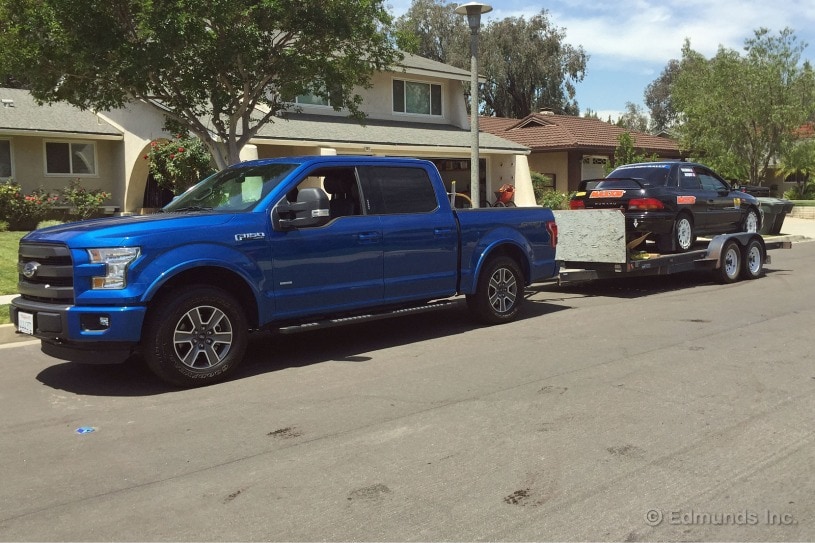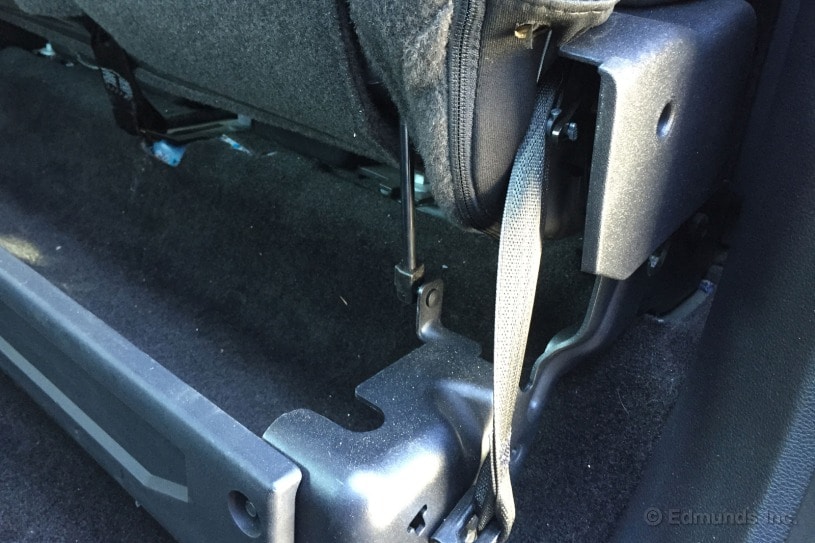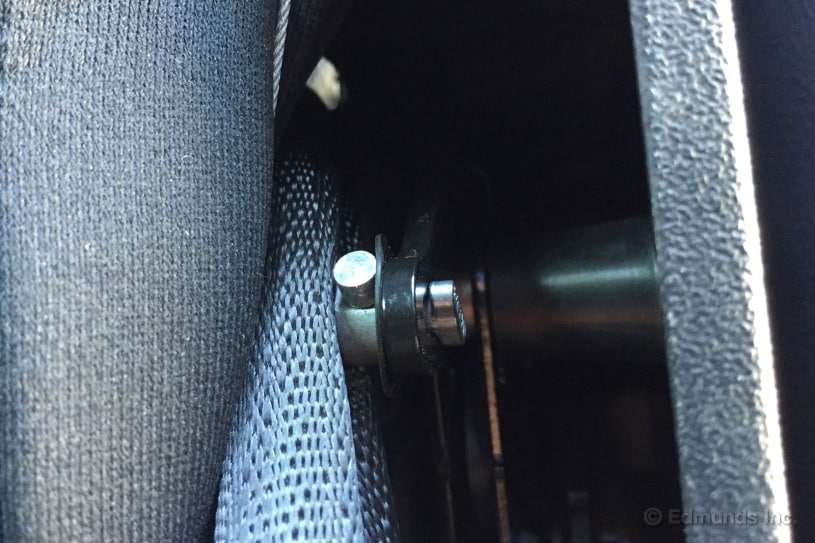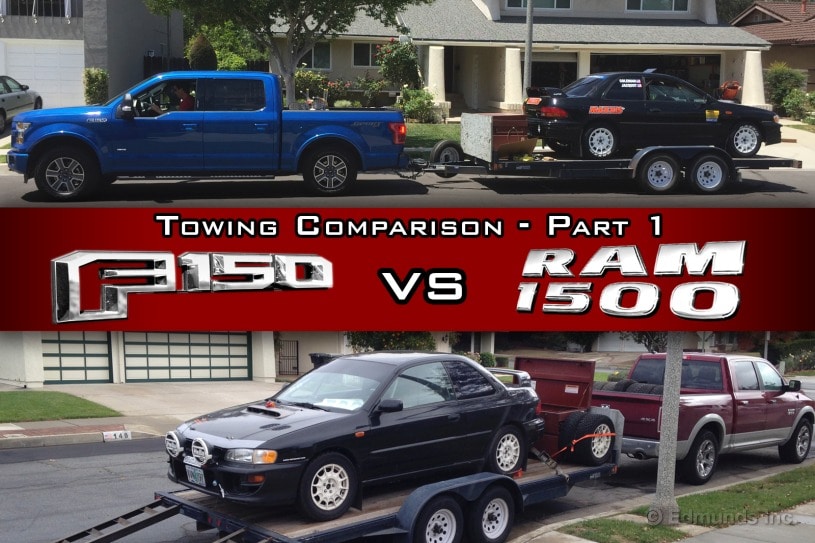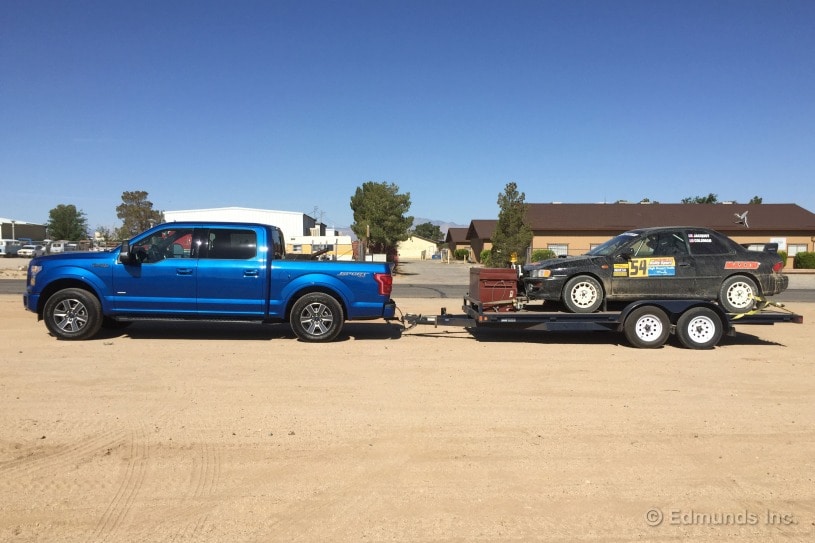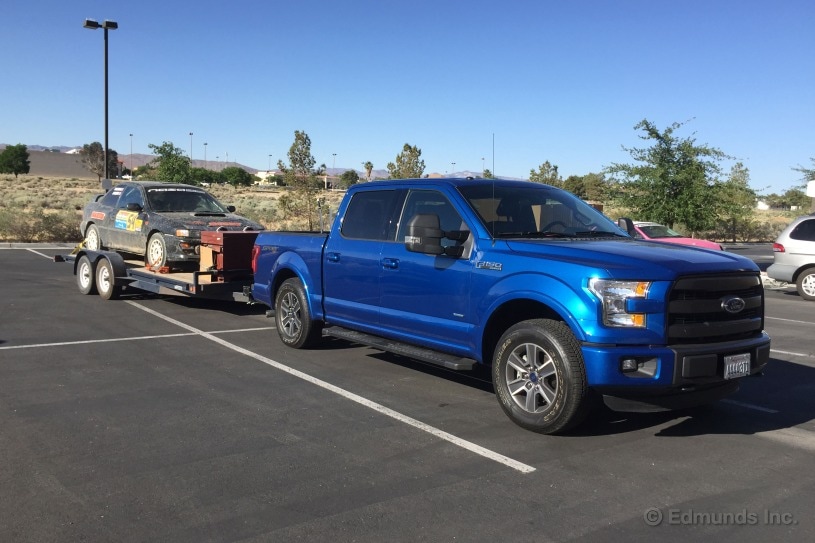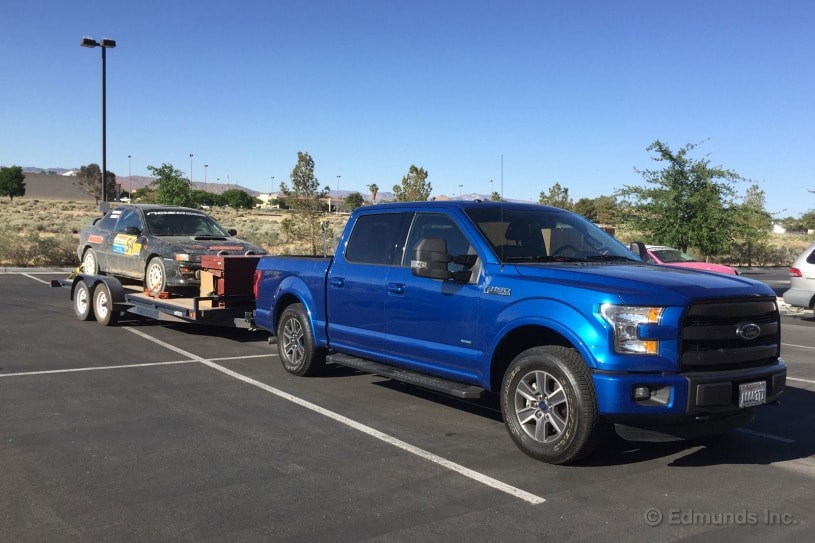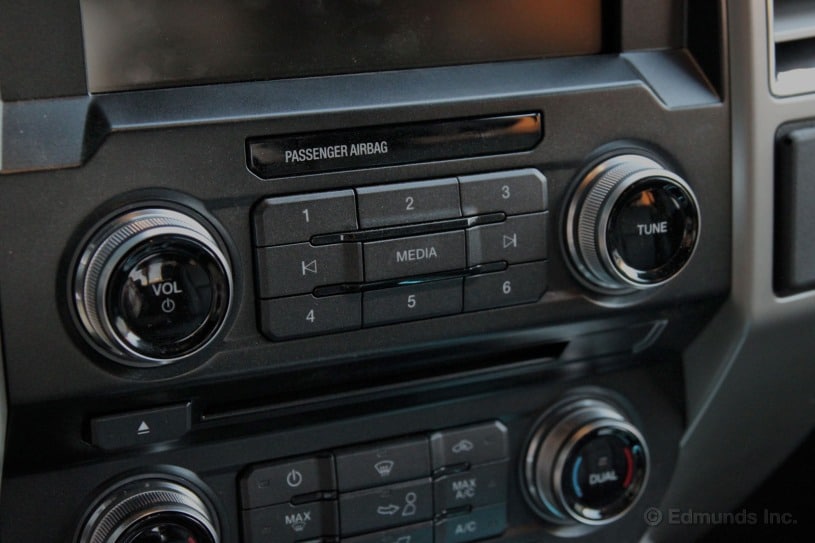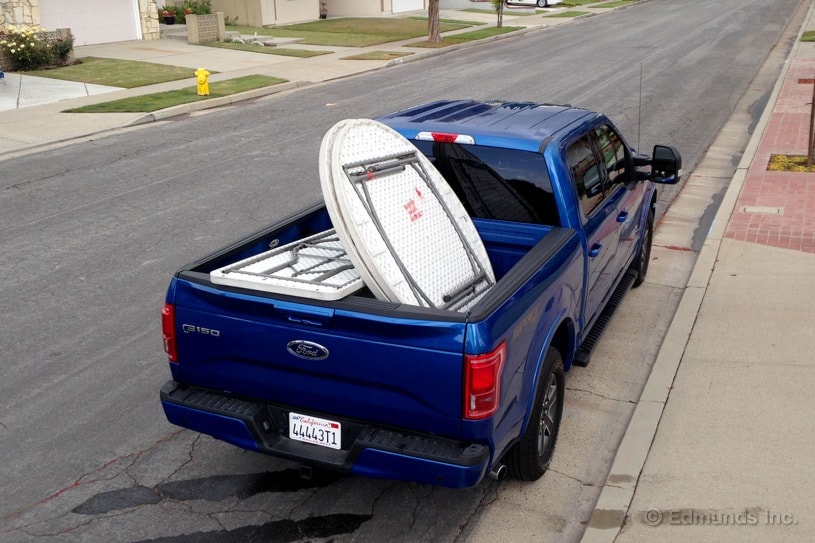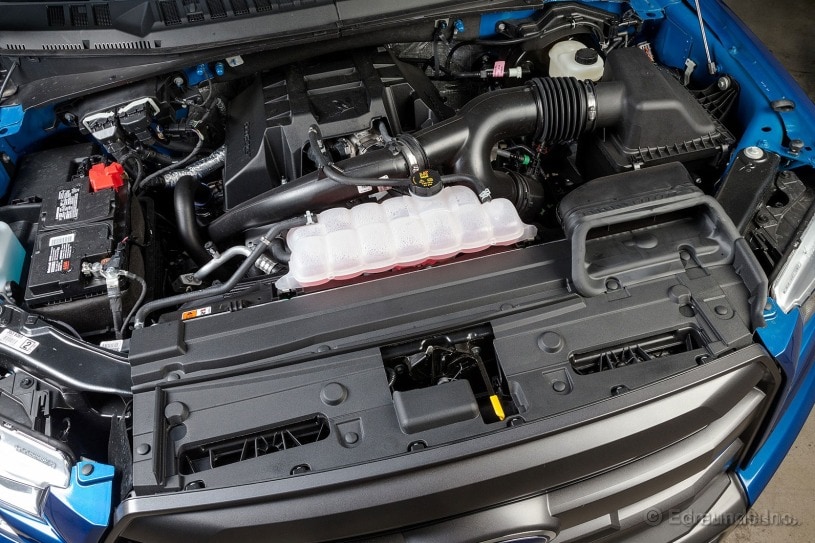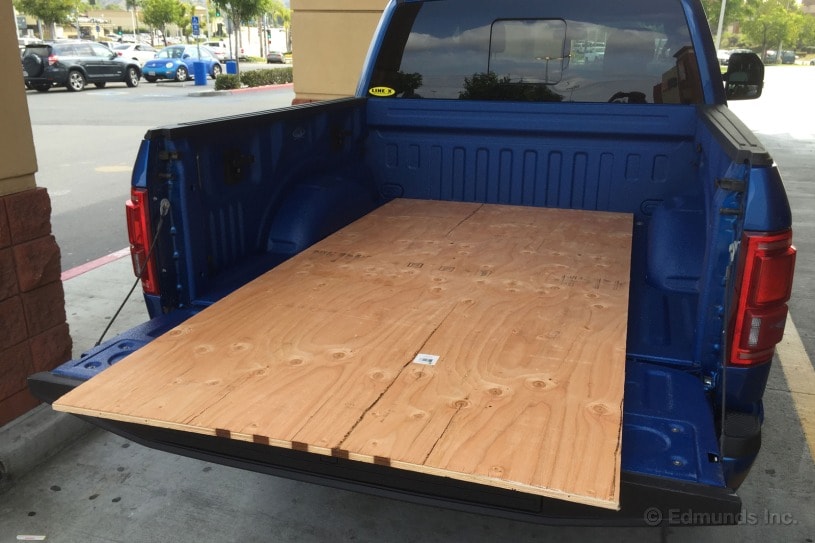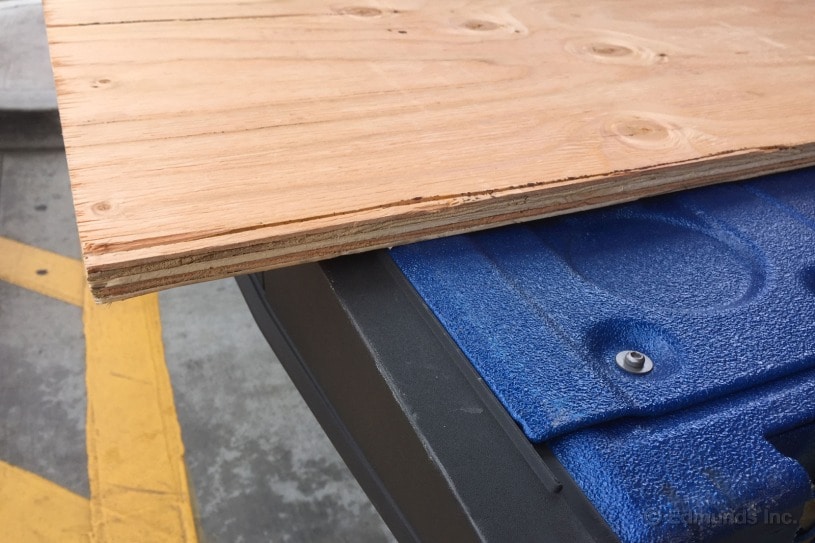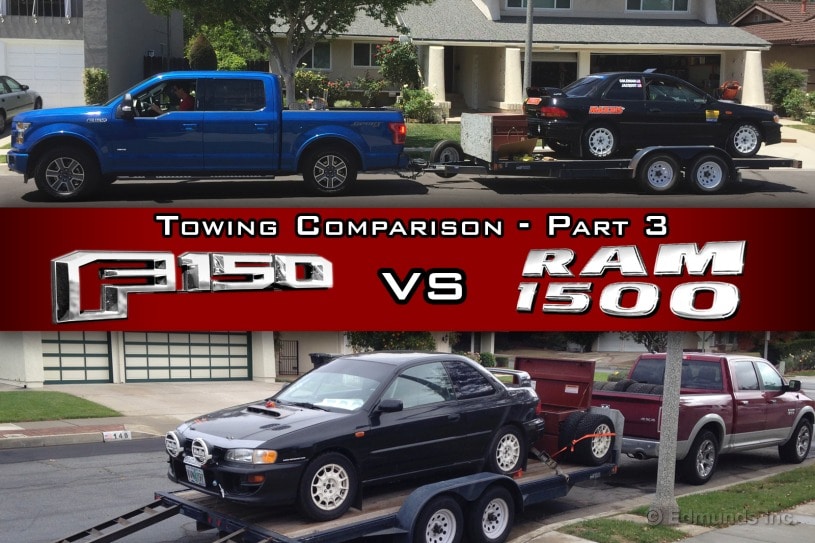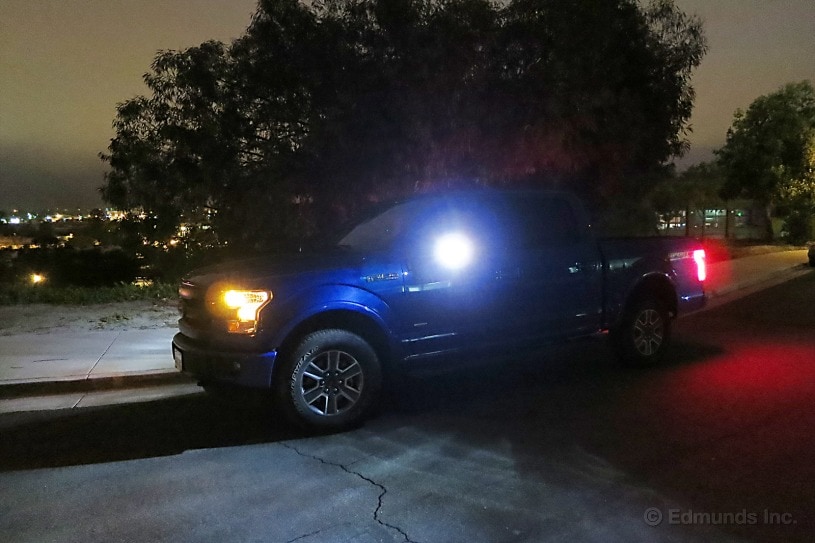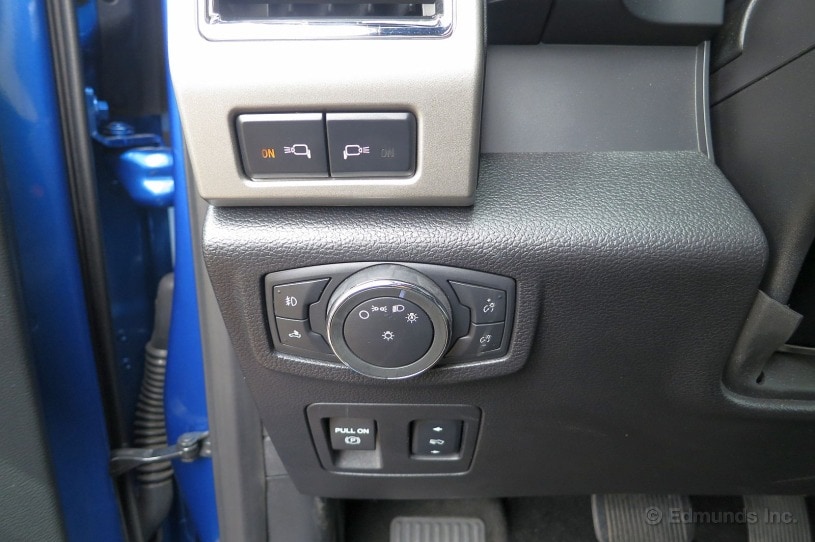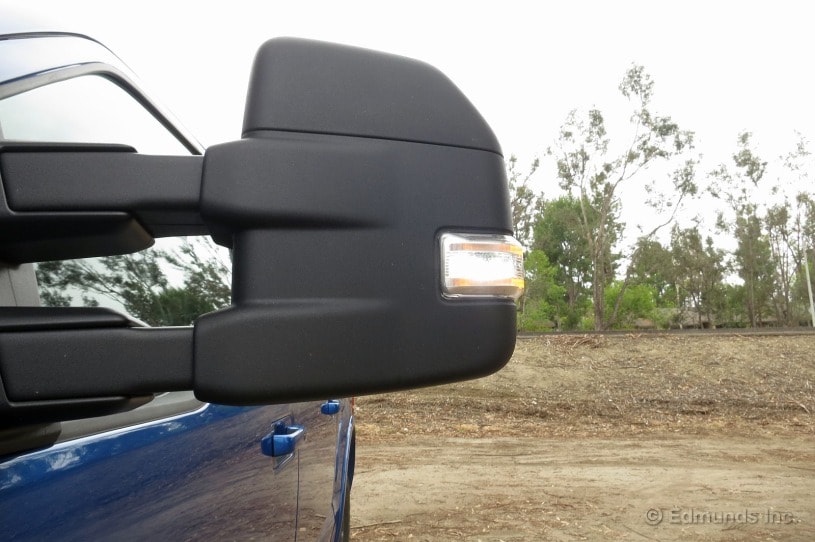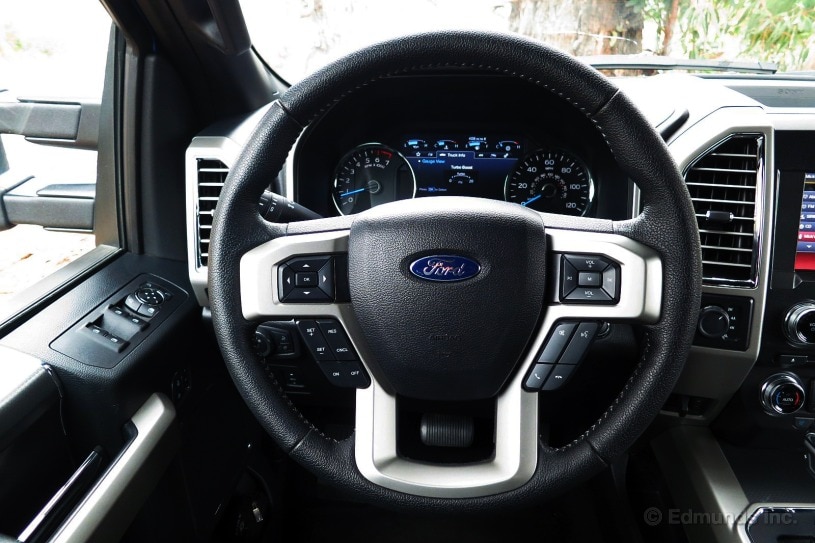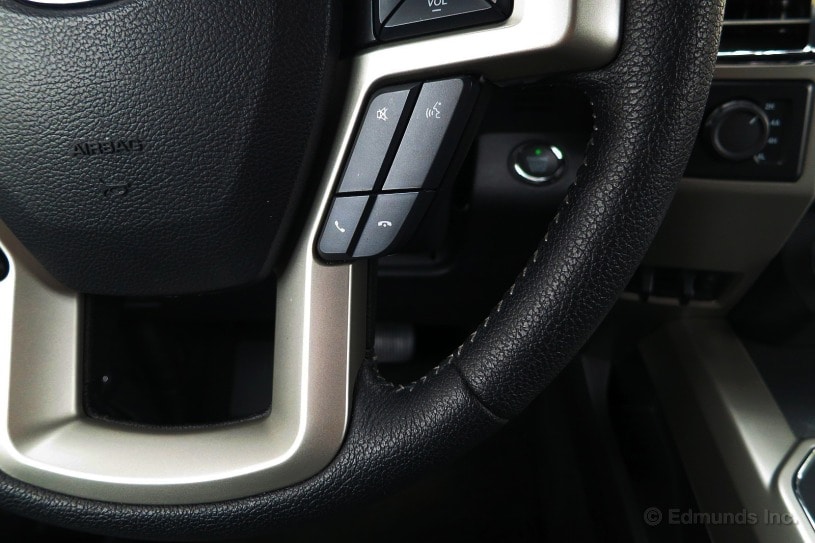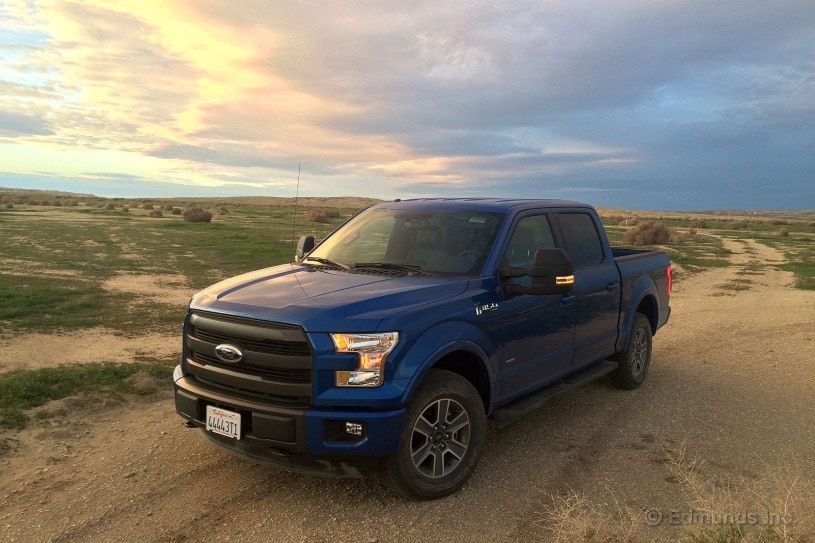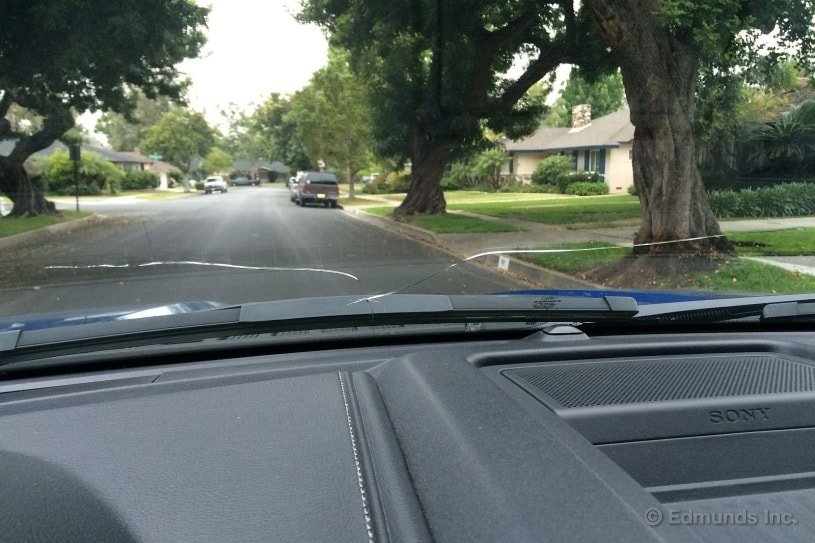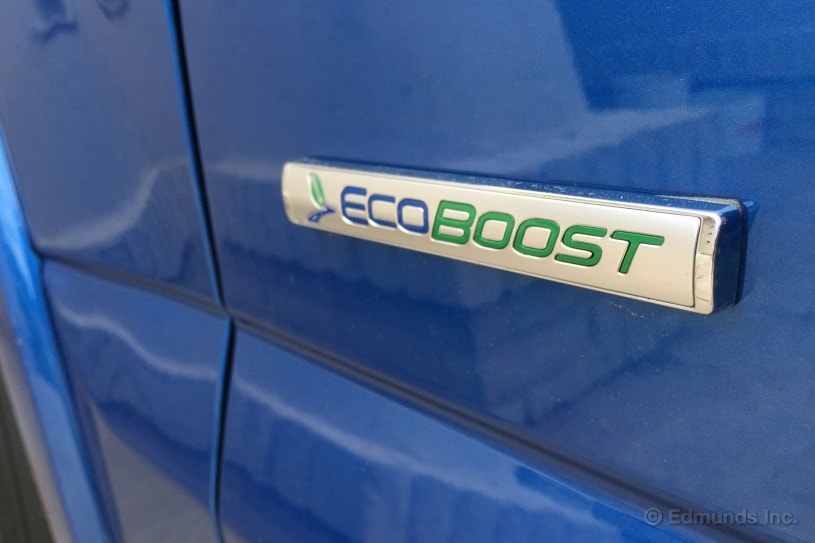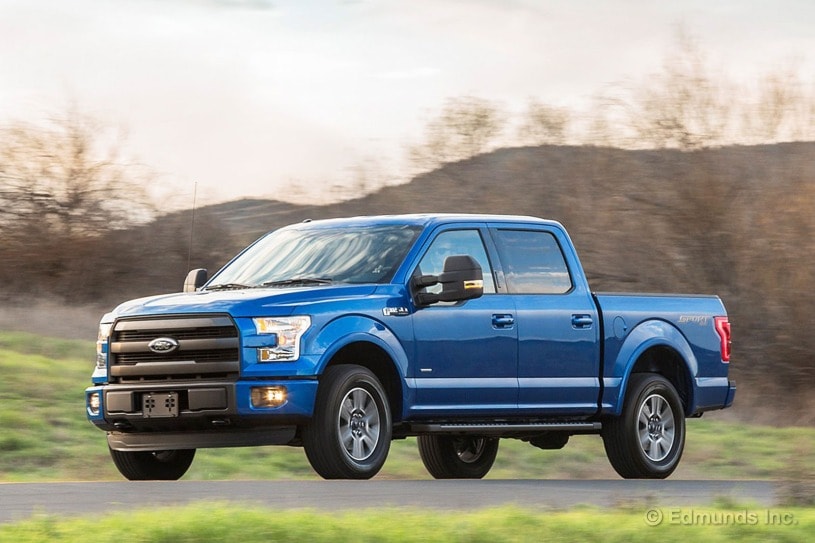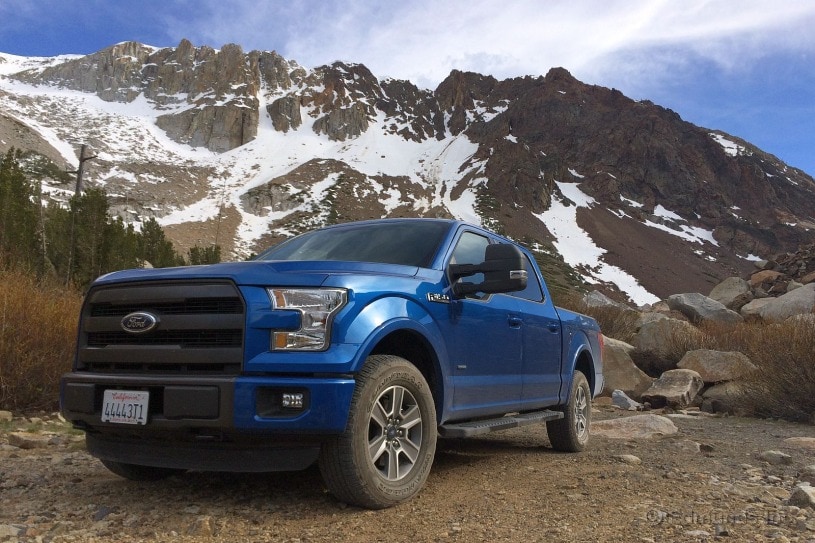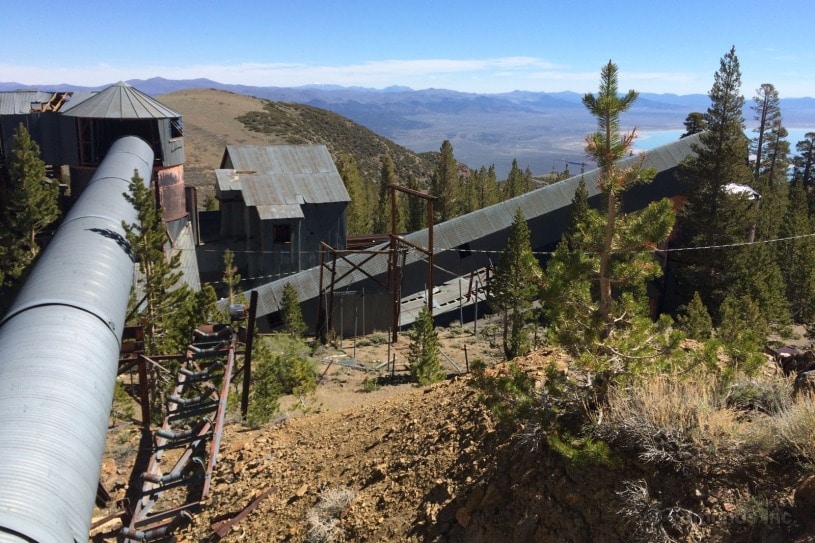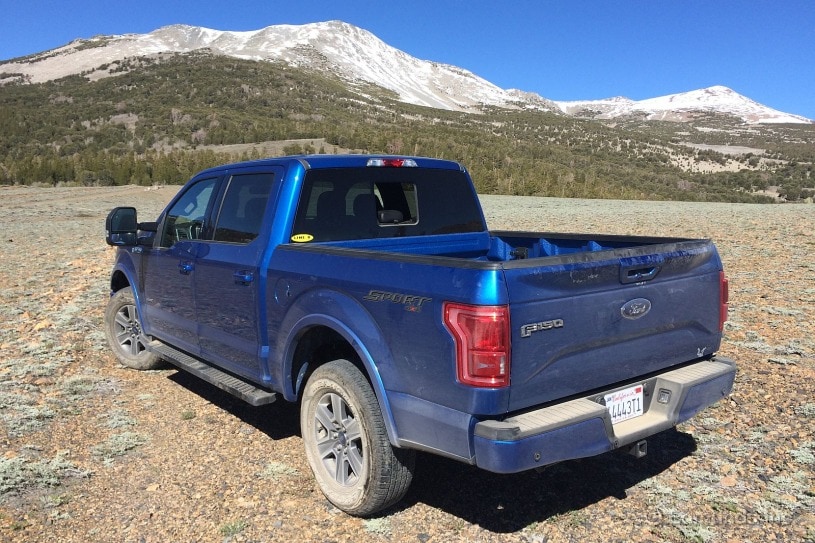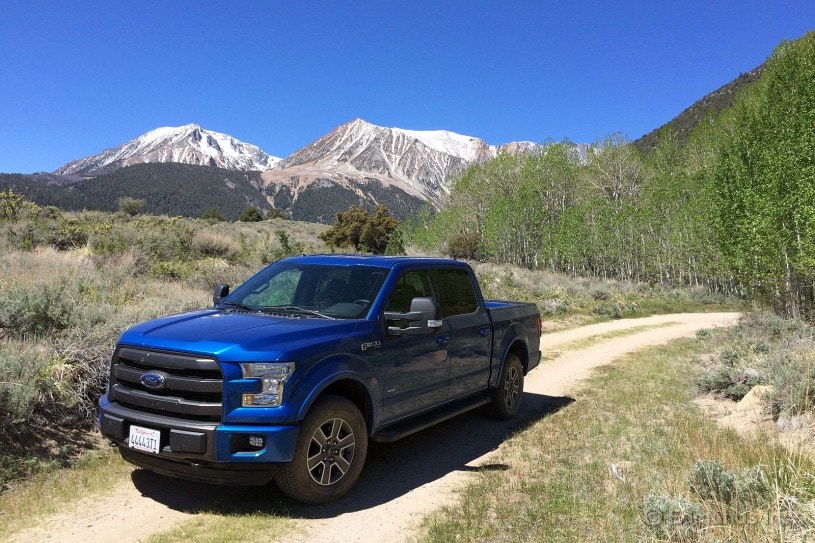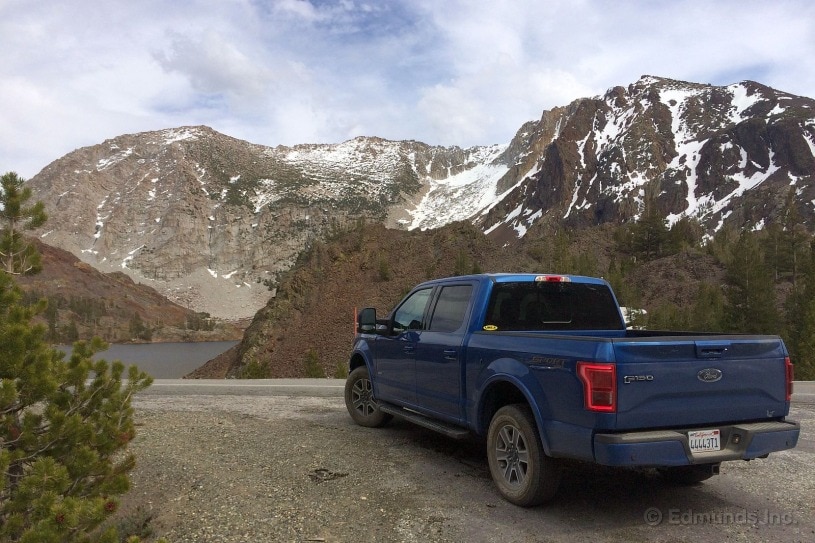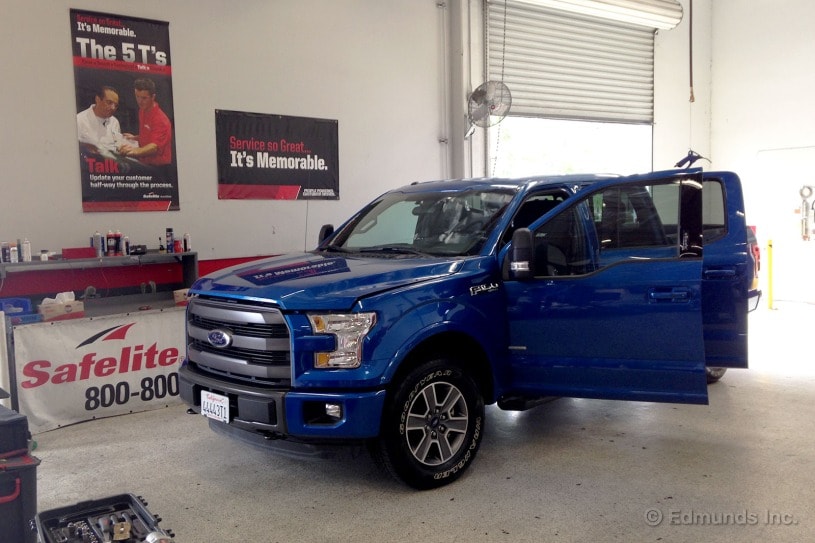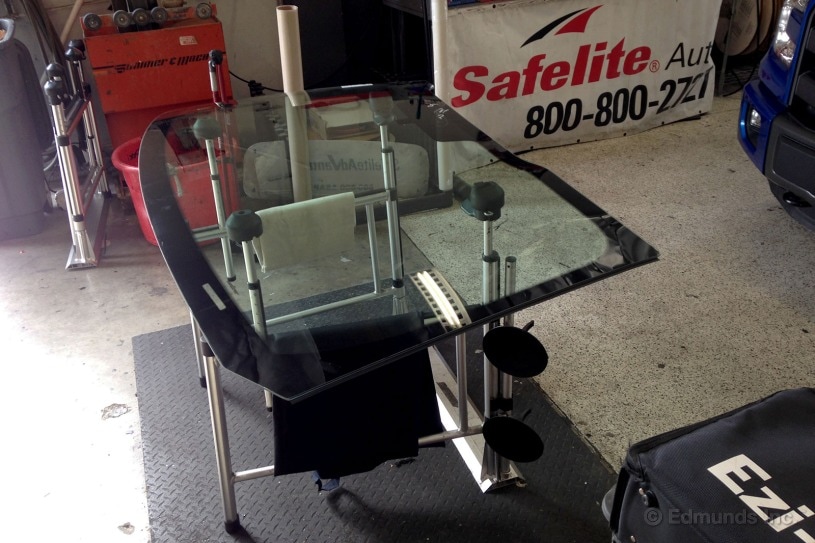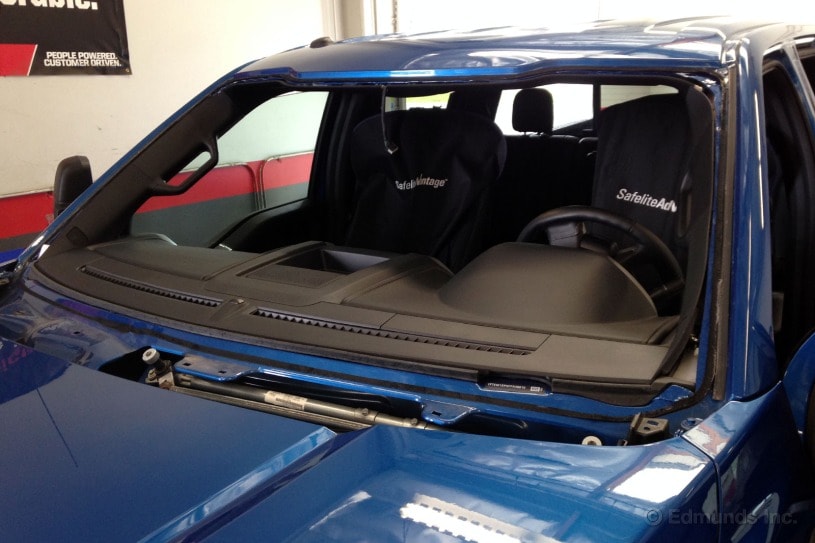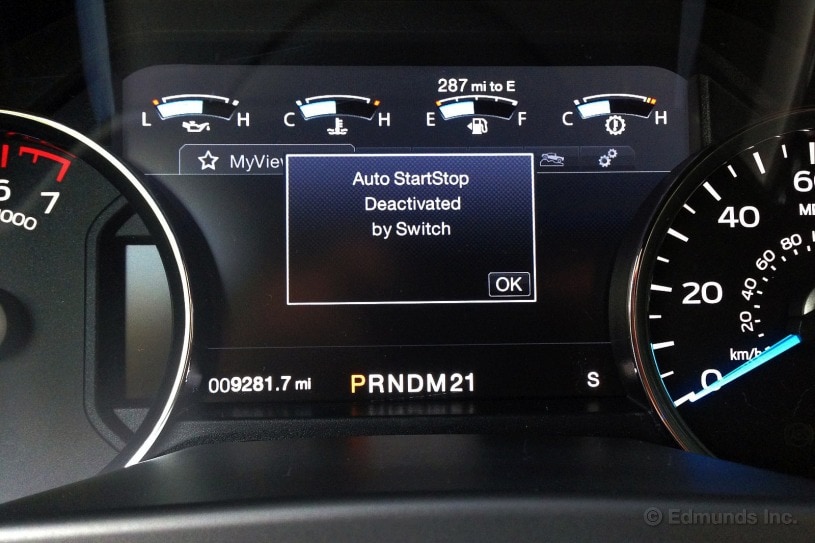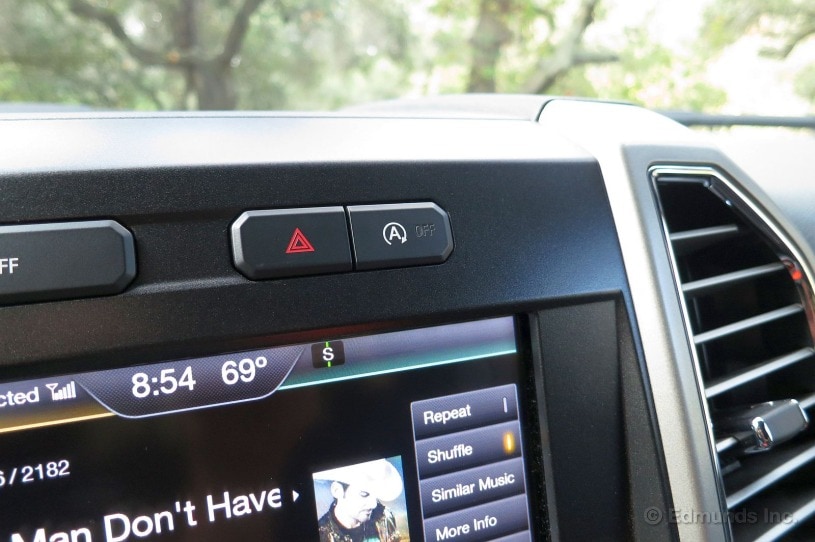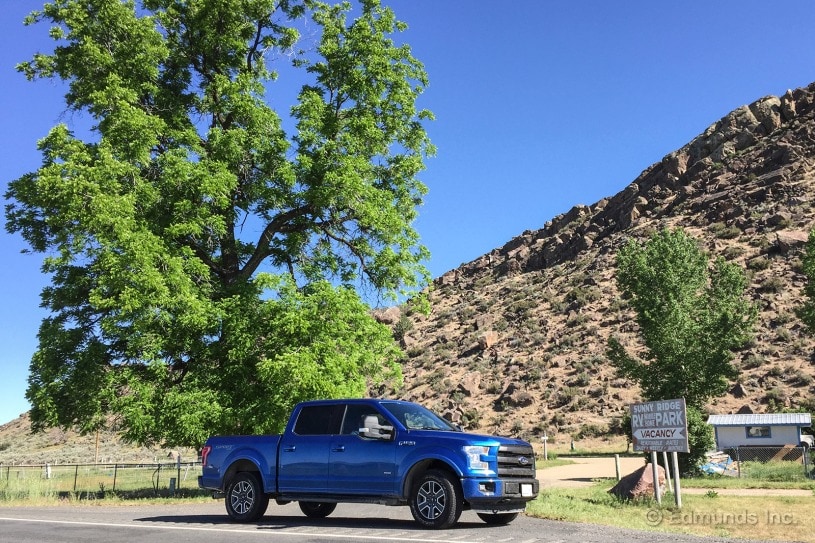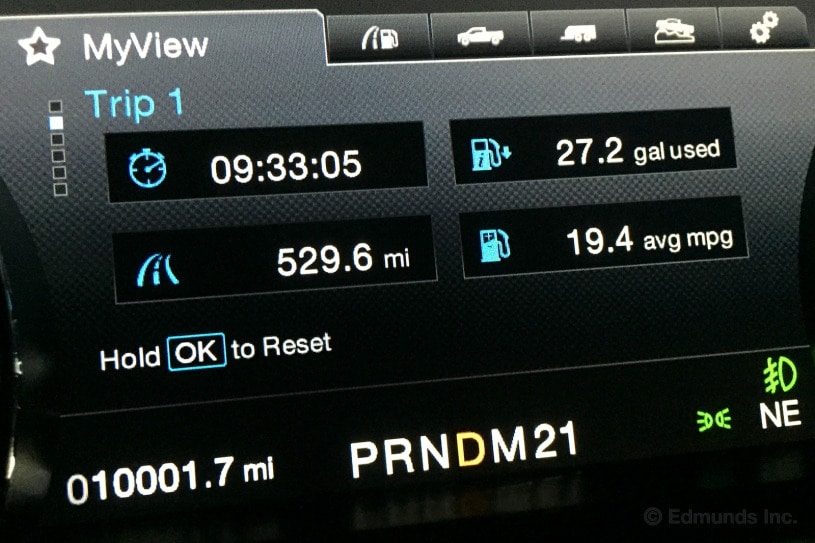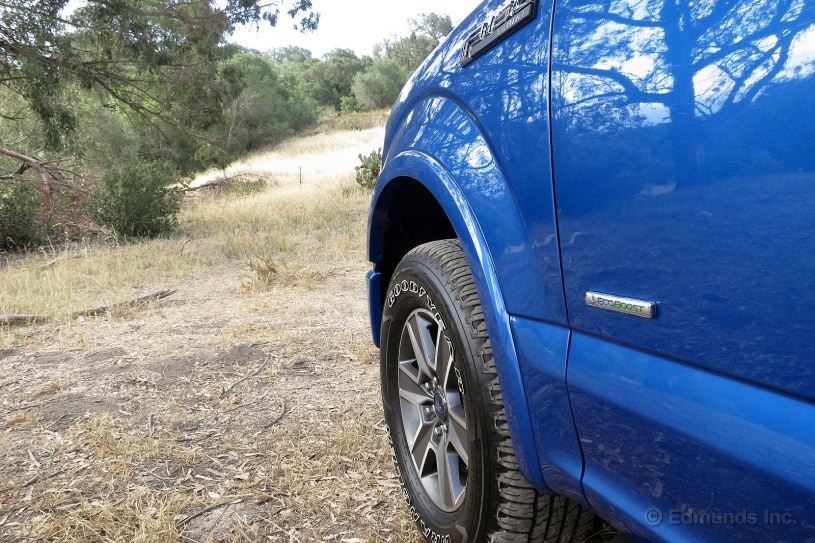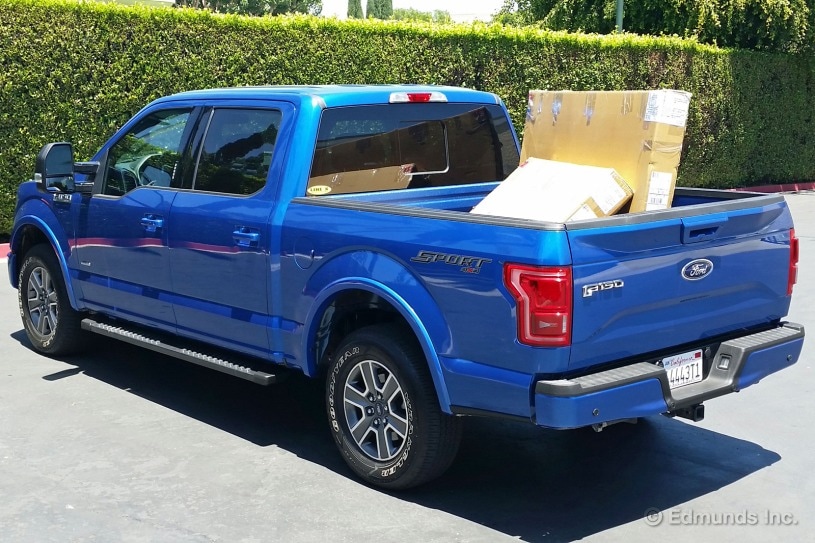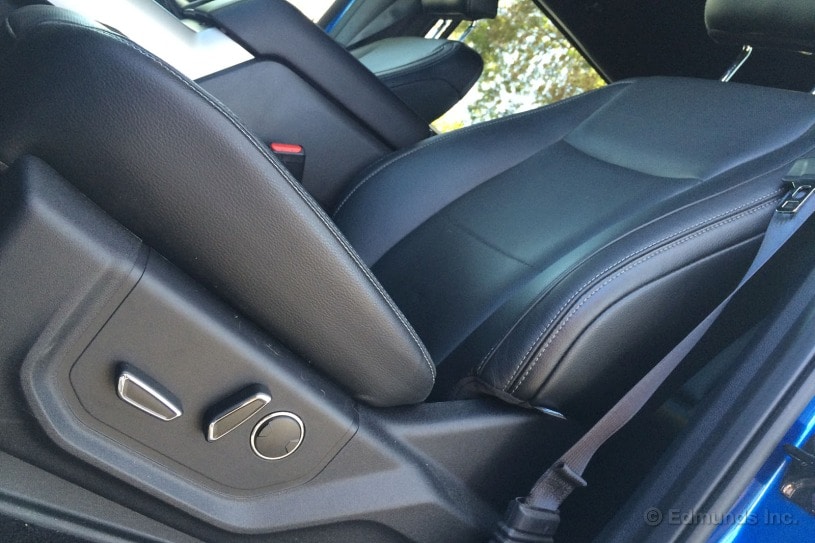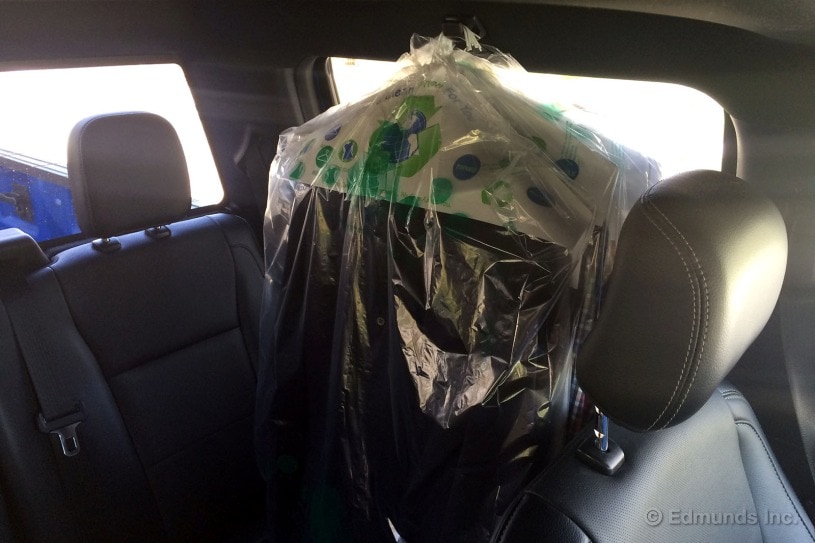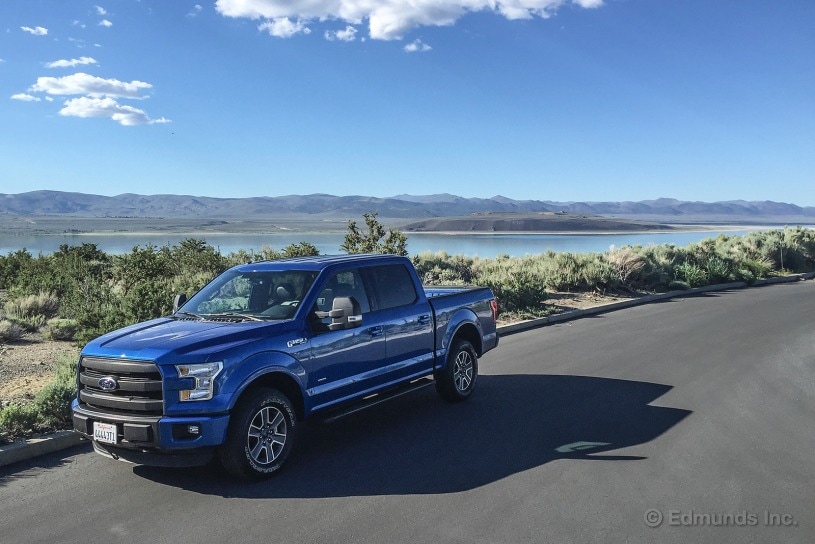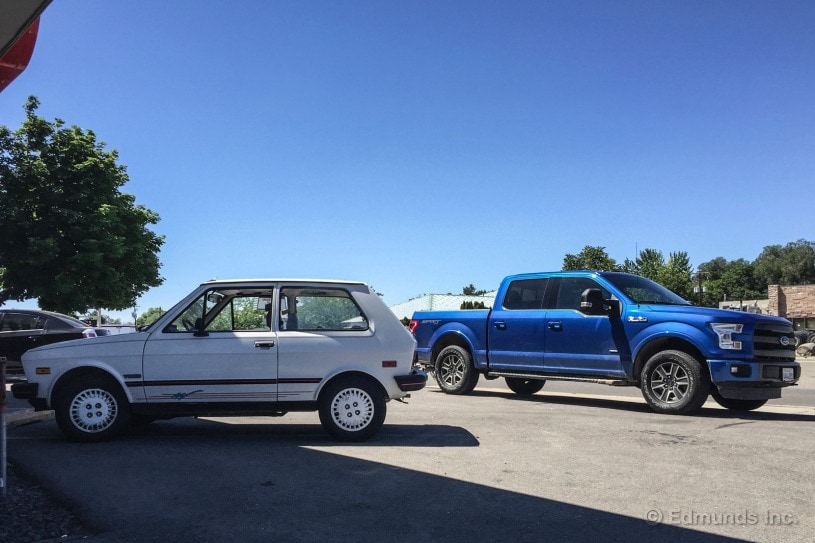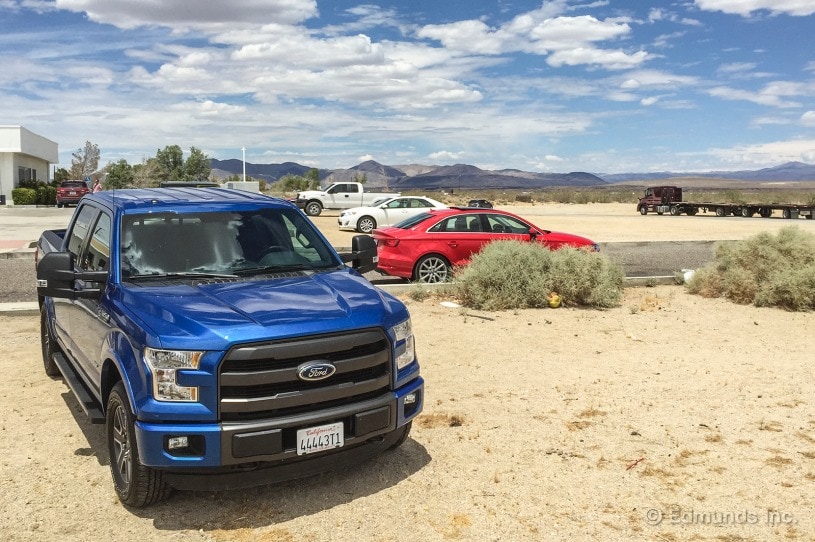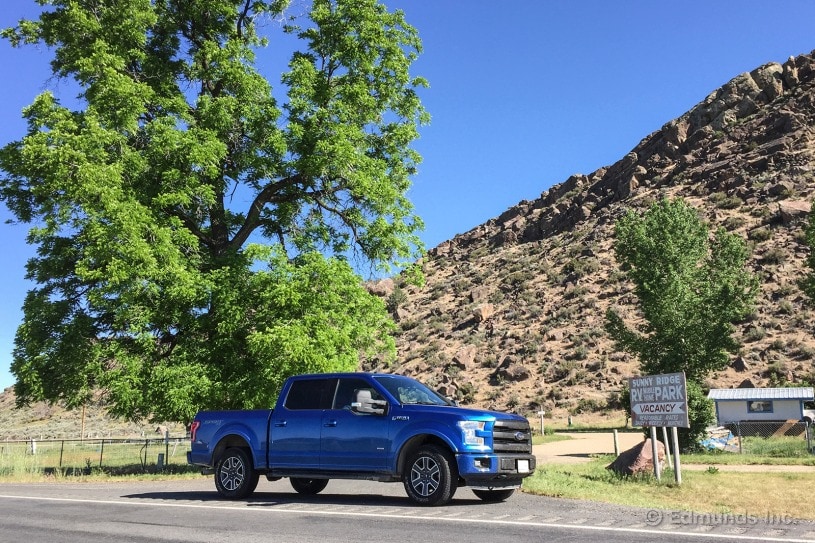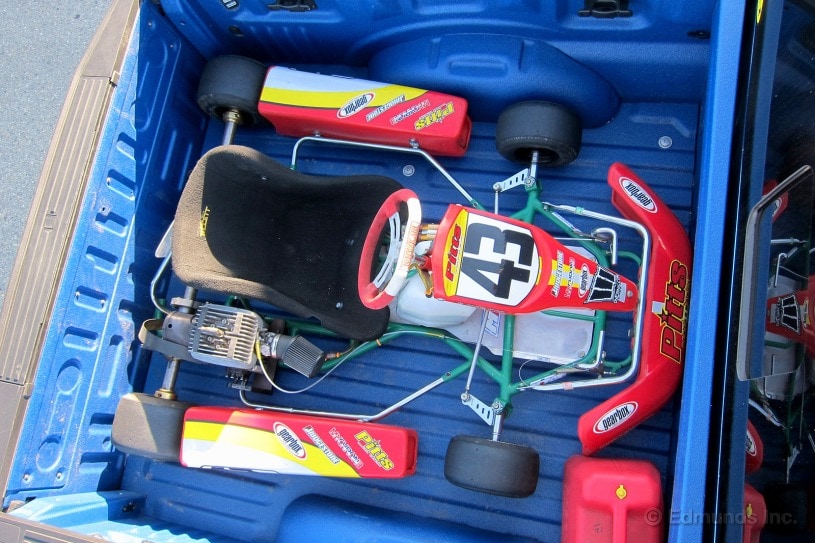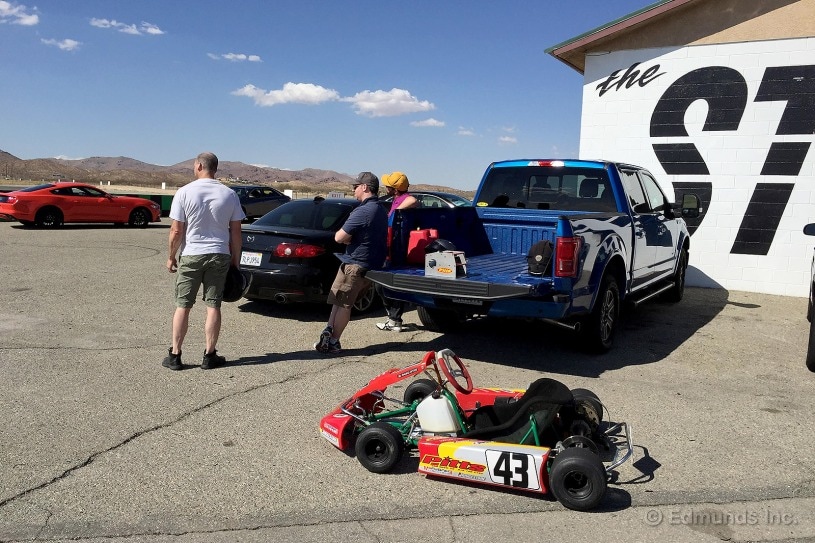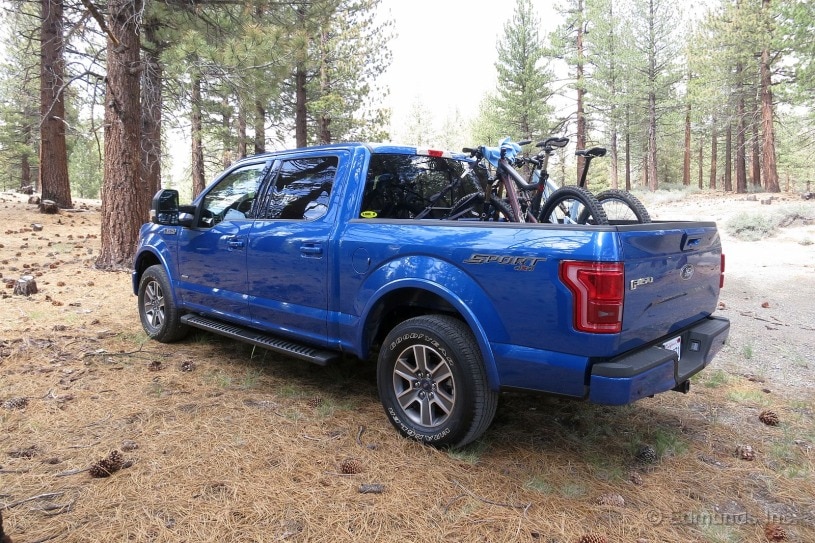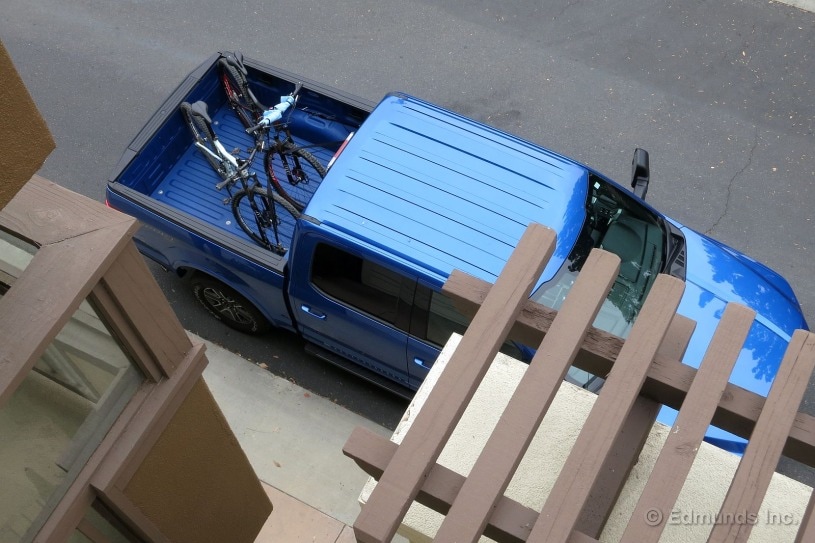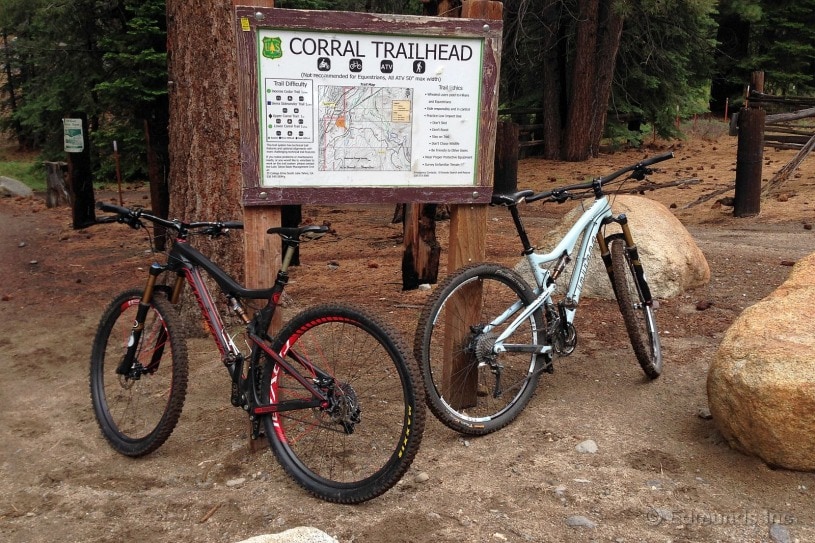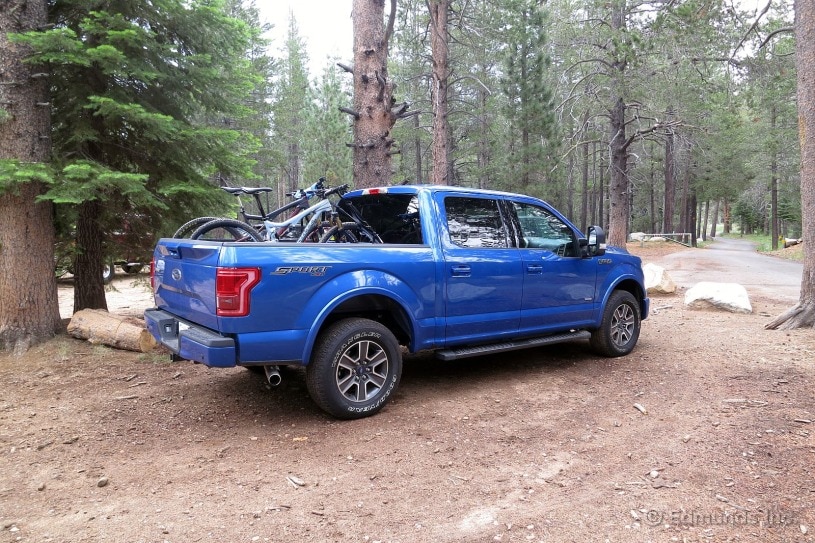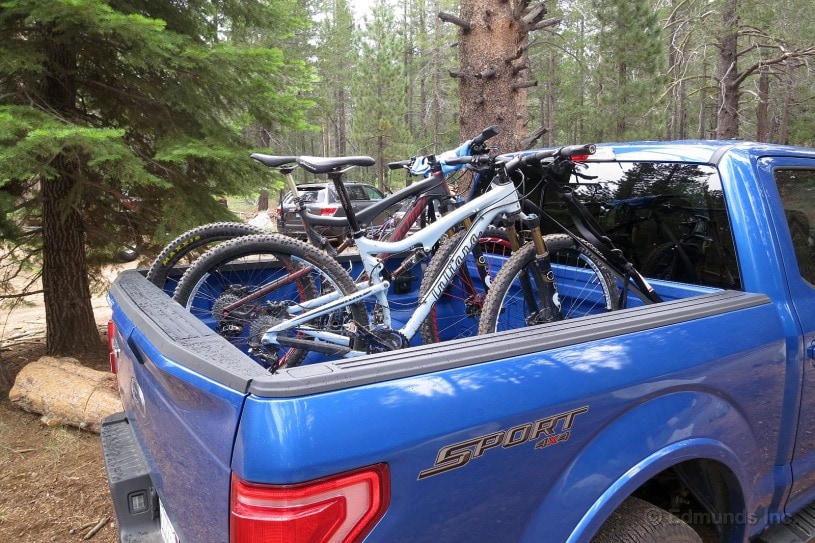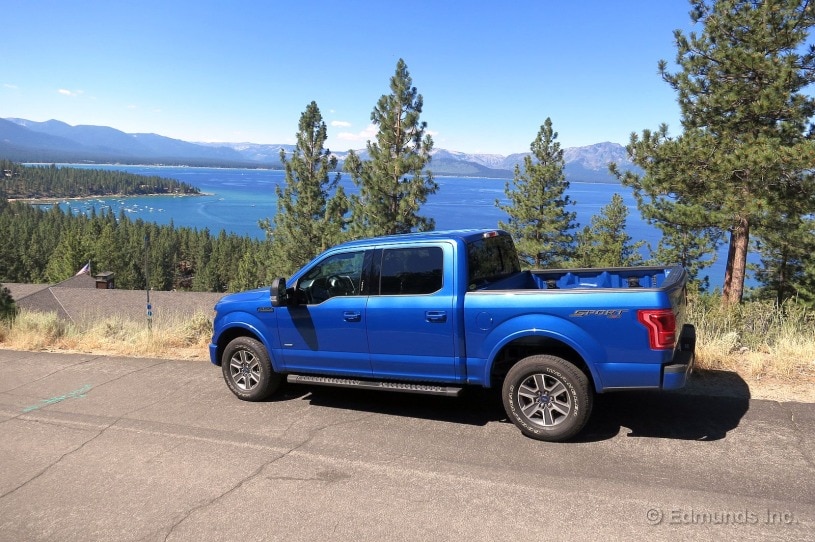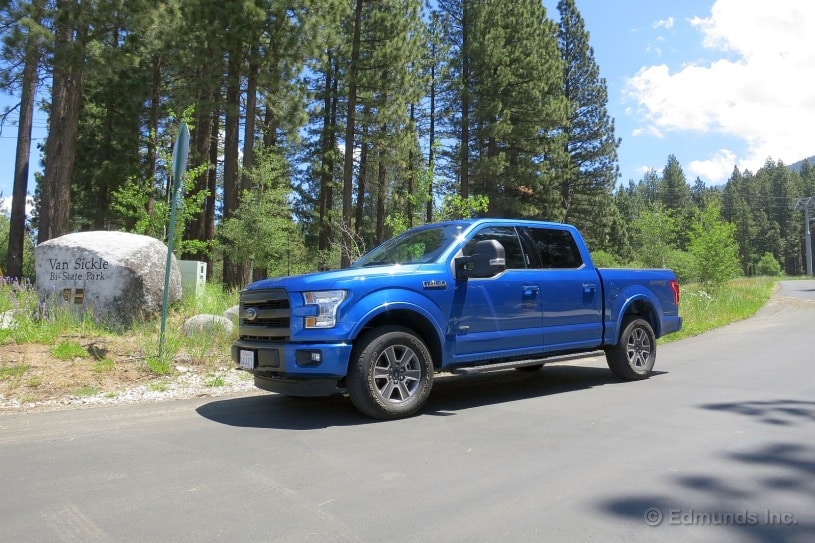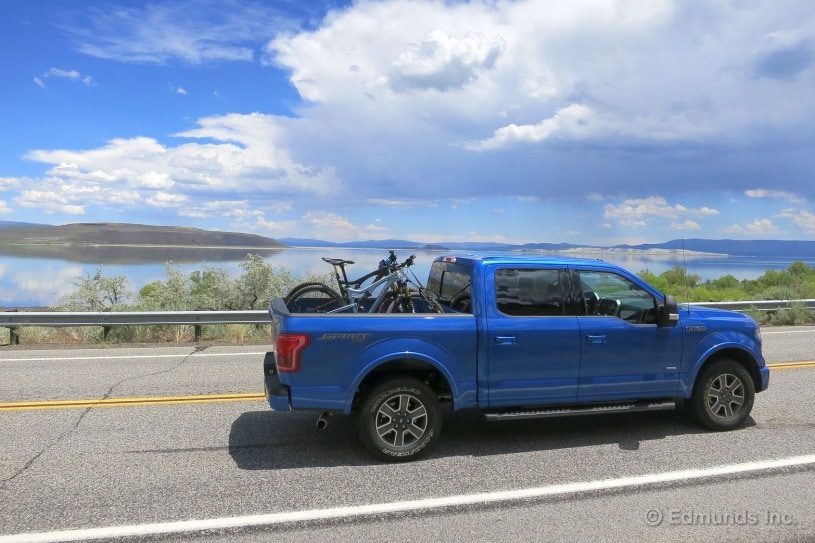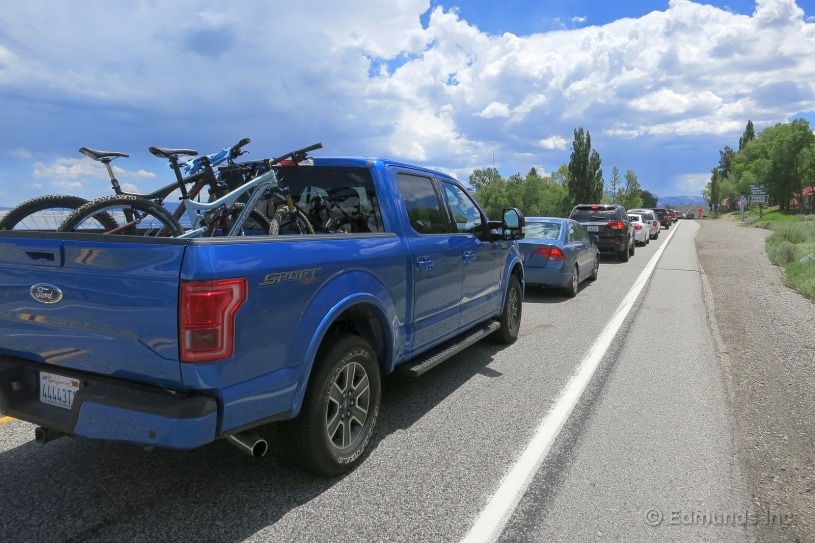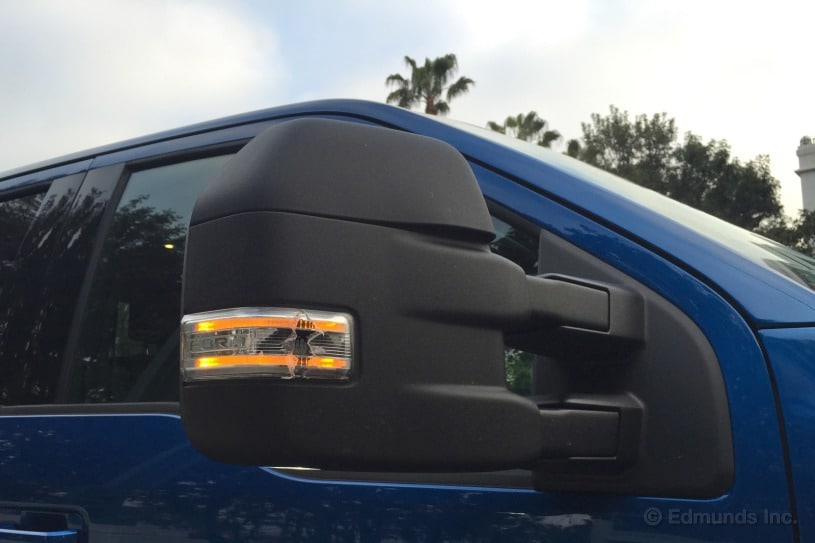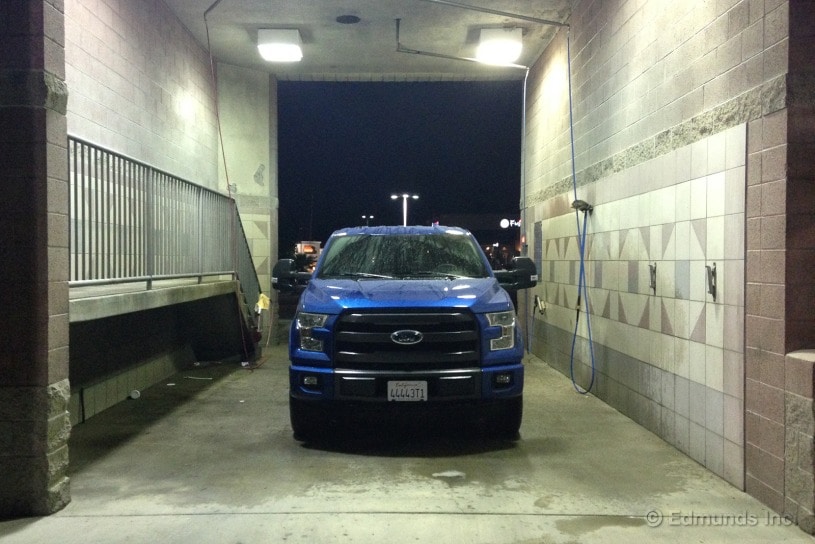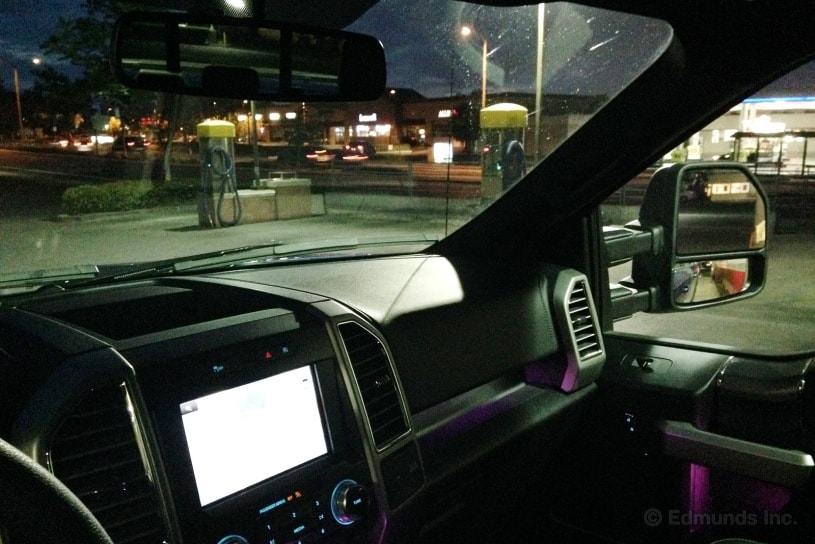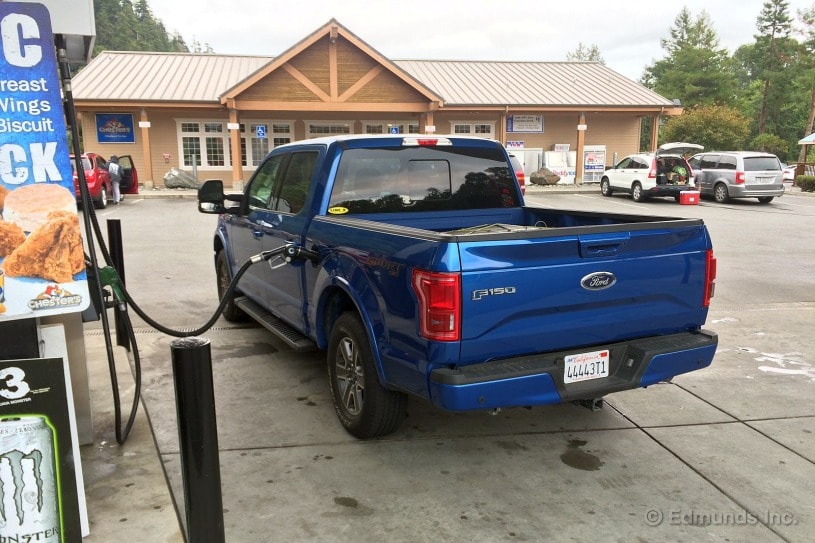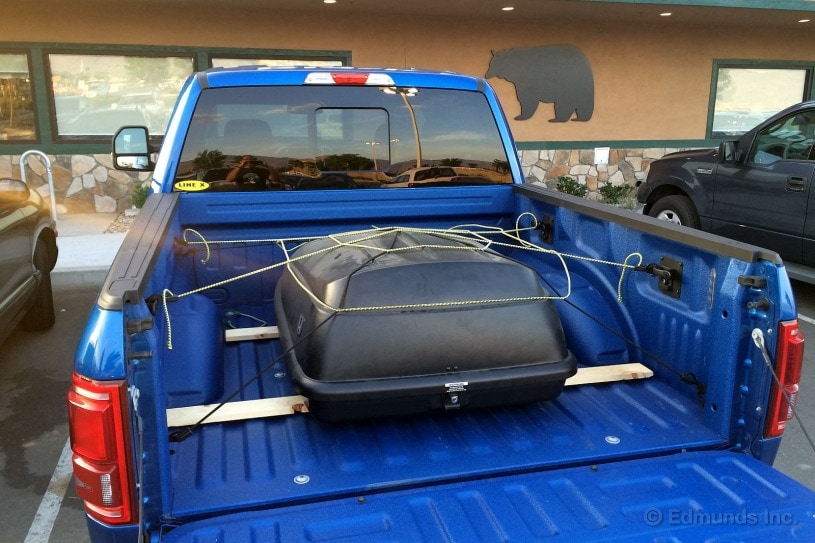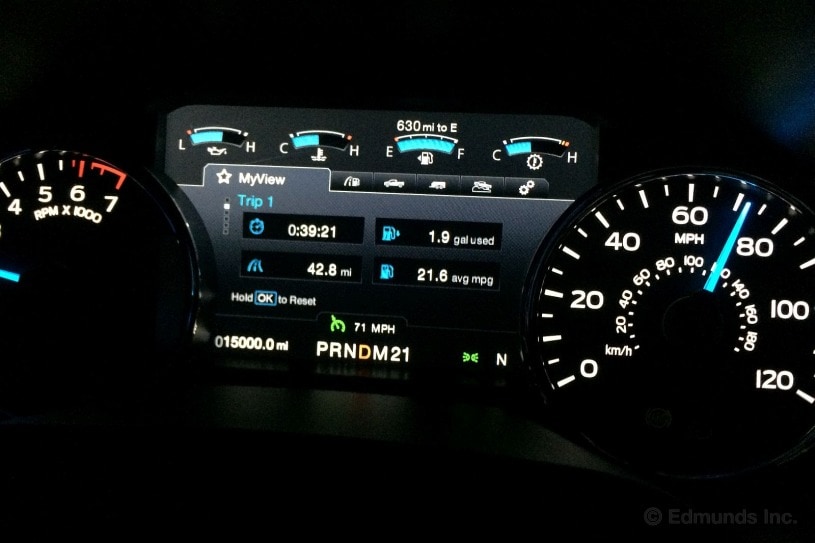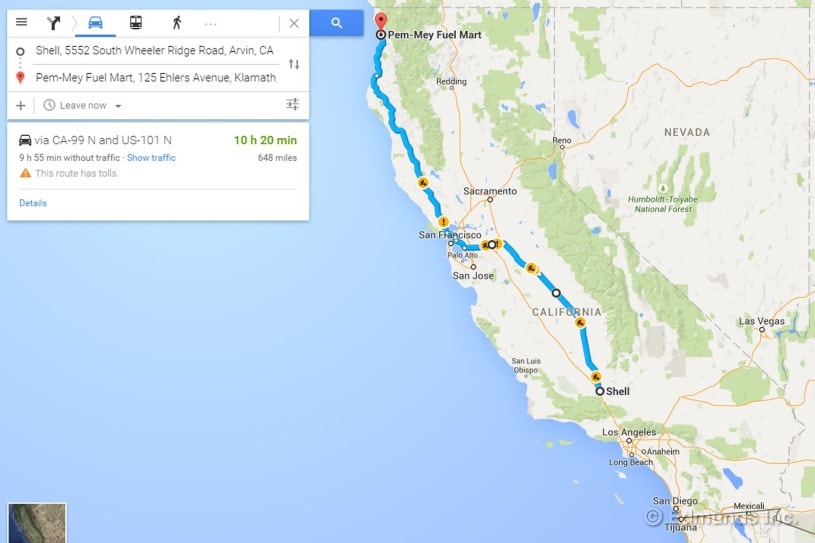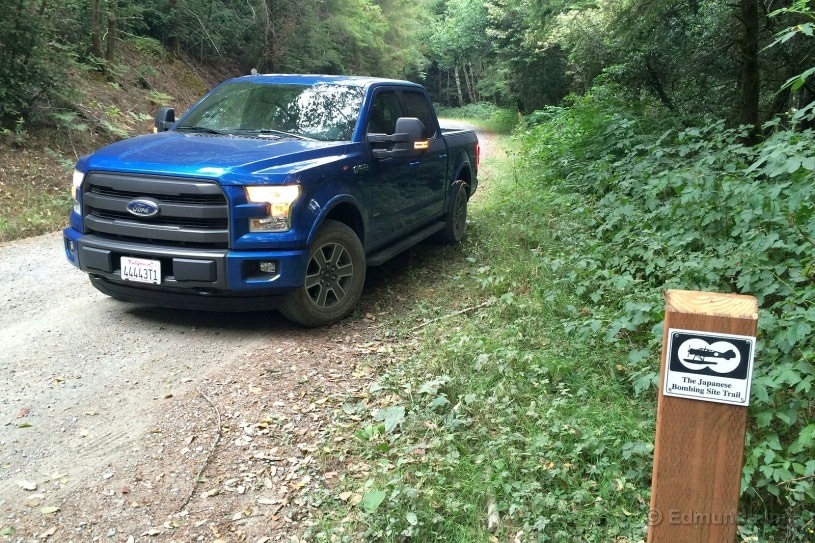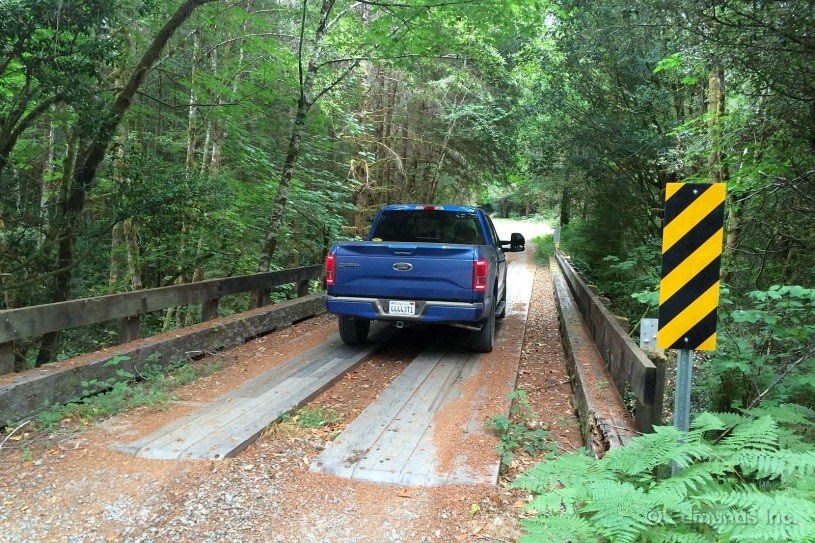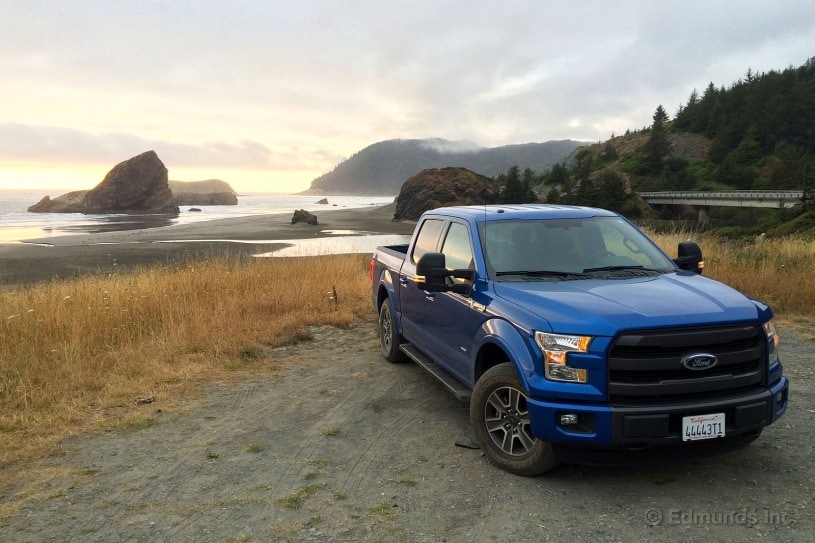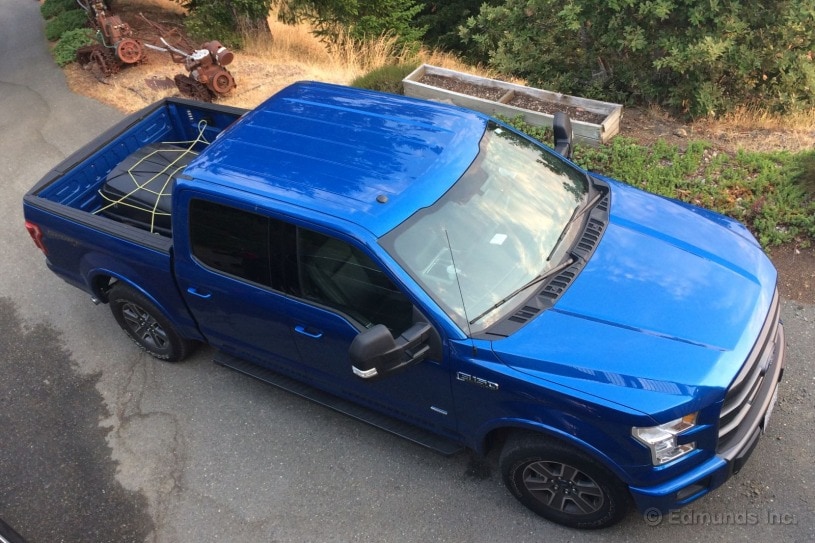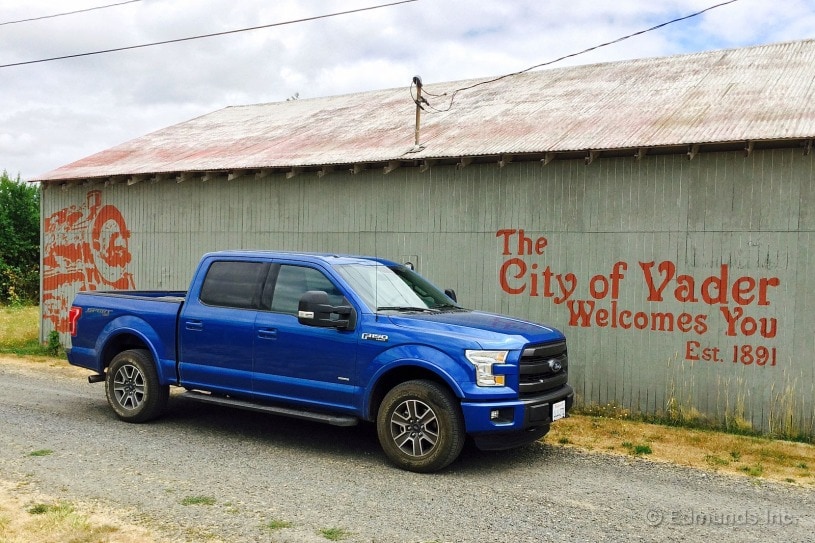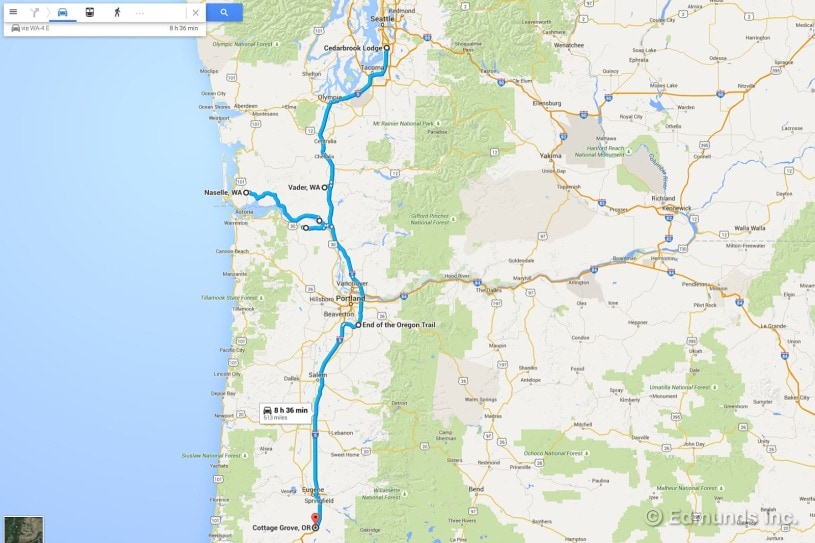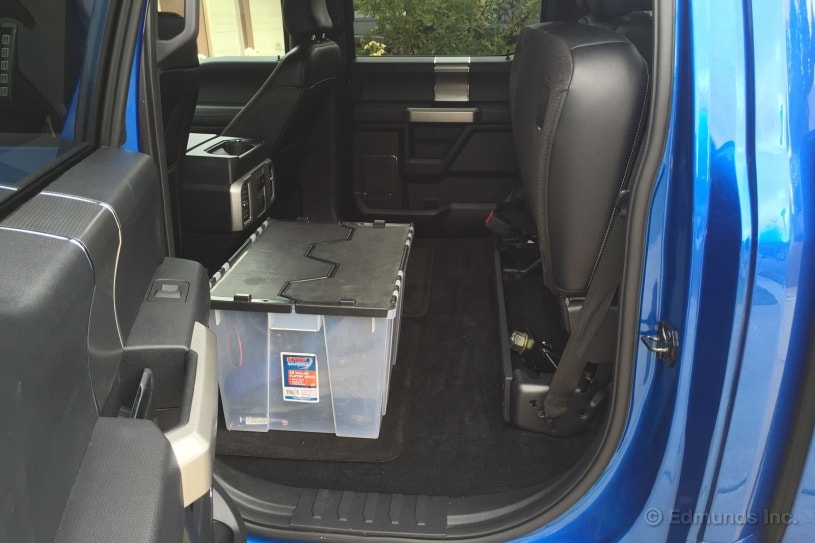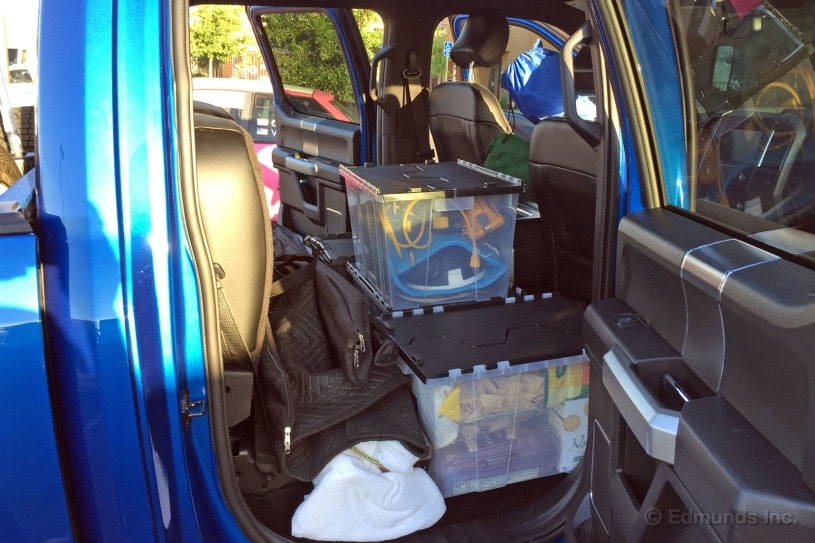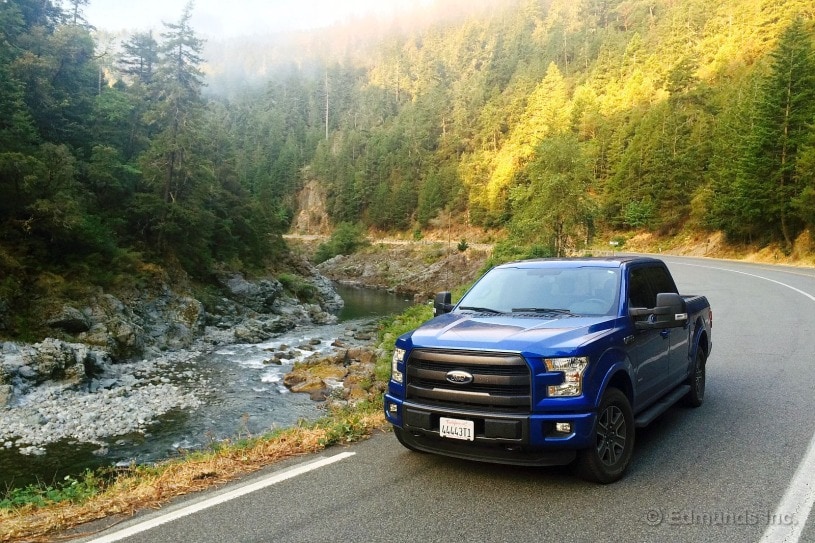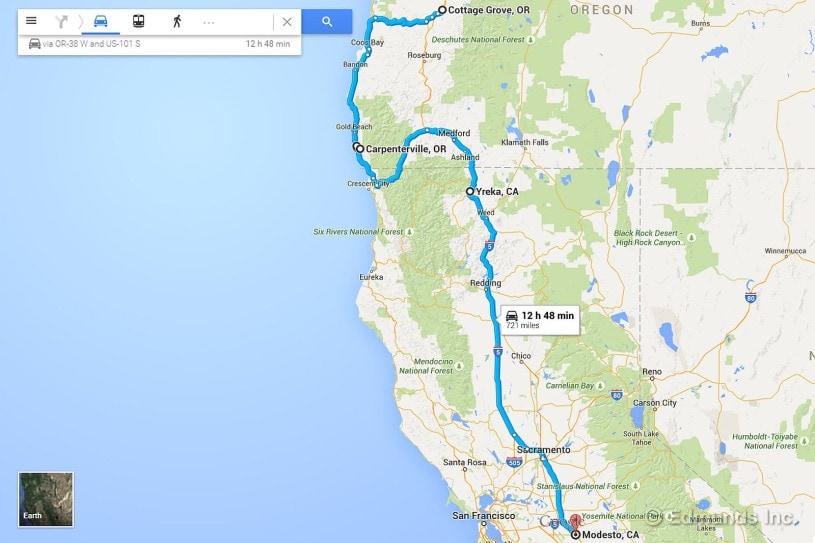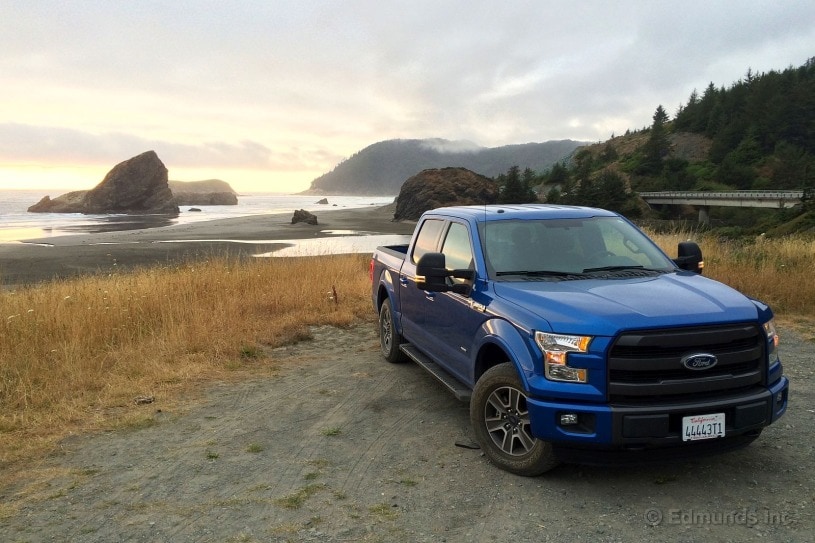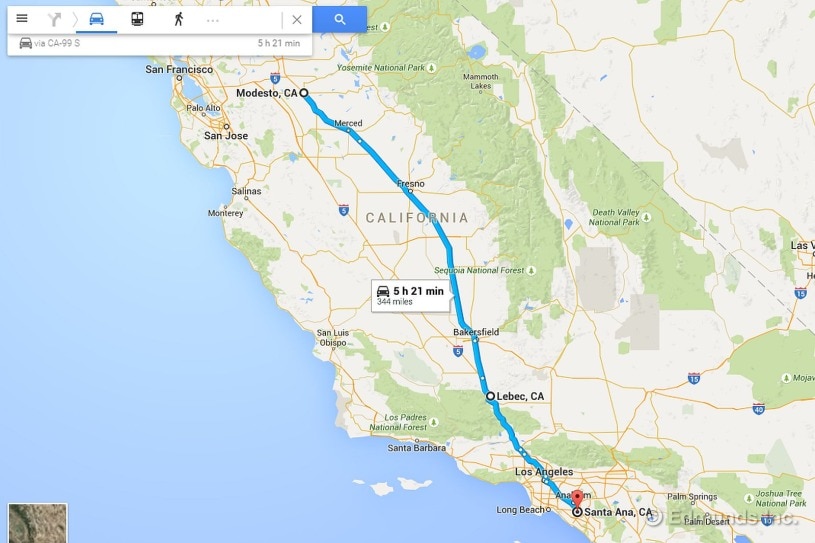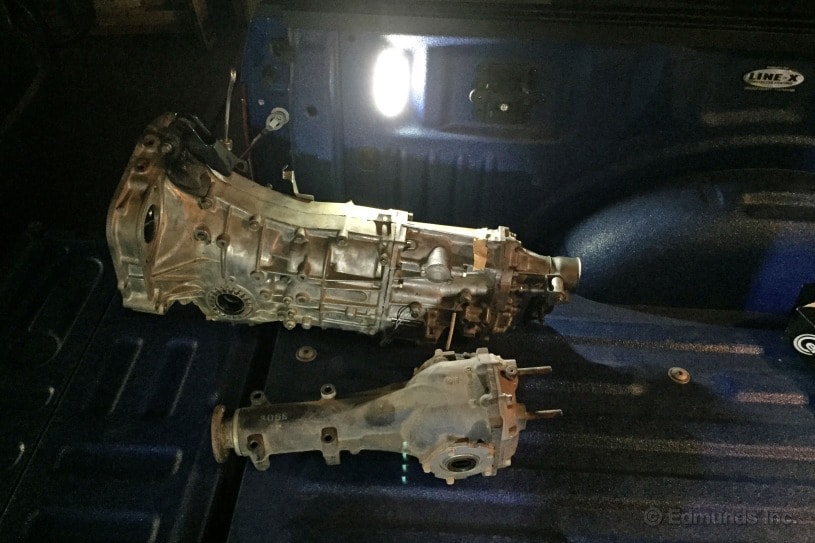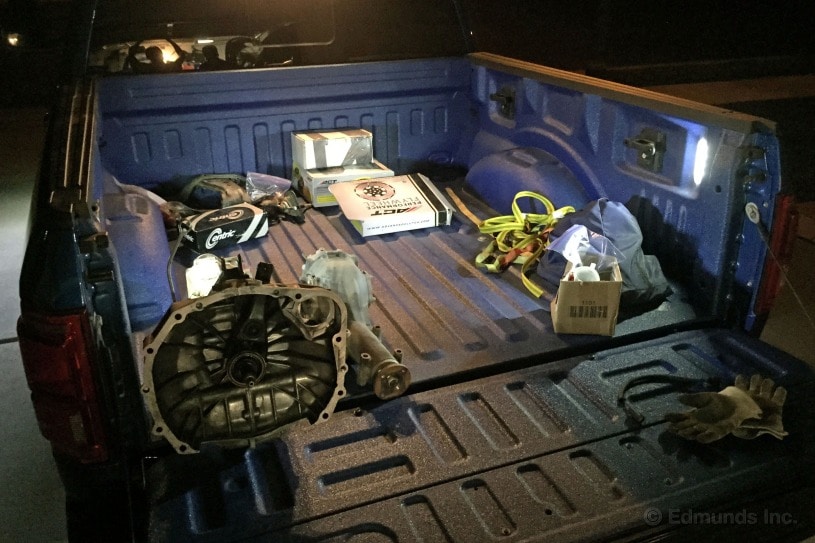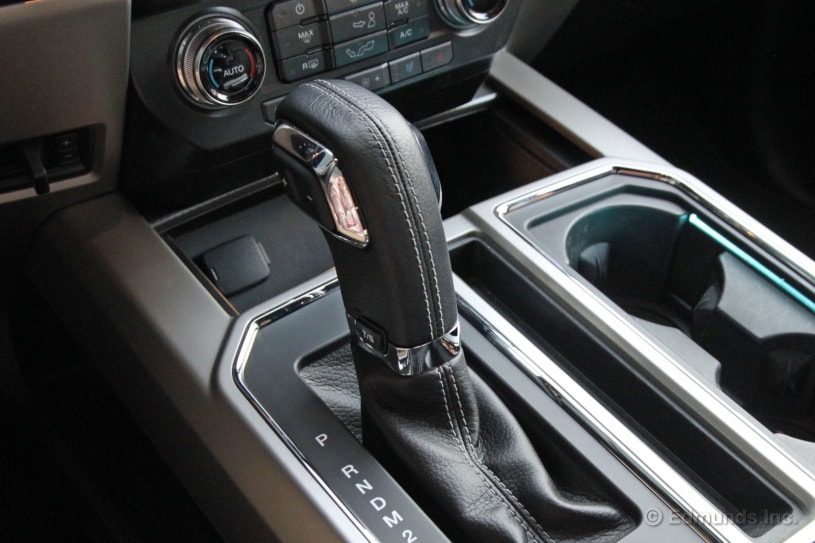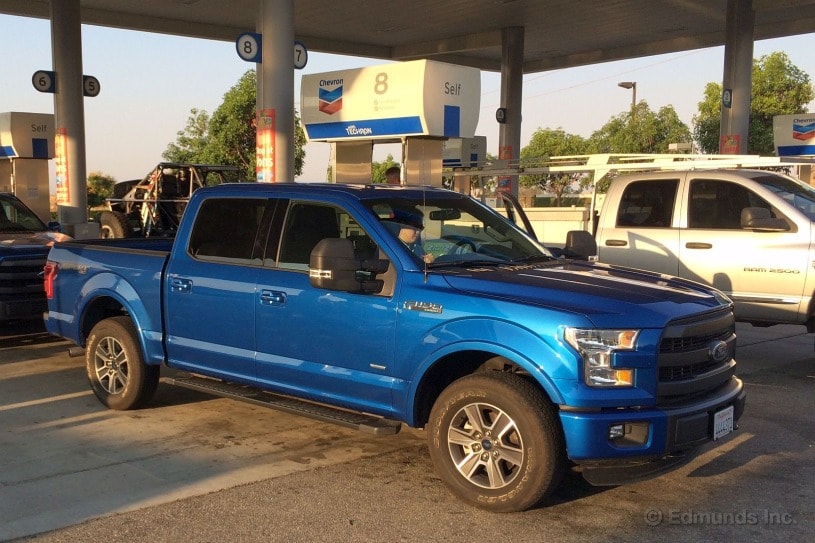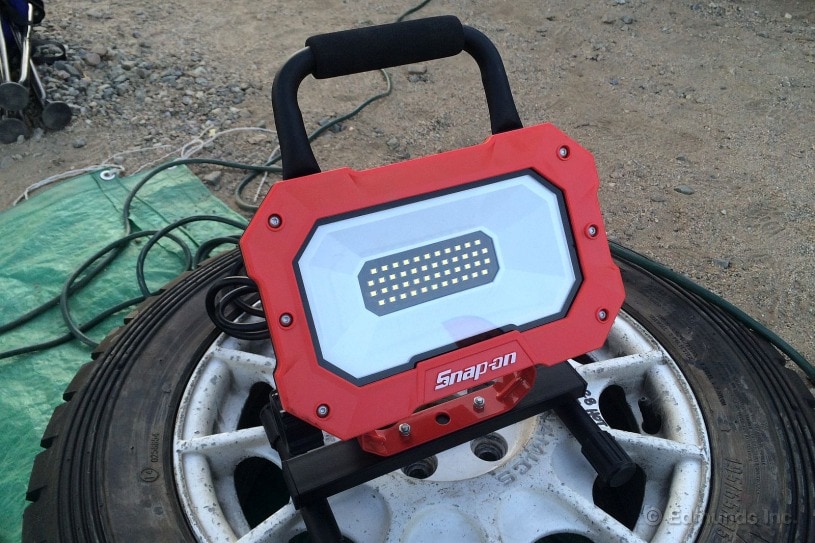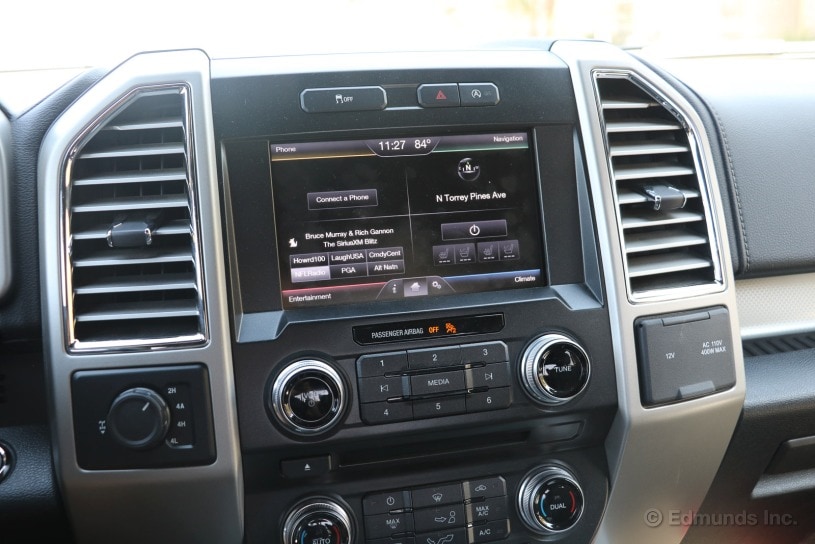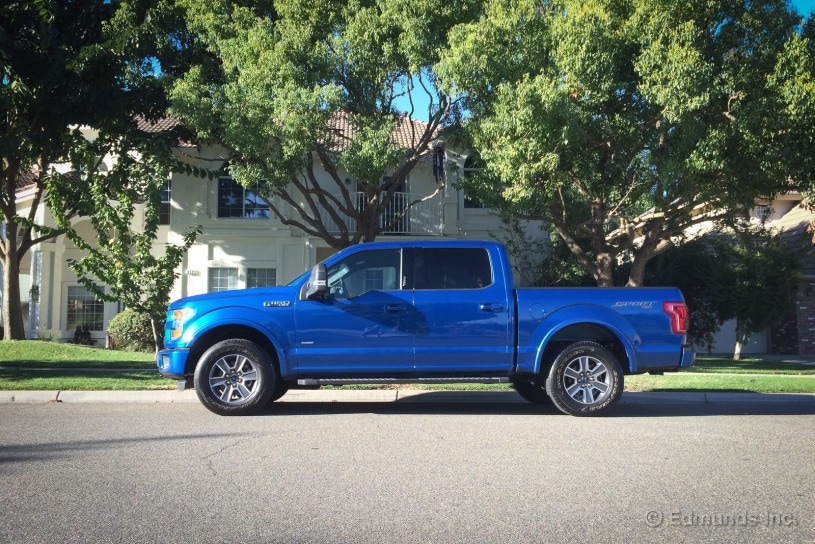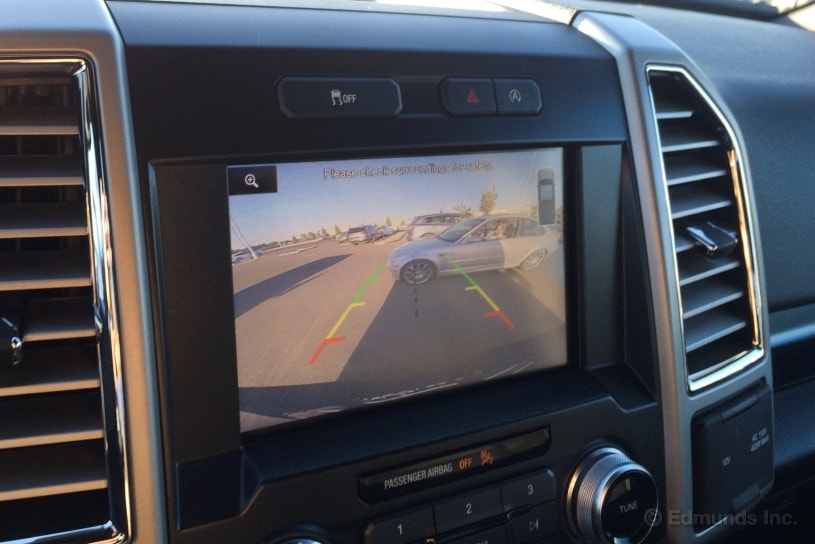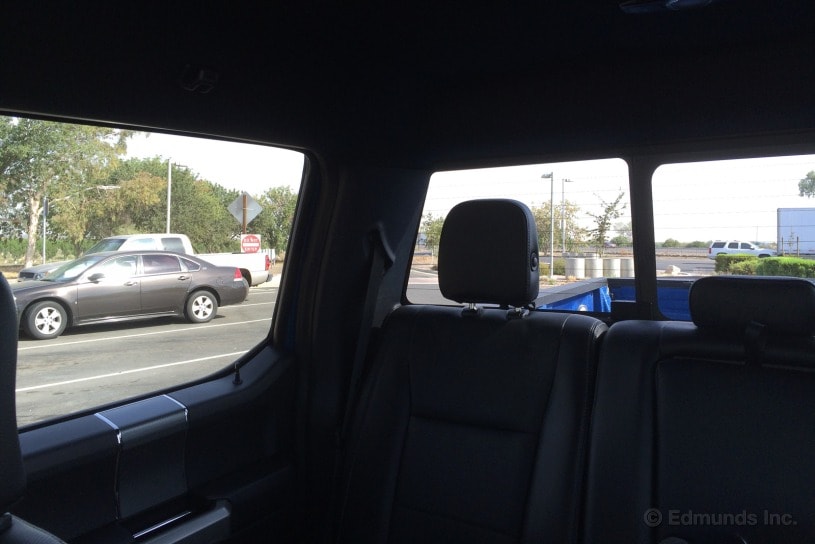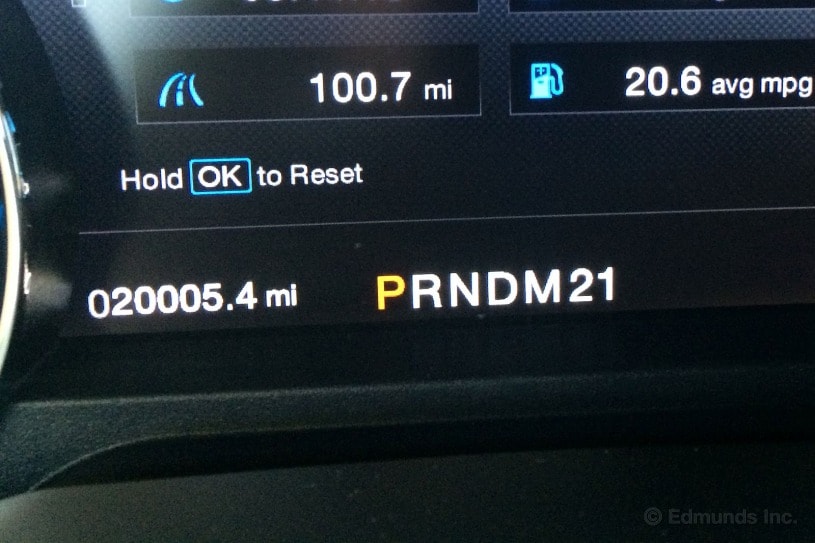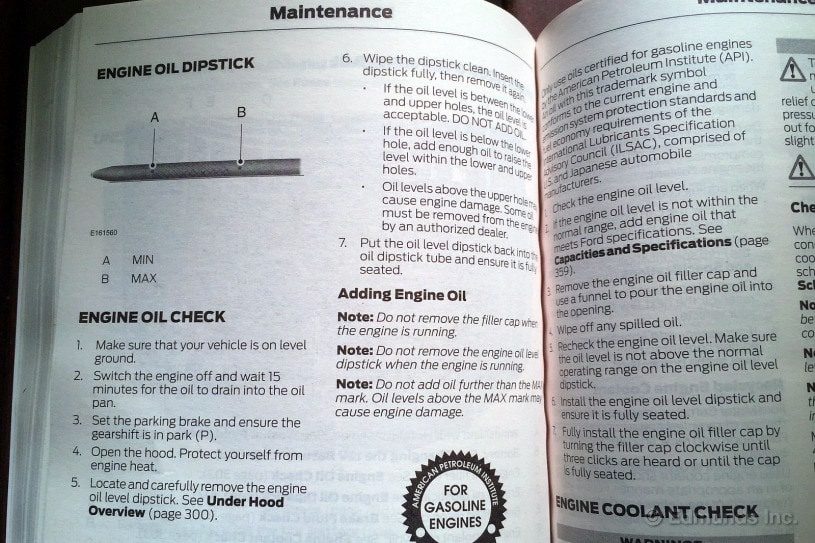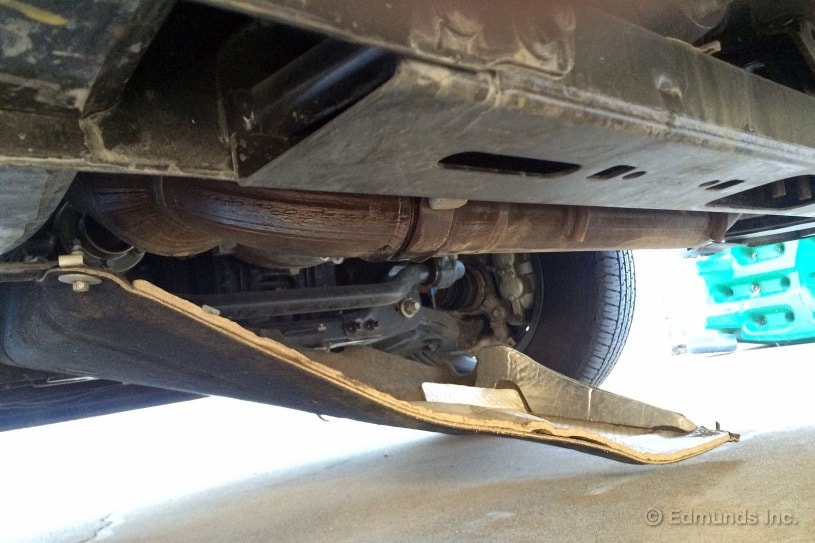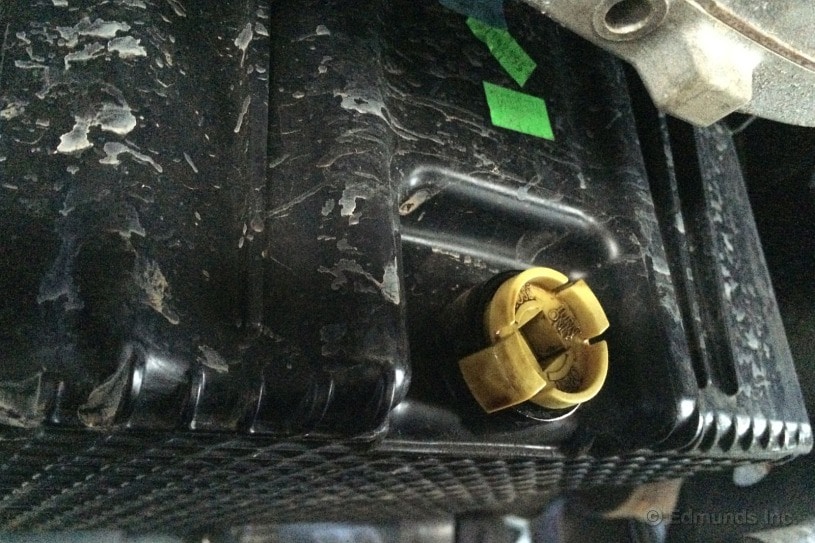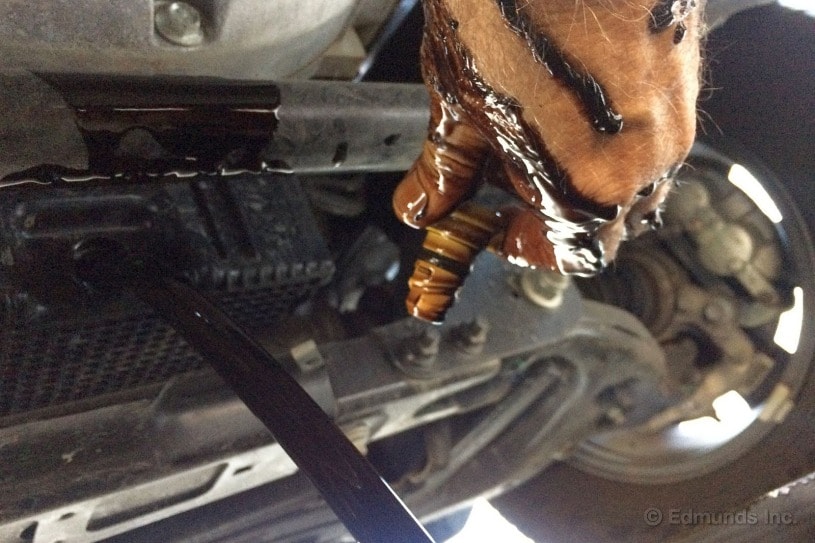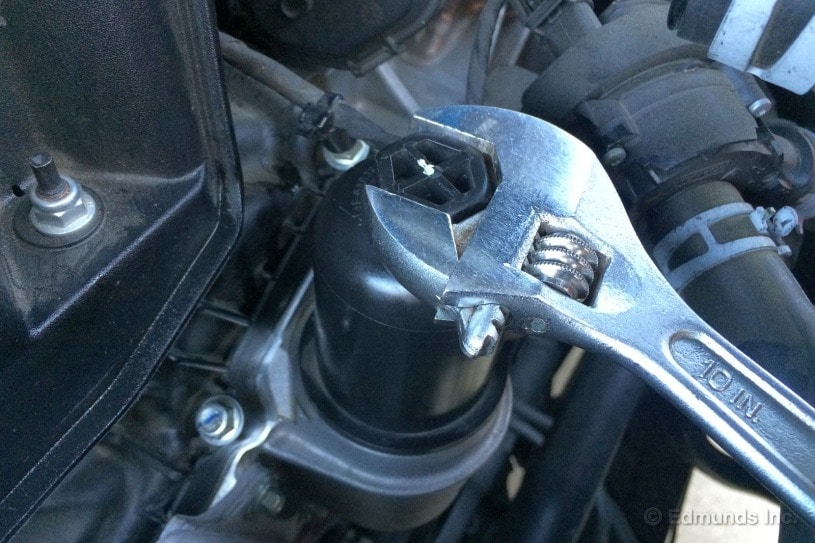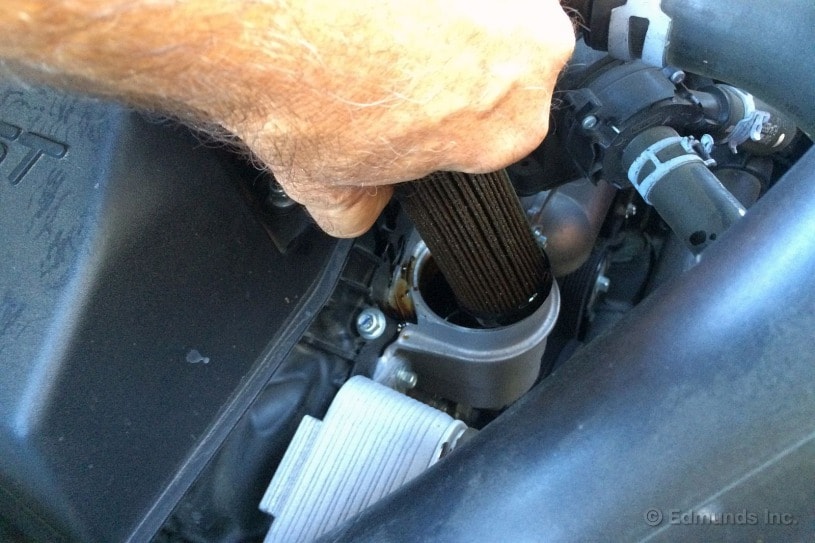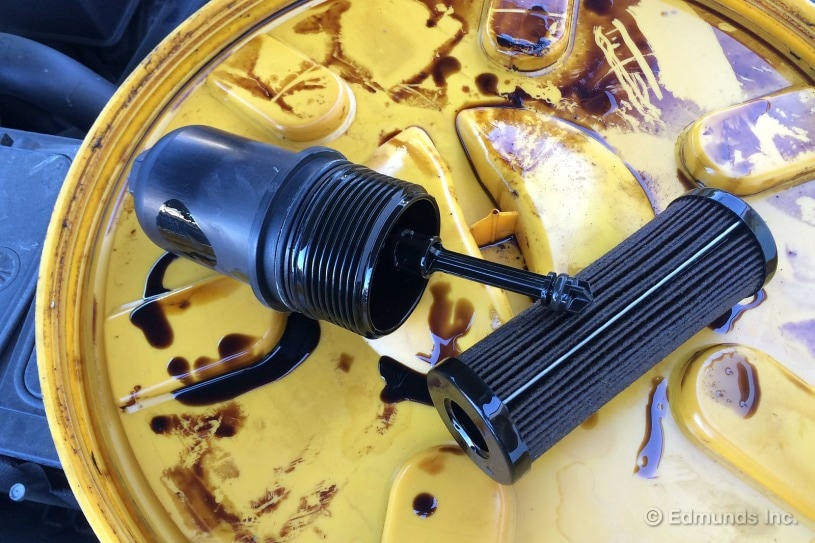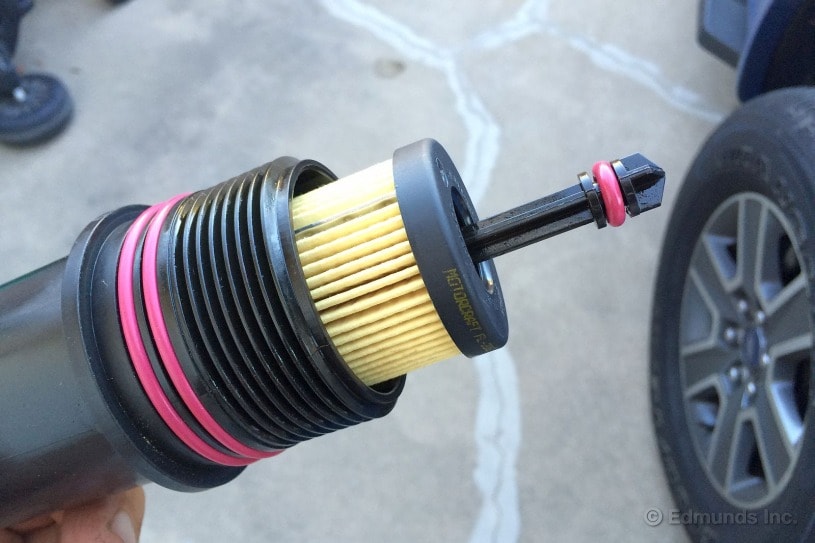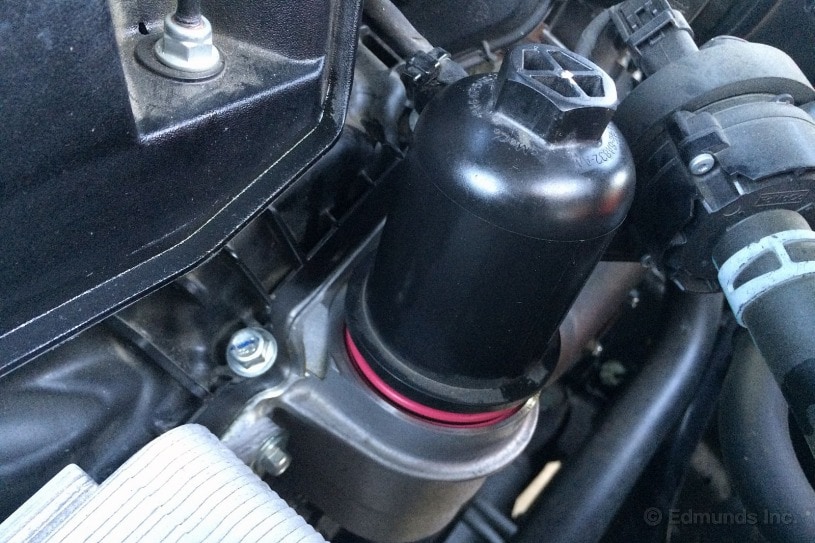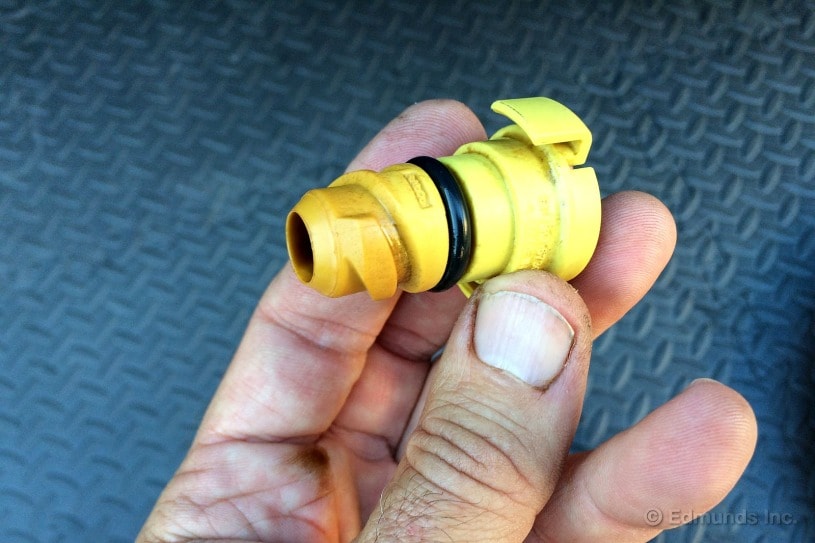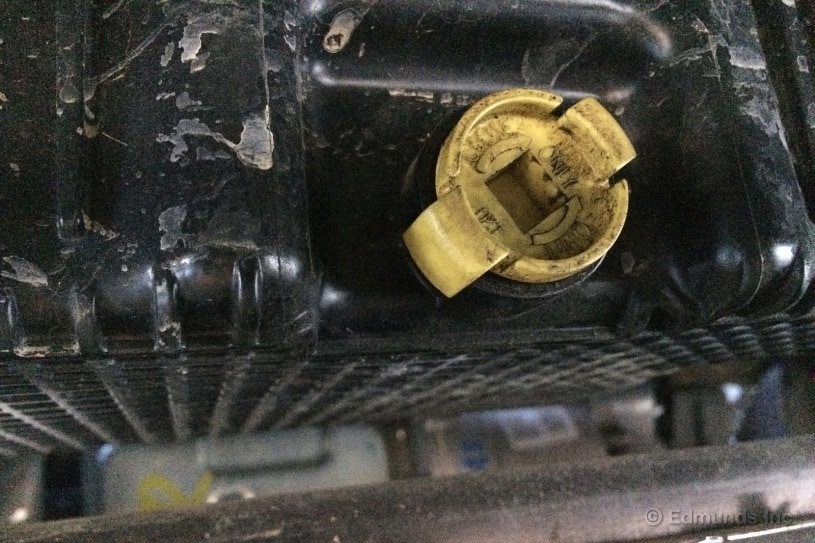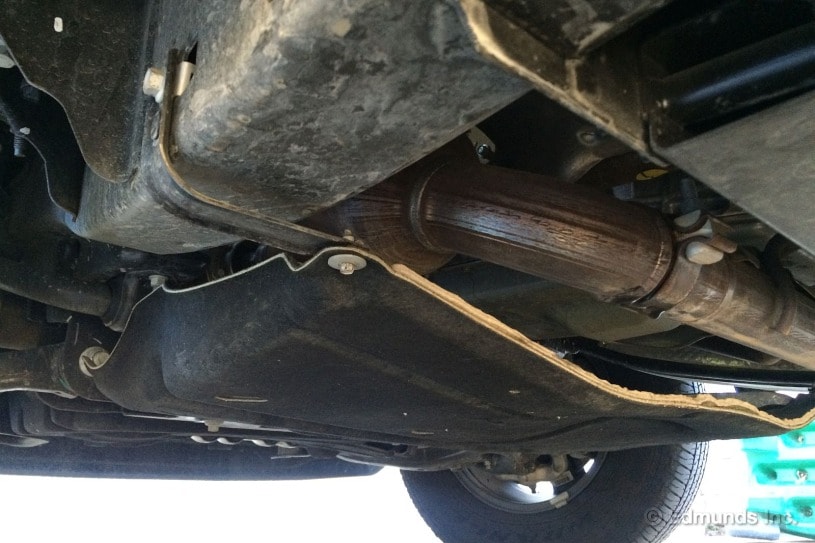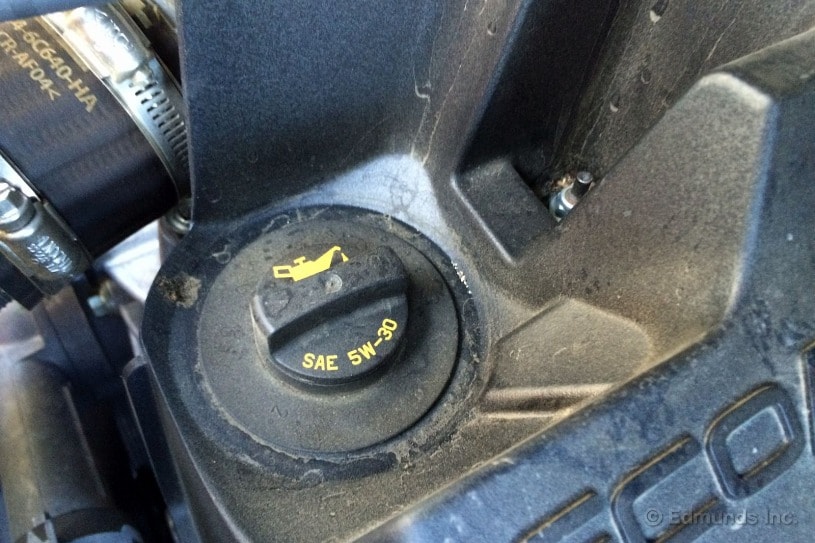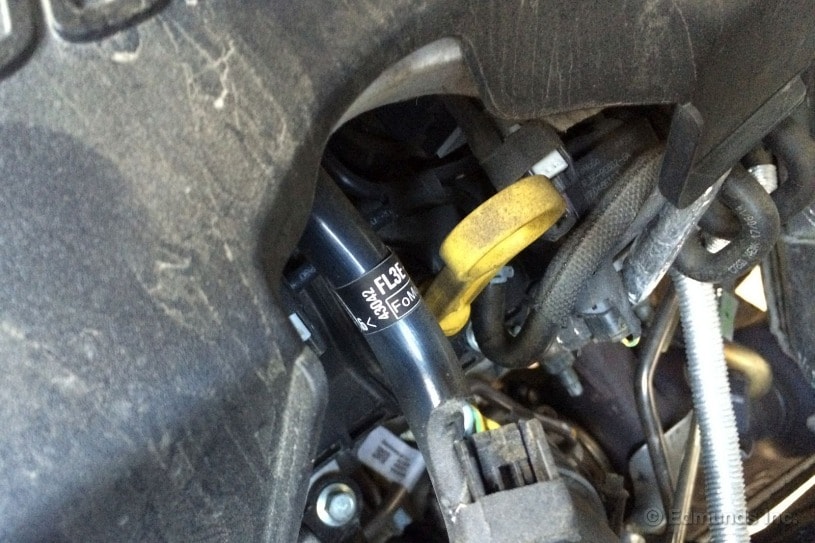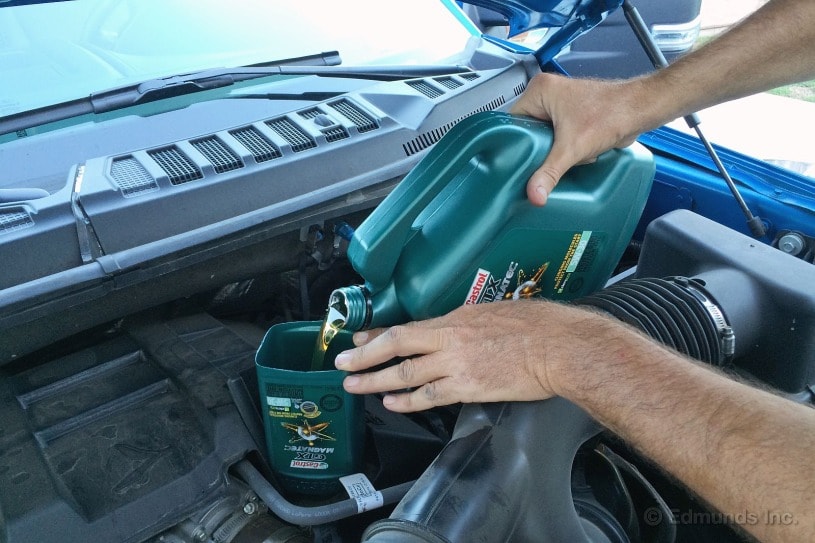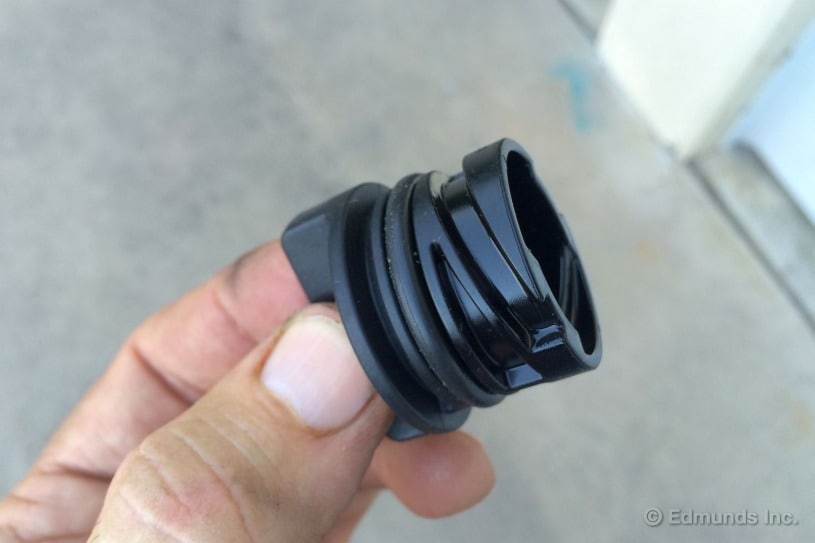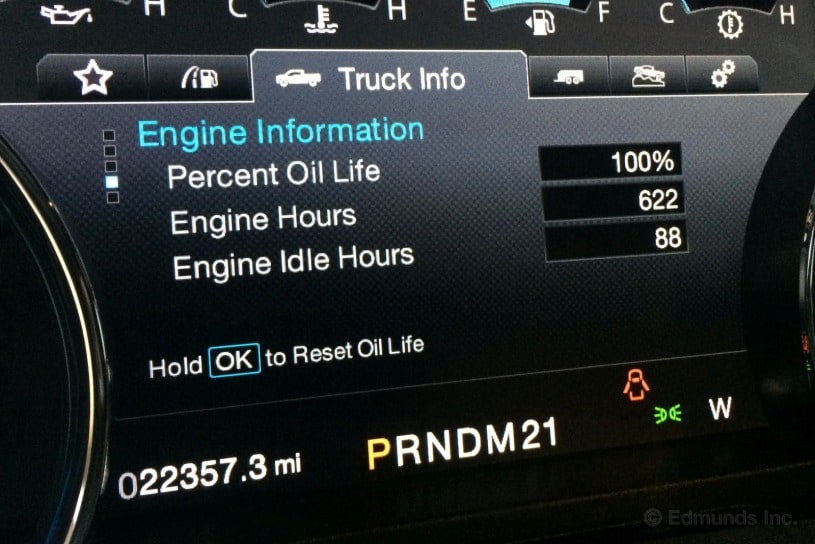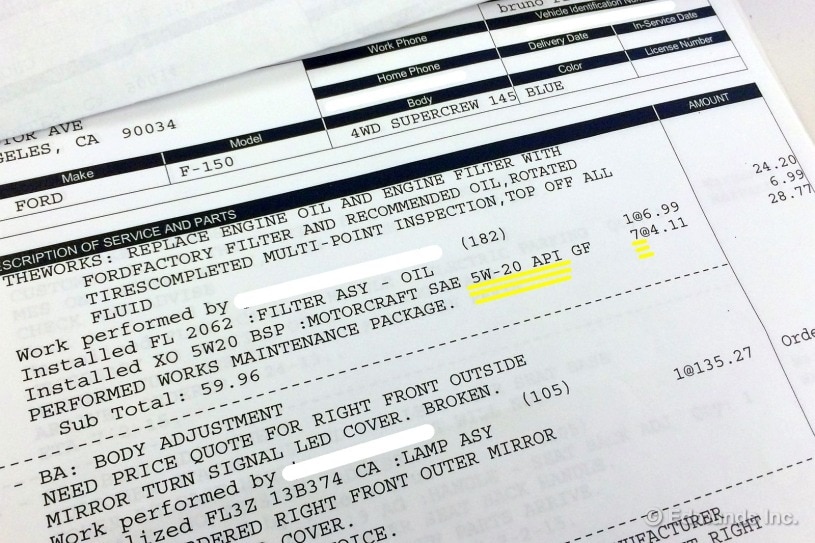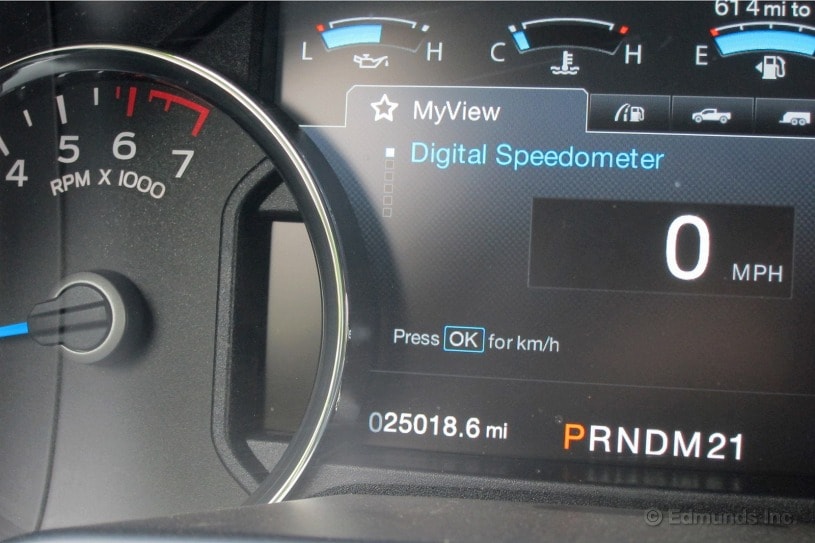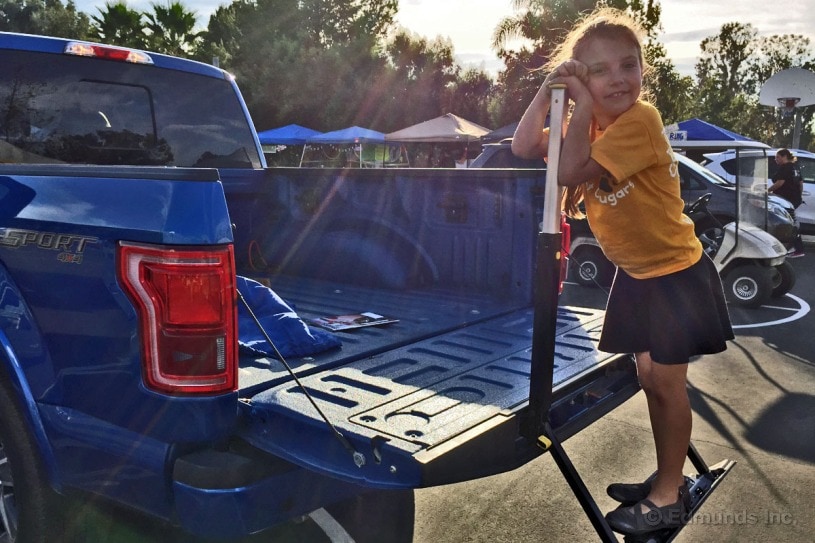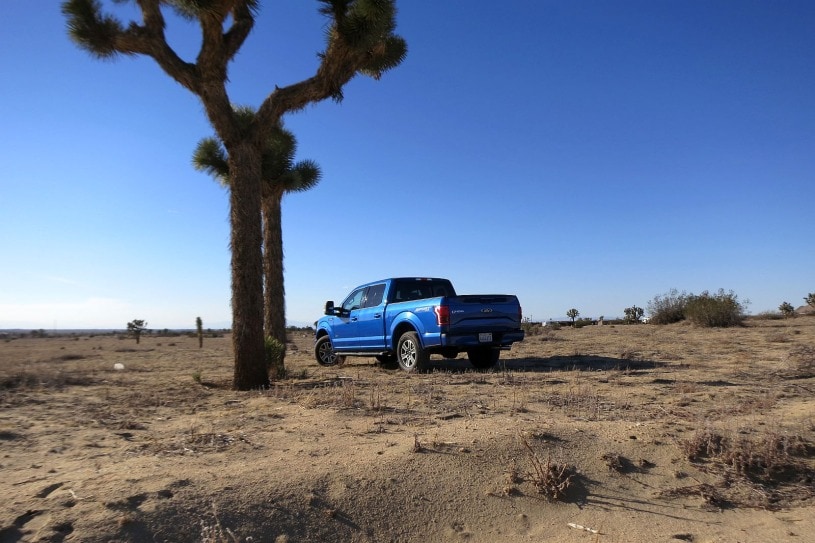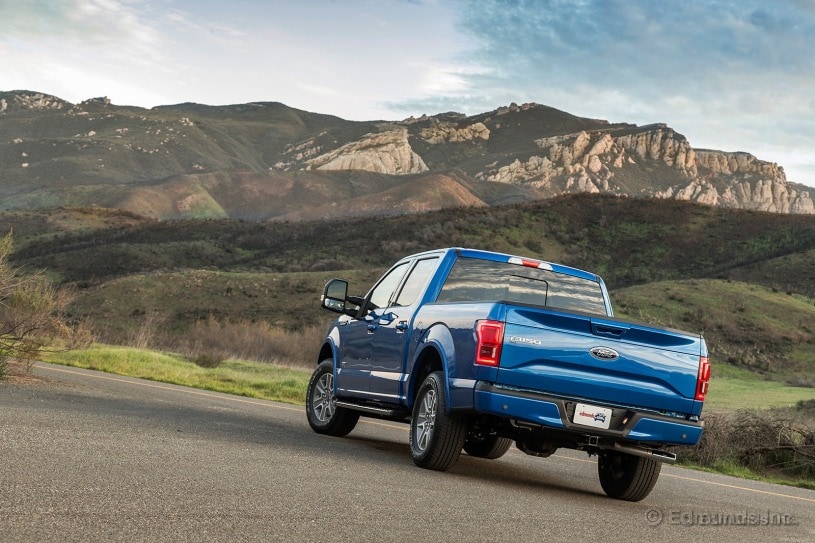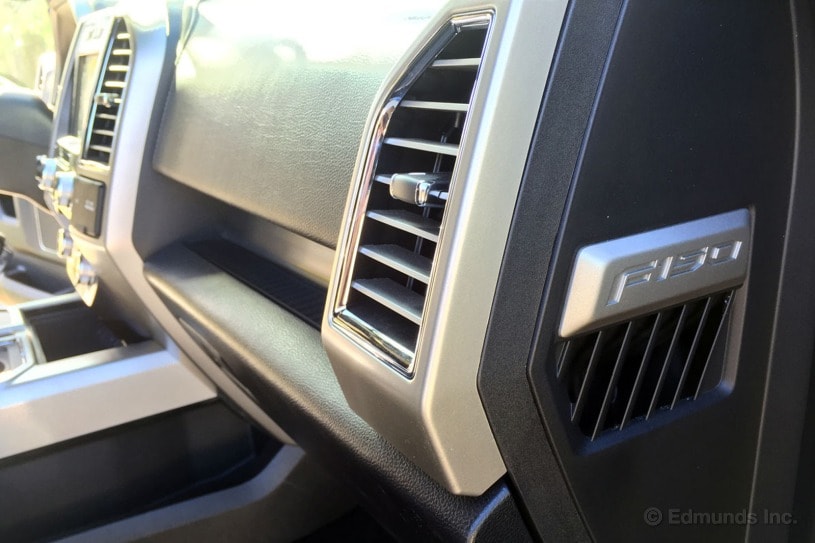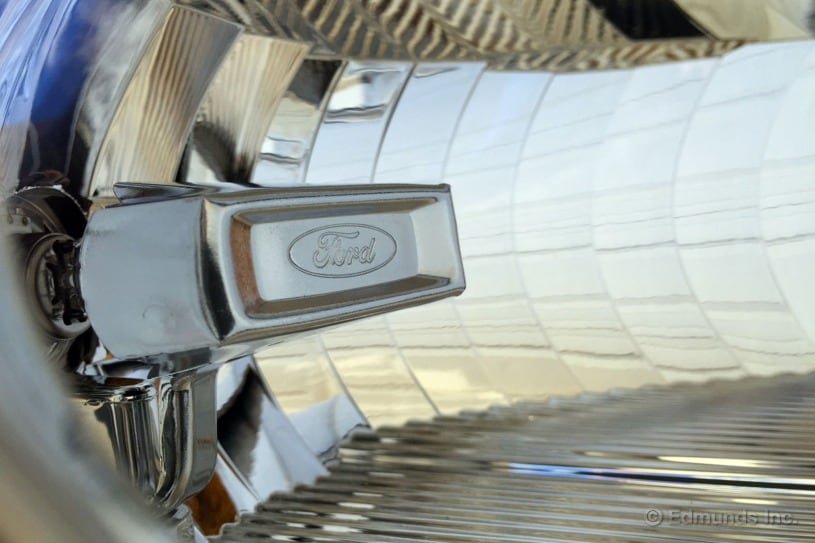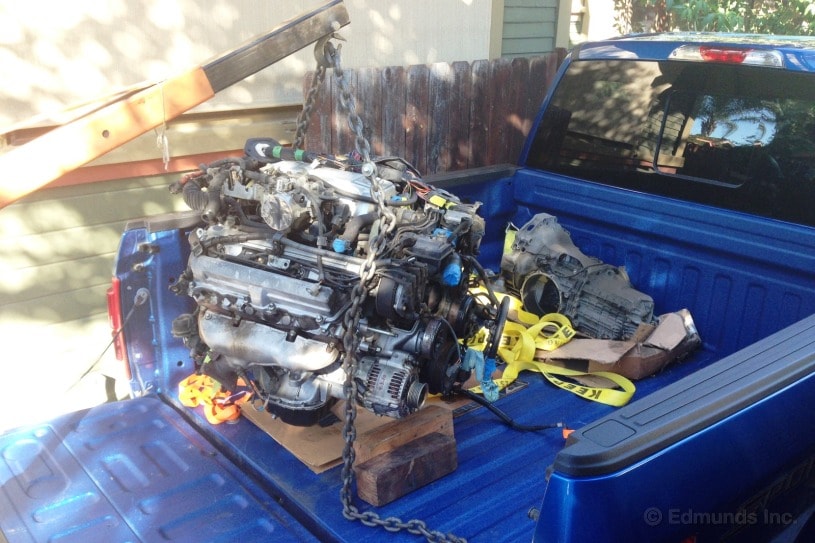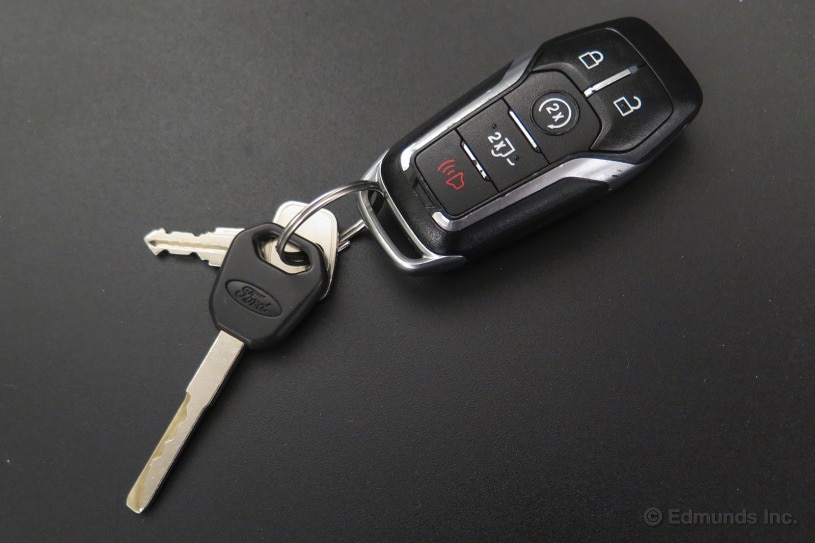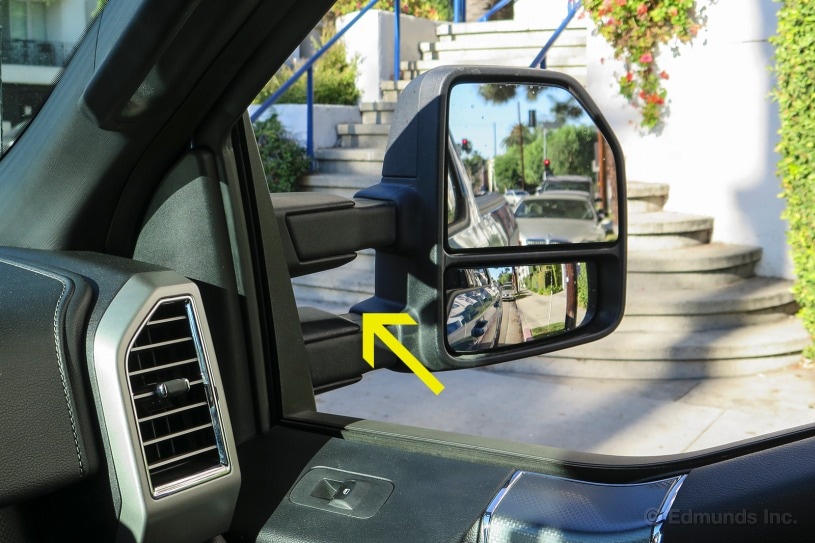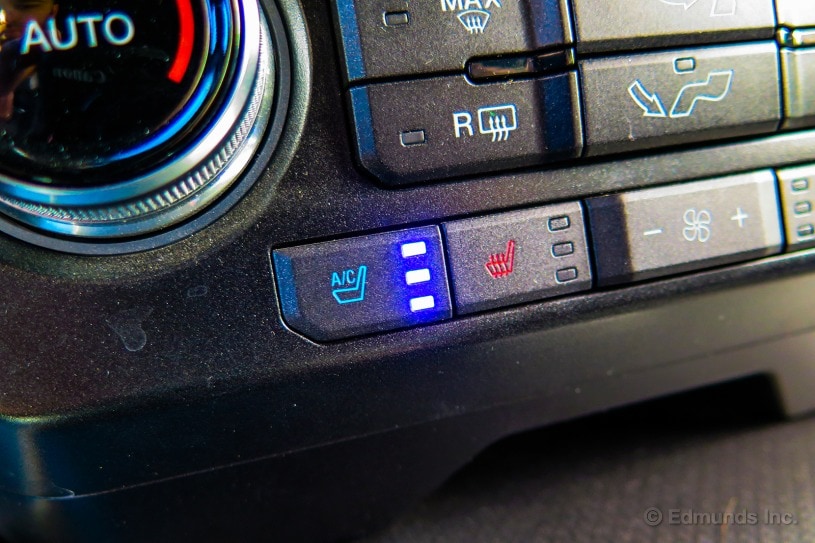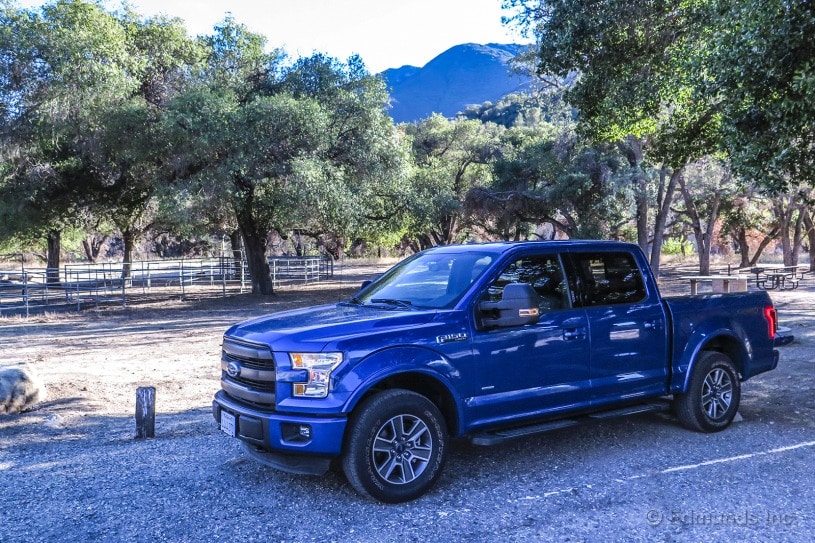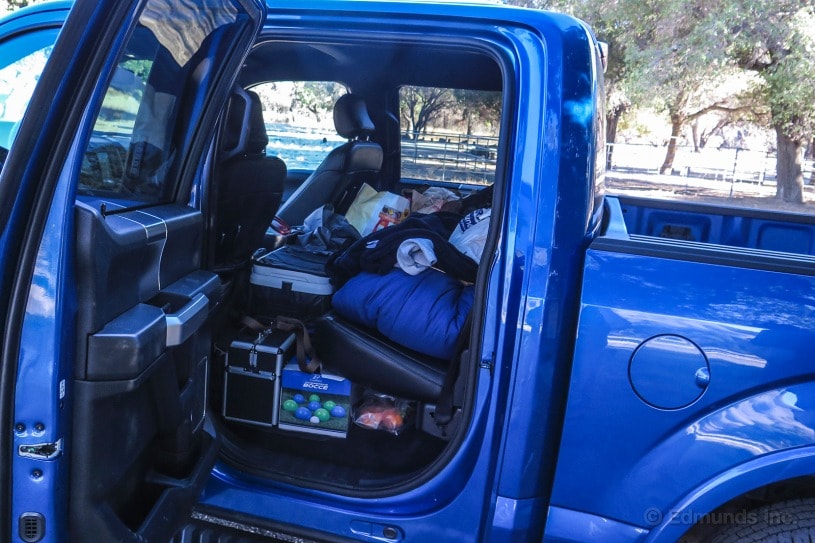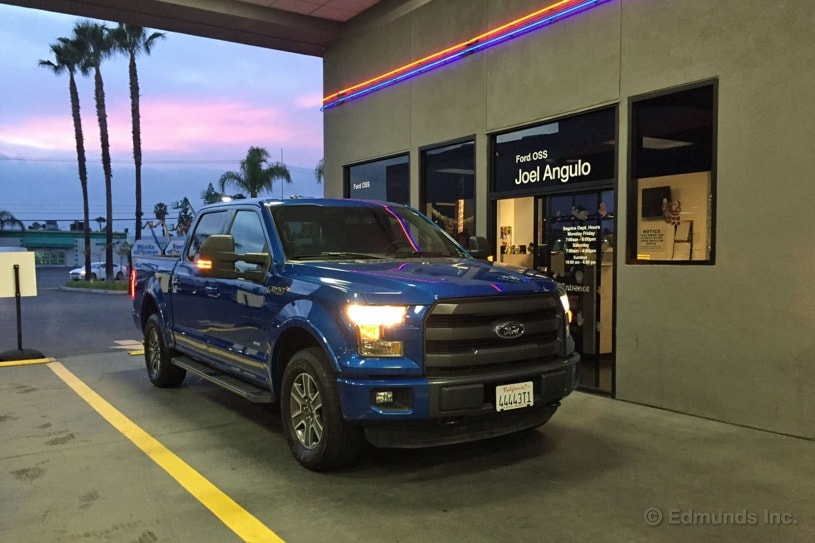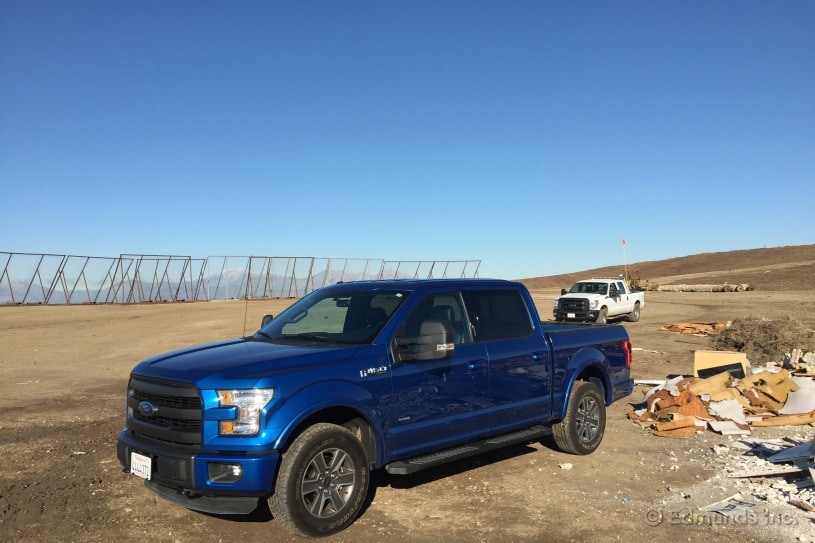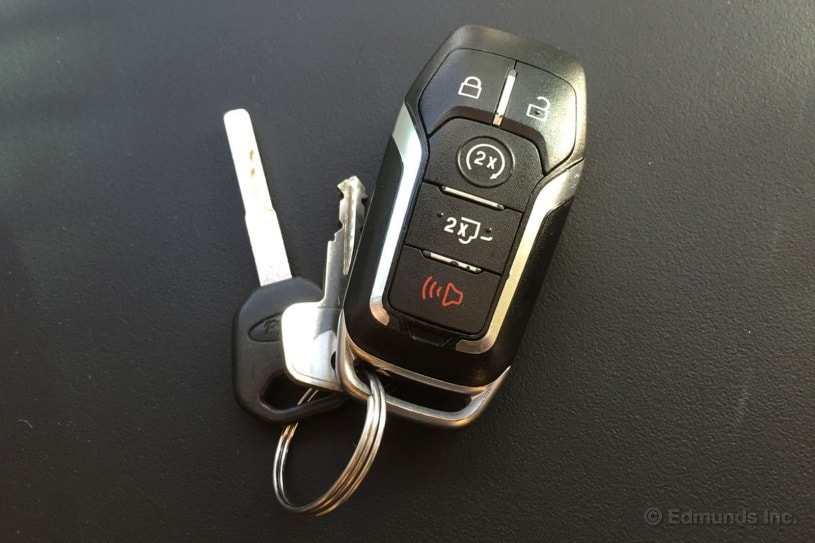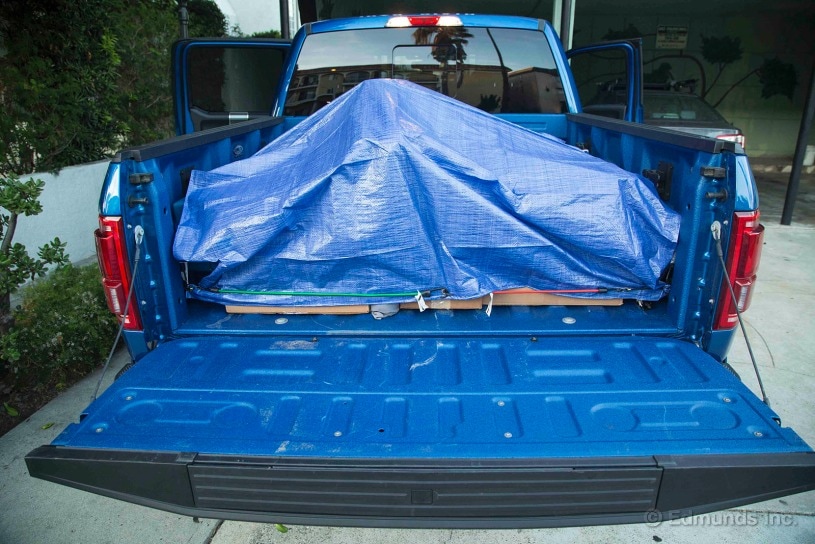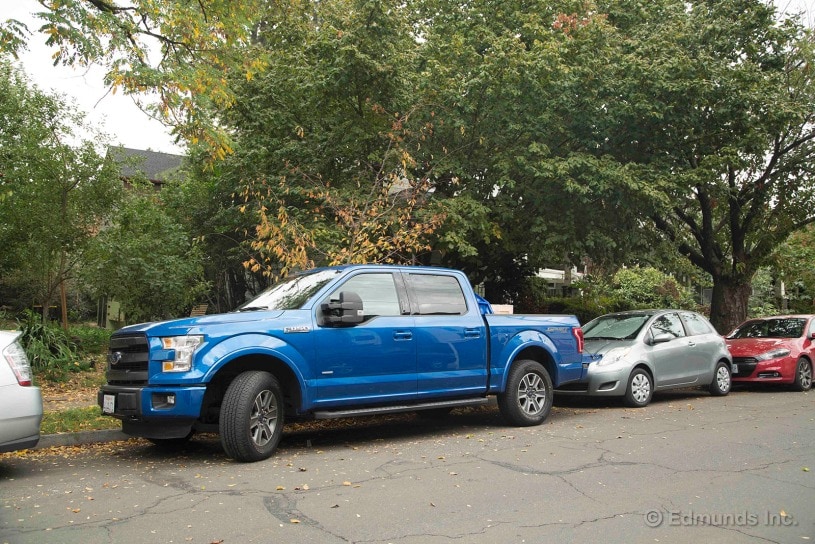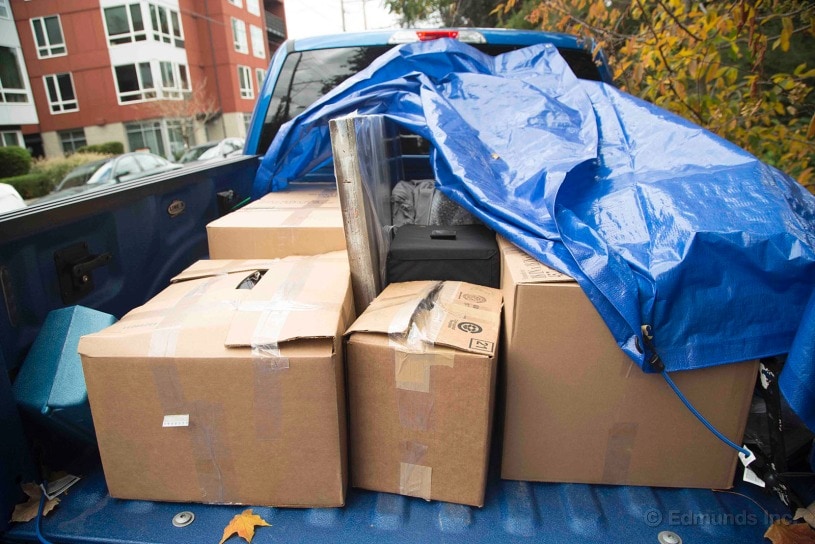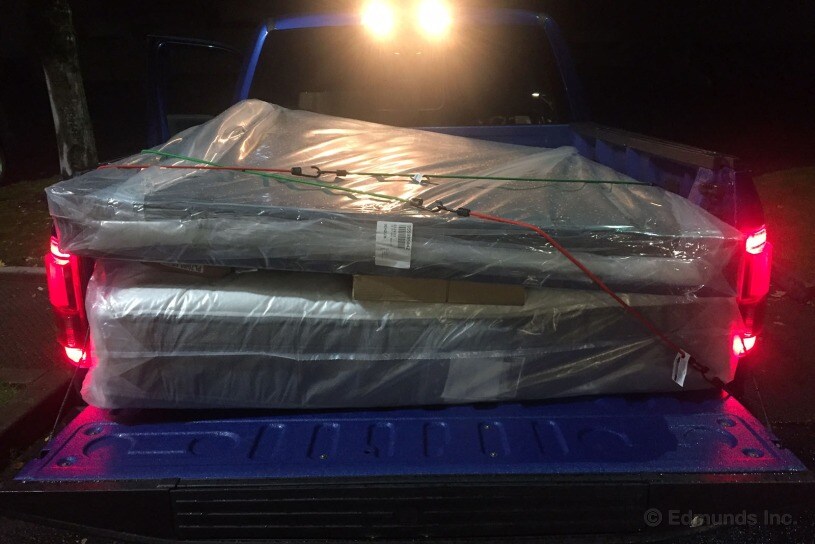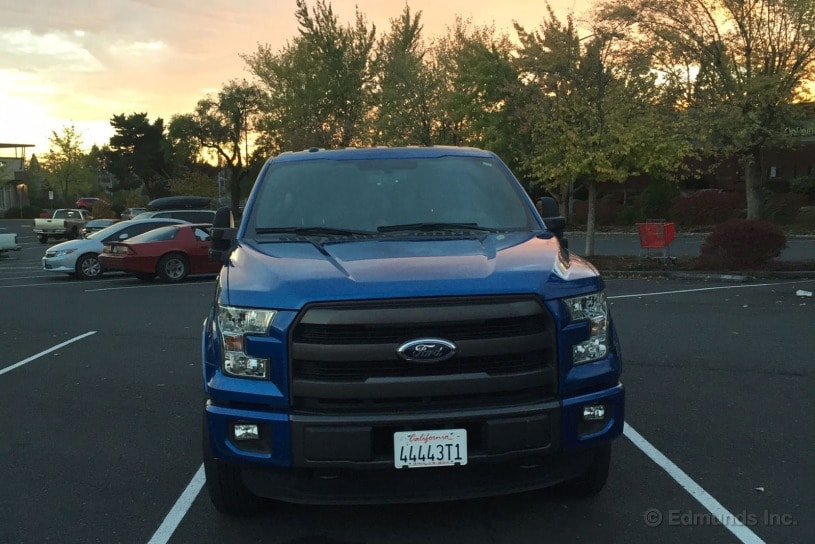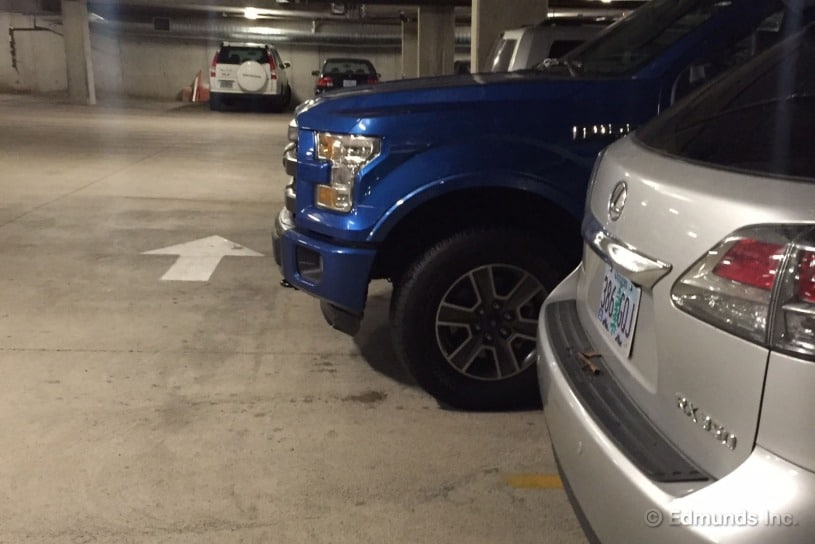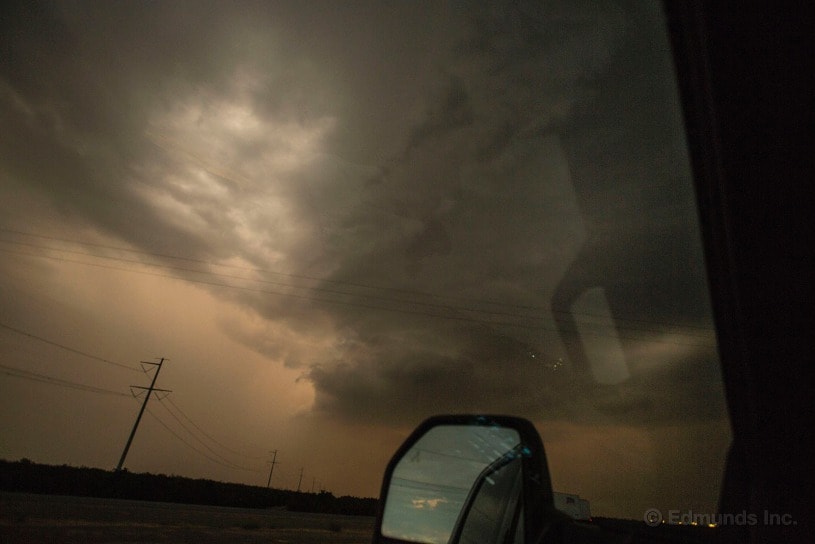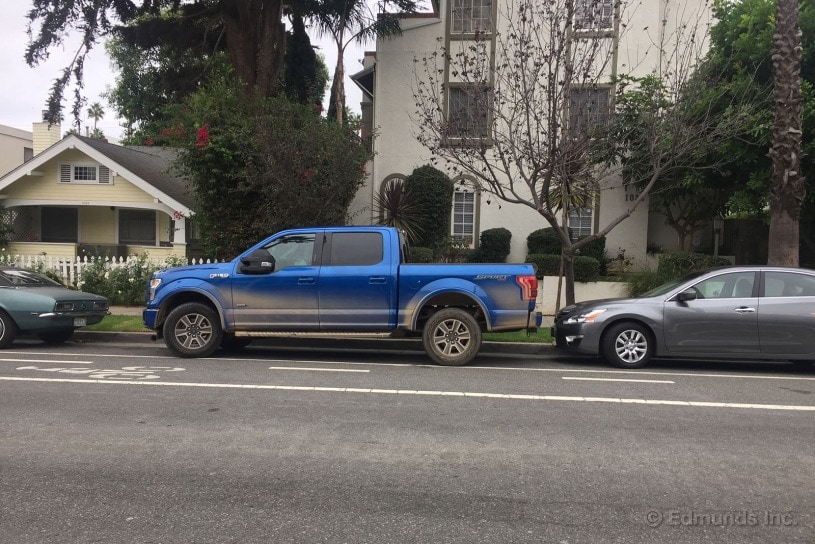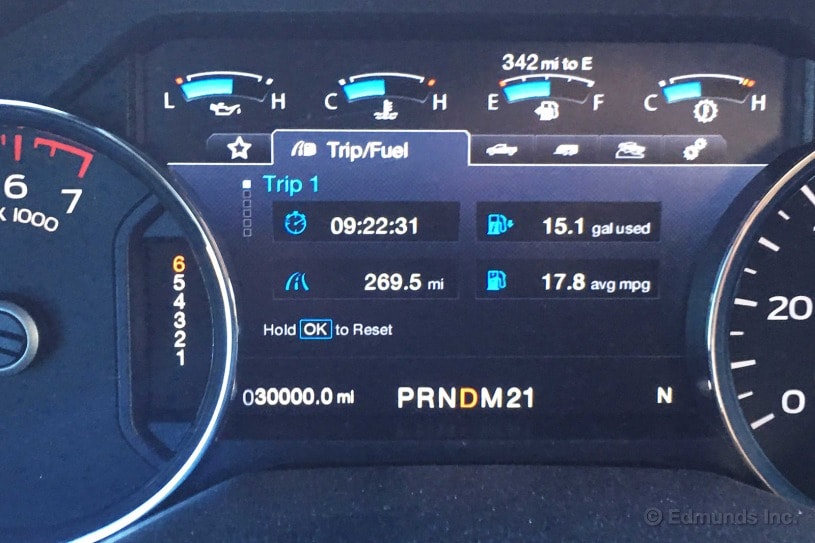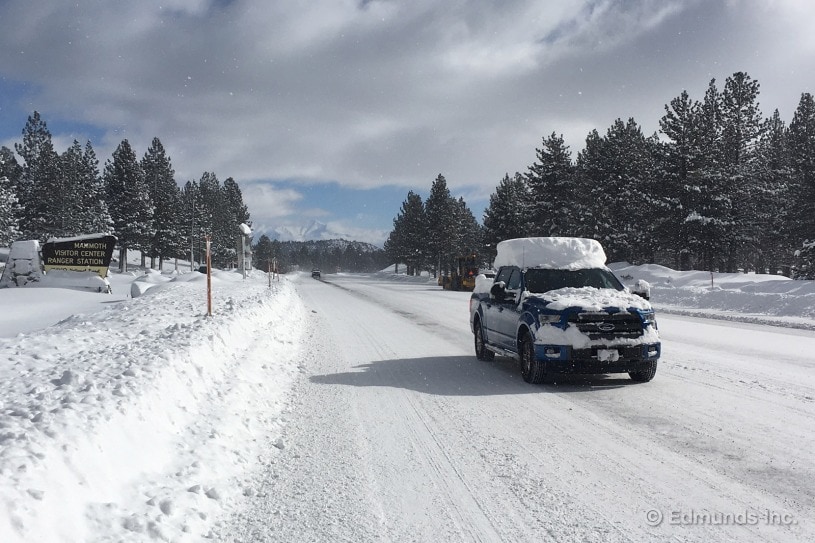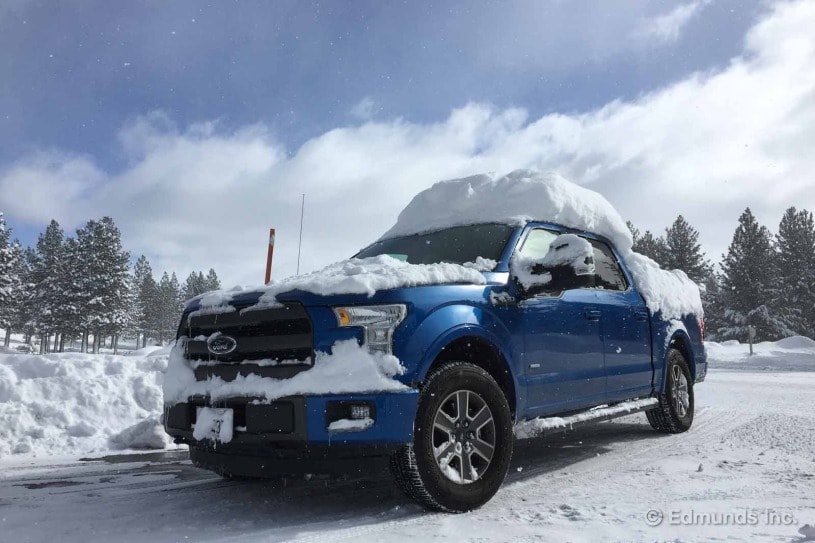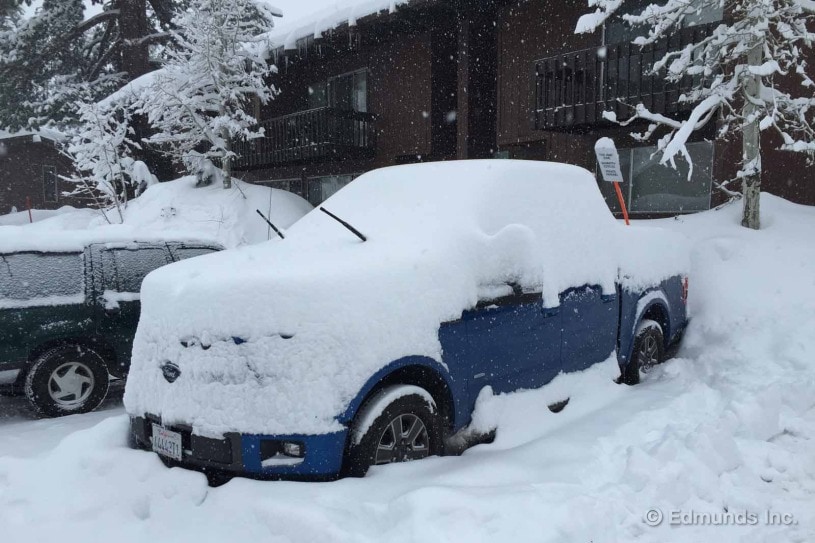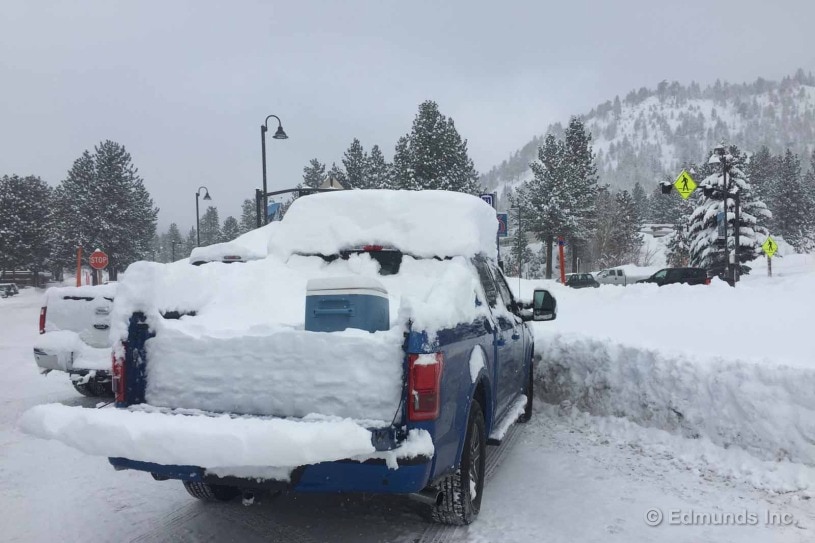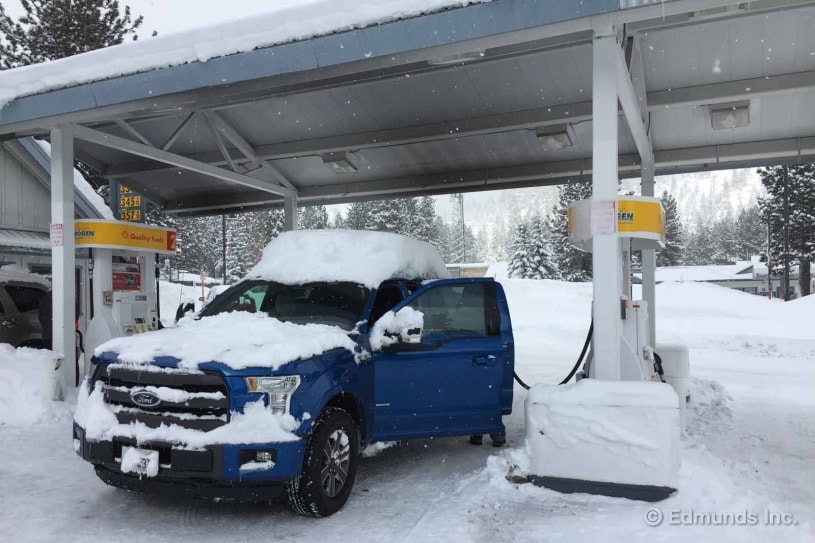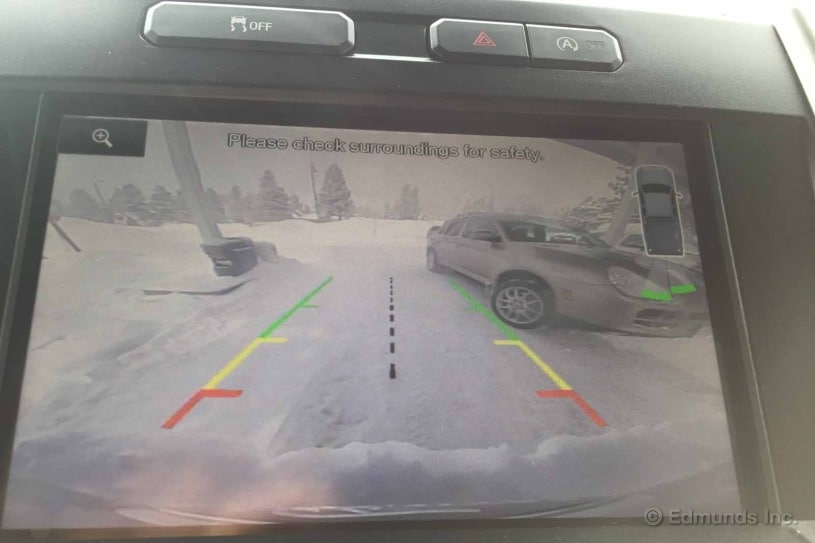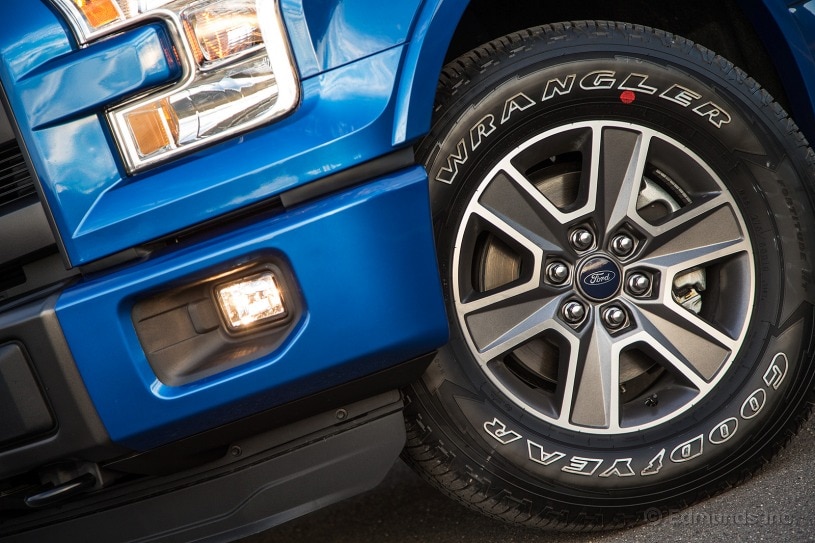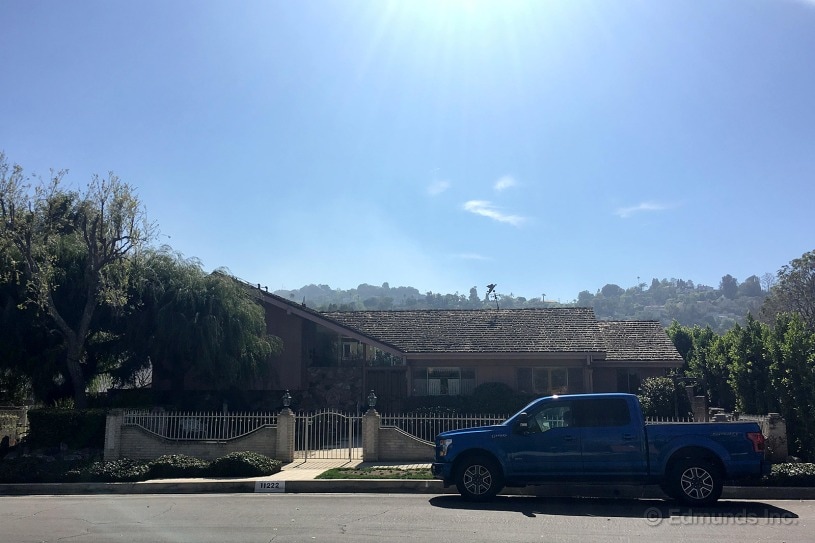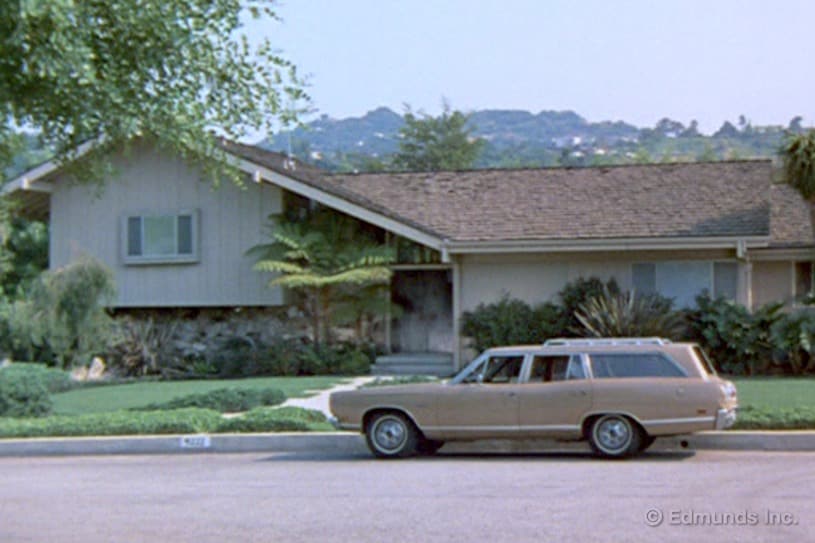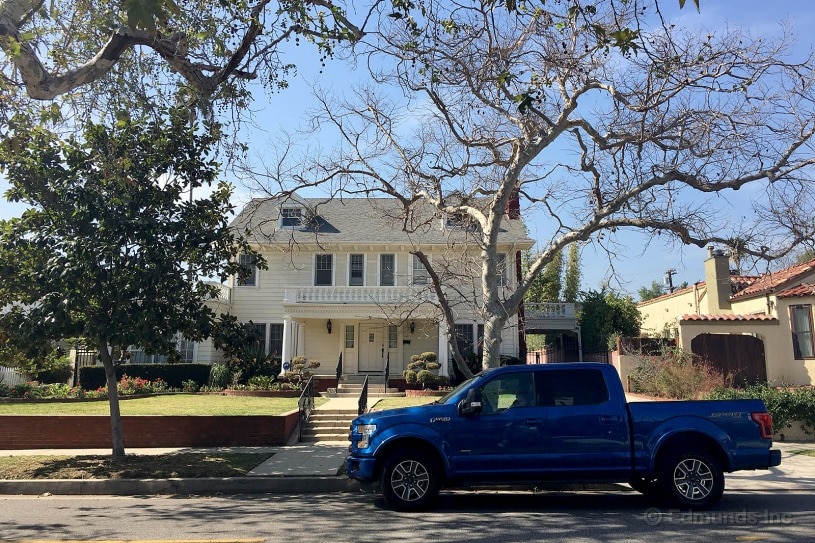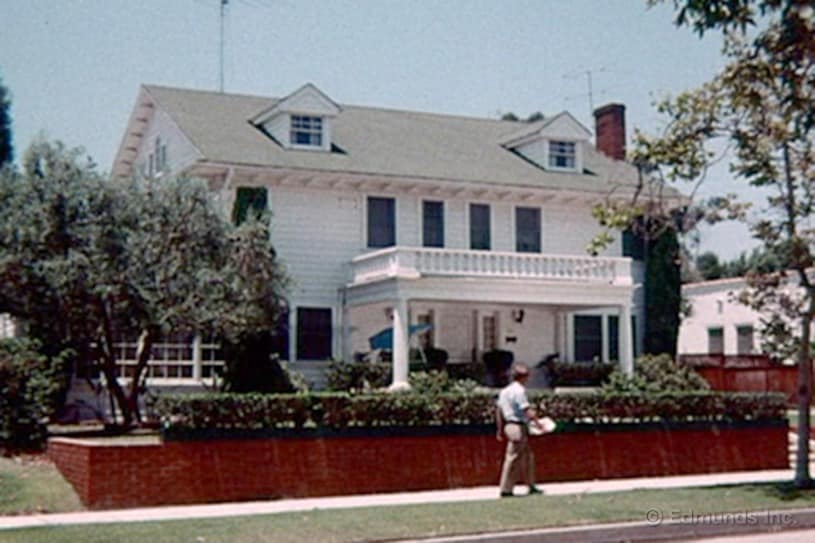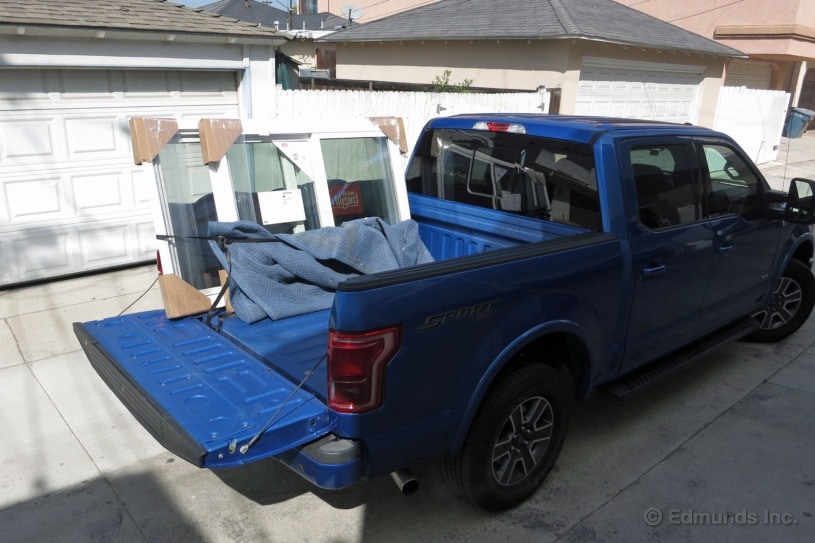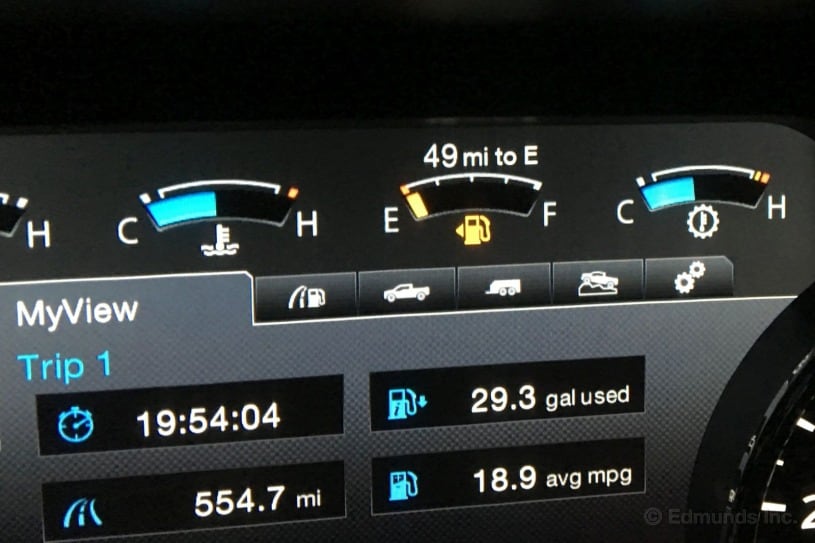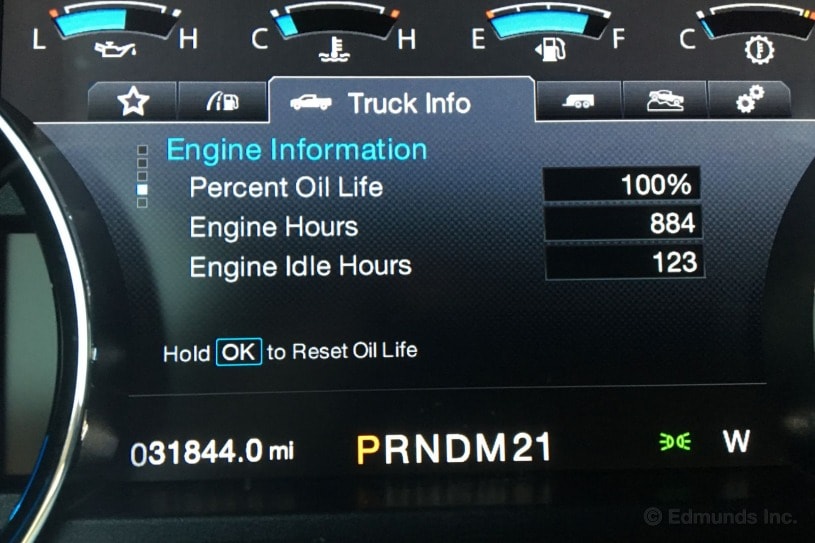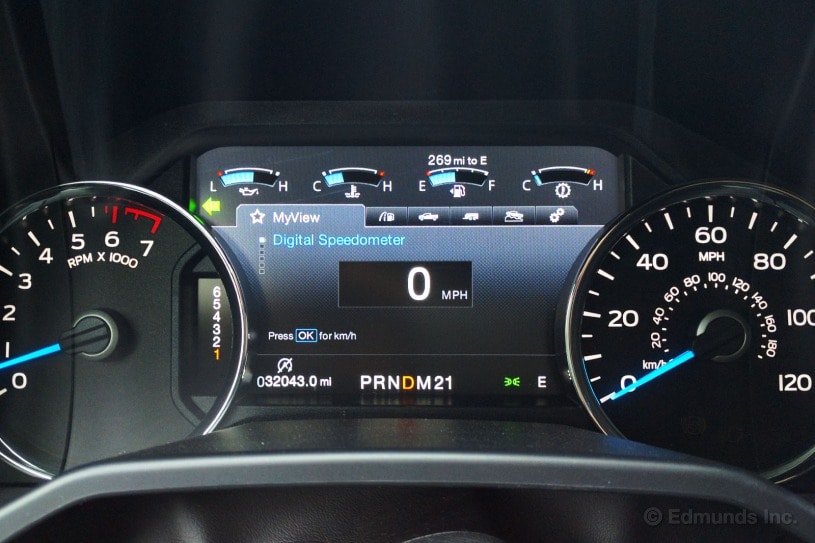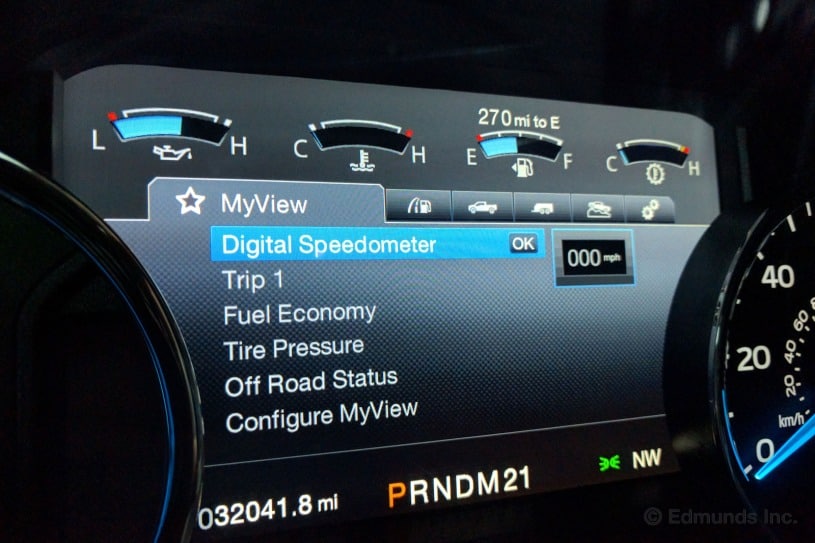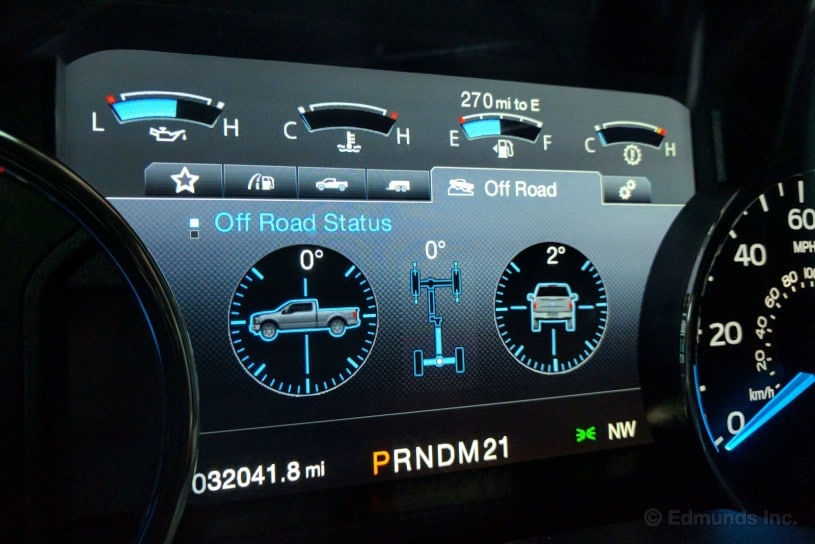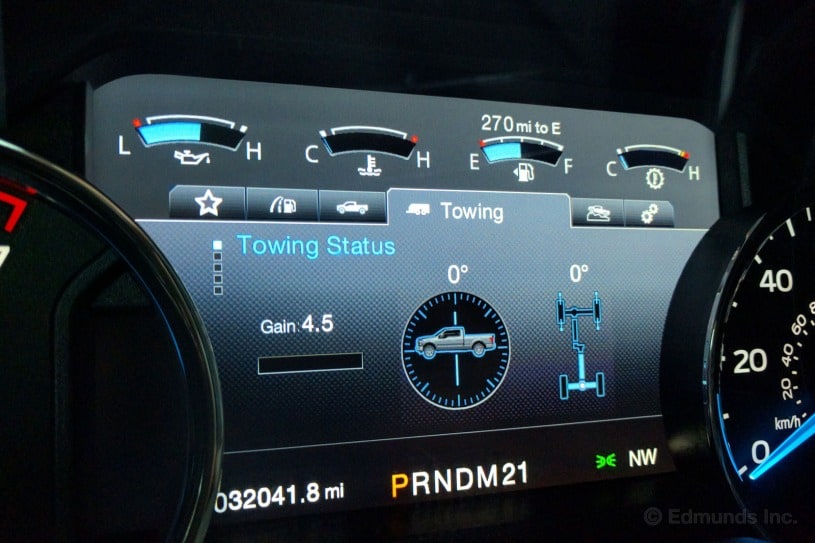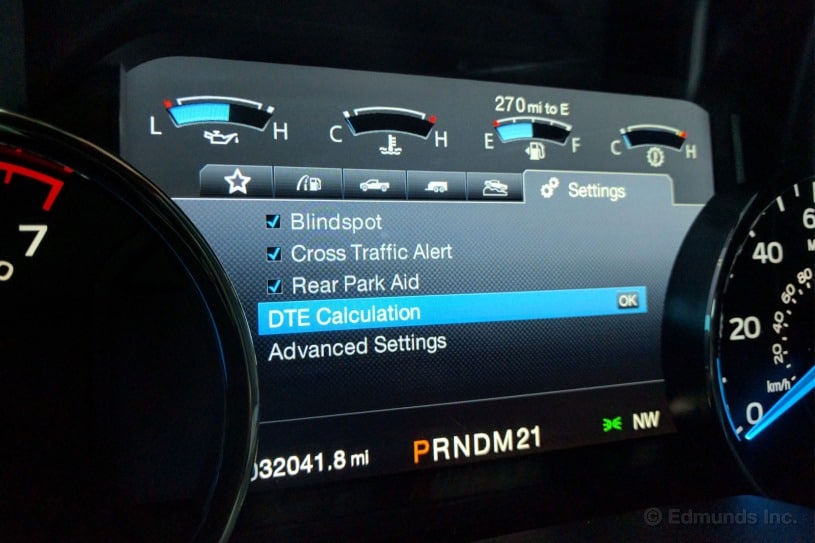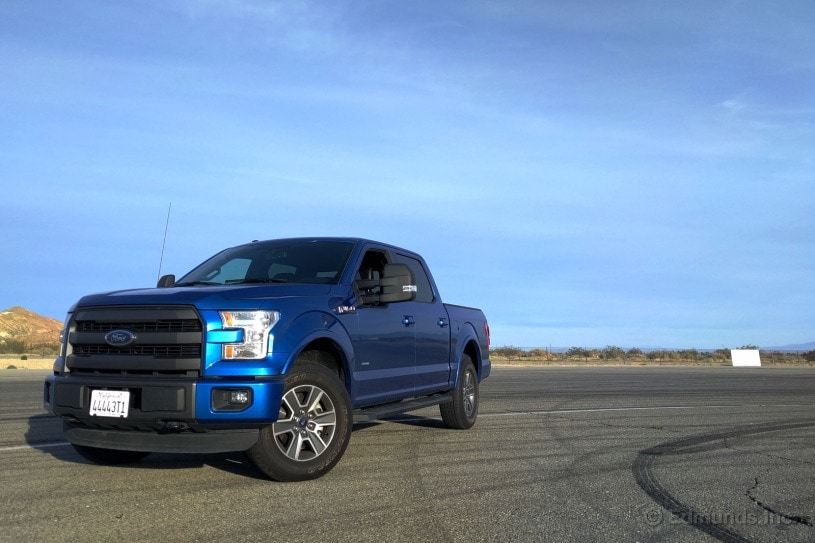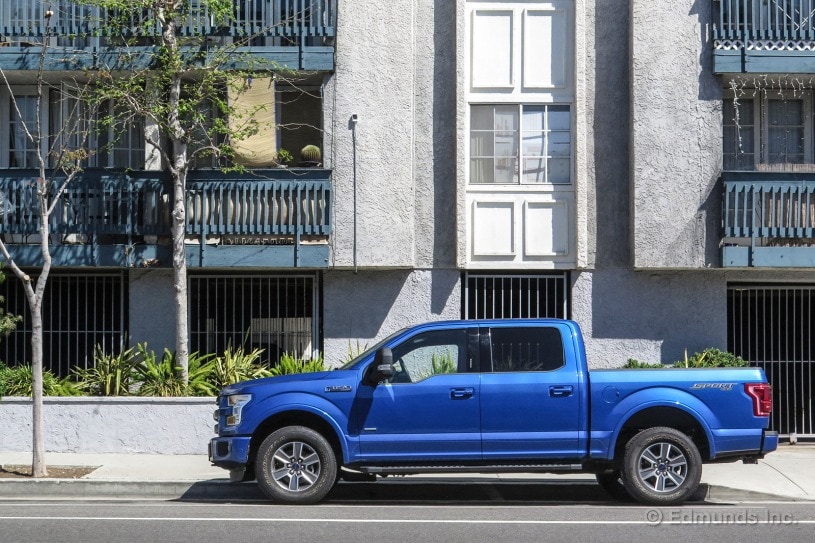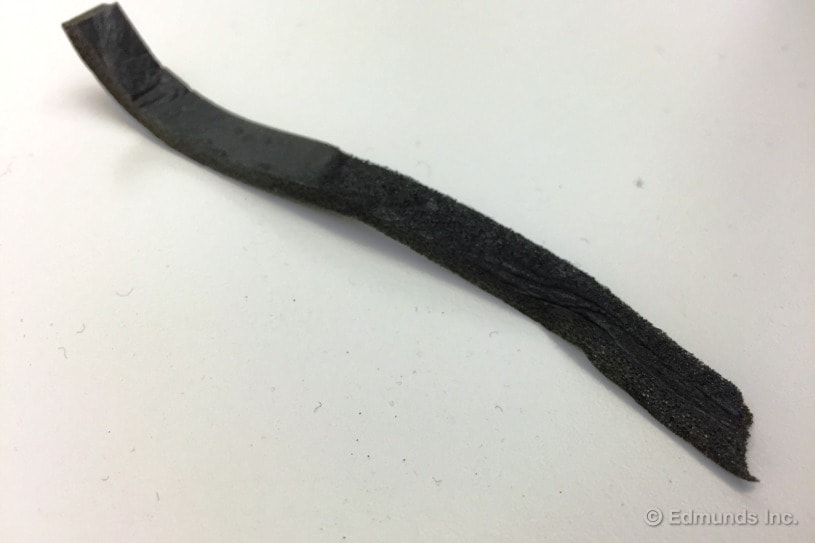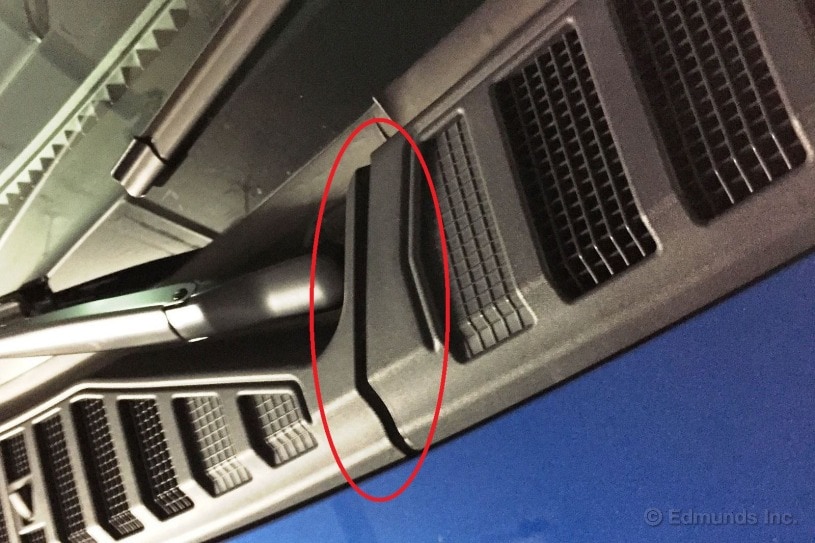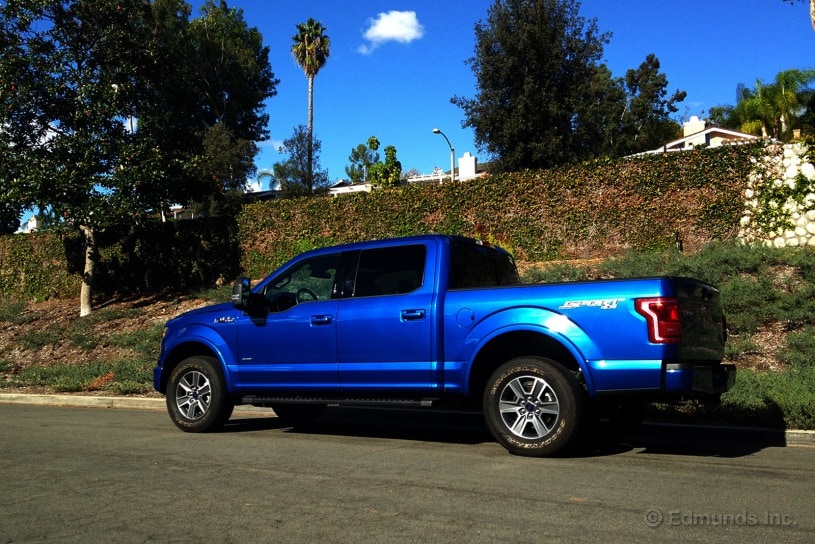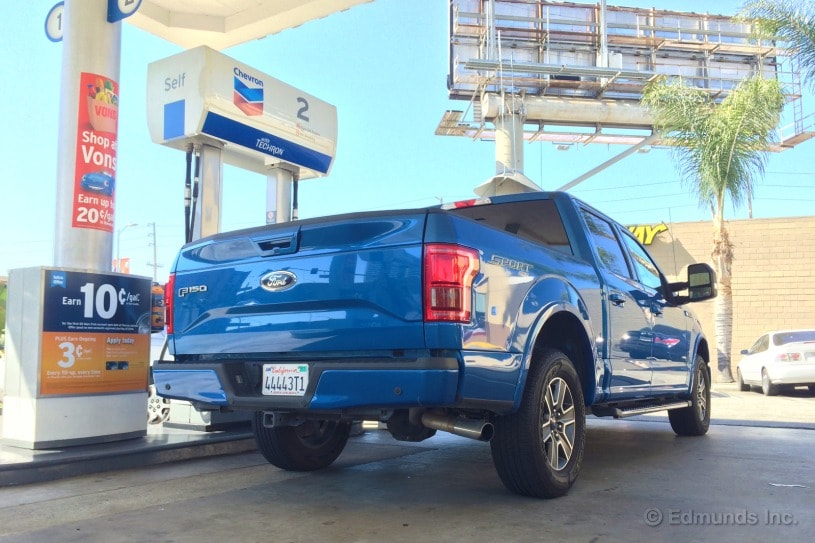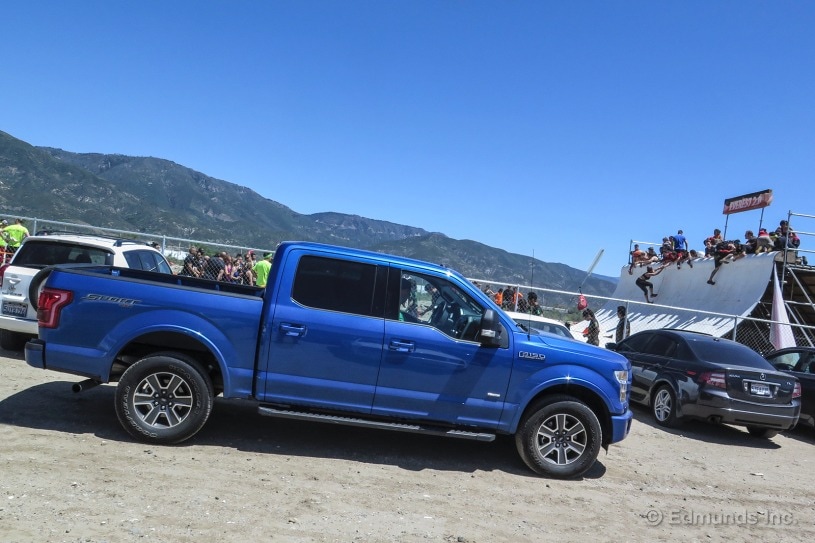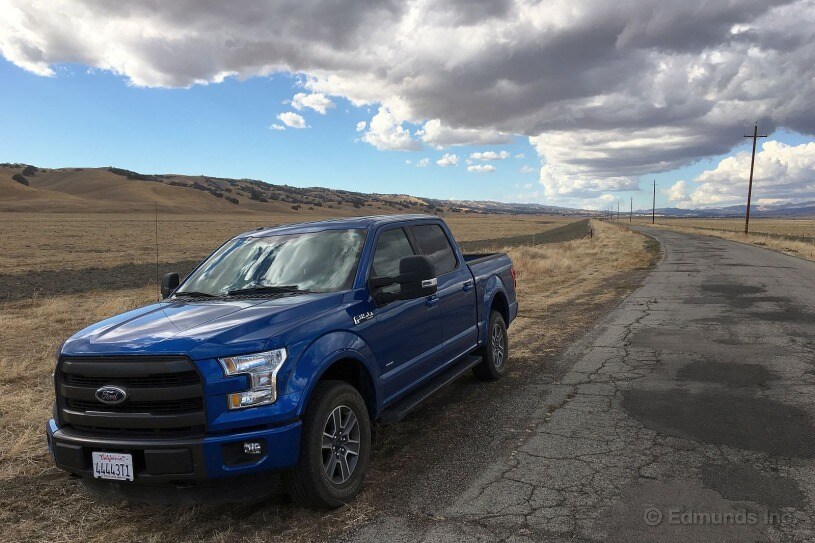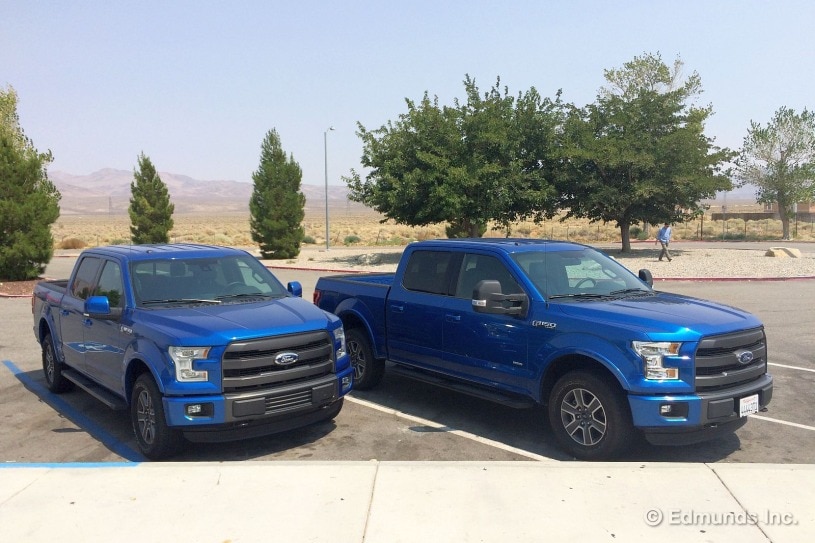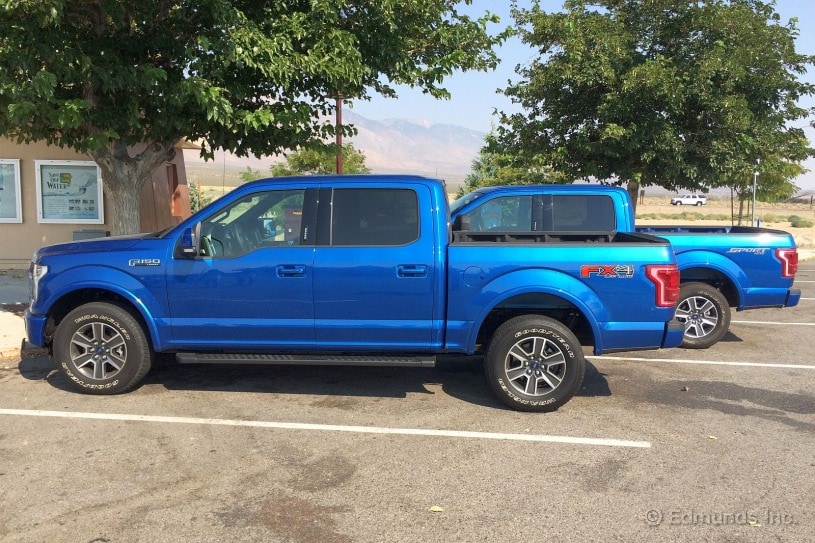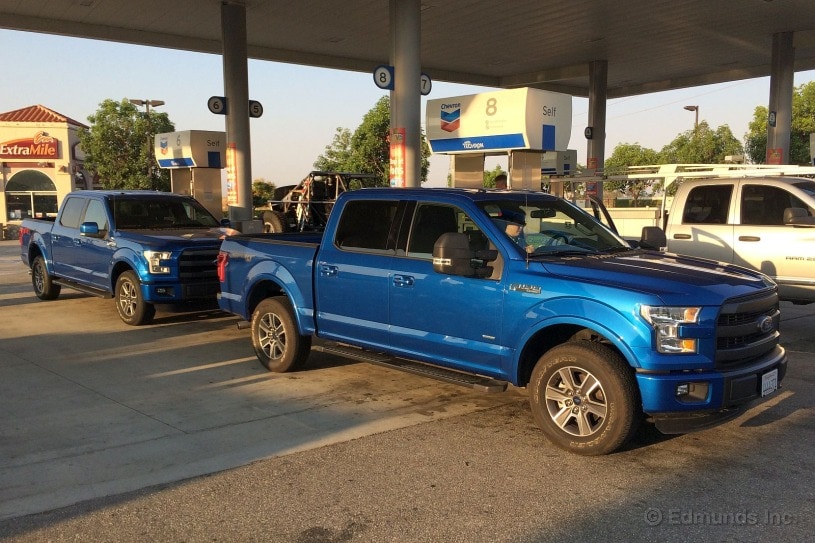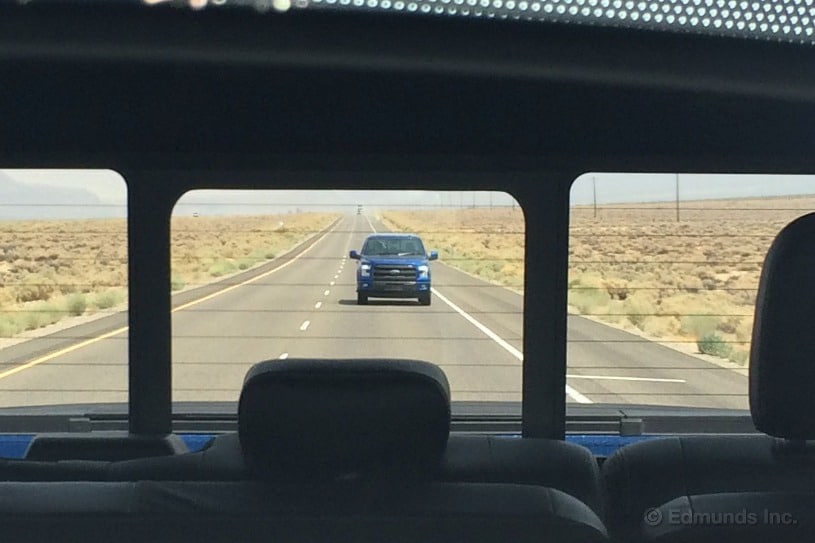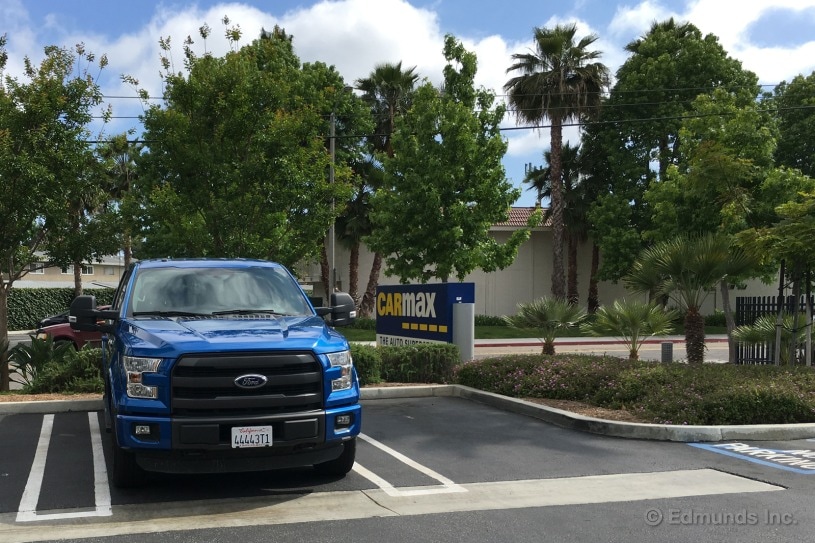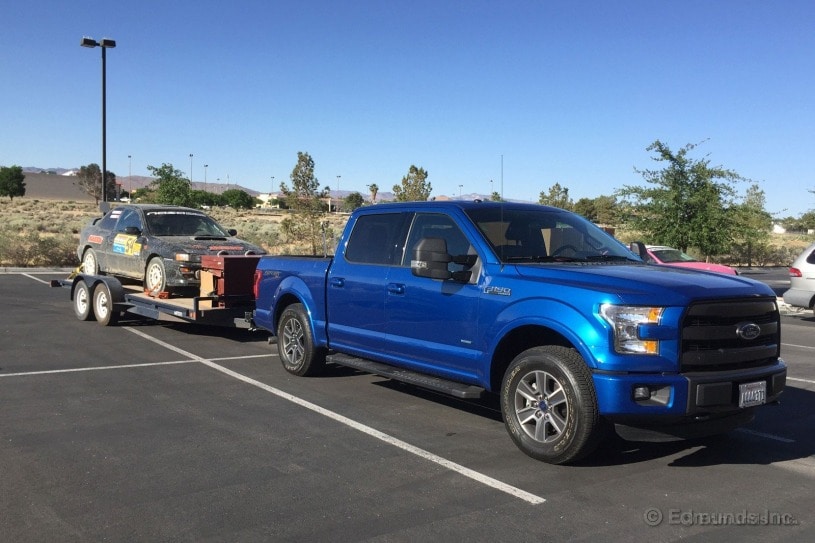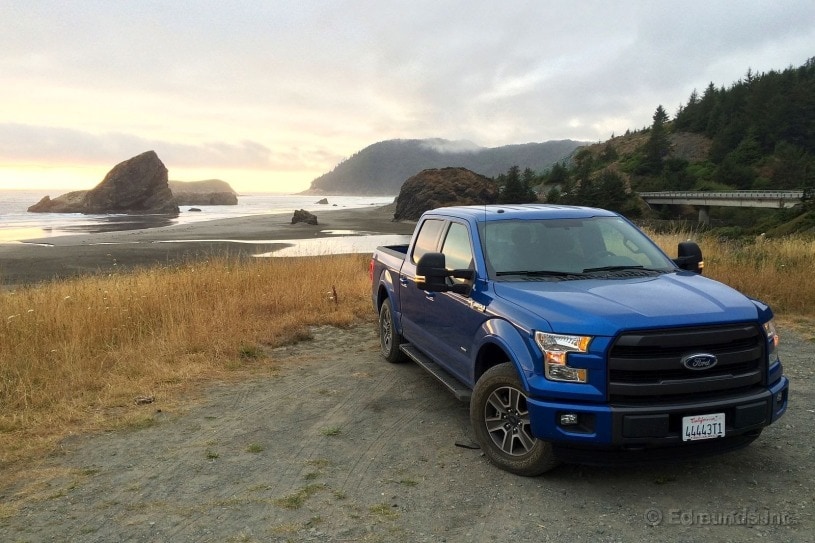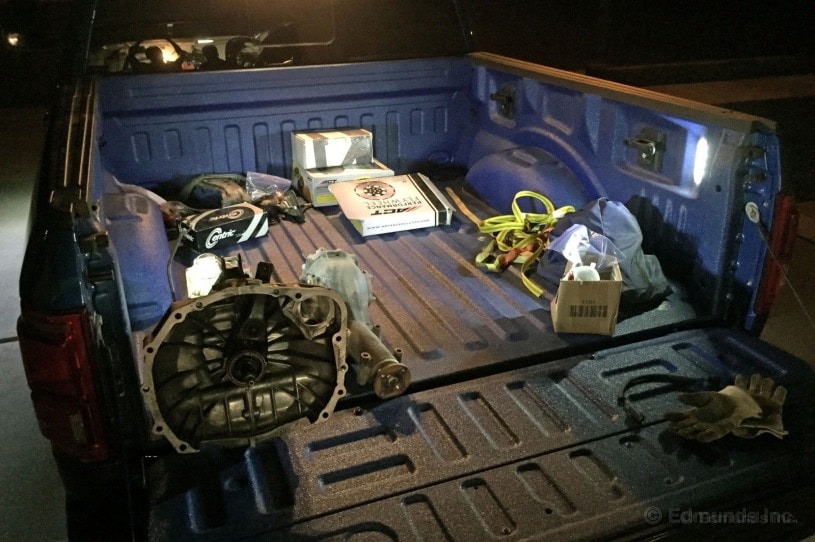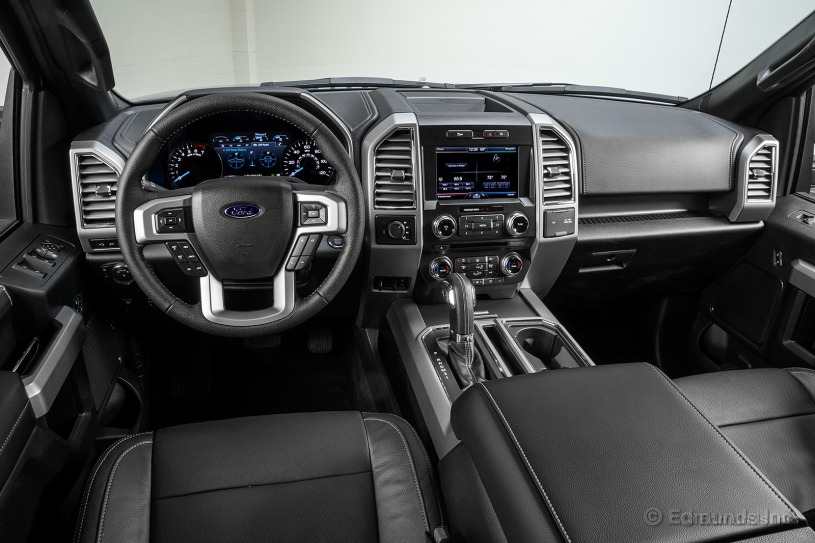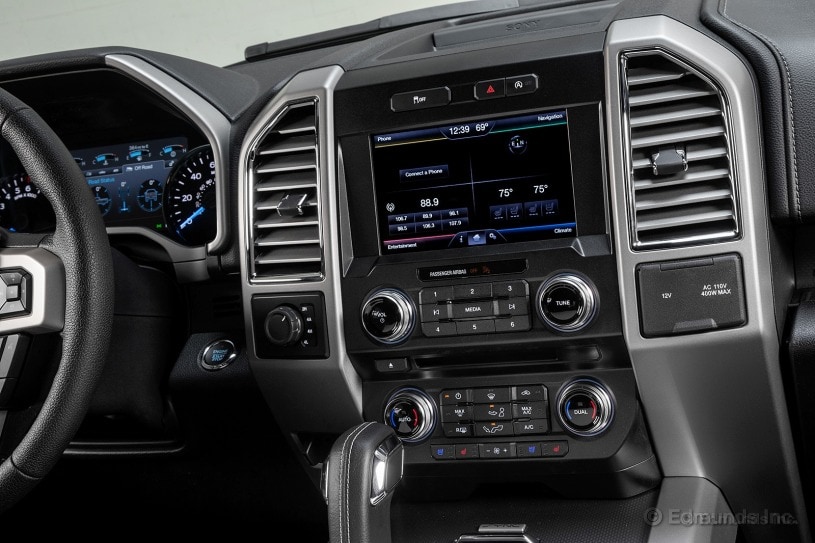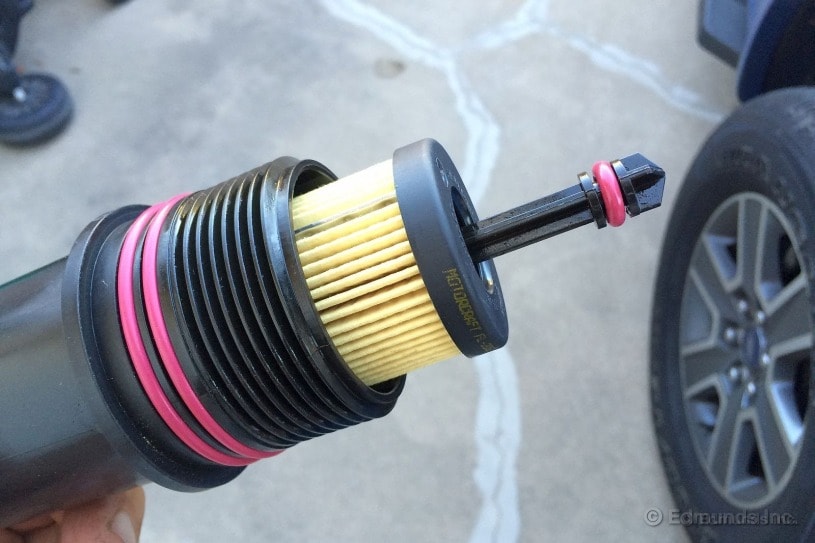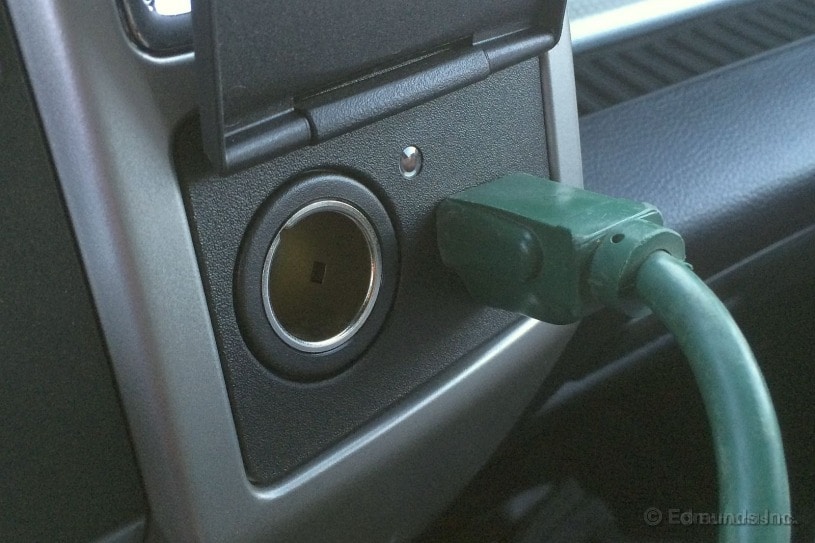2015 Ford F-150: What's It Like to Live With?
Read the latest updates in our long-term road test of the 2015 Ford F-150 as our editors live with this truck for a year.
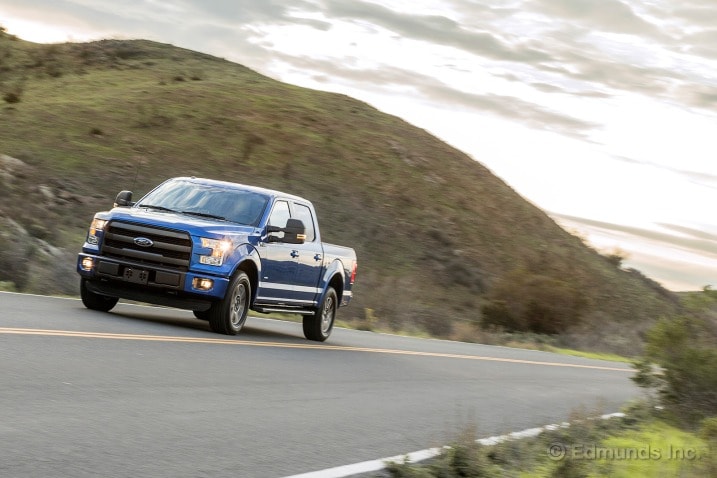
What do you want to know about?
- Introduction
- Aluminum Body Repairs Part 1 (With Video)
- Aluminum Body Repairs Part 2
- Aluminum Body Repairs Part 3 (With Video)
- Rereplacing the Sticker
- Fuel Economy Update for January
- Adding a Line-X Spray-On Bedliner
- Performance Tested
- Downhill Speed Regulation Done Right
- Suspension Articulation and Ramp Travel Index
- Fuel Economy Update for February
- Lousy Door Handle Design
- Hauling the Bedroom Furniture
- Watch Those Mirrors
- More Door Detents
- Towing Impressions
- Chipped/Cracked Windshield
- Fuel Economy Update for March
- Towing Nearly 5,000 Pounds
- More Power Than Ram
- Earns Five-Star Safety From Feds
- Will the Bike Fit?
- A Good View from the Towing Mirrors
- Engine Looks Ugly, Performs Well
- Jumbo Mirrors Are Thankfully Power-Folding
- Ford Issues First Recall for New F-150
- A Slow Month, But Still Not Hitting Fuel Economy Target
- Broken Rear Seat Release
- Towing Compared to Ram 1500 EcoDiesel, Part 1
- Towing Comparison With Ram 1500 EcoDiesel, Part 2
- Interior Trim Looks Better Than It Feels
- Remote Tailgate Release Comes In Handy
- Sounds Like A V8, But Should It?
- How Does Standard-Size Plywood Fit?
- Towing Compared to Ram 1500 EcoDiesel, Part 3
- Fun With Side Mirror Spotlights
- Leather Steering Wheel Feels Scratchy
- Fuel Economy Update for May - 20-MPG Combined Rating Still Out Of Reach
- Cracked Windshield
- EcoBoost V6 Still Worth Bragging About
- Luxury-Like Ride Runs Close Second to Ram
- High Sierras Road Trip — Impressive Performance at Altitude
- Our Workhorse Pickup Gets New Glass
- Best Start/Stop - Ever
- Ready for First Service at 10,000 Miles
- Hot Rod Heart
- Bigger Bed is Worth the Hassle
- Wicked Lumbaaaaah
- Superior Hanger-Holding Capability
- Fuel Economy Update for June - Long Highway Miles Nudge Average Lifetime MPG
- Prepared to Pull the Bullet
- Short-Bed (Almost) Long Enough to Haul Kart
- Tackles Tahoe With Ease
- Ponderous Handling in Tahoe Curves
- First Service and Fix-Its Cost Us Two Bills
- It's a Looker
- V6 Turbo is More Boost Than Eco
- Oregon Road Trip Leg 1 - Improvised Cargo Protection and a 638-Mile Tank
- Oregon Road Trip Leg 2 - World War II Bombsite and the Oregon Coast
- Oregon Road Trip Leg 3 - From Star Wars to Animal House and a 20-MPG Tank In Between
- Raised Rear Seats Yield Massive Cab Storage
- Oregon Road Trip Leg 4 - 707 Miles on a Single Tank
- Oregon Road Trip Leg 5 - A 23.1 MPG Exception, Trip Summary
- Bathes the Bed in Light
- Shifter Sized for Giants
- Massive Road Trip Sets New Records and Ups the Average, But...
- Powers Lighting for Pit Stops
- MyFord Touch Finally Decent, Does Sync 3 Promise Better?
- Can It Replace a Luxury Sedan?
- No Excuse to Run Into Anything
- No Surprises, But 20,000-Mile Goal Comes Months Early
- EcoBoost V6 Makes You Wait
- Easy DIY Oil Change Holds a Minefield of Potential Screw-Ups
- 25,000-Mile Update
- Big Truck Hauls Small Block
- The Man Step — Popular With Little Girls
- Bad Naming Has Skewed Our Outlook
- Big Month for Miles Moves Fuel Economy Up a Hair
- Need to Slam Shut Light Doors
- Hidden Styling Details
- Hauls Another Engine
- Slick Pedals
- Remote Start is Flawless and Easy to Use
- Towing Mirrors Whistle While They Work
- Ventilated Seats Get...Hot?
- Taking a Truck Car Camping
- Fuel Economy Update for November - Lifetime Average Still Improving
- Leisurely Oil Leak Repair
- Dump Truck, Part Two — Electric Boogaloo
- Poor Key Fob Design
- Rides Well With or Without Cargo
- Making a Move to Rainy Rose City - Part 1
- Making a Move to Rainy Rose City - Part 2
- Turns Over 30,000 Miles
- Slices Through Snowfall
- Wide Turns Only
- Visiting The Bradys and the Cunninghams
- The Limits of the Short Bed
- Fuel Economy Update for February — Holding Steady After 30,000 Miles
- Time for Another DIY Oil Change Already?
- Instrument Cluster Shows the Important Stuff
- Notes From a First-Timer
- Bumps and Rumbles in the City
- Foam Strip Vacates the Cowl Area
- Don't Worry, Mom - I've Got a Truck
- Fuel Economy Update for March - We're Not Alone
- Passes the Tough Mudder Test, Sort of.
- Fuel Economy Test: 2.7-liter EcoBoost vs. 5.0-liter V8
- Sold to Carmax
- Wrap-Up
Introduction
What Did We Get?
If there is one vehicle that requires no introduction, it's Ford's line of full-size pickup trucks, the F-Series. The ubiquitous trucks have led vehicle sales in the U.S. for a mind-numbing 32 years, longer than some of our editors have been alive. For 2015 Ford completely overhauled the truck. Our road test of the new pickup has all the details, but here's a quick refresher.
The big news for 2015 is the significant weight savings created by using aluminum for the hood, body panels and cargo box. The frame, too, is upgraded. It is now made mostly of high-strength steel, which gives it more rigidity and sheds another 60 pounds in the process.
This provides two advantages: First, if the overall vehicle weight rating stays the same, a lighter truck can handle a heavier payload. What's more, a lighter truck should also achieve better fuel economy.
Also new for this year is a turbocharged 2.7-liter V6 engine. With 325 horsepower and 375 pound-feet of torque on tap, it slots between the base 3.5-liter V6 and the larger 3.5-liter turbocharged engine. In 4WD guise, the truck earns an EPA-estimated 23 mpg in combined driving. Seemed like a good compromise of power and efficiency to us, so we went for the 2.7-liter V6.
Still, because trucks are offered in so many configurations, it took some digging for us to figure out our exact configuration. But after doing our homework, we called nearby Galpin Ford and put in our order.
What Options Does It Have?
The price of a 2015 Ford F-150 in base XL trim is $26,615. That gets you a regular cab, the 3.5-liter V6, a 6.5-foot box and not much else. We need more room if we are going to carry passengers, so we started with a SuperCrew cab and the 5.5-foot box.
We chose the Lariat trim because it was the most feature-rich trim you can get with the 2.7-liter EcoBoost engine, which is exclusively paired with a six-speed automatic transmission.
Features that are optional or not available on lesser trims include 18-inch aluminum wheels, leather-trimmed seats, 10-way power heated and ventilated front seats, dual-zone climate control, satellite radio, ambient lighting, power-adjustable pedals and a power-sliding rear glass window. This raised the bottom line to $42,240. We also ponied up an extra $3,420 to make ours four-wheel drive.
That was before we examined the options list. We began by selecting the seductively named Equipment Group 501A ($1,500), which includes a blind-spot monitor, remote start, power tailgate release, reverse parking sensors, side mirror LED lights, interior power outlets and a garage door opener.
We also ordered the Sport Appearance package ($1,995). It adds front bucket seats, sport decals, silver/dark gray aluminum wheels and a dark gray grille, step bars and bumpers. The F-150 is guaranteed to see its share of towing, so opting for the Trailer Tow package was a given. For $495, it combines four- and seven-pin trailer-wiring plugs, an auxiliary transmission oil cooler, upgraded front stabilizer bar, a Class IV hitch receiver and a module that alerts drivers to trailer connection problems.
Other options include the 36-gallon fuel tank ($195), tailgate step ($375), trailer tow mirrors ($165), trailer brake controller ($275), 3.73 rear axle ($570), a 700-watt audio system ($525) and a navigation system ($795).
There was a $750 discount for the Sport package at the time we ordered our truck. The MSRP after the discount totaled $51,800. This was a custom order, so we paid the sticker price.
Why We Bought It
Making the switch to an aluminum body for its top-selling pickup was the biggest gamble Ford has made in decades. It cost the company hundreds of millions of dollars in development work, plant upgrades and dealer training, all in the hope that it will make the F-150 superior in terms of capability and efficiency.
Will the weight savings be noticeable from behind the wheel? How will the small turbocharged V6 deliver on its rated 8,100-pound towing capacity? Can the combination of lightweight panels and a small engine meet the truck's EPA-estimated 20 mpg combined in the real world?
We have 12 months and 20,000 miles to find out whether the aluminum body panels are revolutionary. Follow along on the Long-Term Updates page for impressions of our new 2015 Ford F-150.
Edmunds purchased this vehicle for the purpose of evaluation.
I hit our brand-new long-term 2015 Ford F-150 4X4 SuperCrew with a sledgehammer. On purpose.
Twice.
We bought the $52,000 F-150 from Galpin Ford in Van Nuys, California. The day after the truck was delivered to our Edmunds office in Santa Monica, I went to work with the BFH, intentionally denting the Ford's right quarter panel.
Crazy? Maybe. But we wanted to find out if repairing the aluminum-bodied Ford is more expensive and time-intensive than repairing traditional steel-bodied trucks. Remember, the F-150 is the first pickup truck with a lightweight aluminum body and bed. After much thought we chose to smash the bed side because it would need to be repaired, as opposed to a dented door, fender or hood, which could simply be replaced.
So in the name of consumer awareness we dented our truck with two big blows from a sledgehammer (the impact also cracked the taillight) and drove it straight from the Edmunds garage to our local Ford dealer, Santa Monica Ford, and asked for an estimate. Take the jump to check out the sledgehammer video.
Hiding the fact that we're Edmunds.com was important so our experience truly represented the real world. No special treatment.
I also didn't want to admit that I had hit the truck with a hammer, so I lied and told the service advisor that the damage happened while I was parked. I told him I had no idea what happened. I also told him that to avoid raising my insurance rates, I'd be paying out of pocket for this repair. He grimaced and sympathized with me, then got out his clipboard and pointed out the areas that needed repair.
Various sections of the panel had deformed and would need to be pounded out. Near both the top and the bottom of the panel, there were creases and folds in the aluminum that would need to be fixed before they could be painted. According to the advisor, the aluminum would be much harder to fix than steel. His shop was trained to fix the aluminum but it required special tools and would take extra time. A job like this on an F-150 with steel panels "would take half the time."
After about 10 minutes, the advisor came out with an estimate.
I approved the work and asked if I could come back in a few days and photograph the repair in progress. He agreed.
Stay tuned for Part 2 later today.
Read the whole series:
2015 Ford F-150: Aluminum Body Repairs Part 3 (With Video)
2015 Ford F-150: Aluminum Body Repairs Part 2
After bouncing an 8-pound sledgehammer off the side of our new long-term 2015 Ford F-150, twice, I went undercover and drove it to our local Ford dealer, Santa Monica Ford, for repair.
As explained in Part 1 of our adventure, the idea was to test the hypothesis that when the aluminum body of our 2015 F-150 is damaged, it takes longer and is more expensive to repair than a more traditional steel-body pickup truck.
Ford claims the 2015 Ford F-150 is up to 700 pounds lighter thanks to its aluminum panels, which increases overall fuel economy and payload. But what happens when Thor decides to use your truck for target practice?
According to Ford, "the majority of collision repairs can be completed by most body shops today (e.g. bumpers, grilles, mirrors, dings, dents) [but] major collision repairs should be performed by aluminum-capable Ford body shops or National Body Shop Network members." Along with training from the "Ford F-150 Collision Repair Program" Ford body shops or independent body shops would need some specific equipment to repair the damage on our truck.
Here's a list of the equipment Ford recommends "to be aluminum repair capable":
|
Dedicated aluminum MIG welding system Welder must be 200v and equipped with Pulse MIG Technology |
Dedicated aluminum hand & power tools |
Dedicated aluminum dent extraction system |
Dedicated aluminum Wet Mix air filtration system |
Work area separation / isolation system |
Specialized aluminum SPR rivet gun |
This might seem like a complicated list, but many body shops have had this stuff for years. Aluminum body panels on cars aren't really new. They're just new in the pickup truck segment, so there are dozens of independent shops and Ford dealers near our Santa Monica office that can handle this repair. Finding a certified independent shop, however, or a properly equipped dealer might be more difficult in other parts of the country.
When I dropped the truck off at Santa Monica Ford, the manager told me they would definitely be repairing the panel, not replacing it. Perfect. It would take "seven to ten business days" to finish the job and they welcomed me back to take photos of the process.
Less than a day after I handed over the keys, though, I got a call from the body shop. The service advisor had misquoted the price of a part and they needed my approval to move forward. Ruh-roh.
The second time I hit the truck, the taillight cracked, and even though it still functioned properly we wanted to fix it. Ideally, we'd replace just the broken piece, the lens. Unfortunately, it's permanently mated to the housing and Ford only sells this part as a single unit. What's more, we got our F-150 in the Lariat trim level. That means it's equipped with (amongst other things) a blind-spot monitoring system. The sensors for that system are housed in the taillight and as you might expect, this all led to a higher price for the taillight assembly than previously expected. Much higher.
The price jumped from $106.28 to $887.25. For a taillight.
Without much of a choice, I approved the price increase and thanked the shop for double-checking with me.
Two days later, I checked in on the F-150 to see what progress had been made. The body shop had removed the "Sport 4x4" sticker and the taillight and started dent repair, pulling out the damaged areas.
Four days after dropping off the truck (two days after my first checkup) I dropped by the shop again. This time they were in full sanding mode, prepping the truck for paint.
If I looked closely, I could see where the sledgehammer had made contact, but the damage was starting to disappear. During the second visit, the service advisor let me know the truck would be finished on schedule, just a few days later. Sure enough, seven days after we dropped off the truck, it was ready to go.
Check in tomorrow morning as we welcome the 2015 Ford F-150 back into our fleet with full details on the cost to repair it.
Read the whole series:
2015 Ford F-150: Aluminum Body Repairs Part 3 (With Video)
2015 Ford F-150: Aluminum Body Repairs Part 1 (With Video)
"The normal aluminum labor rate is $120 an hour, but since you're paying out of pocket I'm going to cut you a deal," the service advisor said, holding back the computer print-out. "I'm only going to charge you our normal rate of $60 an hour but it's over 20 hours of labor."
When I dropped off our long-term 2015 Ford F-150 a week ago, I couldn't tell if the advisor was trying to soften the blow of a costly repair or if he was really taking pity on me. There was no "Aluminum Body Rate" on their posted list of prices in the waiting room, just the "Body Rate per Hour" of $60. Whether this was an exaggeration or not, it was a nice sentiment. I lied to the service advisor, so in his mind, I was the victim of a hit-and-run accident and I deserved a bit of leeway.
The damage was actually a result of two blows from a sledgehammer. We were testing the theory that aluminum is more expensive to repair than steel and I had lied about the damage to get the most realistic customer experience possible. So far, it seemed to be working. The repair would take "twice as long as steel" but I'd be paying half the standard rate. It was time to break out the calculator and do some funky math.
He handed over the sheet and explained each item. After straightening the panel as best they could, they'd apply a specialized aluminum paint filler, then primer, paint, color sand and buff the panel, replace the taillight and put on a new "Sport 4x4" sticker.
For "seven to 10 business days" worth of work, the price of labor and parts totaled $2,082.73. My eyes went wide, but I signed the estimate, declined a rental car and handed over the keys.
As I mentioned in Part 2 of the story, the price went up quickly when the taillight turned out to be more expensive than previously thought. Instead of the $106.28 for a standard taillight, our Lariat's LED light with the blind-spot sensor cost $887.25. With the subsequent increase in sales tax, the repair bill totaled $2,938.44. Ouch.
True to their word, the body shop finished the work a week after I dropped the truck off. And to my eye, they did an almost-perfect job.
The panel is straight, it retains all the original character lines and the paint is matched perfectly. The only real flaw is the placement of that "Sport 4x4" sticker. It's about two inches too far to the left of where it should be. Dan Edmunds came with me to check on the repairs and neither of us noticed at first, but it certainly stands out now that our more eagle-eyed co-workers have pointed it out.
Side note: We've contacted the dealer and they've ordered a new sticker. An outside vendor does the sticker placement and they'll come to us to fix it, free of charge.
I should note that repairing aluminum differs from repairing steel in several ways. It requires special tools (re-read Part 2 if you missed those details) and it stretches in different ways than steel. As a result it can require a more experienced hand. It seems like the staff at Santa Monica Ford has that part covered.
But what about replacing body panels all together? If we had been in a more serious accident, with another vehicle involved for instance, and we needed a panel replaced, could it take a shop longer to get that panel in stock?
According to Ford, the body panels aren't any more expensive now that they're made out of aluminum. The price for a replacement right rear-quarter panel on a steel-bodied 2014 F-150 is $967.48. And for the same panel on an aluminum-bodied 2015 F-150? $967.48. That's nice to hear, but what would it have cost to fix a steel panel rather than replace it?
As you'll notice in the above photo of the estimate, there are 24.4 hours of billed labor. Of that, 20 hours are listed for the repair of the aluminum body panel. The other 4.4 hours are things like removing the molding, taking off the bumper and uninstalling the tailgate. Clearly, that labor wouldn't take any more or less time regardless of what the parts are made of.
If we go with the theory that our service advisor presented though, and assume fixing a steel panel would take half the time, it works out to just 14.4 hours of labor. Work that in to the above estimate and you'll get a total of $2,338.44.
That's $600 less.
Let's take that a step further, though. Assuming that the labor rate for aluminum was the $120 an hour the service advisor told us, and going with our quoted time of 20 hours or body labor to pound that panel out, we're looking at $4,138.44. That's a difference of $1,800, a price increase of nearly 77 percent versus the cost of repairing a steel panel for 10 hours at $60 per hour.
To be sure we called our regular body shop, Golden Hammer in Santa Monica. The shop has fixed dozens of dented, dinged and damaged Edmunds long-term test vehicles. That shop charges $50 an hour to fix a steel panel and $105 an hour for aluminum. Take it a little further down the rabbit hole and there's insurance to think about. If we had gone through insurance to pay for this repair, my out-of-pocket cost for the repair might not have changed so much, but that's probably not where it would end.
Imagine you've got a $500 or even $1,000 deductible on your insurance policy. You hit a tree, tell the body shop guy you have no idea what happened, but insurance is paying to fix it. Your insurance premiums may go up, but the remainder of the cost is passed along to your insurance company. In this scenario, the associated insurance cost for owning an aluminum-bodied vehicle likely goes up too. Maybe it already has.
There's plenty to speculate about when it comes to the new 2015 Ford F-150, and we've got a year to keep testing out our theories, but there are a few things we know for sure. One: It takes more time, unique tools and specialized training to fix aluminum body panels. Two: Those repairs, whether through higher labor rates or longer service times, cost more money than repairing steel. And three: It's really fun to smash things with a sledgehammer.
Read the whole series:
2015 Ford F-150: Aluminum Body Repairs Part 2
2015 Ford F-150: Aluminum Body Repairs Part 1 (With Video)
So the Sport 4x4 sticker on the side of our long-term 2015 Ford F-150 was now wonky, which was gonna bug me forever if we didn't get it properly placed on the quarter panel. We needed to have it rereplaced.
In case you missed it, we hit our aluminum-bodied F-150 with a sledgehammer, took it to a Ford dealer to fix it and ultimately concluded that the fix cost more than equivalent steel body panel repairs.
The repair, done by Santa Monica Ford, was beautiful, with one exception. The new Sport 4x4 sticker was now wonky. It just wasn't where it should be. Basically, the placement didn't match the other unrepaired side of the truck.
The deviation was so minor we didn't even notice it until the repair was paid for and the truck was back at our office. But the corner of the "S" now overlapped the panel crease, which it shouldn't. It wasn't way off, just an inch or so too close to the taillight. We wanted it fixed.
A few days ago (before our video went live) I called Santa Monica Ford to see what they could do about it. The same way they were cordial and polite in person, they were just as easy to deal with over the phone. They apologized, said they would order the sticker and assured me they'd call when it arrived. Sure enough, just a few days later, the independent decal installer arrived at the Edmunds office to fix the mistake.
The dealer called me as soon as the sticker arrived, confirming our building's address and the time to come by. The sticker install was swift and easy (it only took about 10 minutes) and the mobile decal guy was happy to let us take photos of the process.
It was a wonderful experience all around. They had made a mistake and they made it right quickly with no cost or hassle for the truck's owner. This is how it should be.
Here's a photo of the sticker placement after the original repair:
And now, the fixed placement:
Ah, much better. I can finally sleep at night.
2015 Ford F-150: Aluminum Body Repairs Part 1 (With Video)
2015 Ford F-150: Aluminum Body Repairs Part 2
2015 Ford F-150: Aluminum Body Repairs Part 3 (With Video)
New year. New truck.
Fresh from our New Year's Day off we bought this $52,000 2015 Ford F-150. Then we hit it with a sledgehammer and had it repaired.
It was at the body shop for seven days.
When it wasn't we managed to drive the aluminum-bodied pickup, which is powered by a 2.7-liter EcoBoost V6, about 1,000 miles before the calendar clicked over to February.
So far the Ford's fuel economy hasn't lived up to the EPA's combined rating of 20 mpg, but that's to be expected this early in its life.
We are impressed with the F-150's range, however. Over 500 miles per tank should be easy once the turbocharged V6 is broken in.
Stay tuned.
Worst Fill MPG: 14.0 mpg
Best Fill MPG: 16.6 mpg
Average Lifetime MPG: 15.1 mpg
EPA MPG Rating: 20 Combined (18 City/23 Highway)
Best Range: 435.5 miles
Current Odometer: 1,015 miles
For some time we've toyed with the idea of equipping our test trucks with spray-on bedliners. Without any sort of protection they get scratched up, which comes across (to some) as unsightly. Truck bed scuffs can also diminish resale value and increase the risk of future corrosion.
We could have equipped our 2015 Ford F-150 Lariat 4x4 pickup with a factory spray-on bedliner for $475, but we'd never spent any time with the factory offering in real life. Besides, Ford's bedliner department still follows old Henry Ford's famous line: any color you want, so long as it is black.
The brilliant "Blue Flame" paint on our truck is not a particularly dark color, and the Lariat Sport package adds enough black accents of its own. We figured a color-matched bedliner would look much better, so we turned to Line-X, a stalwart in the spray-on truck bedliner business.
Line-X is a franchise business, so prices vary a little across the country. Our local shop in Orange, California sells the basic black one for about the same price as Ford: $485. A UV-resistant topcoat that prevents the black from fading costs $150 more, but the color-matched UV-resistant topcoat we had in mind is a $300 upgrade. Do the math and you'll see that our total came to $785. More money, for sure, but better-looking.
They said it'd take about three hours to prep and spray our truck. After that I could take it home so long as I didn't load anything into it and kept it dry for the next 24 hours. So I showed up at their front door at 8:30 a.m. and texted my wife to say I'd be back in time to take her to lunch.
Things progressed quickly. The tailgate came off almost immediately, and after that they removed all the bolt-on bed hardware and unscrewed the six huge bolts that hold the bed to the frame so none of that stuff would get coated and frozen in place. What they couldn't remove they masked off: the two LED bed lights and the flat rubberized switch that controls them.
Next came a lot of masking tape and paper, and then they brought out the sandpaper to scratch up the surface enough to allow for a strong bond.
It wasn't long before everything was rolled into the spray booth and the cab was swaddled in protective plastic film.
"Oh right, these won't work on this one," exclaimed Joey as he put away the hockey puck-sized magnets they usually use and broke out more masking tape.
The tailgate and its access panel were placed on a separate stand in the booth so they'd be in easy reach of the spray rig.
And we're off! Compared to the preparation process, spraying didn't take long at all. As you can see, the Line-X material comes out blue all the way through. The topcoat came next, with practically no wait time in between, and its shade of blue had been specifically mixed to match our truck's paint code.
In no time at all the prep crew came in and removed the paper while the man in the space suit was off cleaning his spray rig.
They started screwing the hardware back in place less than 15 minutes after spraying was complete. The surface was still tacky, but curing fast.
That's because Line-X is a mix of two heated and pressurized components that first come together near the tip of the nozzle of the spray gun itself. But it's not an epoxy coating; it's in the polyurethane family. The atomized spray is a "hot" mix that begins to gel and get deep into the polymerization process within 5 seconds, which is about 4 seconds after it hits the truck.
I was out of there slightly less than three hours after work began, plenty of time to make the lunch date I'd made with my wife.
The only thing I had to do was keep the tailgate down for the next few hours so the still-curing liner material didn't get abraded by the rubber tailgate stoppers. I eventually decided it was OK to shut it just before I went in for dinner later that evening, at which point I could detect no lingering tackiness. Next day at noon the 24-hour no-load, no-wash waiting period was over, too.
I don't know about you, but I think this Line-X bedliner looks mighty impressive. And the color match is just what we were hoping for.
I'm ready to try it again on the Ram. That one has plenty of scratches I'd like to hide.
Even though our 2015 Ford F-150 was at the repair shop for a few weeks thanks to a sledgehammer-related incident, our truck passed the 1,000-mile mark within its first month in our long-term fleet. The engine was fully broken in according to the manual, so it was ready to go to our test track. Read on to find out how well the new turbocharged 2.7-liter V6 moved our full-size pickup.
Vehicle: 2015 Ford F-150
Odometer: 1,139
Date: 2/3/2015
Driver: Chris Walton
Price: $51,800
Specifications:
Drive Type: Four-wheel drive
Transmission Type: Six-speed automatic
Engine Type: Twin-turbocharged V6
Displacement (cc/cu-in): 2,694 / 164
Redline (rpm): 5,800
Horsepower (hp @ rpm): 325 @ 5,750
Torque (lb-ft @ rpm): 375 @ 3,000
Brake Type (front): One-piece ventilated disc with dual-piston sliding calipers
Brake Type (rear): One-piece ventilated disc with single-piston sliding calipers
Suspension Type(front): Independent double wishbone, coil-over-shock
Suspension Type (rear): Solid axle, leaf springs
Tire Size (front): 275/65R18 116T M+S
Tire Size (rear): 275/65R18 116T M+S
Tire Brand: Goodyear Tire Model: Wrangler Fortitude HT
Tire Type: All-season, low-rolling resistance
As-Tested Curb Weight (lb): 5,160
Test Results:
Acceleration:
0-30 (sec): 2.2 (w/ TC on 3.0)
0-45 (sec): 4.0 (w/ TC on 4.9)
0-60 (sec): 6.4 (w/TC on 7.3)
0-60 with 1-ft Rollout (sec): 6.1 (w/TC on 6.9)
0-75 (sec): 9.8 (w/TC on 10.7)
1/4-Mile (sec @ mph): 14.7 @ 92.3 (w/TC on 15.4 @ 92.1)
Braking:
30-0 (ft): 32
60-0 (ft): 129
Handling:
Slalom (mph): 55.7 (55.4 w/ESC on)
Skid Pad Lateral acceleration (g): 0.66 (0.65 w/ESC on)
RPM @ 70: 1,950
Comments:
Acceleration comments: Initial acceleration is strong, even from relatively low engine speeds, but we found the F-150 to be even quicker in Auto 4WD with the engine revs raised against the brakes before leaving the start line. With the traction control disabled, we weren't able to produce even the slightest amount of wheelspin with either technique, but it didn't seem to hurt acceleration one bit. This is a very strong engine and I even like the sound it makes (or that the stereo makes) under full throttle. Upshifts are exceptionally smooth, but not particularly quick. Clearly there's plenty of cooling capacity here as well because the terminal speed at the end of the quarter-mile didn't drop one mph across six passes. Who needs a V8 when this turbo-six is so strong?
Braking comments: With a medium-firm pedal, this F-150 stops shorter than the pickup truck average with ease and confidence. Naturally, there's some dive, but it maintained good directional stability and the distance to stop from 60 mph grew by only two feet across 4 runs. Good brakes.
Handling comments: Keeping in mind the length of this pickup was the key to not running over cones with the rear tires in the slalom test. It turns in with confidence, has good body control from side to side, but it's the length of the truck that limits its speed here. It felt like I was nearly to the next cone before I could ask it to turn in the other direction. At the very limit, the truck would lose traction on the front tires, the electronic stability control system (ESC) would briefly dab a brake to point the nose back on line, and then recede quickly. ESC is tuned well to be effective without being punitive. On the skid pad, it feels like the tires are begging for mercy, and the ESC maintains a speed just below the torturous howl of the tires with minimal drama or interference. Steering in both tests felt good by truck standards, with good precision and natural weighting.
Last weekend I found myself approaching the same long downgrade that had earlier goaded our 2015 Kia K900 into doing wrong things in an effort to keep its speed in check. But this time I was in our new 2015 Ford F-150 Lariat 4x4 pickup, which presented a perfect opportunity to set the cruise control at the same speed and see if the F-150 could do any better.
Before I reveal how it went, allow me to first set the table. I was alone. I wasn't towing or hauling anything, so there was no need for Tow/Haul mode. And this simple interstate cruise wasn't the appropriate time or place for so the newly added Sport mode, either. This was routine stuff, everyday driving in "D" with the transmission in its normal default mode.
With cruise engaged, the truck approached the grade at the desired 65 mph in sixth gear at about 1,750 rpm. Nothing changed in the first moments of the descent, but as the slope got steeper the truck's speed crept up to 66 mph, then 67 mph.
But that's as far as the situation progressed before the transmission spontaneously dropped into fifth gear. The F-150 didn't gain any more speed from that point on, but as the grade continued to pitch downward the ECU decided another downshift was necessary and the transmission dropped into fourth.
At that point the engine speed stabilized at about 3,000 rpm as the truck's speed was reined in to 65 mph. Equilibrium was restored, and that's exactly how it stayed for the remaining five miles of the grade.
That's how this is supposed to work. Transmission downshifts should be the first line of defense, increasing the engine's speed to provide the necessary engine braking. I'll gladly take the piddling 2-mph overshoot if that's what it takes for the ECU to recognize the circumstances and respond in a measured way that keeps the brakes out of it.
It's not surprising that a pickup truck would have this sort of thing figured out. The engineers involved know full well how towed weight or a heavy payload can exacerbate this sort of situation on steep hills, and they also know that gearing down is the safest and surest way to control speed.
But this was just one grade. Another staffer drove a different 2015 F-150 with the same 2.7-liter Ecoboost engine (a pre-production sample, admittedly) on a different downgrade at a different speed and was not nearly as impressed. And we've yet to try this with a trailer pushing from behind.
Still, as the saying goes, so far, so good.
You want a decent amount of suspension articulation if you're going to venture off the pavement very far, especially if you see yourself getting into the kind of frame-twist situations where one tire could hike up off the ground. It turns out this is fairly easy to measure and quantify in terms of Ramp Travel Index (RTI), so named because the frame twist maneuver is artificially created by driving up a ramp.
Last week I drove our 2015 Ford F-150 SuperCrew 4x4 pickup up a 20-degree RTI ramp of our own making to see how much suspension articulation the new Ford has to offer.
The measurement is simple. Run the driver side front tire up a 20-degree ramp until the moment the corresponding rear tire barely lifts off the ground. Next, measure and record the distance the front tire traveled up the ramp and divide this figure by the truck's wheelbase. Finally, take that number and multiply it by 1,000 to get your RTI score. Why 1,000? It's easier to talk about without decimal places.
Stock vehicles never get to the point where the rear tire touches the ramp, which is why you'll never see a perfect score of 1,000 on anything less than a highly modified Jeep.
So how did our 2015 F-150 SuperCrew 4x4 fare?
The best small crossover SUV we've ever measured so far (and we have by no means measured them all) is the Mazda CX-5, which scored 334 points. Hot on its heels is the new Jeep Cherokee Trailhawk at 324 points.
Full-sized ladder frame trucks like the 2015 Ford F-150 are supposed to do better, and so it was with our results. Those of you that live in Washington and Colorado will be especially interested to know that it scored exactly 420 points.
It's worth noting that this number applies to the 145.0-in wheelbase. Our truck is a crew cab with the stubby 5.5-foot bed, but the results should be the same for the SuperCab with the 6.5-ft bed because they both ride on the same wheelbase.
For reference, here's how our F-150 lines up against other similarly large crew cab 4x4 pickups that have made the trip up our ramp.
518 – 2014 Ram Power Wagon, front stabilizer bar disconnected (149.3-in WB)
484 – 2014 Toyota Tundra TRD Pro (145.7-in WB)
420 – 2015 Ford F-150 (145.0-in WB)
412 – 2014 Ram Power Wagon, front stabilizer bar connected (149.3-in WB)
Both of those are pretty serious off-road packages that include targeted factory suspension modifications, so it's no wonder they do better than our Ford, which has more of a broad-spectrum 4x4 suspension.
In fact, the Ram has two results because it comes factory-equipped with a cockpit-controlled front stabilizer bar disconnect mechanism that was specifically engineered to improve off-road suspension articulation and RTI while maintaining the ability to control body lean when driven on pavement. The improvement amounts to over 100 points.
What's missing is our 2014 Ram 1500 Crew Cab 4x4, a truck that has a matching cab and bed configuration and the same sort of standard 4-wheel drive system. That would be a very interesting result to hold up against the F-150, but it doesn't yet exist.
I'll get right on that. I'm a bit embarrassed I haven't tested that one already. My bad.
The average fuel economy of our 2015 Ford F-150 is improving, but still not enough for us to be impressed.
In February, the aluminum-bodied pickup, which is powered by a 2.7-liter EcoBoost V6, averaged 16.3 mpg over about 1,700 miles of mixed driving. And our best single tank average is now up to 17.3 mpg.
That's enough to bring the Ford's overall average up to 16.0 mpg.
So it's getting better, but it remains far below the Ford's EPA combined rating of 20 mpg and its city rating of 18 mpg.
After all that math there was just one thing to do: Go out for barbeque. And the big blue pickup was the perfect ride.
Worst Fill MPG: 14.0 mpg
Best Fill MPG: 17.3 mpg
Average Lifetime MPG: 16.0 mpg
EPA MPG Rating: 20 Combined (18 City/23 Highway)
Best Range: 557.3 miles
Current Odometer: 2,991 miles
There are many clever design elements in our 2015 Ford F-150. The interior door handles are not one of them.
I say this as a current owner of a 1975 F-250 (equally crappy interior door handles) and the previous owner of a 1986 Ford F-250 (great door handles).
As you can see, opening the door requires you to stick your hand inside this pocket and squeeze the lever toward you. Two problems here.
One, if you have big hands with big gloves over them, shoving them into this pocket might not be that easy. The design was already in use in the Super Duty pickups, so apparently this issue hasn't been a problem.
Second, squeezing the lever toward you while at the same time pushing the door open is not a natural movement. The whole squeezing of the lever thing is just plain dumb.
Contrast this with the setup in my old '86 Ford. It has a lever located about midway down the door panel with nothing around it. To open the door, you just reached down and yanked it up. It worked if I pulled it lightly, and equally well if I was in a hurry and gave a quick rip.
At the time I thought it seemed like a perfect design for a truck and still seems very user-friendly. I'm sure there are all sorts of reasons why Ford went with the current design. I'd be curious what they were.
You know that guy driving the pickup truck packed full of his kid's bedroom furniture down the highway. He's got the tailgate down and the precarious load looks as if it's going to topple at any moment, spilling pink chairs and other assorted IKEA items all over the road.
Yeah, that was me. That was me in our long-term 2015 Ford F-150.
For the record I made the 65-mile drive without redecorating an L.A. freeway with my daughter's bed or dresser. And the Ford handled the piling with ease. I, of course, would have preferred to close the tailgate, but such is life with the shorter five-and-half-foot bed.
As you can see I used many straps to secure the load and was grateful for the F150's numerous well-placed in-bed tie-down hooks and cleats. I used the majority of them.
After unloading the pile at my sister-in-laws house it was off to IKEA for the replacement dresser and nightstand. The boxes fit with the tailgate closed so the ride home was far less stressful.
If you've been to IKEA you know that each of those boxes weighs exactly a ton. Unlike my back, the Ford didn't seem to care. I, of course, spent the next 36 hours assembling the contents of those boxes, which was a great way to spend my weekend.
This is what can happen when you're not paying close attention while exiting a parking garage in our 2015 Ford F-150. It wasn't that I wasn't paying attention at all, I just didn't realize that our extendable trailer tow mirrors were in their most extended position. That only leaves a few inches of clearance on either side when exiting a certain section of our office garage.
So go ahead, heap insults on my lack of driving skill. Tell me that I don't care because it's not mine. Whatever, I can take it.
We'll get it fixed soon enough and I'm sure it won't be nearly as much as the quarter panel repair. The mirror housing is good old plastic and as far as I can tell the turn signal lens looks replaceable on its own. And everything still works by the way, it just looks bad.
The photo above would not have been possible with the previous-generation Ford F-150. You see, there were only two door detents, meaning you either had to squeeze through a narrow opening or prevent the door from flying into your parking-lot neighbor while climbing aboard.
As you might imagine given the colossal door, this was not ideal. The 2015 Ford F-150 has a new middle detent that makes life in parking lots much easier (and insurance claims less likely). It's an excellent advancement to be sure.
Up until last weekend I'd spent very little time driving our long-term 2015 Ford F-150. My first real drive in it would be towing a craptacular race car from Los Angeles to Sonoma Raceway and back, an 850-mile round trip.
So, how'd it go?
The whole trip was a breeze. Granted, a caged Miata and this formula car trailer is a pretty light load as these things go. This truck's 2.7-liter twin turbo V6 has way more than enough gusto, and moved out with authority. It's really a terrific power plant, with a very smooth and quiet disposition and little if any meaningful turbo lag. Torque comes on strong at very low revs. If you're considering the 3.5-liter Ecoboost, be sure to try the 2.7-liter first, as it may well be totally sufficient for your needs.
It took me a minute to locate the tow/haul button. Turns out it's a tiny Chiclet at the base of the transmission selector. Engaging tow/haul mode holds gears longer and is better about downshifting. For instance, with the cruise set, the F-150's transmission will kick down when descending in an attempt to maintain your set speed.
The truck's chassis is notably more refined than the outgoing F-150. It is much quieter. Really, the only untoward noise I heard was an odd creak from the driver's door. I've found quiet truck cabins to be a real boon in combating fatigue behind the wheel, and the F-150 delivers. The ride quality, too, was barely fazed by the addition of the trailer's tongue weight. I know you've heard this refrain before, but — no joke — there were several instances on this trip that I forgot I was towing anything. For real.
When you attach the trailer's wiring connector to the truck, the truck recognizes this and turns off the parking sensors and cross-traffic alerts. And if you scroll through the menus in the instrument cluster, you'll find a towing menu. Here, the truck tests the trailer's lights to ensure they're functioning properly. This feature is especially handy if you're hooking up the trailer solo.
What else? The LED puddle lights in the side-view mirrors, each with their own button, throw a lot of light. Nice. The backseat cargo volume is thoughtfully laid out. There's enough height under the backseat to stow a full-size floor jack, and the long, skinny compartment under there is sized just right for the jack handle.
Fuel economy for this trip (approx. 85% towing) came in at 15.1 mpg.
Basically, on this trip I found the new F-150 a smart, comfortable and capable tool. I'm impressed.
I was packed up and ready for a 1,000-mile road trip when I saw it: a chip/crack in the windshield of our long-term 2015 Ford F-150.
It's another minor injury to our new truck to accompany an earlier cracked mirror-integrated turn signal indicator. The likely culprit is a rock or some bit of highway debris (no, I didn't hit it with a mini-sledgehammer) and hopefully we caught it early enough to avoid replacing the entire windshield.
Time to call around for some quotes and let you know what we find.
March was a busy month for our long-term 2015 Ford F-150. We racked up 2,700 miles over the last four weeks, 2,000 of which were spent towing various trailers. Engineering Editor Jay Kavanagh towed something that vaguely resembles a Miata to and from Sonoma Raceway. I took a similar 2,000-mile trip to purchase a car and lug it home (more on that soon).
Basically, we used this truck as it was intended: to haul stuff. As you'd expect, those towing trips brought the average lifetime MPG down (from 16 to 15.6) but the F-150 still has plenty of time in our fleet to right that ship.
Worst Fill MPG: 14.0 mpg
Best Fill MPG: 17.3 mpg
Average Lifetime MPG: 15.6 mpg
EPA MPG Rating: 20 Combined (18 City/23 Highway)
Best Range: 557.3 miles
Current Odometer: 5,774 miles
I thought I was going to be the first person in the office to tow something with our long-term 2015 Ford F-150, but Jay Kavanagh beat me to the punch. Our trips were two weeks apart but nearly identical, as Jay and I both took the F-150 from Los Angeles to Sonoma, California. Our cargo was similar too, although mine was more than 1000 pounds heavier than Jay's haul. Even with the extra weight, the big blue Ford pulled like a champ.
From L.A. to Sonoma, I towed an empty two-axle car trailer and often forgot it was even there. The truck didn't struggle once. Long uphill grades and on-ramps were simple work for the 2.7-liter Ecoboost V6. Thanks to our 36-gallon fuel tank (a $195 option), I made the entire 522-mile trip on one tank of gas.
Towing an empty trailer behind it, the F-150 used 31.8 gallons of fuel, working out to an impressive 16.4 mpg.
On the return trip, I towed an Acura Integra that weighed about 2,600 pounds. To see how close this approached the F-150's maximum weight limit, some math was required.
Since it's a Crew Cab with the 3.73 axle ratio and four-wheel drive, our F-150 has a Gross Combined Weight Rating (GCWR) of 13,300 pounds. That means the weight of the truck, the passengers and the tow load couldn't exceed 13,300 pounds. With a full tank of fuel and no passengers, our long-term F-150 weighs 5,160 pounds. The combined weight of the truck, passengers and gear (700 lbs.), the trailer (2,210 lbs.) and the Integra added up to 10,670 lbs., about 80 percent of the GCWR.
With that much weight behind it, the F-150 was slower of course, but it never felt sluggish or over-stressed. In tow/haul mode, the six-speed automatic transmission controlled shifts well without roaming between gears. Power delivery from the 2.7-liter V6 was particularly impressive going over the Grapevine. Mashing the throttle moved the F-150 forward with purpose, and passing big-rigs on the four-lane highway was easy, even with outside temperatures in the mid-80's and the A/C blowing strong.
I took a shorter, more direct route home while towing the car and trailer, and on that trip the F-150 used 33 gallons over 470 miles, averaging 14.3 mpg. As Jay mentioned in his previous post, the F-150 has features that help monitor the trailer, along with easy-use storage and a comfortable ride along the highway. For my purposes, it couldn't have been an easier journey.
In the ever escalating power wars, the 2015 Ford F-150 has the Ram 1500 beat. Well, at least in terms of wattage.
As you can see, our F-150 features an AC outlet that delivers up to 400 watts of total power at 110 volts. Not bad for a pickup.
Compare that with the 150-watt outlet in our Ram 1500 and it's no contest.
So will it blend frozen concoctions in the parking lot before kickoff? Yes, in the F-150, it will. Not happening in the Ram.
The crash-test results are in and our 2015 Ford F-150 SuperCrew has been awarded a five-star safety rating from the National Highway Traffic Safety Association. The aluminum-intensive pickup received five stars in front and side crash tests and four stars in the rollover crash test.
The initial rating applies only to the 2015 F-150 with four full-size doors. The 2015 Ford F-150 regular cab and SuperCab have not yet been tested. The five stars improve on the last F-150 SuperCrew's four-star rating.
The Insurance Institute for Highway Safety has not rated the 2015 F-150, although it gave the 2014 model its highest rating of "Good" in front overlap, side, roof strength and head restraint and seat tests.
I know what you're thinking. Of course it will fit. The 2015 Ford F-150 is a pickup with a bed hanging off the back, for crying out loud.
Yes, but then I'd need some sort of rack, a lock and a wary eye in certain parking lots. I can avoid all this because ours has a crew cab or, as Ford fondly calls it, a SuperCrew cab.
Aluminum wasn't the only big change for 2015. Ford also shifted the central door post of the crew cab forward a couple of inches to improve access to the back half of the cab.
This alteration greatly enlarges the gap between the post and the leading edge of the seat bottom, which makes it much easier for passengers to swing their feet on board. Engineers actually use the term 'foot-swing distance" when referring to the width of this opening.
The B-pillar shift also eases cargo loading, because the entire door is that much wider. It makes it easier to take full advantage of the SuperCrew's sizable cargo capacity, made possible by flip-up seat bottoms, compact seat bottom supports and an ultra-flat floor.
The upshot of all this is my XL-size Giant hardtail mountain bike with 29-inch rims fits easily. It's a non-issue. And the bars go through the door with no monkeying around. In fact, there is enough room left over for another similar-sized bike to fit in from the other side if I angle mine slightly.
Sure, a large SUV like an Expedition offers secure storage space, too. But then I wouldn't have a bed for the dirty stuff and the rear half of the SuperCrew is arguably more useful for certain items - like bicycles - because of the tall vertical space that results from a pickup's unique seat-folding strategy.
When I towed nearly 5,000 pounds with our long-term 2015 Ford F-150 a few weeks ago, I was impressed by the various tech features in the cabin and the towing power of the 2.7-liter engine. One thing I neglected to mention though was the optional towing mirrors. We've already discovered that when fully extended, the mirrors can tag the exit of a parking garage.
But how do they perform when there's a trailer to watch?
The mirrors extend out about 3 inches more than usual when set to their widest position and they're excellent for monitoring whatever you're hauling. They are a bit cumbersome when parking or fitting into tight spaces since you have to watch the trailer's location and also avoid hitting the mirrors on trees or street signs. The mirror's power-folding function combined with a slow-and-steady approach generally keeps you out of trouble.
As for the mirrors themselves, there's enough surface area on the flat and convex portions of the mirrors that you can see clearly on both sides of you. This is especially helpful when turning or passing another car because your view extends to the end of the trailer, making it easy to see where your wheels are and helping to avoid curbs or cutting off motorists hanging out in your blind spot.
Even if I only towed a few times a year, I'd get these mirrors. At $165, they proved their value to me at least once and at that price, once is enough.
Oh. pic.twitter.com/VjcMnVtP4m
— Kurt Niebuhr (@Kurt_Niebuhr) October 3, 2015
Can't say that I was surprised when I popped the hood on our 2015 Ford F-150. It's ugly under there, all plastic pipes and flimsy covers. Pretty standard stuff on modern engines of any type.
Doesn't really matter much, though, as this new 2.7-liter twin-turbocharged V6 delivers impressive performance where it counts. My fellow editors have already noted that it has plenty of punch for towing, but I'm just as impressed by how refined this engine feels during day-to-day driving.
It has instant throttle response and an incredibly smooth torque curve. In other words, you get immediate power that doesn't trail off. And even if you jump on and off the gas while dicing through traffic, the engine feels strong at almost any engine speed. It's only when you wind it out to redline that it starts to get noticeably winded, which is hardly an issue in a full-size pickup truck.
At this point, I think the only shortcoming of this engine is its lack of efficiency. The EPA says it should deliver 20 mpg in combined driving, but we've been solidly in the 16s up to this point. That's sure to increase as the miles pile up, but I wouldn't bet on it topping 18 mpg anytime soon.
We've already noted that the 2015 Ford F-150's tow mirrors are excellent at providing not one, but two excellent views of the cars around you. There's also the added benefit of a blind-spot warning system, admittedly made redundant by those two aforementioned mirrors.
We've also already noted that when fully extended, the mirrors can be easily damaged. However, I think there's a very good chance of that happening even in their most inward position.
Even if you couldn't extend them out, these mirrors stick further out than those of our Ram and come dangerously close to hitting all sorts of things I normally wouldn't think twice about. Like the garage door rails in my condo, which suddenly seem sharp and very car-damagingly scary. Like every tree or shrub that has the audacity to grow into the road. Like the horse that suddenly poked his head out of his transport on Interstate 405 yesterday. It's like perpetually walking around with jazz hands. Eventually, you're going to smack someone.
Thankfully, these big old Obama-esque truck ears can fold up at the touch of two buttons. First, press the little mirror-foldy button, then press up or down on the multi-directional pad (pressing right or left extends them laterally). I've found this feature indispensable when parking and maneuvering a vehicle only slightly smaller than the Lusitania around the crowded confines of Los Angeles.
It's seemingly a feast of recalls around here. First our A3 and Golf GTI, now our F-150. But in the best fashion of an inexplicable traffic jam, there's nothing to see here. We didn't expect our 2015 Ford F-150 to be one of the 91 trucks affected by Ford's recall for improperly installed or missing underbody heat shields. But our luck with trucks has been suspect lately, so we followed up just to be sure.
The affected trucks were built on January 30 and January 31 at Ford's Dearborn plant. We bought our long-termer in December. That's one trip to the dealer we won't have to make.
The fix includes a dealer visit to install the missing components or fasteners. Owners can call Ford customer service at 1-800-392-3673 to learn more. So far, so lucky for us.
April was a relatively slow month for our 2015 Ford F-150. It spent most of its time locally and accumulated only a modest 530 miles. Accordingly, our best and worst fills remain the same as they did in March at 14.0 and 17.3, respectively. Best range also remains unchanged at 557.3 miles. After almost 7,000 miles, we're still falling short of the EPA combined estimate.
I did tow with the truck last weekend and I'll have updates on that experience with comparisons to the Ram coming soon.
Worst Fill MPG: 14.0
Best Fill MPG: 17.3
Average Lifetime MPG: 15.6
EPA MPG Rating: 20 Combined (18 City/23 Highway)
Best Range: 557.3 miles
Current Odometer: 6,908
There's no real way around this. We broke the rear seat release on our 2015 Ford F-150. More specifically, I broke it. But it does come with some explanation.
Look carefully at this photo. Notice that it's a close-up of the top photo. Then notice what's going on here. The seatbelt, which is still fastened to the buckle in the vertically folded seat, is caught in the seat release mechanism at the hinge. That bit about it being buckled while it's folded? That's not me. I have no idea who left it that way or why.
I come later, in a rush, and grab the release handle which is built into the seat bottom. And it snaps. Fairly easily, I might add. Still, this one is on me.
Fortunately, the release can still be triggered manually by moving the piece at the hinge where the trouble started.
I've now towed my rally car with every truck in our fleet: the 2015 Ford F-150, the 2014 Ram 1500 EcoDiesel and the midsize 2015 Chevy Colorado.
Since the Ram and F-150 are direct competitors, it seems appropriate to draw some comparisons. I've divided up the critical components of the job into categories. Today we'll talk Towing Stability.
Towing Stability: Advantage Ram
Tongue weight is a key component in towing stability, so when I first towed with the F-150 I wanted to confirm I had an honest comparison to what we've determined as the Ram's most-stable setup.
First, a little background. When the Ram first towed this car and trailer, the trailer's cargo box was loaded with several hundred pounds of spare parts and a bed full of cargo. Compensating for that additional weight meant loading the nose-heavy car on the trailer backwards for better balance.
It worked. Dan Edmunds, who did the driving during this configuration, reported rock-solid stability. We didn't need to carry the spare gear in subsequent towing sessions, so the car was loaded forward to maintain adequate tongue weight. Stability was excellent in this configuration as well.
Knowing that my first tow with the F-150 would also be with a loaded bed and cargo box (same as the Ram's first time towing the car), I loaded the car backwards. This proved adequate to prevent the F-150's rear end from sagging under the weight of the cargo and trailer, but it's wasn't as stable as I would've liked. On the freeway, the trailer wasn't dangerous, but it influenced the truck heavily when encountering mid-corner bumps at freeway speed.
Steering was also sensitive enough that any quick movement threw both the truck and trailer into a daunting wiggle. The tail wagging the dog, as they say. It was controllable, but it wasn't comfortable.
The solution, I figured, was to load the car forward to increase tongue weight. So at the first opportunity, that's exactly what I did. This increased stability, though still not to the level of the Ram, but it had an almost equally detrimental side effect. The rear of the truck now sagged heavily under the combined weight of the car, trailer and cargo. The F-150 lacks both lateral stability and low-speed damping relative to the Ram, both deficiencies which make it harder to drive while towing.
In short, I prefer the Ram's stability when towing. It's the kind of truck that lets you relax while hauling a genuinely heavy load. It's hard to put a price on that kind of peace of mind.
As a side note, both trucks sag enough even under this trailer's lightest load to compromise the effectiveness of their headlights. Adjustable lamps would go a long way toward making for safer night-towing.
In future installments, I'll discuss power, fuel consumption and towing features.
In part one of our towing comparison between the 2015 Ford F-150 and 2014 Ram 1500 EcoDiesel, we talked towing stability. Here in part two, we compare power and fuel consumption. Which engine makes the most sense for pulling a roughly three-ton load: the Ram's 3.0-liter diesel V6 or the Ford's 2.7-liter gasoline V6? Dive in.
Power: Tie
First, this is a non-scientific comparison based solely on my experience towing similar loads in both trucks. But because it wouldn't be prudent to ignore them, here are the numbers:
| 2015 Ford F-150 SuperCrew 4x4 | 2014 Ram 1500 EcoDiesel 4x4 | |
| Horsepower | 325 | 240 |
| Torque | 375 | 420 |
| Axle ratio | 3.73 | 3.55 |
| Manufacturer Tow Rating | 8,100 | 7,660 |
| SAE J2807 Certified | Yes | Yes* |
| GCWR | 13,300 | 13,750** |
| As-Built Weight | 5,160 | 5,877 |
| ***As-Built Tow Rating | 7,840 | 7,573 |
*2015 model certified and is mechanically identical to our 2014 model
** 2015 Ram EcoDiesel GCWR
*** Includes standard 300 lb driver and passenger deduction
But it's the words that matter most here because the subtleties make a difference. Bottom line: this is a darned close match. Sure, the F-150 earns a marginally higher tow rating, but the truth is that the Ram's diesel does a lot right once hooked to a trailer.
My towing setup, which includes a trailer/car combo weighing about 6,000 pounds , a bed and cab full of spare parts and fuel (maybe another 500-650 pounds), and often two passengers, doesn't overburden either truck. Both can pull our local grades without feeling overworked.
On the surface, the Ford's 440 pounds of additional tow rating look menacing for the Ram. But the truth is that tow ratings are situational and depend greatly on the weight of the truck. And they're essentially equal to the truck's GCWR (gross combined weight rating), minus its own mass and the weight of any passengers and cargo. Do that math with these two and the Ford's 550-pound difference in certified tow rating is diminished to just 267 pounds. It's a difference that doesn't materialize in the driving, however.
From behind the wheel, the Ram never feels labored, even when loaded near or at maximum capacity. What the numbers don't explain is the overall experience of the powertrain. The Ram's eight-speed transmission (compared to the Ford's six-speed) and its huge shelf of torque make this my truck of choice for towing. Hit a hill and the Ram grunts along like nothing has changed.
It could be that its lower-revving engine simply removes any anxiety from the experience. And though it doesn't shift often, it also doesn't elevate my blood pressure when it reaches for a lower gear. There's a serene, stoic confidence here that reinforces what we already know about diesels.
The Ford's higher-revving V6 offers more top-end punch, however, which can be useful over a short distance. It will get you to the top of most hills sooner and the power genuinely reduces time required to make a pass, which diminishes risk in many situations. Some will prefer it.
Fuel Consumption and Cost: Advantage Ram
Here's where the Ram's diesel engine begins to make a lot of sense. For the sake of this comparison, I utilized tow data with both trucks towing the load described above: a fully loaded trailer, bed and cab. Both burdens were nearly identical.
Though Dan's trip last November was much longer, I used his best and worst tanks for comparison to my recent trip in the F-150. About 600 miles of towing were compared in each truck (601.9 miles in the Ram, 607.1 miles in the Ford).
Unsurprisingly, the Ram's diesel was significantly more efficient. It averaged 18.4 mpg while the F-150 averaged 13.5 mpg. But diesel typically costs more than gasoline, so it's the cost-per-mile that really matters. Considering the national average price-per-gallon of gasoline ($2.664) and diesel fuel ($2.854) as of May 4, the Ram's cost-per-mile is significantly lower than the F-150's: 15.6 cents vs. 19.7 cents, respectively.
That's a $410 difference over 10,000 miles of towing. Big enough to sway a purchase decision? Probably not for me when taken in isolation.
Next installment, we'll talk about the towing-specific features offered on each truck.
This is an instance of things that look good, but don't feel good. I'm referring to those lovely "metallic" radio knobs with the beautifully ridged edges.
At first glance they look great, like adjustment knobs on a lathe in a machine shop or dials on a safe. But then you give one a twist to bump the volume or change the station and all that admiration disappears.
Not surprisingly, these knobs are plastic, not metal. Real metal costs real money and it weighs considerably more, too. Stills seems like a missed opportunity, though. I've used dials made of plastic with mechanisms that made them feel heavy and substantial. Not so here. These feel like you could yank them off with one sharp tug.
I noted the same lack of heft in the shift knob in our Ram 1500. It too looks metallic, yet feels fragile. I realize you have to cut corners somewhere, but a little extra money on things you touch each time you get behind the wheel go a long way toward creating an aura of quality.
When I needed a truck, I didn't have one. When I had a truck, I didn't need one. That was my story before I bought a Ford F-150 years ago and remains my story now that I've sold it. Lucky for me, I had access to our long-term 2015 Ford F-150 last weekend, because I needed a truck.
It was a simple job. Pick up three tables and sixteen chairs. The only challenge was the 6-foot rectangular table, which was just inches too long to lay flat with a closed tailgate. So I rested it on top. Sounds easy, but it required one arm propping up the table while the other lifted and shut the tailgate.
Bed accessories were useful. The tie-downs are well-positioned and easy to access. The ability to lower the tailgate with a button on the key fob is somewhat helpful. Being able to raise it back up with the touch of a button would be even more helpful, especially in this instance.
Driving this truck made me miss owning one. I wonder what's for sale on eBay today.
With all the towing I've done lately, I've had ample opportunity to hear the engine in our 2015 Ford F-150. Or rather hear what Ford wants me to think is the engine, because this V6-powered truck rumbles with the unmistakable sound of a V8 when its throttle is open.
This is a good fake, so it's not initially clear where the trumped-up noise comes from, only that it's not genuine. Ford's PR materials aren't quick to admit the counterfeit, either. A thorough search under the hood reveals no telltale, sound-symposing snorkus routing the chosen sounds through the firewall, a piece that's as obvious as the "5.0" logo under the hood of our V8-powered long-term Mustang.
Ultimately though, I'm less concerned with where the noises come from than I am that they exist. Despite V8s making far more pleasant noises than V6s, there's something disingenuous about faking engine sound. Though it might not sound wrong, it feels contrived and deceptive in practice.
After all, wasn't it the V8's functionality, and not just its sound, that made people appreciate it in the first place? If we were to rewind time, reverse technology, and make large displacement V8s the more efficient, equally-powerful engines, might we now be pumping the hisses and whooshes of a turbo V6 into our cabins?
OK, maybe not. But I still don't love the idea.
I recently carried a 4-by-8-foot sheet of plywood in the bed of our 2015 Ford F-150. That's a standard size for construction materials so we wanted to see how cleanly it fit, even in a 5.5-foot short bed.
The F-150's bed is 67 inches from tip to tailgate. Drop the gate and you get another 25 inches or so of horizontal space. That leaves about four inches hanging past the end of the lowered gate. Or course, hauling only a few sheets gives you the option of leaving the gate latched and dropping them in at an angle. But with a load of these, you'll need to go fully horizontal like this.
Last post, we discussed various aspects of our long-term 2015 Ford F-150's towing abilities compared to our 2014 Ram EcoDiesel, specifically, towing stability and power and fuel consumption.
In this final installment, we'll consider some of the towing-specific features provided by each.
Though both trucks offer substantial towing ability, only the Ford is fitted with a towing-specific package. The $495 Trailer Tow package adds four- and seven-pin trailer-wiring plugs, an auxiliary transmission oil cooler, an upgraded front stabilizer bar, and a Class IV hitch receiver.
The Ram, though not fitted with a towing-specific package, has similar equipment that comes standard, including four- and seven-pin trailer connectors, a $230 integrated trailer brake controller, and a Class IV hitch receiver.
Both trucks offer towing-specific modes which optimize shift points, throttle calibration and other elements of the powertrain for towing. In the F-150, that mode is accessed on the shifter. In the Ram, it's via a button on the center stack.
Brake gain (the amount of force applied to the trailer brakes for a given amount of input at the pedal) is adjustable on each truck's brake controller. In addition to the brake toggle switch, there are "+" and "-" buttons for adjusting gain. I like the location of the controller in both trucks, too.
The F-150 can store settings in memory for multiple trailers so that resetting the gain each time isn't necessary. It's a nice feature, but gain needs adjustment based on load, which often varies significantly with my personal trailer.
The F-150 also offers some features that the Ram doesn't. Some experienced towers might find these gimmicky, but there's no denying that their use ensures safety and prevents some of the easy-to-forget -but-vitally-important details that should happen every time one hooks a trailer to a truck.
The biggest of these details is a connection checklist for ball-type hitches that includes the following:
- Ball coupler connected and locked?
- Electrical wiring connected?
- Lights function correctly? (a turn-signal orientation check)
- Safety chains connected?
- Tongue jack raised?
- Mirrors adjusted?
- Brake controller gain set?
There's also a trailer-light status check which alerts a driver if running or brake/turn lights aren't working or if the trailer wiring comes unplugged. The Ram is less sophisticated but alerts if the trailer wiring comes unplugged, which has happened to us. Both trucks provide towing odometers independent of trip odometers and dedicated screens for brake pressure percentage and gain adjustment.
Huge telescoping, towing-specific mirrors are a $165 option on the F-150, too. These two-part mirrors are extendable, foldable and power-operated. They include two mirrors per side: a standard-perspective mirror and a smaller convex mirror which offers a wide-angle view. I find them confusing and actually prefer the Ram's standard-issue mirrors, which are big enough to get the job done.
Even so, dual-lens towing mirrors are an option for the Ram. In previous encounters, we've found them much more useful and attractive than Ford's offering. We don't have them because the EcoDiesel was in short supply when we bought our truck and we couldn't find one with towing mirrors.
But the big feature, the one that I find matters most, is the F-150's grade-logic engine braking. Aggressive engine braking is built into the Ford's tow-mode powertrain calibration. Hit a descent in tow mode and it helps manage vehicle speed by selecting a lower gear. It does this when coming to a stop as well.
The Ram exhibits this feature only at medium to low speeds, but the calibration is far less aggressive and it's decidedly absent at freeway speeds when it's needed most. That the EcoDiesel Ram lacks such an obvious feature is a genuine oversight given that many buyers will choose the Ram specifically for towing.
Automotive Editor Dan Frio and I swapped cars over the weekend. He needed to get into the short-term 2016 Acura ILX I was driving, and I didn't mind taking the 2015 Ford F-150 off his hands, since I hadn't driven our long-termer yet.
As he pulled to a stop in my complex, Frio yelled out the window, "Hey Mikey, check this out."
As I walked closer to the driver-side door, he proceeded to beam the F-150's side mirror spotlights into my retinas. Didn't know the F-150 had spotlights? Me neither, until then. Thanks, Frio.
So what exactly are these things? Our F-150's window sticker calls them LED Side-Mirror Spotlights. The owner's manual calls them Spot Lamps. Whichever you prefer, they're included in the $1,500 Equipment Group 501A package, which also includes blind-spot monitoring, remote start and reverse parking sensors, among other things.
Think of these LED mirror lights as less unsightly versions of the spotlights police cruisers have used for years.
These buttons on the left side of the dash turn them on and off, as long as you have the parking lights, full lights or Auto lights switched on. The beam is adjustable, too, simply by moving the power mirror. Exceed 6 mph and they automatically switch off, presumably so you can't prank passing motorists.
Even though they provide a decent amount of light, I'm not sure how much use we'll actually get out of these things. But then, that's what we're here to find out. In the meantime, there's bound to be more partial blinding of unsuspecting editors.
Before I even pressed the start button on our 2015 Ford F-150, the thing that struck me was the scratchy-feeling steering wheel. An odd thing to notice, yes, but it was also the first thing I grabbed when I hopped up in the truck.
It's not that the leather feels all that bad, but the rough finish is different than the predominantly smooth, almost supple leather-wrapped steering wheels we're used to these days. The leather on our long-term 2015 Ford Mustang GT's steering wheel looks similar, but doesn't feel as scratchy, at least not to my apparently sensitive fingers.
Ford says it is leather and I believe it. Maybe this texture will hold up better over time than smooth leather, which sometimes ends up turning shiny with age and use. Plus, this is a truck, after all. There's a good chance you'll be hauling or doing something dirty with the thing, and I wouldn't be surprised if this material holds up better to filthy hands or works better with gloves.
Our 2015 Ford F-150 nudged past 9,000 total miles this month. We tend to see a vehicle's observed fuel economy begin to level off once it acquires this many miles. It's not locked-in by any means, but like a late-season batting average, it's hard to make big changes as the odometer accumulates mileage.
That's not good news for our 2.7-liter EcoBoost 4x4. To this point its lifetime average is just 15.7 mpg.
The EPA combined rating for this rig is 20 mpg, more than 4 mpg higher than what we're achieving. Our truck is even falling short of its EPA city rating of 18 mpg.
Looking at May in isolation, it was a month of extremes. A pure highway run I took up to Lee Vining, near Yosemite National Park, yielded 19.1 mpg, the F-150's best single tank to date. On the other hand, Josh towed his rally car to and from an event and registered a new low of 13.3 mpg. These events, mixed with other driving, added up to 2,411 miles in May and an average of 16.6 mpg — the best single month of our long-term test so far.
Ignore Josh's 607 towing-miles and two things change: May's average jumps to 17.9 mpg, and the truck's overall lifetime average wafts up to 15.9 mpg. Take out all 2,000 towing-miles that have accumulated to date and our F-150's lifetime average ticks over to just 16.0 mpg.
Such look-the-other-way math clearly isn't doing much good. With towing miles excised, the F-150's overall performance still falls short of EPA combined by a full 4 mpg. At this point, a lifetime average of 20 mpg seems impossible to imagine. We haven't yet cracked that modest barrier with a single tank.
It's not for lack of trying. In addition to the Lee Vining trip, which you'll read about soon, I've also driven the truck to Yuma, Arizona and back, and drove it north to Buttonwillow, California. All three trips featured highway-heavy tanks with lots of cruise control.
In case you were wondering, all of this went down on 87 octane unleaded, the recommended fuel used to certify the 2.7-liter EcoBoost 4x4's fuel economy. We're discussing the idea of trying a month on 91 octane premium to see there's anything to be gained. After all, it worked for our long-term 2011 Chevrolet Cruze a few years ago.
Worst Fill MPG: 13.3
Best Fill MPG: 19.1
Average Lifetime MPG: 15.7 (6.4 gallons per 100 miles)
EPA MPG Rating: 20 Combined (18 City / 23 Highway)
Best Range: 557.3 miles
Current Odometer: 9,001 miles
Some people will tell you there's no such thing as luck, good or bad. But I don't know what else to call it when the car ahead kicks up a rock and hurls it at your windshield.
That's exactly what happened to our 2015 Ford F-150 SuperCrew 4x4 pickup.
Unluckily, the result was a nickel-size star that spread into a full-fledged crack before we could arrange for a repair attempt. The windshield is a goner.
I hate when that happens.
Thing is, the factory windshield is engineered to be quieter than most. Ford's so-called SoundScreen windshield glass is one of many NVH improvements that make the 2015 F-150 as quiet as it is.
But it remains to be seen how much it costs to replace compared to the inevitably cheaper, but presumably less-quiet alternatives. We'll let you know how much the various options cost and which way we decided to go after the glass guy pays a visit.
There's been some grumbling about our 2015 Ford F-150 not meeting its EPA fuel economy estimates. Less apparent are this powertrain's benefits, namely abundant power and good response. When put in proper perspective, its fuel economy is downright impressive, too.
Step on the throttle in the F-150 and there's immediate and abundant acceleration. Drive this engine without looking at the truck's badges and it's a reasonable facsimile of a V8 in terms of grunt, go and, of course, sound.
In fact, the 325-horsepower and 375 pound-feet of torque produced by this six-cylinder makes the old three-valve, 5.4-liter Triton V8's output seem laughable, especially at twice the displacement. That admittedly old engine produced 300 hp and 360 lb-feet of torque in 2008. The four-wheel drive version of that truck came with a four-speed automatic and was rated at 14 mpg combined.
Our truck is rated at 20 mpg combined. I'll say that again: 20 mpg. Those are numbers worth considering when you remember that we're talking about a truck that's only seven years old. I've got children that are older.
After a whole lot of miles behind the wheel — towing and otherwise — I've found the 2.7-liter a pleasant engine to drive. It does what I need a truck to do and then some. How it does it concerns me less.
I don't expect a full-size truck like our 2015 Ford F-150 to ride like a sedan. It's a truck. It's built to work first and do everything else second. That's probably why I'm so impressed by our F-150. It's shockingly supple over rough roads and almost luxury-car like on smooth surfaces.
Supple seems like an odd word to describe a truck, but that's exactly what comes to mind. It soaks cracks and ruts with a faint rumble that barely intrudes into the cabin. There's a little bit of body shake over big potholes, but nothing objectionable.
On the highway, the F-150 floats a little over slow rises, but it's nothing problematic. Steering is surprisingly precise and the suspension feels tight, so the truck doesn't require constant steering corrections. If I were going on a long road trip, I would it in a second.
Is it better than our Ram? I wouldn't say better, but it's close, closer than I was expecting actually. I would probably still give the Ram a slight edge for overall comfort. That said, you can't go wrong with either for ride quality. They're both comfortable daily drivers that can eat up miles in perfect comfort.
Mono Lake is a little-known landmark to those who live outside of California. Perhaps you've heard of its neighbor: Yosemite National Park. I recently drove our 2015 Ford F-150 SuperCrew 4x4 pickup up there with a group of friends for some hiking and abandoned-mine exploring.
Our weekend base of operations was the tiny town of Lee Vining, California, elevation 6,731 feet. The route north from our Orange County starting point is pretty much a straight shot up U.S. Route 395, a long desert highway if ever there was one.
If this sounds the least bit familiar, this was the end-of-May road trip that was alluded to in our recent May fuel economy update.
Before we went on any side trips, I refilled the F-150's tank to isolate the 353 mostly-highway miles we drove to get here. It took 18.501 gallons to refill the tank, which works out to 19.1 mpg. The good news is that this was the F-150's best tank to date despite an uphill-trending route that climbed about 6,700 feet.
The bad news is that our 2.7-liter 4x4 F-150's EPA highway rating is 23 mpg. And this new "best tank" still fell short of its EPA combined rating of 20 mpg, which shouldn't be much of a challenge for a highway-heavy effort such as this.
Our next stop was the Log Cabin mine, an abandoned gold mine that sits at nearly 10,000 feet on a little-used dirt track. The route is stunning, but the last half gets steep and rocky. Signs warn of the need for high clearance and four-wheel drive.
I've seen far worse after coming across one of these signs, but they were not kidding. There were enough dug-out frame twist holes, steep inclines and loose rocks to keep the 2WD vehicles in our caravan from proceeding further. Meanwhile, 4WD-high was enough for our F-150 to negotiate the worst of it with a yawn, even after taking on extra passengers and gear.
Actually, it was more of a whine as the twin turbochargers of the 2.7-liter EcoBoost engine spun up enthusiastically to compensate for the lack of atmosphere at this elevation. Unlike the lone surviving normally-aspirated 4x4 that followed behind, the F-150 exhibited no loss of power as it climbed the relentlessly steep trail. This motor is equally impressive at altitude.
We drove from spot to spot throughout the weekend, getting out and exploring the fissures at Black Point near Mono Lake, hiking around some High Sierra lakes near Tioga Pass at the doorstep of Yosemite. It was all very breathtaking, and not just because of the altitude.
I filled up the Ford once again before heading home to isolate our group's wandering high-altitude miles. This exploratory phase of our trip consisted of just 136 miles at 15.7 mpg.
I had high hopes for the highway fuel economy on the return trip, which would benefit from a loss of 6,700 feet along the way. Maybe the F-150 could finally break the mythical (and frankly modest) 20-mpg barrier.
Our route home was a slightly longer one, too, which I figured would be a benefit because the added loop had 45- and 55-mph speed limits that would lower the return trip's average speed.
But it was not to be. Our 458-mile return leg went down at a very disappointing 17.6 mpg. Blame a near-constant desert headwind for that. The flags we saw along the way weren't straight out, but they were close. We just can't catch a break.
Before we could repair a harmless chip in the windshield of our 2015 Ford F-150, it grew into a large crack. The windshield needed replacement. We've had positive experiences using Safelite AutoGlass so we tried them again, although this time we opted to visit one of their outlets rather than have the glass installed at our doorstep.
Did we go with a factory replacement or aftermarket? Read on.
The online ordering process was a matter of following prompts (entering the year, make, model, VIN and answer a couple of options-related questions). In our case, the Ford SoundScreen noise-limiting glass would cost $496.50 to replace. Prices varied slightly for trucks with the lane-departure feature ($47 less) and with neither feature ($42 less). We scheduled an appointment for 8 a.m. the next day at the Westminster location.
We arrived early and witnessed technicians loading up vans for what we assumed were the day's installations in the field. Distracted by the scene, I failed to notice one tech approach me.
"Good morning," he said. "Nice truck. You have an appointment at eight, right? I'll take your key and pull it into the garage." He directed me to the lounge while he moved the F-150.
He met me in the lounge area moments later. I signed my electronic authorization for the work and he returned to the garage. They completed the job ahead of schedule, in just about two hours. The final cost matched the estimate.
Overall the service was excellent. Everyone I encountered at this location was polite. They also enjoyed talking trucks: spray bed-liners, the "man step" in the tailgate, the difficulty of replacing rear glass on trucks when the seatbacks didn't fold flat like they do now, general Chevy vs. Dodge vs. Ford, and more.
This sort of conversation made me feel at home and, maybe as important, it helped pass the time. We would use this location again in the future.
Let me clarify: The Auto Start/Stop system in our 2015 Ford F-150 is the best one I've ever used.
It's entirely possible someone makes a better one, but it sure couldn't be by much. The one in the F-150 EcoBoost 2.7 is so good, it's actually the first such system that doesn't make me constantly want to switch the whole damn thing off.
Most of these Auto Start/Stop systems are disruptive to the point they end up being annoying. The whole waiting for the engine to fire back up as you're trying to take off from a light, or the constant shutting down/starting up in stop-and-go traffic gets old.
Maybe we're just impatient.
But the system in the F-150 doesn't annoy me in the least. Why?
First, this system has the quickest re-engagement out there, meaning as soon as you start to lift your foot off the brake, it fires that turbo V6 back up immediately. On top of that, the truck barely shakes as the engine comes back to life. The big truck just absorbs it to the point that it's barely noticeable. Some passengers probably won't even realize the engine had shut off, then started back up.
I have yet to go searching for the "off" button while driving. But here it is on the dash, if you were wondering.
We were on the road to Boise, Idaho, to pick up the Edmunds Yugo when our long-term 2015 Ford F-150 ticked over the 10,000-mile mark. About 300 miles earlier, the Ford chimed in to say that it required an oil change. We didn't have time to schedule a service visit in Idaho, so I checked the oil and kept on motoring. The warning seemed strange, though. Ninety-seven hundred miles isn't the kind of round number we're used to seeing in service intervals, so I checked with the manual.
Here are the service intervals according to the manual:
Normal: 7,500 - 10,000 miles.
Severe: 5,000 - 7,499 miles.
Extreme: 3,000 - 4,999 miles.
Normal is described as commuting, moderate load, flat roads, and no extended idling. We do a lot of that. Severe is considered "moderate to heavy load or towing, mountainous or off-road conditions, extended idling, extended hot or cold operation." We do quite a bit of that.
Extreme is listed as "maximum load or towing, extreme hot or cold operation." We've done some of that.
The maintenance listed in the manual includes things like a tire rotation, checking the brakes and various fluids, and lubricating the grease fittings.
During the first 10,000 miles, the F-150 got a cracked windshield, which we replaced. The F-150's mirror also made contact with a piece of our parking garage, so the corner light is cracked as well. It's on the list of items for the dealer to address while it's in for service.
We've had some trouble meeting the EPA's fuel economy estimates during the first six months of the Ford's test, but otherwise it's been mechanically trouble-free. There's been lots of towing and lots of hauling, and with the way this truck performs, there's likely plenty more to come.
Oh yeah, and some nefarious character tried to channel the Norse God of Thunder so we had that fixed. But that's not exactly something we'd call "regular maintenance".
A neighbor friend of mine noticed I brought home our long-term 2015 Ford F-150 for the first time and asked, "So which do you like better, the new F-150 or the Ram EcoDiesel?"
He's always asking me tough questions.
Here's the problem: I love 'em both. The trucks, I mean. My neighbor is only okay.
Choosing a favorite is difficult, especially since the drivetrains are so different. The Ram is all about easy pulling power and impressive fuel economy. The F-150 with the EcoBoost V6? It's a hot-rod.
Sure, it can tow and haul and stuff. But deep down, in places where Prius drivers and the EPA don't ever go, this thing is a hot-rod.
While the Ram provides a calm, low-revving nature, the F-150 seems tuned for instant power. Any time, any rpm. You don't need to bury the throttle into the floormat to dust off cars, not when you have 375 pound-feet of near-instant torque.
I haven't formed a strong opinion yet about the sound qualities of the EcoBoost, real or otherwise, like Josh has. I'm just intrigued by its smooth, potent flow of power. I try to restrain myself when I'm driving it, but it can be difficult. It's so fun to dip into the sauce.
Not that you have to drive the F-150 like a gas-wasting fool. You can drive it all normal-like and calm, especially since the smooth-shifting transmission and supple throttle delivery make puttering around town a lurch-free affair.
After going back and forth, trying to decide which one I truly like better, I realized this: I like whichever one I'm currently driving. I think that says quite a bit about the goodness of these two fantastic trucks.
When you opt for the popular crew cab version of the 2015 Ford F-150 there are two available bed sizes: 5.5 feet and 6.5 feet. We got the shorter of the two to keep overall length down to a more manageable size. Most buyers do the same, as these "shorty" beds have become the defacto standard for crew cab trucks.
It's not a bad way go, but as you can see here, sometimes that extra foot of length would be nice to have. This box I loaded into our F-150 would only fit diagonally. Not a huge deal, but given that it had a mirror inside, I would have felt better if I could have laid it flat on some moving blankets.
It's a similar issue when you're hauling a motorcycle. It can be done with the short bed, but it would be much less nerve-wracking with the slightly longer version. If I were buying a truck like this, I would opt for the 6.5-foot bed and deal with the parking issues.
If I was from Boston, which I most certainly am not, I would describe our 2015 Ford F-150 as having some wicked lumbar. Of course, I'd neglect to pronounce the "r" and throw in an extra "a" or two. I say this because it's generally how I describe cars that have very aggressive lumbar support. It's weird, I know.
No matter how much I press the lumbar button, the seat back just doesn't deflate enough. As in the last-generation Honda Accord, I feel like I'm sitting in some sort of corrective posture chair.
It's puzzling since I can't think of another Ford that has such an issue/situation. In fact, I often find Ford to produce some of the most comfortable seats outside of luxury brands. Either way, it tends to take me quite a while to find the right seat position to mitigate the wicked lumbar.
Having said all that, I have not heard the same sort of complaints from my fellow editors, whereas those about the Accord were echoed by most. Perhaps my body type simply doesn't match well with the F-150. That's a wicked shame. Harvard Yard.
The 2015 Ford F-150 is big. That goes without saying, but there are a great many elements that are commensurately big as well. Take the clothes hooks in the back seat, which are positively enormous. I managed to easily secure 10 wire hangers on one (apologies Joan Crawford) and could probably fit a few more.
Funny, Denis Leary doesn't boast about this capability in the F-150 commercials. It's all towing through docks, hauling gravel in quarries and driving through holes filled with mud. No dry cleaning to be found anywhere.
Since our 2015 Ford F-150 was used in the Great Yugoslav Expedition of 2015, the majority of the 3,200 miles we added in June came from driving round-trip from Los Angeles to Boise. And whaddya know? That number of miles driven on rural highways at a steady speed increased its lifetime fuel economy. Was it enough to get the F-150 up to its EPA estimated 20 mpg combined?
Oh, hell no. It squeaked up to 16.0 mpg lifetime from 15.7 mpg. As a reminder, the EPA city rating is 18 mpg. So the 2.7-liter V6 remains far more Boost than Eco, I'm afraid.
On the upside, we did manage to achieve the best range thus far of 591.1 miles, so there's that. Well done, Team Yugo.
Worst Fill MPG: 13.3
Best Fill MPG: 19.1
Average Lifetime MPG: 16.0
EPA MPG Rating: 20 Combined (18 City/23 Highway)
Best Range: 591.1 miles
Current Odometer: 12,227 miles
You're probably aware that we bought a 1989 Yugo GVL. We drove to Boise, Idaho to buy the Balkan Bullet, bringing along with our Audi A3 and our 2015 Ford F-150. Why not one of our more long-legged cruisers? Well, if the Yugo had some sort of catastrophic failure, we probably wouldn't be towing it home with the Kia K900.
As Dan Edmunds mentioned in a previous post, our first stop was Winnemuca, Nevada. Along the way we encountered some fabulous mountain roads with winding streams to the right and majestic hill tops to the left. Surprisingly, I had a good time driving the Ford through this terrain. The Ford's steering was responsive and light, which made this full-size truck fun around corners. That's something you don't say every day.
The ride up to Boise was pretty simple otherwise. Lots of pistachio shells ended up in the Ford's door pockets and there were no complaints from Josh Sadlier and Kurt Niehbur, who were both riding along with me.
The trip home was a bit more eventful. Our A3 had an unfortunate incident involving a tree stump in Boise, so there was some shuffling to be done. Dan Edmunds and intern Reese Counts hopped in the Ford with me, while Kurt and Josh drove the GVL all the way home to Los Angeles. After a stop for tires and a few goodies at the local AutoZone, we left the Audi behind and headed south.
Dan and I shared the driving for a bit, but I was happy to take the wheel on the long barren roads through western Nevada. After three days and 1,700 miles, we made it home without any issues with the truck.
This was my second lengthy road trip in the Ford and I'd be happy to take it on another one soon. It was easy to drive, with comfortable seats and a great air-conditioning system that kept us cool the entire way, regardless of 103-degree ambient temps.
Recap: I bought a very used KT100 Tony Kart on a whim back in December and hauled it to the track for the first time in our long-term Chevy Colorado. The Chevy did the job, but the kart was much too wide for its bed. I had to leave the tailgate down and pile on the ratchet straps.
I remember getting to the track and thinking I should have taken our larger long-term 2015 Ford F-150.
Since January, the kart has been collecting dust in the corner of our photo studio. Sad I know, but it's a common tale. The demands of work, family and general life dictate that most toys are rarely used as much as you first envision. Still, the kart collecting dust has been bugging me. Two weeks ago, I did something about it.
We rented The Streets of Willow Springs road course to test a bunch of cars and I realized that if I planned far enough ahead, I could bring out the kart and we could blow the dust off. I signed out the F-150, figuring the kart would slide perfectly into its five-and-a-half-foot bed. I figured I could close the tailgate and not have to bother with any straps. I was mostly right.
The kart rolled right in, but it turned out to be just a few inches too long. I couldn't, to my surprise, close the tailgate.
The solution was simple, however: I unbolted the kart's rear bumper. It took only a few seconds and shortened the kart just enough. I closed the tailgate and hit the road, leaving the pile of ratchet straps behind.
In a strange twist of fate, a girl I mountain-bike with in Orange County got engaged to a guy I went to high school with in Connecticut. He lives in Lake Tahoe these days and they decided to get married there. How does this affect us? Road trip in the 2015 Ford F-150!
Shockingly, I'd never been to Lake Tahoe, whether for skiing or mountain biking. But I heard that in addition to the obvious lake activities, the hiking and mountain biking are pretty good there. So a lady friend (also buds with the girl getting married) and I loaded up our mountain bikes and hit the road for Tahoe.
Hauling two carbon-fiber cross-country mountain bikes is no big deal for the new F-150 and its EcoBoost 2.7-liter twin-turbo V6. Getting my Santa Cruz Tallboy 29er and her Juliana Joplin 29er into the 5.5-foot bed is another story. My personal feeling: If you can't fit a cross-country mountain bike in the back of a pickup without having to angle it, maybe the bed is too small. Pickups are big. They're supposed to be. I would never get a bed this size if I could possibly help it. But that's just me.
Not a huge deal, just an annoyance that there was more angling and finagling every time I took the bikes in or out of the bed.
At this point I'm sure you've moved on from the Great Edmunds Pickup Bed Debate, and are asking, "What's a Juliana mountain bike?" And by that I mean none of you are probably asking, but here's the answer anyway: It's basically a women's-specific version of my Tallboy. So yes, we were in fact "those dorks" with "his and hers" mountain bikes in the back of the F-150.
The Juliana brand is owned by Santa Cruz and the bike named after Juli Furtado, arguably America's greatest female mountain bike racer. Interestingly, Joplin is the name of one of the more awesome downhill singletracks in Orange County.
But enough about the mountain bikes. How'd the truck do? Fantastic, of course. The front seats are comfy, if a bit heavy-handed on the lumbar support. The ride is surprisingly smooth almost all of the time and the V6's passing power is faultless, making easy work of getting around cars and trucks on the two-lane sections of U.S. Route 395.
This in spite of the fact that America's least-efficient packer (yep, this guy) nearly filled the entire back part of the cab with clothes, mountain bike gear, a cooler, and chairs, among other things. Even still, this light of a load meant nothing to the truck.
The trip flew by with no hiccups, other than not being able to pair my iPhone for some reason. This was odd, as I'd done so before with this F-150.
Not only had I never been to Tahoe, I realized as we were driving along that I'd never been north of the Mammoth Lakes exit on 395. Turns out, the scenery only gets better from that point forward.
Some 470 miles and zero stops for fuel later, we got to our bed-and-breakfast on top of a hill at Zephyr Heights Friday evening. First order of business the next day: Mountain biking on the Corral/Sidewinder singletrack trails. It was a beautiful morning.
Then the skies opened up. It poured. Then it poured some more. The F-150 sloshed through the water and flowing mud like it was nothing. I was thankful to be in a pickup with good ground clearance and auto 4WD, if needed. In a rare twist of me being lucky for once, the rain stopped by the time we got to the trailhead.
The trails were super fun, with plenty of traction thanks to the rain, some good woods-riding up top, flowing into a lower "play" section with berms, double jumps and tabletops toward the bottom. You guessed it: "Big Air Monty" didn't clear a single tabletop. I blame my friend. She rides slower than me, and because of that I simply didn't have any momentum built up when we got to the jumps. That's my story and I'm sticking to it.
Oh yeah, we should probably get to that wedding thing we came here for, right?
In the first part of this road trip, my friend and I drove the 2015 Ford F-150 470 miles north for a wedding and some mountain biking. We went mountain biking the first day we were in Lake Tahoe, and now the wedding day dawned. But first, a pre-wedding morning hike.
We headed to Van Sickle Bi-State Park, and did an out-and-back on the Tahoe Rim trail. It was a beautiful day, but the trail was strangely near-empty of people. We weren't complaining. Maybe folks were hung over from the Fourth of July. Or maybe people don't go to Lake Tahoe for hiking. Unlike pretty much any park in southern California, this marked the second time in two days we didn't have to pay a parking fee. Score!
Finally, we headed to The Wedding on the Beach. Fun was had by all. I wondered why I didn't have such a nice house, then I remembered that I wasn't the fifth man on at Google like my high school friend was many years ago. If the stars had aligned differently, and if I knew even the slightest bit about computer programming, that totally could've been me. Um, no.
Monday morning we hit the trails for one last mountain bike ride, then steered the F-150 south on U.S. 395 to head back toward the Santa Monica office. I once again marveled at how easily the F-150 EcoBoost devours the miles.
On curvy Kingsbury Grade Road (Route 207), the F-150's vague steering made itself obvious. Beyond the steering, the F-150 isn't really a great handler, either. The front end feels ponderous and it goes into understeer mode quickly. With all those aluminum panels, you'd think it would feel lighter.
Minor point, especially since I'm not looking for this thing to be a sport truck. The only other happening of note on the return was that SiriusXM went into Preview mode. Maybe our trial subscription is up? My friend thought this was all part of some secret plan to force her to have to listen to my iPod.
Nothing major going on here, just some construction traffic at Mono Lake, where the road went down to a single lane. Since traffic was stopped, seemed like a good opportunity to jump out and crack off a quick photo of the truck with the lake in the background.
Through it all, crappy Mikey music or not, the F-150 was a sweetheart. I'd gladly take this truck on any future road trip, even if mountain biking isn't involved. It's so smooth, quiet and comfortable that you don't feel all that tired when you get home.
Total trip miles: 970
Average mpg: 18.6
That's still well below the 2.7 EcoBoost's highway rating of 23 mpg, but there was at least some amount of trundling around the greater Lake Tahoe area involved here.
In between the 2015 Ford F-150's return from Boise and my own trip to retrieve our 2015 Audi A3, I brought the truck to Santa Monica Ford for its first service. The first service calls for a tire change and oil rotation at 10,000 miles. We also needed to fix the rear seat release and order a new lens cover for the side mirror.
A few times in the last month, we've also seen the parking brake light in the instrument panel trigger while the truck was in motion. That was on our fix-it list, too. I pulled into the dealer at noon on a Thursday to drop it off.
I met with a service advisor and walked him through the problem areas. He told me the oil change and tire rotation would be finished that day, but that replacement parts, if needed, would take longer. I hitched a ride back to the office and waited for the advisor's report.
He called back four hours later with the verdict. Normal service was completed, but the necessary parts to fix the other problems weren't in stock. The falsely-illuminating parking brake light was a known problem, so the dealer special-ordered a new parking brake module. Our advisor also ordered a new handle for the rear seat. Both parts are covered under warranty.
We had to buy the turn signal cover, which would ship sooner than the other items, but we decided to wait two weeks and get everything fixed at once.
Oil filter: $6.99
5W20 oil (7 quarts): $28.77
Oil disposal: $3.11
Labor: $24.20
Tax: $3.40
Mirror cover + tax: $148.20
Total: $214.59
I mean that literally. As in, our 2015 Ford F-150 feels so...expansive...from the driver seat that I find the common practice of reversing the big truck turns into one big scanning exercise.
And that's not necessarily because of the truck's proportions, which are generous and Americanly full-size, but because of the surfaces that draw your eyes while backing up. The photo below gives you an idea.
In just this simple maneuver of backing the F-150 into a pay-and-spray stall (I was handing the keys over to Mike Monticello later in the evening and he is very fussy about a clean truck), my eyes dart between the rearview mirror, the rearview camera, the view from the dual-surface towing mirrors on both sides, and finally the view over my shoulder, a second-nature reflex all but useless for avoiding anything smaller than a semi in this truck.
That's six display surfaces when accounting for the driver-side mirror, and one strained neck. It can be a little disorienting. And it's really just the two convex slices of towing mirror that start to throw me off, maybe in combination with the back-up cam. I'm glad they're there, as are I'm sure the editors on staff who've towed with this thing.
This is getting exasperating. Our 2015 Ford F-150 is on the doorstep of 15,000 miles and its 2.7-liter EcoBoost V6 engine is showing zero signs of Eco. Sure, our truck's lifetime average ticked up from 15.9 to 16.2 mpg this month, but its EPA combined rating is 20 mpg.
The picture doesn't get much better when I ignore the miles it has spent towing. Its lifetime average rises to 16.6 mpg, but EPA combined still seems impossibly far off.
It's not for lack of trying. On more than one occasion I tried to eke out a good performance on an all-highway tank, aiming to see if I could nip at the heels of its 23-mpg highway rating. In late May, my efforts were rewarded with an overall best tank of 19.1 mpg. No one has beat it since.
From where I stand, the 2.7-liter EcoBoost fuel economy ratings are bunk.
Meanwhile, the same driver pool is matching and even exceeding the Ram 1500 EcoDiesel's EPA ratings. Regularly, I might add, and with relative ease.
I'm heading out on a road trip to Oregon in the next few days. Maybe I can break 20 mpg on at least one tank. Wish me luck. I may even break down and try filling up with premium, even though the EPA rating are supposed to be achievable on regular 87-octane fuel.
Worst Fill MPG: 13.3
Best Fill MPG: 19.1
Average Lifetime MPG: 16.2 (6.2 gallons per 100 miles)
EPA MPG Rating: 20 Combined (18 City / 23 Highway)
Best Range: 557.3 miles
Current Odometer: 14,957 miles
My family is making our annual summer pilgrimage to the Oregon coast to visit my parents, and this time we're taking the long-term 2015 Ford F-150 SuperCrew 4x4 pickup. As ever, there are four of us. But my daughters are now adult-sized, so the cab is full-up with people, snacks and pillows. Our luggage must ride in the bed.
But it rains on the Oregon coast (in theory, at least) and we really don't want to move our suitcases in and out of the cab every time we go inside a restaurant or visit a roadside attraction. This is a job for a lockable tonneau cover, but our truck doesn't have one.
And then I remembered our crossover-sized roof pod, a leftover from our departed 2012 Honda CR-V long-term test car. It can easily swallow four suitcases, and it's short enough to neatly drop inside our crew cab's 5.5-foot bed.
The pod is meant to clamp onto a roof-rack's cross rails, but that wasn't an option here. I didn't want it sliding around in corners, so I trimmed 1x4 scraps to match the inside width of the bed and ran those through the clamps instead. After loading our bags, I stretched my trusty spider-web bungee cord over the whole thing for a little extra stability.
The curious can't easily look inside because it's lockable, but someone could steal the entire contraption if they were strong enough to wrestle with a loaded pod and motivated enough to gamble on the value of the unseen contents. Besides, the thing is empty when we're overnighting at a hotel, and I'm betting it doesn't have enough pawn shop value to be a target on its own.
Our first fill-up happened just after we escaped Los Angeles, dropped into California's great central valley and stopped for dinner. Less than an hour later, our Ford crossed the 15,000-mile mark as we rolled into the night toward our eventual hotel stop.
That tank would last us through most of the next day and take us up the road as far as Klamath, California, a mere 61 miles from our target destination and a full 638 miles from our previous fuel stop.
Impressed? Hold on a second. Sure, that's a new best-range record for our F-150. But you could say we cheated because our truck has the optional 36-gallon tank.
And it took 33.905 gallons to refill the tank after covering that distance, which works out to a disappointing 18.8 mpg after a 99-percent highway cruise at speeds ranging between 65 and 72 mph. Do I need to reiterate our truck's EPA highway rating of 23 mpg?
Enough with the 87-octane regular fuel that's supposedly sufficient to achieve that rated fuel economy. From here on I'm using premium, and it's a good time to switch because the tank is nearly empty.
I'll have plenty of miles to try it out, too. That's because I'm taking a vacation from my vacation in the form of a detour north to Tacoma, Washington for a work-related business trip.
This particular Oregon road trip covered a lot of miles because I had to make a business-trip detour north to Tacoma in our 2015 Ford F-150 SuperCrew 4x4 pickup. So I'm breaking the trip into tanks of gas to make things easier.
We arrived at my parents place near the long-deserted (but still on the map) town of Carpenterville, Oregon about 90 minutes after I refilled the tank in Klamath, California. Their place is six miles up Carpenterville road at an elevation of 1,600 feet. It's a slow winding road with a crazy driveway at the end, and every time we made the trek into town we dropped to sea level on the way out and climbed back up on the way home.
One of those trips into town included a side trip to a World War II bombsite memorial in a remote corner of the Siskiyou National Forest. No one was injured, but this site is interesting because it's the only place on the American mainland that was bombed by Japan.
Nobuo Fujita was a Warrant Flying Officer stationed aboard an I-25 long-range submarine, which was equipped with a compact airplane hangar, a compressed-air catapult and a crane to retrieve his single-engine float plane when it returned.
His mission was to drop two incendiary bombs in the mountains east of Brookings, Oregon, the idea being to create a huge forest fire and scare the American public. Only one of the two detonated, the other has never been found. That September day in 1942 happened to be a particularly damp one, and the lazy-looking fire that resulted was spotted by a lookout on nearby Mt. Emily. It was extinguished by a couple of men with hand tools fairly quickly once they made their way on foot through rough terrain to the site.
After Fujita flew low back through the coastal defenses, the waiting crew took about 15-20 minutes to break down the plane and stow it before the sub could submerge, which led to a very close call. The submarine was spotted by aircraft on routine patrol (word of the bombing had not yet got out) and it was damaged by a depth charge just after it submerged. The captain laid the craft on the bottom until the danger passed, and the crew was subsequently able to patch things up at sea and return to Japan for a refit.
A gravel road winds 15 miles up to a trailhead that's about three-quarters of a mile away from ground zero. Interpretive signs are positioned at a couple of points along the foot path, and the spot itself is clearly marked. It's worth the trip.
Fujita-san visited Brookings in 1962 and presented the town with his family's 400-year old samurai sword as a token of reconciliation. He later hosted exchange students from Brookings and visited the town three more times before he passed away in 1997. The sword is supposedly on display in the public library, but we didn't learn that until after we returned home. Next time.
After a few days I lit out for Washington, leaving my family at Mom and Dad's house. The most direct route includes a fair bit of Oregon 101, which is loaded with motorhomes and tourists travelling at a modest pace. Towns with one or two stoplights and 25-mph speed limits seem to be sprinkled every 25 miles or so. It's a very economical pace if you go with the flow.
After overnighting at the border town of Seaside, Oregon, I crossed the wide mouth of the Columbia River at Astoria, Oregon and filled up about 20 minutes later in Naselle, Washington, a whistle stop on my rather indirect path to Interstate 5 at Longview.
The F-150 had traveled 619 miles since its last stop, and it took 32.329 gallons to refill its massive 36-gallon tank. That worked out to 19.1 mpg, a tie for the best tank our truck has ever produced in some 16,214 miles in our care.
The switch to premium fuel did not seem to produce any benefits. By all rights it should have been better. At no time did my speed exceed 60 mph, and most of the trip went down at a processional 55 mph — or less. But this tank did include three trips up and down from my parent's hilltop home, and we can't forget that interesting side trip we all took up the mountain in the Siskiyou to visit a remote and little-known World War II landmark.
At the conclusion of our last episode, our 2015 Ford F-150 SuperCrew 4x4 pickup was being refueled with more premium gasoline in the tiny burg of Naselle, Washington. From there I headed east along the north bank of the mighty Columbia River and rejoined Interstate 5 near Longview.
I can say now that I was on my way to the Tacoma area to drive the 2016 Toyota Tacoma. That was the point of this entire massive side trip.
Days earlier, when I studied my route, a town with an intriguing name caught my attention. I resolved to take a three- or four-mile side-trip within my side-trip to see tiny Vader, Washington, population 621. Did they have a sense of humor about their name?
They don't, apparently.
I saw nothing like a Death Star café, no roads named Sith Street, Droid Drive or Anakin Alley. It's basically a railroad siding and a handful of houses. They seem to like trains. I saw a juggler.
That's not very dark. They need to get their Sith together.
After the visit to Vader, it didn't take long to reach my destination near the Sea-Tac airport where the Ford sat motionless in a hotel parking lot for about 24 hours while I listened to presentations and drove the new Tacoma near, but not strictly within, the city limits of Tacoma, Washington.
I was dismissed at 3:45 p.m. My goal was to make it south to my parents place in one go. But I had forgotten that this was a Friday, and as I merged onto the interstate I was greeted by what seemed like a weekend exodus of every software engineer and coffee company employee in the Seattle region.
It took 90 minutes to travel the first 30 miles. Along the way I passed nine fender benders that seemed unnecessary. Were they unfamiliar with this kind of traffic? Did I get unlucky? Is this how it usually goes?
Once clear of the mess, it was smooth sailing. I set my cruise control to the speed limit and swept south through Portland. The sky darkened as I continued farther south.
It was getting close to 10:00 p.m. when I rolled past Eugene to Cottage Grove. I hadn't yet stopped to eat. Strictly speaking, the truck didn't need gas. But I'd be leaving the freeway soon and turning west toward the coast on dark two-lane roads. It'd be near midnight by the time I reached the first sleepy coastal town. Oregon won't let you pump your own gas and I imagined that the stations would all be closed at that late hour. It was now or never.
Cottage Grove is famous for being the site of the parade scene in Animal House. It was too dark to see any of it and the downtown area is a couple of miles off the freeway. I reflected on the fact that my wife's maiden name is Niedermeyer while the attendant pumped more premium unleaded into the Ford.
It took 24.384 gallons to fill the truck after this 506.8-mile leg. What's this? 20.8 mpg?
In nearly 17,000 miles, this was the first tank to eclipse the F-150's 20-mpg EPA combined rating. But this was a hollow victory. Its highway rating is 23 mpg, and I'd spent the bulk of the time running between 65 and 70 mph on cruise control in cool weather with no load.
Still, this tank's performance does round up to 21 mpg (*golf clap*).
We might grumble about our 2015 Ford F-150's less-than-stellar fuel economy, or the way it sounds, but when it comes to in-cab cargo space, it's the best in the business.
That's a standard-size flip-top crate (12 gallons, to be precise). I've loaded six of them at once into the rear cargo area in the F-150, still had ample room left over for other bulky cargo, and could still see out the rear window.
Huge cab aside, a good bit of the F-150 SuperCrew cab's efficiency comes from rear seat bottoms the fold completely vertical and allow all this space. Given the way I use a truck, the in-cab storage is nearly as important as the bed storage, so I find this tremendously useful, even more so than what our Ram can offer.
Oregon Road Trip Leg 4 - 707 Miles on a Single Tank
We rejoin our story after I wheeled our 2015 Ford F-150 back onto the interstate after the third refueling stop of my Pacific Northwest journey through Oregon and Washington. My hand clutched a McDonalds cheeseburger and a lukewarm cup of black coffee.
Mickey D's had been the only place open, but I didn't much care. And if I'm not mistaken, they've really cleaned up their act in the 10 years since my last non-breakfast visit. Or maybe my growling stomach made it impossible to be discerning.
No matter. The calories and caffeine were all I really wanted. I was about to turn off the freeway and head east toward the coast where I'd then bend left and begin following Oregon 101 south. It was going to be a dark night on deserted two-lane roads through occasional one-stoplight towns that were fast asleep.
It was that weird time of night that made you wonder if the car headlights trailing a half-mile behind belonged to a patrolman or just some local running a bit faster. I didn't push my luck, even though my brain told me the law was probably sawing logs at home.
The coastal roads were different. I saw no other lights or cars except when I rolled through towns spaced about 25 miles apart. The moon wasn't anywhere to be seen. In the darker places between settlements there were corners and cliffs, and many of these have the lumps and slumps that result when they build a road on land that is sliding inexorably into the sea.
Here the big Ford didn't seem like a big truck at all. Maybe the aluminum body gives it a lower center of gravity. Maybe I was in the zone. After awhile it was just me and the patch of light thrown out ahead by the high beams. The F-150 seemed to shrink around me because it was pitch-black to the rear and out the side windows, especially the ocean-facing passenger side. But this wasn't tiredness. I was wide awake and taking in every word of the podcast backlog I was steadily working through.
I arrived at my parents' place and immediately fell asleep until 10:00 a.m. the next day. A day later we loaded the improvised pod in the bed once more, said our goodbyes and began the journey home.
We decided to take Interstate 5 because of smoke and fires along our usual route closer to the coast, and this required a jog into and out of California to pick up I-5 in Grant's Pass, Oregon. Smoke blanketed our route anyway; the whole state seemed to be burning.
The smoke-obscured peak of Mt. Shasta came into view less than an hour after we re-entered the Golden State and we soon began our descent into the great central valley. Sacramento came up soon enough, and then we finally pulled off in Modesto for more gasoline.
It had been 706.7 miles since my last fuel stop, a 69-mile increase in the truck's best range performance. The Ford took on 34.308 gallons, which means this was the second tank in the truck's lifetime that cleared the 20-mpg barrier - but only just. The math worked out to 20.6 mpg (*golf clap*).
I expected better, but I find myself saying that every time I fill up this beast. The run from Cottage Grove to my folks place had been a 55-mph pace and the I-5 leg had hovered between 65 and 70 mph. We only made a couple of potty stops and took a lunch break. I did drive up and down the road to my parents' place, but only once.
Premium didn't seem to have paid any dividends, so I took the opportunity to switch back to 87-octane regular since the 36-gallon tank was close to bone dry. Because, why not?
We're only one more leg from home. Time to get back on the road.
Oregon Road Trip Leg 5 - A 23.1 MPG Exception, Trip Summary
Finally. I thought it'd never happen. Our 2015 Ford F-150 managed to complete the last 337-mile leg of our trip from Modesto, California to Santa Ana at 23.1 mpg, the first and only time our 2.7-liter EcoBoost-powered 4x4 has matched its EPA highway rating in nearly 18,000 miles of ownership.
But there is huge asterisk. A tailwind persisted for at least two-thirds of the distance — a strong one that had the flags standing straight out. On top of that, I was really trying, never exceeding 65 mph even when the limit went up to 70 mph. I was well aware that this particular leg has historically been the most mpg-favorable of our entire Oregon-and-back route. I was determined to make the best of it.
"Are you on a fuel economy run?" asked my wife at one point in an accusatory tone. It was obvious she wanted to get home as soon as possible.
"No, no," I said. "The speed limit is 65 mph here." This was technically no fib because we weren't in a 70-mph zone at the time.
"Uh-huh," she said, rolling her eyes.
I chose Highway 99 instead of Interstate 5 specifically because there are often three lanes, which made it easier to stay out of the way and let faster cars by without getting bottled up behind semis. I was silently cheering when we encountered one or two bouts of general slowing caused by construction, but at the same time I was never bashful about easing into a faster-moving lane to avoid excess braking that would have killed momentum. And I treated the throttle pedal like it was made of glass when I wasn't using cruise control, which was most of the time.
And we only stopped once, at a rest area with those easy-on, easy-off ramps that lack stop signs or signals.
Modesto sits at an elevation of 87 feet. Our endpoint in Santa Ana is at 115 feet. That part is a wash, but a 4,000-foot pass sits in between. But over dozens of trips, that mountain hasn't stopped this from being, as I said, the most economical leg of our route. I have eclipsed the highway mpg rating of long-term vehicles regularly — sometimes by 3 or 4 mpg — without being near as much of a 65-mph stickler.
I'm not sure why. Perhaps it's because the southbound climb is somewhat abrupt and ends quickly while the descent is long and drawn out. It also helps that Los Angeles traffic, once we descend into it, generally flows smoothly when we arrive after dark on a Sunday evening, yet it never seems to move along faster than 50 mph.
Interestingly, this was a tank of 87-octane regular. Jay Kavanagh, our engineering editor with an engine development background, isn't surprised. It's not that 87 is better, it's more that the high-octane 91 and 92 premium I ran earlier was of no benefit because of the temperature (moderate) and load (empty, not towing).
We're both pretty certain that things would have been different if I'd been towing a trailer up steep mountain grades or been running in extremely hot weather, as we did in a 9,000-mile hot weather octane experiment with a 2011 Chevrolet Cruze powered by a 1.4-liter turbo engine.
Here are the numbers. This final leg's 23.1 mpg resulted from 337.4 miles of very conservative, tailwind-enhanced driving that consumed 14.576 gallons of fuel.
Our entire 2807.7-mile road trip consisted of just five fuel stops, an average of 561.5 miles per tank. Along the way our Ford consumed 139.6 gallons of fuel, which boils down to a trip average of 20.1 mpg. That's an exact match of the EPA combined rating, which isn't much to celebrate since this trip consisted of 95 percent conservatively-driven highway miles.
The trip may well be over, but I've got something brewing that will hopefully put it all in context. Stay tuned.
These built-in bed lamps in our 2015 Ford F-150 are nice additions to the usual cab-mounted bed lamp found on every truck. I needed to haul this transmission, differential and other parts home a few nights ago and when I flipped on the bed lamp to unload, I was impressed with the sheer volume of light in the bed.
Details like this make a difference in usability and give the F-150 a win for function. And for me, a truck is all about utility and function.
It's not obvious at first sight, but the shifter in our 2015 Ford F-150 is huge. Even with my large-ish size hands, I can barely get my fingers around it. Good design? Or a poor attempt to make it feel like a burly truck?
I don't know the reasoning, but it feels like grabbing a softball when you're shifting gears. I suppose that would give some drivers the impression that the shifter is sturdy, except that the action of the shifter itself doesn't match its outsized dimensions. Instead of a heavy, mechanical throw, this shifter feels light and hollow.
Usually this is the kind of thing that grows on you over time. In my case, it hasn't. Every time I get in this truck, the shifter feels weird to me. And that's not good for something that you have to use every time you drive the truck.
Massive Road Trip Sets New Records and Ups the Average, But...
My massive Pacific Northwest road trip added 2,808 of the 4,307 miles added to our 2015 Ford F-150 this month. August disappears in the Ford's rear-view mirror with its odometer reading 19,265 miles. It's just a week or two from meeting its 20,000-mile annual mileage target with four more months left in our test.
Records fell this month. The existing best range (557.3 miles) was eclipsed by three of the five tanks that made up my road trip, the best of them being 706.6 miles. That bladder-busting number isn't a breathtaking as it seems, however. Our truck is fitted with the optional 36-gallon tank.
Similarly, the big blue Ford went into August with a lifetime best tank of just 19.1 mpg. During this highway-intensive road trip I tied that figure once and went on to break through the ceremonial 20-mpg barrier on three occasions. The last of these came in at 23.1 mpg, but was strongly aided by a stout tailwind and a conscious attempt at some moderate hypermiling. Conditions were more than perfect, I put in a concerted effort, and yet I merely matched the rating.
After I got home, I put the 2.7-liter EcoBoost through a series of tests you haven't yet read about. These two tanks also broke the previous best of 19.1 mpg. They didn't manage to eclipse 20 mpg, but they did help bolster the average.
August had some truly dismal tanks, too. Josh is probably itching to tell you about some towing he did, and another driver who lives on the impacted Westside of Los Angeles managed to tie the record for lowest mpg while not towing. That figure would be 14.0 mpg.
This all boils down to an 18.7 mpg average for the month, which generated a slight uptick in the Ford's lifetime observed fuel economy. It started the month at 16.2 mpg, and it rolls into September at 16.7 mpg.
At this point we'll celebrate any increase. But the fact remains that our truck's EPA rating of 20 mpg combined is mighty far away. Tank-half-full thinkers might point out that this new lifetime average rounds up to just 1 mpg shy of our F-150's 18 mpg city rating, but if that's not damning with faint praise, I don't know what is.
Worst Fill MPG: 13.3 (towing*); 14.0 not towing
Best Fill MPG: 23.1 (formerly 19.1)
Average Lifetime MPG: 16.7 (6.0 gallons per 100 miles)
EPA MPG Rating: 20 Combined (18 City/23 Highway)
Best Range: 706.6 miles (formerly 557.3)
Current Odometer: 19,265 miles
*Towing does drag the average down a bit, of course. The lifetime average rises to 17.2 mpg after I back out 3,300 miles of towing.
Powers Lighting for Pit Stops
A couple of weeks ago our 2015 Ford F-150 SuperCrew 4x4 pickup joined up with our 2015 Chevrolet Colorado at the Hungry Valley State Vehicle Recreation Area (SVRA) to support Josh's efforts in the Gorman Ridge Rally.
As we saw before, the Colorado was a spare that mostly sat idle in case we needed to dash off and deal with unforeseen problems. Meanwhile, the F-150 did that bulk of the heavy lifting. It towed the car, hauled the extra tires and spare parts, and brought the fuel. And when darkness fell, its 400-watt, 120-volt outlet provided power for the area lights that we needed to perform the final service and refueling stop of the event, which was scheduled to run into the night.
Some might wag their fingers at my use of an extension cord. They would be correct if we were drawing anything close to the outlet's capacity, but our setup was nowhere near the limit. Outlets in the F-150's competitors aren't good for much more than powering a laptop, but Ford's outlet and its 400-watt capacity is good for cordless tool battery charging equipment and other medium-load items.
My LED floodlight rates a mere 25 watts. Despite the unimpressive look of the early dusk photo above, it threw out plenty of light when it counted.
The truck's engine has to be running throughout, of course. But an idling 2.7-liter EcoBoost V6 probably pollutes less than a Briggs & Stratton generator, and the service and refueling stops are strictly limited to 15 minutes.
It wasn't perfect, though. People thrashing around under the car tended to cast shadows that made it difficult for those working at the back to see well without headlamps. Next time I'll rig up two of these lights to reduce the likelihood of bothersome dark spots.
That would bring the total load up to 50 watts, which the F-150 can easily handle even if I add the necessary splitter. We'll find out how it all works soon enough when we travel to Prescott, Arizona in a couple of weeks for the season finale.
MyFord Touch Finally Decent, Does Sync 3 Promise Better?
Here's something I wouldn't have expected: We've had our 2015 Ford F-150 for about 10 months now and nobody has complained about the truck's MyFord Touch touchscreen interface. In actuality, the towing mirrors have raised more ire than this newfangled gadgetry. It's a similar story over on Channel 2015 Mustang GT. Its MyFord Touch has also stayed under the radar.
That said, nobody has praised the F-150's interface, either.
A lot of the ire directed at early iterations of MFT regarded the lack of physical buttons or knobs. Our F-150 doesn't have that problem, as there's a volume knob, a tuner knob, preset buttons and a slew of climate control buttons. The touchscreen itself is useable too, and hasn't had any notable crashes or hiccups. Sync voice recognition still rocks.
And while there are still some minor annoyances, such as small virtual buttons and annoyingly long waits for music catalog syncing, it's a fairly useable setup that doesn't get in the way.
You could argue that's a low bar to clear and perhaps you'd be right. The UConnect touchscreen in our Ram 1500 is still superior. So hopes are higher for the 2016 F-150 and its replacement Sync 3 system. We still haven't fully tested the system, but early impressions are that it's easier and quicker to use.
Then again, it's going to be brand new and there's always the possibility of software bugs to work out. But if you're shopping for 2015 or 2016 F-150, it's something to consider.
At a recent automotive event I attended, an automaker rep told me that approximately half of his brand's heavy-duty truck sales come from the luxury trim levels. It would seem the humble pickup truck has gotten pretty ritzy this past decade. This got me to wondering: given the rise of the luxury truck, would you consider buying a fully-loaded pickup truck instead of a luxury sedan?
Let's use our long-term 2015 Ford F-150 as an example.
Our F-150 Lariat rang up with an MSRP of $51,800. It's a lot for a truck, but we got a nice collection of luxury features for the money. Highlights include an 8-inch touchscreen with navigation, heated and ventilated front seats, keyless ignition and entry, leather upholstery, dual-zone automatic climate control and a 10-speaker sound system.
We could have spent even more to get LED headlights, premium interior upholstery, a 360-degree top-down camera system, an automated parking system, a heated steering wheel and adaptive cruise control. Now take a look at your typical luxury sedan, like a BMW 3 Series. The available high-end options are quite similar.
Granted, our F-150 can't match the compliant ride quality, stable handling or performance of your typical luxury sedan. But it's still pretty nice in regards to what most luxury sedan shoppers expect. Our F-150 rides comfortably (most of the time), the front seats are very comfortable for long drives, it's quiet on the highway, it goes from zero to 60 mph in 6.4 seconds, it looks classy and upscale, and it has a comparatively palatial backseat with way more headroom and legroom.
Plus, it's a truck! There's no way a luxury sedan can give you massive towing, hauling and off-road capabilities.
In a way, spending $50,000 on a truck makes a lot of sense.
No Excuse to Run Into Anything
When I first started driving our 2015 Ford F-150, I assumed that it would be quite unwieldly in urban settings. There's some truth to that, given the truck's overall size, but I didn't expect how easy it would be to know what's going on around the F-150 while driving.
It starts with the four-wheel-drive F-150's elevated ride height, which provides a better view of traffic ahead than the typical sedan and therefore greater awareness of potential problems. Then there are our F-150's optional towing mirrors. Sure, they stick out like Dumbo's ears even when set to their normal, non-extended position, but the big dual-mirror setup is great for seeing vehicles behind you or whoever is hanging out in your blind spots.
We also have another helper option on our truck: blind-spot monitoring. The warning lights are largely redundant given the towing mirrors, but nonetheless it's another layer of information you can use.
Our F-150 is further enhanced by a rearview camera and rear cross-traffic alert. The latter is great for an advance warning on approaching cars as you're backing out of a space in a parking lot.
Finally, if you do check over your shoulder, the F-150's boxy crew cab provides a relatively clean rearview. In the photo above, I had the rear headrest in its upright position, but they're easily flipped down for an even better view.
Our F-150 might be a beast, but it's a pussycat to drive.
No Surprises, But 20,000-Mile Goal Comes Months Early
Compared to the 4,307-mile extravaganza of August, September's mere total of 1,891 miles seems like slacking off. But that's a good haul nonetheless, a monthly average that would comfortably push any long-term test vehicle over our 20,000-mile annual target.
Our 2015 Ford F-150 was so far ahead on miles at the end of August that this somewhat average month was more than sufficient to push it past its annual goal just eight months after it entered service. We closed the book on September with the truck's odometer showing 21,156 miles.
The F-150 4x4 has proven itself to be a very popular truck around these parts. But it's also proven quite thirsty compared to its official EPA rating.
September's performance didn't do anything to alter that reality. Those 1,891 miles were added at an average of 16.6 mpg, a near-exact match of the 19,265 miles that came before them. The difference was so insignificant that the Ford ended the month with the same 16.7-mpg lifetime average it had coming in.
No single tank stood out this month, either. There were no unexpected highs or lows, no insanely long-range tanks. It was all pretty routine and predictable. Nothing on the summary chart changed except the current odometer reading.
Worst Fill MPG: 13.3 (towing); 14.0 not towing
Best Fill MPG: 23.1
Average Lifetime MPG: 16.7 (6.0 gallons per 100 miles)
EPA MPG Rating: 20 Combined (18 City/23 Highway)
Best Range: 706.6 miles
Current Odometer: 21,156 miles
The overriding theme remains unchanged: We like driving the F-150 quite a bit, but the 2.7-liter EcoBoost V6 delivers nothing close to its promised fuel economy. It's more than a little disappointing, quite frankly.
I just finished changing the oil in our 2015 Ford F-150. In the process I discovered something highly unusual that every owner of an F-150, Ford Edge or Lincoln MKX powered by the 2.7-liter EcoBoost V6 engine must know.
You must wait 15 minutes after shutting down any 2.7-liter EcoBoost mill before you check the oil. If not, you'll get a false reading that will almost certainly lead you to add more oil than the engine needs. Why? Something about the design of this engine's internal oil passages makes it take a long time for the oil to work its way down to the pan and the waiting dipstick.
This is real. The false reading and overfilling potential is significant, as I discovered during the oil change.
It's also weird. That's a ton of time, time that dealerships and lube places with the word "Jiffy" and "Quickie" in their titles can't afford to spend. Time is money, right? Time is also convenience for us civilians. No one I know spends that kind of time at a gas station whether we check the oil or not.
To be fair, the waiting period is mentioned in the owner's manual, but in a rather offhand fashion if you ask me. Something this unusual deserves multiple mentions, bold text and the sort of obvious warnings that owner's manuals are usually good at.
Besides, checking oil is so old-hat that I wouldn't expect anyone with any experience to consult this manual page to learn how. The wait is not mentioned in the Capacities and Specifications section that describes oil type and oil capacity of each of the F-150's four engines. That's a pity because most of us do routinely look there. It'd also be an effective place to point this out to the 2.7-liter V6 audience while leaving owners of the other engines out of it.
Ford has realized they haven't made this odd and potentially damaging trait of the smaller EcoBoost engine clear enough. They have released a Special Service Memo (SSM) to dealer technicians and are considering an under-hood sticker to draw owner and third-party mechanic attention to this specific requirement. You'll want to read on:
SSM 45195 - 2015 F-150/Edge And 2016 MKX Equipped With A 2.7L - Engine May Appear To Have Low Oil Level
Some 2015 F-150/Edge and 2016 MKX vehicles equipped with a 2.7L engine may appear to have low engine oil level if the proper procedures are not followed. Refer to the Owners Guide, Maintenance, Engine oil check section. When checking the engine oil level after shutting off the engine, wait at least 15 minutes prior to checking in order to allow the oil to drain back to the oil pan. The engine oil level can be checked immediately if the engine has not been started. When changing the engine oil, the engine needs to be at normal operating temperature and the oil filter removed before draining the oil. Allow the oil pan to drain completely for up to 5 minutes. Check oil level after filling by following the oil level check procedure.
Did you catch the implications of the last sentence? That could have been clearer.
The 15-minute wait, a.k.a. the "oil level check procedure," applies a second time after you add any oil because it'll take 15 minutes for that oil to reach the pan, too. It applies after refilling the engine during an oil change (boy, does it ever), and it applies when re-checking the level after adding top-up oil between changes.
Maybe this is why the same manual page strangely cautions against adding top-up oil unless the oil level drops below the low mark that most of us take to represent a full quart low. Presumably, any partial-quart top-up would require a second 15-minute wait to reconfirm the new level, and you could conceivably earn yourself a third 15-minute wait if you found you came up short and wanted to add still more. That's ridiculous, of course.
Clearly, you'll want to alter your oil maintenance habits if you own one of these. Check your oil at home instead of at the gas station, either in the morning before you start the engine or a good 15 minutes after you shut it off when you return home. Or take advantage of a coffee break, lunch hour, or any other opportune moment when the engine has been off for at least that long.
If you happen to live in some enlightened place where you can still get full service and the attendant says you're a quart low, do not believe it unless a full 15 minutes have passed since you shut off the motor. Check it yourself as described above instead.
I might never have known any of this if I hadn't decided to change our 2015 F-150's oil myself and run headlong into this issue in a most distressing way. I'll reveal more in the next installment and go into some of the other unusual quirks of what turned out to be an eye-opening (and rather simple) 2.7-liter F-150 oil change.
Easy DIY Oil Change Holds a Minefield of Potential Screw-Ups
Pt 1 | Pt 2
Last time I stressed the importance of waiting 15 minutes before checking the oil in a 2015 Ford F-150 with the 2.7-liter EcoBoost engine, which just happens to be the truck we've got. Ford sent out a Special Service Memo (SSM #45195) to their dealers to highlight the issue, but owners like us didn't get notified.
I found out the hard way when I decided to change the oil in the F-150 myself. After I'd finished with the draining and the filter change, I poured in the required six quarts, checked the dipstick and found it to be 100 percent bone dry. I couldn't believe it. I checked again and got the same result.
Dumbfounded, I looked at my 12-quart drain pan. It should have been half full, but it was brimming with what turned out to be 10 quarts of used oil. Ten!
At this point I figured the 6-quart capacity in the manual had to be a misprint. How else could six quarts fail to make an impression on the dipstick after 10 quarts had just drained out? That's when I did some Googling and found a video posted by a Ford technician that laid it all out.
By this time the recommended 15 minutes had passed. I went back outside and checked again. Bingo. The oil level read full. Clearly, the Ford tech that changed the oil last June hadn't gotten the memo or seen the video.
But this was not the only weird aspect of this oil change. The 2.7-liter EcoBoost held other surprises in store, many of them pleasant. In the end, it was a surprisingly easy job once I understood the nuances.
The best part is that you don't need many tools. You even don't need a floor jack or jack stands because the F-150 stands tall enough. Set the parking brake and slip yourself right under. There isn't enough room for a creeper, but a scrap of cardboard works.
You won't see much down there because a pair of soft aerodynamic covers butt up against the front suspension cross-member from either side. At first it seems like the front one has to come off, but it's actually the rear one that must go. Four 8mm hex bolts hold it in place, and it must be fully removed.
Once it's out of the picture you'll see the oil pan, a squared-off plastic affair that's positioned above the front suspension cross-member. The rear-facing oil drain plug juts from its vertical rear face, about as close to the transmission as can possibly be.
The drain plug is unique. No, let's go with weird. It's plastic, yellow, and has a square recess that accepts a naked 3/8-drive ratchet, breaker bar or nut driver. This is mostly for convenience; you don't need anything with that kind of leverage to loosen the thing. The plug is only meant to be turned 120 degrees, but you must first squeeze and hold those little wings to disengage the interlock before you try to unscrew it.
You need to be very careful proceeding past this point, this first potential "gotcha" in the process. The plug pulls out easier than you expect and it's a big-bore affair that lets out a huge one-inch stream of oil. You'll need a large open-top oil drain pan. Enclosed reservoir-style pans with a small drain in the middle will not keep up.
Also, and for reasons expressed earlier, you need to wait at least 15 minutes since the engine was shut down before pulling the plug free and draining oil, perhaps longer if there's any chance the oil will still be piping hot.
Gloves are a must because the oil will stream nearly straight out. Set the pan back farther than you expect, but not too far because the outrushing stream may also bounce off the stabilizer bar.
I was caught off-guard by this and had to use my ungloved hand to make sure the ricocheting oil went into the drain pan. In retrospect, I was unknowingly dealing with the head pressure of four extra quarts of oil. At least it wasn't hot enough to burn, and I was helped by the broad target area provided by my large-diameter drain pan.
After letting the flow subside to a trickle, I repositioned the drain pan to continue catching the last drips while moving topside to work on the filter.
The oil filter is a cartridge that drops straight in from the top. The hex is 27 mm, but the sealing comes from O-rings that work against the inside bore of the housing, not from the tightness of the cap. The cap torque spec is only 18 pound-feet, which is so low it's hardly worth measuring. It's more a case of emphasizing that it shouldn't be tightened too much.
I don't own a socket that size, but my largest adjustable crescent wrench did the trick because the last oil-change tech at least tightened it properly. The cap came loose without much drama after I first tugged the wrench in an exploratory fashion to make sure the plastic hex wasn't merely twisting and deforming under the jaws of the wrench.
The proper 27 mm socket would have been much kinder to the hex, and much easier to use. If you own this truck, buy one. As it was, my adjustable wrench couldn't develop much swing angle in the confined space, so I needed to take more than 30 small bites, flipping the wrench over between each one. Wait a pain. Once the first O-ring came unseated, I could turn it by hand.
The filter and cap come out as one, but you may have to pinch the filter with a free finger to keep it from falling back into the hole. Very few drops of stray oil will end up outside the housing if you lift the pair straight up and slip a rag underneath. It's all very neat and tidy.
The filter element practically falls out of the cap, and it's immediately obvious why the new filter comes with three new O-rings and where they should go. The small thick one goes on the pointy end and the two larger skinny ones fit up above the threads.
The big ones come off easily after hooking them with the blade of a small screwdriver, but the small one may fight back. Mine actually tore in half as I tried to stretch it out of its groove, but this was no loss since I was replacing it anyway.
Still, this highlights potential "gotcha" number two. You need to take extra care when installing the new small O-ring to keep from tearing it. This shouldn't be difficult. The new O-ring will be more pliable, there will be plenty of residual oil nearby for lubrication, and the tapered point will work in your favor.
The new filter and cap go in easily as a single unit. The tapered point helps guide the lower end into its hole and the cap will most likely spin in easier than it spun out. I was able to turn the assembly in farther by hand on the way in, but still needed multiple bites with my wrench until it bottomed out and was fully seated. Again, 18 lb-ft of torque comes pretty easy without trying hard. There's no reason to lean on it because the O-rings do the work anyway.
At this point all of the oil should have dribbled out the bottom. It's time to clean off the drain plug and reinsert it into the pan.
Here you can see how the drain plug works. Like the filter housing, the sealing comes from an O-ring that interfaces with the inner bore of the drain hole in the oil pan. Tightening torque is unimportant. It only needs to be twisted in far enough for the O-ring to fully engage.
Start with the wings horizontal and the threads should mesh right away, allowing you to push it in and begin twisting it gently with the ratchet handle. The plug will bottom out after a one-third turn and meet resistance just as the upper wing interlock engages with a click.
That's it. There's no reason to tighten it beyond this point, but it's worth trying to gently unscrew it (without squeezing the wings) to make sure the interlock is engaged and doing its job.
Now it's time to reinstall the aerodynamic cover and move topside to add oil.
The 2.7-liter EcoBoost V6 calls for six quarts of 5W-30 synthetic blend oil, which is a step below full synthetic.
We already know how it goes from here. Add the six quarts, but wait at least 15 minutes before checking the level. Failure to wait and basing judgments on premature readings is presumably how the dealer technician managed to add 10 quarts.
Normally I would add five quarts, start the engine and allow oil to circulate, shut it off, check the dipstick, and then add the final quart or some fraction thereof depending on the dipstick reading. Not here. If I did that, I'd need to wait 15 minutes between quarts five and six in order to gauge how much to add.
The half-life of my patience isn't that long. I simply dumped in all six quarts and was done with it. After all, I'd allowed plenty of drain time and a cartridge filter housing drains out rapidly. My 15-minute check showed that six quarts had been exactly right.
The oil cap is a lot like the drain plug. It only turns about 120 degrees and an O-ring inside the bore does the sealing. There's no need to crank down on it once it seats.
We can't forget to reset the oil life monitor, pressing and holding the OK button (like resetting the trip odometer) when the oil life screen is displayed. Job done, I began wondering how 10 quarts of oil affected our engine over the last 10,500 miles. Page 302 of the owner's manual contains dire warnings, but I'm not seeing any ill effects. It's running strong and smooth as ever, with no leaks or seeps.
Fuel economy has been worse than expected throughout this truck's lifetime, but the data shows no degradation after the suspect oil change, as one might expect with the crankshaft stirring up all of that extra fluid.
Then I got curious about the last oil change receipt. How many quarts had the technician charged us for?
Seven quarts, it says. Interesting tactic; admit to overfilling, but don't make yourself look too incompetent. And look, he used 5W-20, too. There's no mention of it being synthetic blend, either. Hard to tell on this point, but the per-quart price seems too low for anything but conventional oil.
That's three strikes, buddy. I may never pay anyone to change my vehicle's oil again, especially when it's this easy.
Our 2015 Ford F-150 doesn't sit around much. The truck's odometer showed 21,156 miles at the end of September. Three weeks later we popped it past the 25,000-mile mark.
We've only owned the Ford for 10 months.
So far this month, the F-150 has towed a racecar, tackled the daily commute, Home Depot'd, Ikea'd and Costco'd, and hauled an engine and transmission, a stack of bikes to the beach, random boxes of random junk, and of course the kids to school. Like I said, it doesn't sit around much.
Meanwhile, we have no problems, issues or complaints. Not even a nit to pick. The Ford has been so reliable and durable we didn't even take it to the dealer for its recent oil change, choosing to do the job ourselves instead. And it's a good thing we did. If you missed it earlier this week, read about that scary discovery here.
But it's also the F-150's extreme levels of comfort and performance that have made it a staff favorite. Some even prefer it to our long-term Ram 1500, despite the Ram's undeniably smoother ride and better mileage. Editors in the Ford camp cite the lighter truck's seat comfort, quick steering, and responsive Ecoboost powertrain as the F-150's advantages.
We've got a few months to go in this 12-month test. We should have no problem getting the 4x4 Ford over the 30,000-mile mark. Stay tuned.
My old pal Dean has more money than he knows what to do with. And he knows how to push my buttons.
That's why there's a perfectly good small-block Chevy and Muncie four-speed sitting in the bed of our long-term 2015 Ford F-150.
Dean just added a 1965 Corvette roadster to his sizable collection of toys. It's similar to the Edmunds '66 Corvette coupe, as it's also a small-block 327-powered car with a four-speed, but it's not quite as pure as ours. Dean's car looks good from 50 feet, but it's not numbers-matching and it's been "restored" a few times, but never really that well. It's not exactly a beater, but there's evidence of accident damage, the incorrect red paint is falling apart, and the frame is starting to rust.
So Dean buys this thing with a plan, and immediately dumps it at his favorite hot rod shop with orders to make it a Pro-Touring monster with a new frame, modern suspension and brakes, and of course a state-of-the-art powertrain, probably a 650-horsepower LT4 from a 2015 Corvette Z06 and a 6-speed manual. Total investment will be well over $150,000.
Then he calls me.
"We just pulled the 327 and the four-speed out of the Corvette," he says. "It's perfect for your Chevy. Come get it."
Dean knows I own a '55 Chevy kinda old-school gasser with a tired 350 and a junky automatic. He also knows that I've owned the car 15 years and have always wanted to convert it to a four-speed manual, but I've been too cheap, too busy and mostly too lazy to get it done.
"How much?" I ask.
"Nothing," he says. "I just need it gone. Plus, you need something to get you going on that '55. I'm tired of hearing how one day you're going make it a four-speed."
A free motor and trans. Sure they both need rebuilds, but he's right. This is the kick in the pants I've been waiting for. My buttons have been pushed.
Forty-eight hours later, the greasy engine and transmission were in the bed of our F-150, which performed the task brilliantly. The 70-mile drive from the shop back home was all freeway and the big blue Ford didn't seem to notice the 500-plus pounds strapped to its bed floor.
Securing it was easy thanks to the Ford's numerable cleats, both high and low on its bed walls and the Line X bedliner handled the job essentially unscathed.
On the way home I hit In-and-Out Burger for a Double-Double and the coin-op car wash to blow off the larger chunks of grease and oil, which revealed a nicely surviving coat of Chevy Orange. And now it sits in the corner of my garage. Waiting.
Thanks, Dean.
I don't really know what to say about this headline except to tell you that it is true. I know. I have little girls — little girls who can't climb into truck beds without man steps.
Personally, I've found little use for the tailgate step. That's not to denigrate its utility, though. Even as a relatively physically-capable 42-year-old, that handle is pretty inviting when fully deployed. I think the problem is my own: I forget that it's there. After all, it's integrated into the tailgate so elegantly that it's virtually unnoticeable.
But I can tell you for sure that I'll never appreciate it as much as my kids who are now enabled to climb into the bed at will, a novelty among children that I'll never fully understand. Possibly its usefulness is utterly underappreciated. Chevy sure thinks so, or at least it did when the thing was introduced some six years ago.
I was chatting with Engineering Editor Jason Kavanagh during dinner the night before our annual Edmunds Driving School, and he asked me what vehicle I was driving from our long-term fleet.
"Oh, I've got the 2015 Ford F-150," I said.
JayKav said he had the 2015 BMW M235i Convertible, but he commended me on my choice.
"That thing is great for just cruising up the highway, isn't it?"
I agreed, but I also didn't admit my real reason for choosing the new Ford F-150. It wasn't because of its cushy, easy-going nature. Rather it was that I planned to do lots of cycling over the weekend and wanted to make use of its bed.
Still, to JayKav's comments, it's interesting how far full-size pickups have come in just the last few years — to the point that this F-150 is one of the most comfortable vehicles in the Edmunds garage.
On the drive home, I fell in love, yet again, with the F-150's 2.7-liter EcoBoost V6. Senior Editor Josh Jacquot and I were carpooling in the F-150 with Automotive Editor Dan Frio following behind in the long-term 2015 Hyundai Sonata. A few of us Orange County folks have an off-interstate back route we usually take on the way home from Willow Springs International Raceway, involving mostly two-lane, wide-open desert roads.
The passing ability of the F-150 with that torque-happy EcoBoost 2.7 is stupendous, especially with just two barely-average-size adults inside. Getting around cars or trucks required little more than an extra dab of throttle and, whoosh, you're around said vehicle. It's got so much instant grunt, I never once felt the need to floor it. Frio's passes in the Sonata, viewed through the F-150's rearview mirror, looked a bit more adventurous.
All of which got me to thinking that if Ford hadn't labeled this thing an "EcoBoost" (maybe just "Boost?") or hyped up its supposedly-attainable fuel mileage so much, maybe there'd be a heckuva lot less talk about its sub-EPA mpg numbers.
Instead we'd focus primarily on the fact that this is easily one of the best engine/transmission combos ever put into a pickup. It makes short work of passing zones and long uphill grades, and makes miles and miles of empty desert roads fly by with barely a thought. Not to mention that it tows and hauls like a champion.
Big Month for Miles Moves Fuel Economy Up a Hair
October was a busy month for our long-term 2015 Ford F-150. It covered 5,255 miles — its largest monthly mile total to date — and received an, ah, enlightening oil change along the way.
In October our F-150 achieved 18.0 mpg. This is its second-highest monthly mpg we've observed since it was new in January. Despite October being a freeway-heavy month, we're still seeing fuel economy far short of the F-150's EPA combined rating of 20 mpg. Nevertheless, it was a strong enough month to move our truck's lifetime average up by 0.2 mpg to 16.9 mpg.
There are some ruminations that our truck's overfilled crankcase could have been eating into its fuel economy. That's certainly possible and it's the first thing that crossed our minds when we discovered that four extra quarts of oil had been poured in at its last oil change.
Early indications suggest that correcting the oil mishap still may not bring our truck's as-tested fuel economy in line with its window sticker, though it's still early. Stay tuned.
Worst Fill MPG: 13.3
Best Fill MPG: 23.1
Average Lifetime MPG: 16.9
EPA MPG Rating: 20 Combined (18 City/ 23 Highway)
Best Range: 706.6 miles
Current Odometer: 26,412 miles
Note: Cars are sometimes refueled before their fuel tanks are nearly empty. As such, "best" and "worst" fuel economy entries above are not necessarily the result of an entire tank's worth of driving.
During the last six or eight months of using our aluminum-bodied 2015 Ford F-150 I've had to close its doors a lot. More than usual, in fact. I often toss one closed only to realize that it's not fully sealed, like shown in this photo. The latch will catch, but the door needs either a shove or another slam to close completely.
It happens more frequently with the smaller, lighter rear doors. Here's the deal: Like the rest of the truck's body, the doors are aluminum. And like the rest of truck's body, they're light. And when it comes to doors, being light is both a blessing and a curse.
All of the F-150's competitors have heavier doors that don't suffer this same problem. Sure, it takes a little more effort to move a heavier door, but the heavier door's momentum is enough to compress the weather seal and fully engage the latch. That's not always the case with this truck.
Big deal? No. Worth mentioning? Yes.
It's always fun to find a hidden Easter egg in a new vehicle's styling.
Our 2015 Ford F-150 has a few fairly obvious gems. The F-150 logo tucked into the end of the dash is an easy find. The headlight reflector is less so, but still a fun discovery.
I'm sure there are more. Can't wait to find them.
Making room for the engine that I schlepped in our Chevrolet Colorado meant evicting a different engine from my garage. Our Colorado is gone, however, so I nabbed our long-term 2015 Ford F-150.
Right away, I knew it wasn't going to go as smoothly this time.
The problem is that the F-150's just too danged big for my driveway. I could back it up only about a quarter of the way up the driveway to the point where a concrete pad juts out. But even if the pad wasn't there, I wouldn't have been able to open the door to get out of the truck.
Fortunately this engine was on an engine stand. I could simply wheel the engine stand down the driveway to meet the truck rather than vice-versa. Sort of. I mentioned last time that my driveway has little stones running down the middle, and that many stones have gone rogue and now litter the concrete stripes you drive on. The engine stand is too wide for its wheels to roll down a single stripe and too narrow to straddle the stone-y middle section.
The solution involved some Yankee ingenuity, aka doing sketchy stuff like stuffing a GoJak under the wider pair of the stand's wheels. This effectively narrowed the stand so it could fit down a single concrete stripe. It also made wheeling the stand an unstable, precarious mess. The GoJak kept swiveling around and jettisoning itself from beneath the stand as I rolled the stand toward the truck.
Anyway, it made it to the truck. I really like how the tailgate is damped on the way down and has assistance when you close it so that there's very little effort involved. The F-150 has a little button to release the tailgate, which is a little strange. Once the engine was in the bed, I strapped it down using the truck's lower anchor points and movable cleats — nice, sturdy and handy.
Then I disassembled the hoist and engine stand and threw them in the bed, too, along with a transmission.
And off I went. While driving, the weight in the bed was largely not noticeable from the driver's seat. The truck just plain didn't care that that stuff was back there. Not surprising considering that this ~600-pound load is a small fraction of the truck's 1630-pound payload capacity.
But I'd still have preferred to use the Colorado.
Despite the fact that most of them live the same life as the average Camry, but with a worse ride, trucks like our 2015 Ford F-150 like to cast themselves as rugged, go-anywhere beasts that can turn the average cubicle-dweller into the Marlboro Man just by signing on the dotted line.
Only, there's a problem with our F-150 that doesn't have anything to do with what the truck can do, but what you can do once you're back in the truck.
The pedals are annoyingly slippery.
Especially with the drought, Californians might not understand, but growing up in the Northeast I frequently encountered moisture. It was everywhere. And when there was a lot of it, it would gather into pools mixed with dirt (we called that "mud") or if it was cold enough, a disgusting mud/ice/slush combo we called "screw this, I'm going back into the Dunkin' Donuts."
Here's the point: After an encounter with some sort of wet goo, the bottoms of whatever footwear you are wearing get slick and make it hard to have any real control over the pedals. People who just use the bottom-right corner of the brake pedal soon found themselves unintendedly accelerating.
Our Ford's pedals are like this when dry. Crouching down in the footwell to inspect, it turns out that these are cast plastic with no rubber insert or overlay, just a few grooves to give the impression of grip.
I'm sure the local dealership or any number of online shops has a set of rubber pedal pads that can't cost more than $10. Am I crazy for thinking this kind of thing should be standard, though?
Remote Start is Flawless and Easy to Use
I'm estimating here, but I've probably used the remote start on our long-term 2015 Ford F-150 at least 100 times. When it's cold outside, I like to warm up the truck before I get in. When the weather's hot, I like the A/C going before I get in. Many of these systems require holding a button for five or 10 seconds. Some of the systems even make you start the car twice, but the remote start in the Ford has never failed me, gone haywire or left me hanging.
The procedure is simple: To engage remote start, you press the lock button, double-tap the remote start and va-va-vroom. Couple the remote start with other items from the Equipment Group 501A (blind-spot monitor, power tailgate release, reverse parking sensors, side mirror LED lights, interior power outlets and a garage door opener) and for $1,500 it's definitely worth the bundled cost.
We're almost at the 30,000-mile mark with our long-term 2015 Ford F-150 and we've learned a lot about the all-aluminum pickup truck. But every time I drive the F-150, I still discover something new.
Maybe I forgot about this little quirk or maybe I never noticed it before (hard to believe after having driven the F-150 for several thousand miles myself), but on a recent windows-down drive in the F-150, I noticed a really loud whistle coming from the passenger-side mirror.
Pretty much whenever the F-150 is going more than 45 mph, the wind passing through the passenger mirror starts to whistle, and as you accelerate, it really begins to howl. It's especially loud and distracting with the passenger window down and the sliding rear window open.
With the window up and some music on, it's about 99 percent drowned out. But once I noticed the sound, I couldn't forget it. It may be time to break out the duct tape.
The last thing you expect when you press the button for a ventilated seat is that the seat will heat up. But that's exactly what happened to me in our long-term 2015 Ford F-150. Sure, the fans kick in at first and your butt gets a lovely little flow of fresh air, but after a while, things take a turn for the worse.
Small fans inside the seat generate the air flow, but those fans heat up after a while and that heat has to go somewhere. Specifically, it goes towards the back seat. After a few hours behind the driver's seat of our F-150, my rear passengers pointed out that the back of the seat was noticeably hot, almost too hot to touch. Up front, from my butt-dyno, I could also sense the vents becoming less effective.
Basically, I left the seat fans on for a long time and they got hot. They got so hot that it soaked through the thin insulation on the back of the driver's seat. It affected their utility and the comfort of my passenger. To me, this means that these ventilated seats should be on a timer. That's a shame, because having a cooled seat is really nice on a summer road trip to Vegas. And having one all the way there is even better. Luckily, it's winter now and we can switch back to the heated seats for a few weeks before it's 95 degrees in California again.
There aren't too many things I won't do for s'mores. Driving a few hours to explore the outdoors is nice and all, but the real reason I tolerate sleeping on the ground for three days is the perfect combination of graham crackers, chocolate and expertly-browned marshmallows. Enter our long-term 2015 Ford F-150.
We weren't hiking the John Muir Trail or the PCT, so on this low-key trip with a dozen close friends, no amenity was spared. We brought extra sleeping pads, plenty of coolers, and games to occupy our spare time like cornhole and bocce ball.
Along with a small load of firewood, the tents, games, chairs and assorted camping gear were a barely noticeable load for the F-150. My passengers were a dog named Rocket and a human named Danny (who also works at Edmunds). Both were comfortable, relaxed and well-behaved the entire way to the camp site. The "man-step" on the tailgate even served double-duty as a bench for the weary.
This is exactly the kind of activity you expect a truck to excel at and the F-150 didn't disappoint. Between our long-term Ram 1500 and the F-150, I'd choose the Ram, but the F-150 isn't far behind in terms of comfort and capability. There's a lot to love about this truck and I'll miss it when it's gone from our fleet.
Fuel Economy Update for November - Lifetime Average Still Improving
We drove our 2015 Ford F-150 more than 2,300 miles in November, hauling engines and appreciating its easygoing nature on the highway. Average lifetime fuel economy continues to climb, ticking up another .1 mpg this month to 17.0 mpg.
During the 2,340 miles of driving last month, the F-150 averaged 17.9 mpg - marginally less than its 18.0 mpg performance in October, but still good enough to move overall fuel economy in the right direction. Even so, we're still well below the EPA's 20 mpg combined estimate.
Worst Fill MPG: 13.3
Best Fill MPG: 23.1
Average Lifetime MPG: 17.0
EPA MPG Rating: 20 Combined (18 City/ 23 Highway)
Best Range: 706.6 miles
The text was to the point: "Your truck is leaking oil."
And by "your truck" my wife meant the Edmunds' 2015 Ford F-150. She had discovered a puddle in the driveway after I left. So I checked underneath and, sure enough, the bottom of the truck was covered in the undeniable, messy truth.
This is where it began.
I delivered the truck to Ford of Orange, in Orange, Calif. the following morning (a Wednesday) where Edgar Barron received it and informed me that they were backed up and that they likely wouldn't get to it until the next day. He also told me that another service advisor, Joel Angulo, would handle the follow-up on the repair.
Most of Thursday came and went with no call. At the end of the day I called Joel for an update. He said they hadn't looked at the truck yet and said that it would be Friday before the problem was diagnosed. He promised to call when he had an update.
By Friday afternoon it was clear that the truck wouldn't be back for the weekend.
I hadn't heard anything so I called and talked to Jason Godbey (Joel wasn't there). Jason said they still hadn't diagnosed the truck and that it would be Saturday at the earliest before that happened. The delays were becoming tiresome and I said so. Jason volunteered a loaner vehicle which I picked up that evening.
The next day, Saturday, Demitra Lopez in the service department called and told me they had diagnosed the problem as a leaking turbo oil supply line. She said they didn't have the part in stock and that it was back-ordered. Despite this, she said, it would probably arrive on Tuesday.
On Tuesday, Joel called to say they had the part and that the truck would be ready the next day. And on Wednesday he called again to tell me it was finished.
A little perspective: The F-150 is the best-selling vehicle in North America. Has been for years. It's not as if we're trying to repair a Yugo here. It took a week to complete a warranty repair on the most popular vehicle sold on this continent, at a dealer located in the highest-volume region of that market.
From a customer perspective, there's something wrong with that. But it wasn't over yet.
When I got to the dealer the following evening, the paperwork was quick and since this was a warranty repair, there was no charge to us. As soon as I climbed into the truck, though, it was clear that something wasn't right. The truck jumped as I touched the throttle and then bucked around when I began the first turn through the parking lot. A quick scan of the controls told me it was in low-range four-wheel drive. I switched it to two-wheel drive and turned around to talk to Joel.
Joel had no real explanation for this goof and apologized profusely. My concern was that the truck had been driven that way for a meaningful distance on the pavement, which would likely damage its transfer case. No damage was apparent, but this led to further conversation on the nature of the delayed repair.
According to Joel, the dealership employs two techs capable of working on the F-150. When our truck arrived, one of them was unavailable, hence the backup. After driving the truck for six days, there's no obvious damage from the four-low mishap.
Bottom line? Seven days to repair an oil leak under warranty.
My home renovation saga last left off when I loaded a bunch of bricks, backing board and a shower door into the bed of our 2014 Ram 1500 EcoDiesel and dropped the payload at the landfill in nearby Brea. I'd hoped to get a chance to do the same in the 2015 Ford F-150 to see how it handled a bed full of junk. A couple of weeks later, my patio was full of decades-old green shag carpeting and the F-150 became available.
Time for another run to the dump.
I threw a few hundred pounds of carpet into the bed and set off. I realized immediately that it would be difficult to compare how the two trucks perform while carrying a hefty payload. The Ram had also carried four adults and was weighed down by heavier debris. This time, I was flying solo with less junk in the bed.
On the way to the trash heap, the F-150 felt exactly the same as it does when empty. The transmission never felt like it was hunting between gears and the engine was characteristically responsive, even below 2,000 rpm. I drove to the consumer pile and crowned it with the ancient carpet.
On the way home, I declared the Ram the winner, at least for me. The Ford's sheetmetal and interior trimmings feel newer and more attractive, and I love the awesome twin-turbo 2.7-liter V6. But the Ram's ride quality is much better than the Ford's, and that's what tips the scale in its favor for me. The Ram doesn't shimmy and shake like the Ford does when cruising over rough pavement, and the Ram's seats fit me a little more comfortably.
The 2015 Dump Truck Rubbish Rally trophy goes to the Ram, but wait a minute. Seems like there's a new entry in our fleet to consider. And I have more carpet and water-damaged hardwood to dispose of.
The Rally returns for 2016!
This is simple. The key fob in our 2015 Ford F-150 isn't designed very well.
On a daily basis, when the fob is in my pocket, I accidentally activate the truck's panic alarm. Lean again something? It activates the alarm. Pick up a kid? There goes the alarm. Bend over? Beep, beep, beep, beep, beep.
You get the idea.
Had this only happened to me, I might have avoided this post, but I'm not alone. I've watched it happen to others. Well, OK, one other. Dan Edmunds has had this happen as well. The problem is the prominence of the panic button on the fob. It's large, it's at the bottom, and it's not at all recessed.
Big deal? Not usually. Unless it happens at 6:00 a.m. and wakes up my kids and the neighbors. A deal breaker? Probably not. But if you're going to own an F-150 with this key fob, you should be aware of the hassle.
Several weeks ago I hauled this load of mulch and top soil in our 2015 Ford F-150. Couldn't even tell it was back there. Any difference it created in the truck's ride quality was so insignificant that I couldn't discern any meaningful difference.
I'm regularly impressed with the ride/handling compromise of the current crop of half-ton pickups. The F-150 is no exception. It rides well without hundreds of pounds in the bed. Rides well with it back there, too.
My mission in October was moving my girlfriend from Los Angeles to Portland. Fresh out of school, she got a job in the Rose City. My 2008 Ford Escape could've done the job, but it would've been packed to the gills with books, kitchen supplies and clothes, like the opening to a modern-day Beverly Hillbillies.
With such a long journey, I'd hoped for something a bit more suited for the move and was fortunate enough to score the 2015 Ford F-150. Long-distance driving is never fun, but sometimes necessary. My girl was starting a new job on a Monday, so we decided to drive straight from Santa Monica to Portland starting at 7:30 on a Friday morning.
That's one day of driving, 964 miles and about 14-plus hours of actual driving (not including pee breaks, leg stretches, coffee, food and a stop in Ashland for a nice Italian dinner).
The first part of the journey took us through flat California farm country, seeing first-hand the effects of the state's long drought. A few hours north of Sacramento, after passing the bone-dry Shasta Lake, the road turned hilly and winding. The F-150 never lost a beat. There was always plenty of power and nice handling through every long corner.
With a ridiculous 36-gallon gas tank, we only had to fill up for gas once, ranging more than 600 miles and averaging about 19 mpg. Both times, I preferred to fill up in California because I like pumping my own gas and I'm not sure if I should tip the station attendant who pumps for me.
(Footnote to Oregon gas pumping: While in Portland, when a station attendant approached, I totally forgot about the "law" and what looked like an approaching carjacker scared the crap out of me. Those men and women need a uniform, like in every TV show from the 1950's).
We arrived around 1:30 a.m. and stayed with friends, then picked up the keys to the new place early Saturday morning. On arrival, I somehow found street parking for that great blue beast. After quickly unloading her granite-filled boxes, as timing would have it, we were greeted with a healthy dose of Portland rain.
The F-150 did an excellent job of maintaining the bug population, watching nature wash away the insect carcasses splattered all over the windshield and side-mirrors.
To help get my girl's new place operational, we made separate trips to Sleep Train and Ikea. A queen-sized bed easily slid into the F-150's bed, as well as a 91-inch couch (packed into two big boxes weighing in at about 200 pounds). Both boxes may have been a bit long for the cab, but after a few bungees, it easily made the trip home, wrapped conveniently for frequent Portland weather.
After hauling all the big items, the Ford became an errand truck, making trips to Trader Joes, Walgreens and, most importantly, Vinopolis. My biggest fear was turning our F-150 into some Internet meme about obnoxious truck drivers. I didn't feel confident parking the blue whale in a typical store parking lot. Instead I would opt for a space way in the back, where lonely shopping carts hang out.
When I did get a close spot, it was easier to back in rather than park head-in. The backup cam made it easier to see what was around me versus guessing what was in front of me. I could have driven over a shopping cart and probably wouldn't have known. Even after doing the "best" job, the truck still stuck out by a few feet.
Clearly, tight city parking and apartment living is not what this beast was meant for, unless you like driving your parking garage neighbors nuts. Portland driving, with lots of small streets, smaller Subarus and mid-sized Jeeps SUV, is not an environment where a behemoth like the F-150 can thrive.
One side note about the key fob: I set off the alarm several times. This was before I knew about Josh's experience with the same issue, but I didn't know if it was just an overly sensitive fob, poor placement or if I just had odd pockets. It didn't matter where I had it, in my jeans, hoodie or jacket pockets, I must have set that thing off 5 or 6 times.
We got most everything in place and I still had about a week to enjoy the new place and the city before setting out for the 14-hour return trip. Time to set up the couch and cable, and rest.
After moving my girlfriend to the Rose City the weekend prior, I was slated to return our 2015 Ford F-150 back to headquarters by Friday. I started my return leg around 7:30 a.m. on a Thursday morning and about an hour into my journey met with some early morning fog.
That subsided a little after 11:00 a.m. and it was smooth sailing through the rest of the state. Little did I know, Mother Nature would make a return appearance a bit later in the trip.
After seven hours of uneventful driving, the skies started looking ominous near the cattle feedlots around Coalinga, California. The stench from the cattle is pretty bad and you can smell it for miles even before reaching it. I was wishing rain would wash the smell away. As the rain and lightning started, it was a reminder to be careful what you wished for.
The good? Well, thunderstorms make quick work of those tough-to-get-out bug innards splattered on the windshield. The stormy weather continued off and on for the remainder of the trip.
After about 13 hours of driving, I filled my gullet with In-N-Out and hit the road again, only to be stopped almost immediately. Turns out mudslides had shut down the interstate. Yep, the entire highway. Various signs alerted me about detouring miles before getting to this point, but like most Amber Alerts, I basically ignore them.
The California Highway Patrol made all southbound traffic detour and head back north. I didn't bother using the navigation system in the Ford. I needed something fast, so I went with Waze on my iPhone, which re-routed me through State Route 166.
This was a flat country road with sections completely flooded over, which were nicely marked with road flares. I didn't have it in my iTunes library, but I really wanted to play Johnny Cash's "Five Feet High and Rising." I was thankful I had the truck at this moment. Unlike Portland's cramped suburban streets, the truck was in its element barreling through muddy water.
The detour then took me up and around Mt. Pinos, through Cuddle Valley and finally, after 60 miles, routed me back onto the I-5.
I made it back to Santa Monica around 10:30 and nearing the end of the journey, my last and probably largest dread was finding street parking. The F-150 is the anti-handy street parking car, but the parking gods took pity on my weary hide, rewarding me with a spot right in front of my building. Street parking for an F-150 in Santa Monica? Somebody up there likes me.
Portland to Los Angeles trip total: 15-plus hours, 980-plus miles, 30-plus hours and 2,300 miles for an average of 19.1 mpg. That done, now sleep.
We were on our way up to Mammoth Mountain Ski Area in our long-term 2015 Ford F-150 when we hit the 30,000-mile mark. What better time to revisit some of the moments on the road so far?
In the past 10,000 miles, our F-150 braved 103-degree deserts to meet the Balkan Bullet, traversed the Pacific Northwest and got a DIY oil change that held the potential for plenty of screw-ups. We also discovered that little girls love the tailgate step and found a hidden Easter egg.
We also had to have an oil leak repaired, dump some old household detritus, and hauled a couple of engines.
Overall, this truck has done everything we've asked of it, and handily. How did it handle blizzard conditions? Watch for an upcoming update.
My two friends and I loaded up the bed of the 2015 Ford F-150 and headed 308 miles north from Santa Monica to Mammoth Mountain Ski Area. We started our journey with the gas tank three-quarters full on a sunny Friday morning.
My friends argued for shotgun but when they opened the rear door there was no more fighting. Our backseat passenger had more than enough room to sit behind me, and he and I are both six-feet two inches. There were no complaints during the four-and-a-half-hour drive into the cold.
We got lucky on our drive up.
We had sun the entire time, the roads were clear when we reached Mammoth, and there was no need for 4-wheel drive. We parked the truck and unloaded everything into our condo rental, just before snow started falling. It fell all night and we woke Saturday morning to find the truck hidden beneath a deep blanket of snow.
Time for 4x4.
The truck made it through the snow with only the slightest chug over the drift that settled in front of the tires. We made it to the store for supplies as the Ford sliced through the snow like an aluminum sled.
After the run to the store, the truck sat for two days while we snowboarded. It snowed, and snowed, and snowed. Then Monday came and it was time to leave. To give you an idea of how much it snowed, we dropped the tailgate.
We gassed up before heading down the mountain and noticed that our fuel tank had iced over. Nothing a little hand warmth couldn't handle.
We also used our backup camera in the gas station. It worked great.
We were in 4WD high the entire way down to the highway and the F-150 handles like a dream. After we got home, we all agreed there wasn't a better truck in the fleet to handle a Mammoth blizzard.
As I attempted to make a U-turn in our 2015 Ford F-150, I was struck by how close it came to not making it in one shot. And this was from a center turn lane onto a two-lane wide street. Was I not remembering how tight full-size trucks turn?
After consulting a few spec sheets, I found out that I wasn't completely off my rocker.
The turning radius of an F-150 crew cab short bed is listed at 47.8 feet. Compare that to our former short bed, crew cab Ram 1500's turning radius of 39.8 feet and it's clear that the F-150 does not cut a tight circle by any means.
Just for reference, I looked up the numbers on a crew cab Chevy Silverado with the short bed. It's listed at 47.2 feet, so it's obviously closer to the Ford. A Toyota Tundra Crewmax has a turning radius of 44.0 feet, so it's somewhere in the middle.
This minimal amount of number crunching reinforced my original observation. The F-150 is not your friend when it comes to maneuvering in tight spaces, or in very large spaces for that matter. If you want a tight-turning, full-size pickup, the Ram is the better choice.
Saturday morning. Coffee consumed. Dog walked. Teeth brushed. We had about two hours before one kid had to be at club volleyball practice and the other needed to be dropped off at a birthday party.
Two hours to kill.
The kids of course wanted to stick their heads in their iPads. My wife began to eyeball the YogaWorks schedule. Me? I wanted to go off-roading in Edmunds' long-term 2015 Ford F-150 sitting in my driveway.
"Everyone in the truck," I yelled up the stairs. "We're going for a ride."
Sure, I wanted to go off-roading, but there wasn't enough time. The closest off-road parks or small plot of open desert were just too far away for our short time window.
Plan B.
A quick Google search and 30 minutes later we landed at 11222 Dilling St. in Studio City (some websites say it's in North Hollywood). My kids looked up and said, "Dad, is that the Brady House?"
It was. We were parked in front of the unmistakable fictitious home of The Brady Bunch, a sitcom that aired from 1969 to 1974 on ABC and made "Marsha, Marsha, Marsha" a household name.
After a few minutes the thrill was gone. Back to Google. Back in the truck. Five miles later we were in Hancock Park and arrived at 565 N. Cahuenga looking for The Fonz.
Correctamundo, we had arrived at The Happy Days house, the fictional Milwaukee home of Mr. and Mrs. Cunningham, son Richie, daughter Joanie, and of course that shark jumper himself Arthur Fonzarelli. This large white house with the big porch appeared on the wildly successful sitcom Happy Days from 1974 to 1984.
It was cool.
For the most part, the rest of the weekend was the usual muddled mess of pick-ups, drop-offs and take-out. You know, American family life in suburbia. Just like the Bradys and the Cunninghams. And our big blue Ford F-150 was the perfect vehicle for the job.
No, I never did get to take the truck off-roading. But that Saturday night I did the next best thing. I drove it to Monster Jam at Anaheim Stadium, where my family and I watched Adam Anderson Double Down in Grave Digger.
Graaaaaaaaaaave Diggerrrrrrrrrr!!!!!!!!!!
And our big blue Ford F-150 was the perfect vehicle for the job.
In most situations, the short bed on our 2015 Ford F-150 isn't an issue. For this particular home improvement run, however, it was just a little too short.
It mainly comes down to the fact that windows need to stay vertical when you're moving them around like this. They might have fit if I put them in upright and diagonally, but then I wouldn't have had anything to lean them against.
Luckily I was only going a few blocks, so a few moving blankets and some ratchet straps were enough to keep them safely in place. With the tailgate down, I drove real slow and prayed no one felt the need to rear-end me.
I wouldn't consider this kind of situation a dealbreaker when it comes to choosing which bed to get on an F-150. It's just an example of a situation where another foot of space would have made it that much easier.
Fuel Economy Update for February — Holding Steady After 30,000 Miles
Like a late season batting average, it takes a lot to make a long-term test vehicle's average fuel economy budge when it's in its final months with us. But there was reason to think our 2015 Ford F-150 might be different, and that reason was this: 10,498 miles with ten quarts of oil in the pan instead of the specified six quarts.
Conventional wisdom suggested our truck's legendary poor fuel economy simply had to be the result of the crankshaft churning and stirring all of that extra oil. "It all makes sense now. Chalk it up to windage losses," they said.
Nearly 10,000 miles have passed since I changed the oil and restored things to normal. I can now parse the data into approximate thirds: The first 11,700 miles with the correct six quarts of oil, the next 10,498 miles with 10 quarts of oil, and the most recent 9,500 miles with the required six quarts of oil.
I'm sorry to burst your balloon, but that middle third, the one with all of that extra oil, did not represent a period of depressed fuel economy. And MPG did not rebound after I corrected the problem.
First third: 15.9 mpg
Middle third: 17.7 mpg
Latest third: 17.4 mpg
Did you see what just happened there? The over-lubricated middle third actually had the BEST fuel economy. That doesn't make any sense.
So I removed any tanks that were labeled "towing" and got this:
First third: 16.3 mpg
Middle third: 17.9 mpg
Latest third: 17.4 mpg
The first third improved as expected with towing removed, but so did the second. What else was different about that middle third?
That's when I went on that extended road trip to Tacoma, the one where I was determined to achieve good highway fuel economy and finally broke the 20 mpg barrier (twice) before finally matching our F-150's highway mpg rating with 23.1 mpg (on a downhill leg with a stiff tailwind.)
No other third featured a 2,800-mile road trip with a maximum fuel economy mission statement, so let's axe those tanks, too.
First third: 16.3 mpg
Middle third: 17.1 mpg
Latest third: 17.4 mpg
Huh. Even after all of that fiddling around, the 10-quart controversy seems to boil down to nothing. There are no detrimental 3-, 2- or even 1-mpg consequences to point to here. This does not explain why our F-150 has underperformed relative to its rated fuel economy.
Here is the overall summary for all miles driven so far:
Worst Fill MPG: 13.3 (towing); 14.0 not towing
Best Fill MPG: 23.1
Average Lifetime MPG: 16.9 (5.9 gallons per 100 miles); 17.2 with towing excluded
EPA MPG Rating: 20 Combined (18 City/23 Highway)
Best Range: 706.6 miles
Current Odometer: 31,725 miles
Time for Another DIY Oil Change Already?
Yes, it's that time again. The oil change reminder flicked on while I was driving our 2015 Ford F-150 and a quick check of the Engine Information screen showed the oil life down to five percent. I was near an auto parts store and a Ford dealership, so I bought the oil at one and a filter at the other and got to work.
I didn't have to do this myself, but I was gun-shy after I did oil change number two myself and discovered that the dealer technician had mistakenly added 10 quarts of oil during oil change number one.
Besides, Josh had taken it in for turbo feed line oil leak some weeks back. That dealer technician topped up the oil after he completed the fix. But did he overfill it like the first guy had?
Nope. Everything was A-OK on that front. Six quarts came out like they should.
But the process was still a chocolate mess. Even knowing what might happen, there was no way to get the funky drain plug out gracefully enough to avoid getting my hand soaked by the deluge of oil that came out of the massive opening.
And yes, the thick stream did once again strike the stabilizer bar on the way out and ricochet everywhere. The fact that there were 10 quarts last time and six quarts this time made little difference. You're looking at the photograph I took last time, but the scene was exactly the same, so I recycled it.
As before, the topside cartridge filter was easy to work with and change, but the cover beneath the oil pan was still frustrating to remove and install. There are only four bolts, but they must all come out and the cheesy clip-style retaining nuts Ford decided to use are a pain to line up and move all over the place in a way that utterly confounds a ratchet. It's a two-handed job, but it shouldn't be.
Time: 39 minutes including tool time, clean-up and meter resetting
Filter cost: $11.98
Oil cost: $44.58 for 6 quarts of the required synthetic blend 5w-30 oil
Total: $56.56
I realized last week that, somehow, I've never driven our 2015 Ford F-150. So I took it for a weekend, and I'm glad I did. The first thing I noticed was its instrument cluster: It's a good one.
Chiefly, it's large and easy to read at a glance. Odd as it may sound, these two traits often clash. When you have a bunch of real estate, you want to fill it with information and graphics. Get too excited and you wind up with a pretty but indecipherable wall of graphics.
The F-150 handles this by showing one thing at a time. While I'd like the ability to add multiple displays to a page, I realize the slippery slope that line of thinking entails.
Though you can only see one page at a time, there is a depth of information available. You navigate through it using a directional pad on the steering wheel; left and right to change pages across the top smart bar, and up and down to view and modify options on a given page. You can also set easily accessible favorites under the MyView page.
The off road gauges show side and fore/aft tilt, along with the steering angle.
The towing gauges show similar information, but also display the trailer brake gain. You can also save trailer settings elsewhere in this mode.
Two neat things about the distance to empty display: One, it floats over the fuel gauge, which makes it unobtrusive and easy to read. Two, you can also change switch calculations between standard driving and towing.
Who doesn't like a good turbo boost gauge? Heathens. That's who.
Last week required a few hundred miles of highway driving through boring desert. While any number of vehicles in our fleet would do, I opted for our long-term 2015 Ford F-150 because I hadn't spent much time with it. What better way to get acclimated to a vehicle than by spending hours in it? Here's a collection of notes on what I learned.
The ride is great. A "car-like" driving experience may sound like a complaint to some, but I sure appreciate how smoothly the F-150 handles the road. Sure, there's some minor shuddering over impacts, but the truck soldiers down the road calmly. You'll make it your destination free of fatigue.
The 2.7-liter twin-turbo V6 rocks. Yes, we've criticized this engine for falling short of its EPA fuel economy numbers. The engine deserves these criticisms, but that's not to say it's without merit. It's a strong motor, providing responsive and powerful acceleration even at light gas pedal application. It's quiet too, unless you really dig into the pedal. Instead of the typical V6 sounds, you get this low rumble closer to that of a V8. The growl is certainly fake, but it sounds cool.
The stop-start is excellent. We've already reported this, but it deserves more attention. One of the first things I do when I hop in a car is turn off stop-start. While the fuel economy benefits are real, the delay and shuddering that typically accompanies the system are frustrating. This isn't the case with the F-150. While you still notice when the engine turns off and on, it's quick and quiet enough that I never felt the need to even hunt for the button that turns stop-start off.
The Bluetooth isn't that great. It can't all be roses and sunshine, right? I took quite a few phone calls during my drive and each one experienced the same issues. People on the line complained that they heard an echo. On my end, something about the speaker quality made it difficult to understand what people were saying, and sometimes the audio would get garbled beyond recognition.
It's been a few months since I drove our long-term 2015 Ford F-150 but the last time I was in it, it seemed much more comfortable. Maybe it was a relative comparison to some hardcore sports car I'd been driving or maybe my butt-dyno needed to be recalibrated, but this truck is much less cushy than I remember it.
The EcoBoost 4-cylinder V6 engine rumbles quite a bit at a stoplight, even more than our diesel-powered Ram 1500. The F-150's rumble makes it through the steering wheel, the seat, the center console, everything. Watch your water bottle while you wait for the light to turn green and it's like a scene from Jurassic Park.
When you're moving, the suspension becomes an issue too. It's smooth and well tuned for towing and for long highway journeys (where I'd expect it to excel) but any time it's unladen in the city, it bounces, shimmies and skips over potholes, especially in the rear. This is a capable truck and I like it when it's doing heavy-lifting, but for the day-to-day stuff, it's not my favorite.
Immediately after taking our long-term 2015 Ford F-150 to the car wash, I noticed a little something fluttering in the breeze near the base of the windshield. It would pop up at about 20 mph and twerk vigorously like one of those inflatable noodle dudes you see at car dealerships. At the time I couldn't tell what it was since it would fall out of view behind the wiper every time I came to a stop signal.
Once parked, I clambered out to identify and remove said offending detritus. Because the hood of the truck is so tall, I couldn't get a good look at it. So I simply reached over the cowl and plucked out what I thought was a piece of debris.
Turns out it was part of the truck.
Specifically, it was a four-inch long piece of a foam strip that presumably became dislodged during the car wash.
Here's the (former) location of said strip. That's the cowl panel you see there. The slot is our beloved foam strip's former home (pour a little out):
As you can see from the lead photo, the foam strip is now torn (oops). There's no reinstalling this guy.
The foam is far too lightweight to be a part of a substantial gasket or seal. More likely it is some noise abatement measure. At least that's what I've talked myself into anyway. We'll have it looked into during the truck's next service.
It's easy to feel over-confident when you're driving a full-size truck like our 2015 Ford F-150. A big truck can lull you into a false sense of security, potentially leading you into tricky or embarrassing situations. But in this case, a late-afternoon drive back to the southern California coastal region from the Palm Springs desert area, the F-150 earned its stripes as an unflappable highway shuttle.
The winds picked up around 3:00 p.m. and when we left mom and dad's house for the two-hour drive back home, winds were blowing a steady 20 mph, punctuated with 35 mph gusts across the desert floor.
Mom was worried, fretted that we should've left sooner. Wondered if we shouldn't stay a few extra hours until the winds tapered off as the forecast predicted. "Relax, Mom," I said. "I've got a truck. A big one."
True to form, the F-150 had no problem pushing through the cross-winds. I kept a tense grip on the wheel for the first few minutes of the exposed highway drive, but relaxed soon enough. Even big sideways bursts only required minor steering corrections. Though it's hard to feel much of any road contact or friction through the F-150's soupy steering, it didn't matter in this situation. Keep the hands loose, but ready.
Had to catch myself from getting too cocky and steering with just one hand at 6 o'clock. Sharing the road with too many wiggling semis to get that cavalier.
We didn't get caught in a sandblast like Mark did recently in the Miata, but we did pass through a handful of sand sheets crossing the interstate. I worried a bit that the truck might sustain similar paint damage, but a thorough wash the next day revealed nothing. No headlight or windshield damage, no obvious paint dulling.
Felt bad for the guy driving his possibly Cobalt Blue 911 through the same conditions, though. Wrong day and time to be hauling around in that pretty machine.
In no time, we'd risen from the desert floor, through the San Jacinto mountains and into Riverside, and finally back home to inland Orange County. I was convinced the F-150 could've forded a flash flood if it had to.
The only complaint? Travis pointed it out awhile ago and it was only too apparent on this drive: the whistling mirrors. You could also add fuel-efficiency, or lack thereof, to the list, I suppose. I used most of a tank driving out there and back, to home and to the office, and a few errands around town, averaging about 16.6 mpg.
I'll accept whistling mirrors and a thirsty V6 as a small price for the satisfaction of peaceful, buffeting-free bulldozing through a desert windstorm.
Fuel Economy Update for March - We're Not Alone
Last month, Dan Edmunds' thorough mpg analysis of our 2015 Ford F-150 only further confounded our efforts to pin down a reason for its poor fuel economy. Four extra quarts of oil in the sump? Boy Blue here, didn't even flinch. We're also convinced at this point that our experience is far from being an outlier. In fact, Wards Auto left the 2.7-liter Ecoboost V6 off its engine award list last year because it experienced similar real-world test results.
During the month of March we managed a tank best of 16.3 mpg with a low tank averaging 14.8 mpg.
The lifetime numbers from last month's post haven't changed, but here they are again if you missed them.
Worst Fill MPG: 13.3 (towing); 14.0 not towing
Best Fill MPG: 23.1
Average Lifetime MPG: 16.9 (5.9 gallons per 100 miles); 17.2 with towing excluded
EPA MPG Rating: 20 Combined (18 City/23 Highway)
Best Range: 706.6 miles
Current Odometer: 33,030 miles
After running through 10 miles of mud, water and dirt, my buddy Albert and I were ready to go home. It was a hot, extremely windy morning in San Bernardino and the long-term 2015 Ford F-150 was waiting for us in the parking lot. We were both pretty sore, with scrapes and sunburns, so we needed coddling. This is my litmus test for trucks.
I've put almost all of our long-term vehicles through similar testing: I get up at some ungodly hour, pay someone a bunch of money to run until my feet hurt, then eat a bunch of glorious junk food and drive home. Specifically, I've driven our long-term Ram 1500 to two Mudders and our long-term Silverado 1500 to one as well.
Was the F-150 serviceable for a short 150-mile weekend trip? Of course. I've taken this truck thousands of miles and it's done just what I needed it to do. But would it be my first choice in this class, or even for this type of weekend again? Nah.
Of all these trucks, the F-150 is my least favorite. The seat coolers don't work well (at least they didn't on this trip), the ride is stiff compared to the aforementioned full-size rivals and the seats just weren't as cushy as they are in the Ram 1500. The F-150 was passable, even enjoyable, but for me it doesn't put itself in "must-have" territory. Every time I look at our signout sheet of cars, I'm sad that the Ram isn't on it anymore and I just don't think I'll feel that way about the Ford.
Fuel Economy Test: 2.7-liter EcoBoost vs. 5.0-liter V8
Some months back I had this great idea for a fuel economy test. Would our 2.7-liter EcoBoost V6 really do all that much better than a 5.0-liter V8 when tested in the real world away from the controlled confines of the EPA test dyno? At the time, our 20 mpg-rated 2.7-liter EcoBoost 4x4 had averaged just 16.4 mpg with some 18,000 miles under its belt, a figure that trailed the 17-mpg combined rating of a 2015 Ford F-150 4x4 with the 5.0-liter V8 engine.
EPA ratings notwithstanding, this question was not without merit. We were not the first to complain about EcoBoost fuel economy, and our man Jay suspected this boiled down to a fuel enrichment strategy that's necessary to keep the turbos and exhaust system cool, a move that'd use extra fuel. Ford's 5.0-liter V8 wouldn't need to employ such tactics because, well, it has no turbochargers.
So I obtained a Lariat 5.0-liter crew cab 4x4 that was very similarly equipped to ours. Mark Takahashi and I drove them both on three different test loops totaling 692 miles. To eliminate variables we followed one another at a respectful distance, swapped between the trucks, took turns in the lead and used the same gas station fuel pump at the beginning and end of each loop.
It was perfect.
But storm clouds began brewing after I analyzed all the data and sat down to write the summary. I changed the oil in our 2.7-liter EcoBoost V6 and discovered that, unbeknownst to me, it contained 10 quarts of oil instead of the required 6 quarts during the test.
*face palm*
I thought I was done for. I was sure Mark and I had wasted all of that time and effort, in fact. But after I corrected the oil volume I decided to wait and see after the truck accumulated another 10,000 miles. At the end I studied the truck's average fuel economy before, during and after the overfilled period and decided the extra oil had made no meaningful difference in fuel consumption.
I was back in business.
So here we are. These are the previously-withheld results of my Ford F-150 2.7-liter EcoBoost V6 versus 5.0-liter V8 fuel economy comparison test.
As you can see, the trucks looked nearly identical. And they were. Both were Lariat-trimmed SuperCrew 4x4 pickups. They rode on the exact same tires and wheels. You can't see it, but both had the optional 36-gallon fuel tank, towing package ingredients and tailgate step. They even wore the same Blue Flame metallic paint and shared the black accents and body-color trim of the Lariat Sport Appearance package.
But there were a couple of differences. Our attempt to create the perfect truck match-up was not 100-percent perfect.
On the "who cares?" side of the ledger you'll find the bedliner. Ours had a body-color Line-X spray-in bedliner, the 5.0-liter V8 loaner had the factory black spray-in version. The challenger had the FX-4 off-road shocks, skidplates and stickers package, ours did not. Our truck was equipped with the Lariat 501A package, heated leather buckets, a Sony CD radio upgrade and optional touchscreen navigation while theirs had the slightly more well-equipped Lariat 502A package, which bundles all of that stuff with LED headlights, cooled front seats, heated rear seats, a heated steering wheel and a few other odds and ends of little consequence to the question at hand.
There were two differences that may have mattered. Our truck had the optional trailer towing mirrors while the 5.0 V8 was blessed with normal-sized ones. Our 2.7-liter EcoBoost was also fitted with the optional 3.73 axle ratio instead of the standard 3.55 setup. Meanwhile, the challenger was fitted with 3.31 axles, the standard fitment when you buy the 5.0-liter V8 engine.
Try not to see this as a two-step ratio difference because each engine is paired with a different standard axle that's best-suited to its horsepower and torque delivery characteristics. Instead, it's best to describe our 2.7-liter EcoBoost has having a "plus one" axle ratio, in that it is one step (of 5 percent) away from its standard offering.
Here's another thing to bear in mind as we go forward: our 2.7-liter V6 crew cab 4x4 with its optional "plus one" axles can tow 8,100 pounds while the 5.0 V8 4x4 and its mere standard axles can tow 9,000 pounds.
Here, then, are the numbers.
EPA Ratings
2.7-liter EB 4x4: 20 mpg combined (18 city/23 highway)
5.0-liter V8 4x4: 17 mpg combined (15 city/21 highway)
EPA ratings are a weighted average that considers all available axle ratios that can be paired with a given engine. The ratings are not adjusted to reflect which one is physically present.
Overall Results after 692 miles
2.7-liter EB: 19.5 mpg (0.5 mpg below EPA combined)
5.0-liter V8: 19.3 mpg (2.3 mpg above EPA combined)
In the end it was a virtual tie. But the 5.0-liter V8 is the clear victor if you compare each to its respective EPA ratings. The V8 was not supposed to do as well, and yet it did.
But our total mileage skews the driving mix toward highway. EPA combined may not be the best reference point to use here. So let's look at each loop individually.
Evaluation Loop - 114-mile mix of city, freeway and two-lane mountain roads
2.7-liter EB: 19.6 mpg (0.4 mpg below EPA combined)
5.0-liter V8: 19.2 mpg (2.2 mpg above EPA combined)
Another virtual tie on our standard evaluation loop, which is nominally 115.6 miles long. But we drove 114 miles here because of a slight construction detour both trucks were required to take.
Orange County Loop - 102 miles of suburban city roads, zero freeway
2.7-liter EB: 18.2 mpg (0.2 mpg above EPA city)
5.0-liter V8: 16.9 mpg (1.9 mpg above EPA city)
I call this the One Lap or Orange County loop, and it is either 106.5 miles or 102 miles around. The longer version uses my house as a start/end point if I'm testing an electric car that has to be plugged in order to start off full. The blocks tend to be a little more open than a pure city loop, which is why I call it a suburban city course. There are over a hundred traffic signals along the way, but you never get caught by them all.
Note that we did not use the 2.7-liter EcoBoost's start-stop system here, in part because it wasn't used in the EPA test cycle and also because we find that many folks prefer to switch the blasted thing off. Here the EcoBoost engine did deliver the better outright result, but not by the margin predicted in the ratings. The 5.0-liter V8 exceeded its rating to a greater extent and kept the contest close, in other words.
Bishop Highway Loop - 476 miles of pure highway and open road
2.7-liter EB: 19.8 mpg (3.2 mpg below EPA highway)
5.0-liter V8: 19.9 mpg (1.1 mpg below EPA highway)
This all-highway loop starts and ends at the outskirts of the LA basin beyond the realm of traffic and heads north up highway 395 to a turnaround point in the town of Bishop, California.
On this day we had strong headwinds on the return downhill leg, but at least both trucks had to deal with the same issue to the same degree. Neither one hit their highway number, but the EcoBoost engine's performance was much more disappointing. It shouldn't have been a tie, and yet it was.
Say what you will about the axle ratio issue, but if you were buying a F-150 Lariat SuperCrew 4x4 with one eye on towing you'd probably be considering a choice between the 2.7-liter EcoBoost V6 with 3.73 gears to tow 8,100 pounds versus the 5.0-liter V8 with standard 3.31 gears that can tow 9,000 pounds.
I know which way I'd go if I was given the chance to order this truck all over again. Why wouldn't I buy the 5.0-liter V8 engine that can tow more if it's essentially as efficient in the real world? It's a no-brainer.
At last our road test of the 2015 Ford F-150 reached its end. The only thing left to do was sell it. Our first step was to take it to Carmax for an initial appraisal. This turned out to be our last step also. Here's why...
Edmunds TMV Calculator valued our F-150 Lariat at $32,506 as a trade-in. That figure accounted for 35,105 miles and the multitude of options on our custom-order truck. We kept the number in mind as we walked into our local Carmax store. Without an appointment we waited just 10 minutes for somebody to see us. Another 10-15 minutes passed and the appraisal was complete.
The Carmax offer was $37,000. It was even better than the TMV private party value of $35,249. According to the appraiser, he had not seen an F-150 with the Ecoboost engine yet. Perhaps its rarity played to our advantage. But regardless it was a promising place to start.
Before accepting we checked around. Autotrader had a handful of similarly equipped trucks with fewer miles and lower asking prices. None of which was close to the dollar amount of the offer in our hand. That was really all we needed to see. We returned to Carmax and sold the truck the next day.
After 16 months and roughly 35,000 miles our F-150 depreciated 29 percent.
It is difficult to draw a direct comparison based on the mileage disparity, but for reference our most recent full-size trucks retained their value as follows:
2014 Chevrolet Silverado with 25,000 miles depreciated 24 percent.
2014 Ram 1500 EcoDiesel with 50,000 miles depreciated 37 percent.
With the sale of the Ford our long-term fleet is without a full-size pick-up truck. It's time to start considering its replacement. If only there was a notable competitor in this segment for us to test next.
Wrap-Up
What We Got
Ford engineers detoured into uncharted truck territory when they developed the all-new, aluminum-bodied 2015 Ford F-150 pickup. It was a big step toward efficiency, but we wanted to know if anything was sacrificed in the process. We were also curious whether the new twin-turbocharged 2.7-liter EcoBoost V6 engine was as impressive as its numbers suggested.
But that was where our experimental thinking ended. We stuck with the ever-popular crew cab and 5.5-foot bed configuration to keep our experience as relevant as possible. We chose the Lariat 4x4 trim, which for $45,660 got us into a well-equipped truck with leather, dual-zone climate control, a tilt-and-telescoping steering wheel, adjustable pedals, push-button start, heated and ventilated power memory seats, power locking tailgate and an 8-inch touchscreen.
To that we added Lariat equipment group 501A and numerous trucky options including the trailer tow package ($495), 3.73 e-locker rear axle ($570), power-extendable tow mirrors ($165), tailgate step ($375), integrated trailer brake controller ($275) and a huge 36-gallon gas tank ($195). The grand total for our reasonably well-loaded truck came to $51,800, and we paid exactly that because it had been a special order.
As soon as it arrived, we put it into service in a variety of situations. Here's what we learned.
Performance
"Drive this engine without looking at the truck's badges and it's a reasonable facsimile of a V8. In fact, the 325 horsepower and 375 pound-feet of torque produced by this six-cylinder makes the old three-valve, 5.4-liter Triton V8's output seem laughable, especially at twice the displacement. After a whole lot of miles behind the wheel — towing and otherwise — I've found the 2.7-liter a pleasant engine to drive. It does what I need a truck to do and then some." — Josh Jacquot
"The twin turbochargers of the 2.7-liter EcoBoost engine spun up enthusiastically to compensate for the lack of atmosphere at this elevation. Unlike the lone surviving normally aspirated [non-turbocharged] 4x4 that followed behind, the F-150 exhibited no loss of power as it climbed the relentlessly steep trail. This motor is equally impressive at altitude." — Dan Edmunds
MPG
"Our entire 2,807.7-mile road trip consisted of just five fuel stops, an average of 561.5 miles per tank. Along the way our Ford consumed 139.6 gallons of fuel, which boils down to a trip average of 20.1 mpg. That's an exact match of the EPA combined rating, which isn't much to celebrate since 95 percent of this trip consisted of conservatively driven highway miles." — Dan Edmunds
"In the end it was a virtual tie. But the 5.0-liter V8 is the clear victor if you compare each to its respective EPA ratings. The V8 was not supposed to do as well, and yet it did. ...I know which way I'd go if I was given the chance to order this truck all over again. Why wouldn't I buy the 5.0-liter V8 engine that can tow more if it's essentially as efficient in the real world?" — Dan Edmunds
Comfort
"Supple seems like an odd word to describe a truck, but that's exactly what comes to mind. It soaks up cracks and ruts with a faint rumble that barely intrudes into the cabin. There's a little bit of body shake over big potholes, but nothing objectionable. Is it better than our Ram? I wouldn't say better, but it's close. I would probably still give the Ram a slight edge for overall comfort. That said, you can't go wrong with either for ride quality." — Ed Hellwig
"The Ram's ride quality is much better than the Ford's, and that's what tips the scale in its favor for me. The Ram doesn't shimmy and shake like the Ford does when cruising over rough pavement, and the Ram's seats fit me a little more comfortably." — Cameron Rogers
Utility
"When you opt for the popular crew cab version of the 2015 Ford F-150 there are two available bed sizes: 5.5 feet and 6.5 feet. We got the shorter of the two to keep overall length down to a more manageable size. It's not a bad way go, but sometimes that extra foot of length would be nice to have. If I were buying a truck like this, I would opt for the 6.5-foot bed and deal with the parking issues." — Ed Hellwig
"These built-in bed lamps in our 2015 Ford F-150 are nice additions to the usual cab-mounted bed lamp found on every truck. I needed to haul this transmission, differential and other parts home a few nights ago, and when I flipped on the bed lamp to unload, I was impressed with the sheer volume of light in the bed." — Josh Jacquot
"Ford also shifted the central door post of the crew cab forward a couple of inches to improve access to the back half of the cab. The shift also eases cargo loading because the entire door is that much wider. It makes it easier to take full advantage of the SuperCrew's sizable cargo capacity, made possible by flip-up seat bottoms, compact seat bottom supports and an ultra-flat floor." — Dan Edmunds
Interior
"Our F-150 Lariat rang up with an MSRP of $51,800. It's a lot for a truck, but we got a nice collection of luxury features for the money. Highlights include an 8-inch touchscreen with navigation, heated and ventilated front seats, keyless ignition and entry, leather upholstery, dual-zone automatic climate control and a 10-speaker sound system." — Brent Romans
"Ford says it is leather, and I believe it. Maybe this texture will hold up better over time than smooth leather, which sometimes ends up turning shiny with age and use. Plus, this is a truck, after all. There's a good chance you'll be hauling or doing something dirty with the thing, and I wouldn't be surprised if this material holds up better to filthy hands or works better with gloves." — Mike Monticello
Audio and Technology
"The touchscreen itself is usable too and hasn't had any notable crashes or hiccups. And while there are still some minor annoyances, such as small virtual buttons and annoyingly long waits for music catalog syncing, it's a fairly usable setup that doesn't get in the way. You could argue that's a low bar to clear, and perhaps you'd be right. The Uconnect touchscreen in our Ram 1500 is still superior." — Brent Romans
"The first thing I noticed was its instrument cluster: It's a good one. There is a depth of information available. You navigate through it using a directional pad on the steering wheel; left and right to change pages across the top smart bar, and up and down to view and modify options on a given page. You can also set easily accessible favorites under the MyView page." — Carlos Lago
Maintenance
"You must wait 15 minutes after shutting down any 2.7-liter EcoBoost mill before you check the oil. If not, you'll get a false reading that will almost certainly lead you to add more oil than the engine needs. Why? Something about the design of this engine's internal oil passages makes it take a long time for the oil to work its way down to the pan and the waiting dipstick." — Dan Edmunds
"The F-150 is the best-selling vehicle in North America. Has been for years. It's not as if we're trying to repair a Yugo here. It took a week to complete a warranty repair on the most popular vehicle sold on this continent, at a dealer located in the highest-volume region of that market." — Josh Jacquot
Miscellaneous
"The F-150 did that bulk of the heavy lifting. It towed the car, hauled the extra tires and spare parts, and brought the fuel. And when darkness fell, its 400-watt, 120-volt outlet provided power for the area lights that we needed to perform the final service and refueling stop of the event, which was scheduled to run into the night." — Dan Edmunds
"The auto stop-start system in our 2015 Ford F-150 is the best one I've ever used. This system has the quickest re-engagement out there, meaning as soon as you start to lift your foot off the brake, it fires that turbo V6 back up immediately. On top of that, the truck barely shakes as the engine comes back to life. Some passengers probably won't even realize the engine had shut off then started back up." — Mike Monticello
Maintenance & Repairs
Regular Maintenance:
Ford's new 2.7-liter EcoBoost V6 engine calls for routine maintenance at 10,000-mile intervals. Our local dealer changed the oil the first time at a cost of $66.47, but we were unsatisfied with the amount, viscosity and type of oil used. We tackled the second and third oil changes ourselves, and the oil and filter cost us $53.16 the first time and $56.56 the next time.
Unexpected Dealer Visit:
We brought our F-150 in for an unplanned visit at 28,205 miles after a puddle of oil appeared on a staffer's driveway. The truck sat for three days before it was examined, at which point the culprit was identified as a leaking turbocharger oil supply line. But the needed part was backordered, and three more days elapsed before it arrived. Our truck was sidelined an entire week, during which time we were offered the use of a loaner. The repair was free under warranty.
Auto Body Repair, Voluntary:
The F-150's switch to an all-aluminum body raised a lot of questions about the costs associated with repairing crash damage. So we hit ours with a sledgehammer. Twice. We aimed for the truck bed to minimize the chance of side effects in critical areas including the doors and windows, but also because the bed side would have to be straightened, not merely unbolted and replaced.
It cost $2,938.44 to repair and repaint the damaged right rear fender, and along the way we learned that though the cost of replacement panels is on par with steel, the hourly labor rate for aluminum work is typically double that of steel. Also, the damage included a cracked taillight that cost $887.25 to replace because our Lariat had LED taillights with built-in blind-spot monitors. A new taillight would have cost only $106.28 if our 2015 F-150 had been a lesser-equipped truck without those features.
Service Campaigns:
No recalls and only one Technical Service Bulletin applied to our F-150 during its time with us. TSB 15-0102 had to do with the intermittent parking brake warning light we occasionally observed when the brake was not set. The condition was quickly remedied at no cost to us.
Fuel Economy and Resale Value
Observed Fuel Economy:
EPA-rated fuel economy for our 2015 Ford F-150 4x4 was 20 mpg combined (18 city/23 highway). Our truck averaged just 16.9 mpg after 35,105 miles of mixed driving. The figure rises to 17.1 mpg if we ignore the miles it spent towing a trailer, but that's still 15 percent worse than the combined rating.
A strong tailwind helped us earn a best tank of 23.1 mpg, but that was the only time we earned 23 mpg and one of only four tanks the truck achieved 20 mpg or better. Our best range on one fill-up of its optional 36-gallon tank was 707 miles.
Resale and Depreciation:
Our custom-order 2015 Ford F-150 SuperCrew Laramie 4x4 short-bed pickup cost us $51,800. After 16 months and 35,105 miles, Edmunds' TMV Calculator assigned it a value of $35,249 for a private-party sale. But our local Carmax dealer felt it was worth more, so it paid us $37,000 for the truck. That works out to a depreciation of 29 percent, which is better than expected considering we drove this truck for 16 months and 35,000 miles instead of our usual 12 months and 20,000 miles.
Summing Up
Pros:
Plenty of power for light towing and hauling from the 2.7-liter EcoBoost V6; six-speed transmission shifts smoothly and performs well in mountainous terrain; spacious crew cab has a very accommodating backseat; very precise steering for a full-size truck; cabin is well-isolated from wind and road noise; unobtrusive start-stop system.
Cons:
Observed fuel economy fell well short of EPA ratings; 2.7-liter EcoBoost tow rating won't be enough for many buyers; Sync 2 touchscreen interface can be frustrating to use; ride quality when not loaded could be better.
Bottom Line:
Our 2015 Ford F-150 was a popular choice thanks to its surprisingly potent 2.7-liter EcoBoost V6 engine, quiet ride and accommodating cabin. Our biggest regret was opting for the EcoBoost engine — the 5.0-liter V8 has a higher tow rating and would have likely delivered similar mileage numbers.
| Total Body Repair Costs: | $2,938.44 (aluminum repair after test) |
| Total Routine Maintenance Costs: | $176.19 (over 35,105 miles) |
| Additional Maintenance Costs: | $496.50 for windshield $208.12 for mirror turn-signal lens (#1) $278.12 for mirror turn-signal lens (#2) |
| Warranty Repairs: | Leak in turbo oil feed line; faulty status lamp for electronic parking brake; jammed release handle in rear seat base |
| Non-Warranty Repairs: | Replace broken windshield |
| Scheduled Dealer Visits: | 3 |
| Unscheduled Dealer Visits: | 3 |
| Days Out of Service: | 7 (aluminum repair after test) 7 (turbo oil leak repair) |
| Breakdowns Stranding Driver: | None |
| Best Fuel Economy: | 23.1 mpg |
| Worst Fuel Economy: | 13.3 mpg (14.0 with towing excluded) |
| Average Fuel Economy: | 16.9 mpg (17.1 with towing excluded) |
| True Market Value at service end: | $35,249 (private-party sale) |
| What it Sold for: | $37,000 |
| Depreciation: | 29% (after 16 months) |
| Final Odometer Reading: | 35,105 miles |
Disclaimer:
Edmunds purchased this vehicle for the purposes of evaluation.
